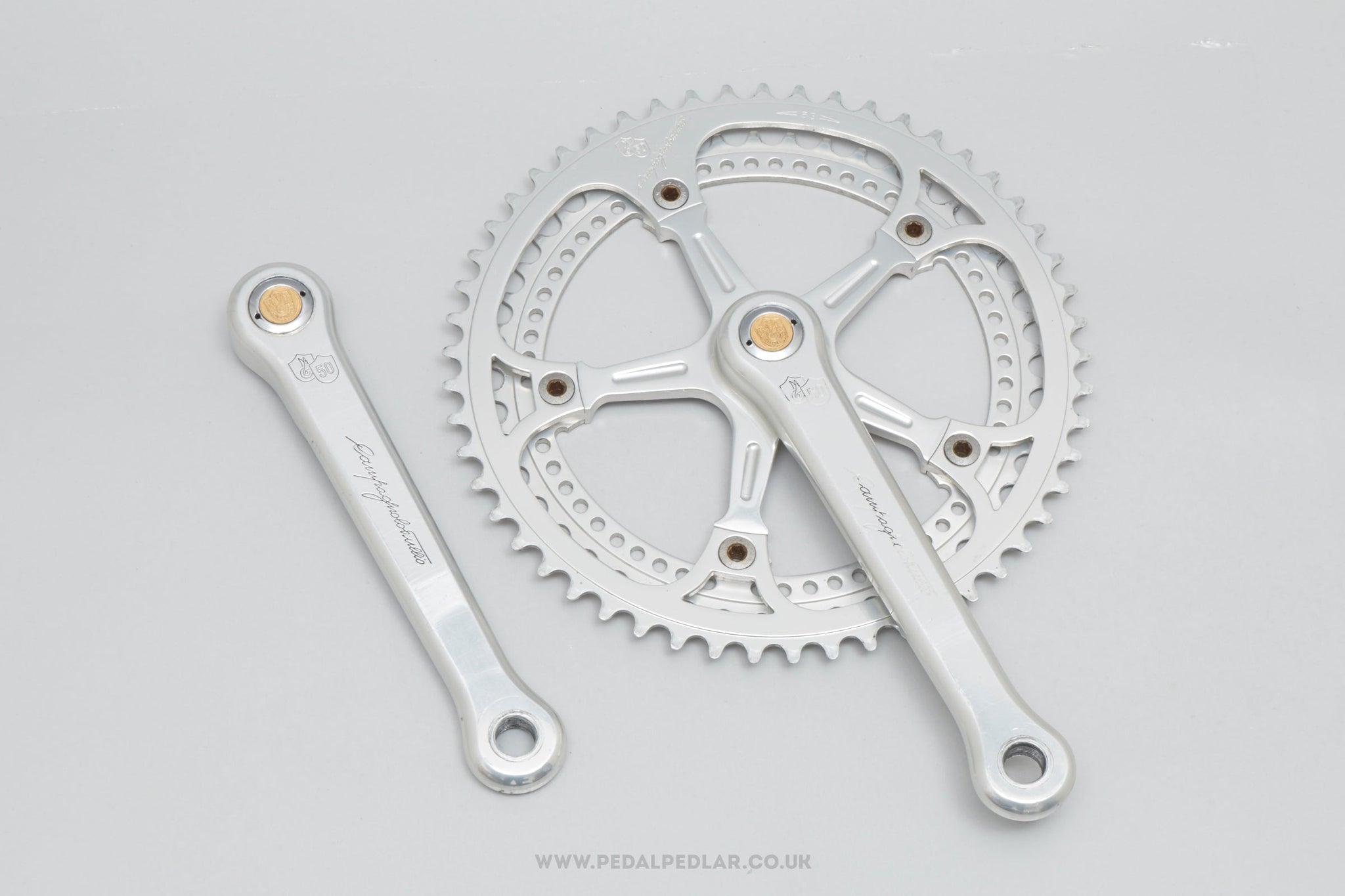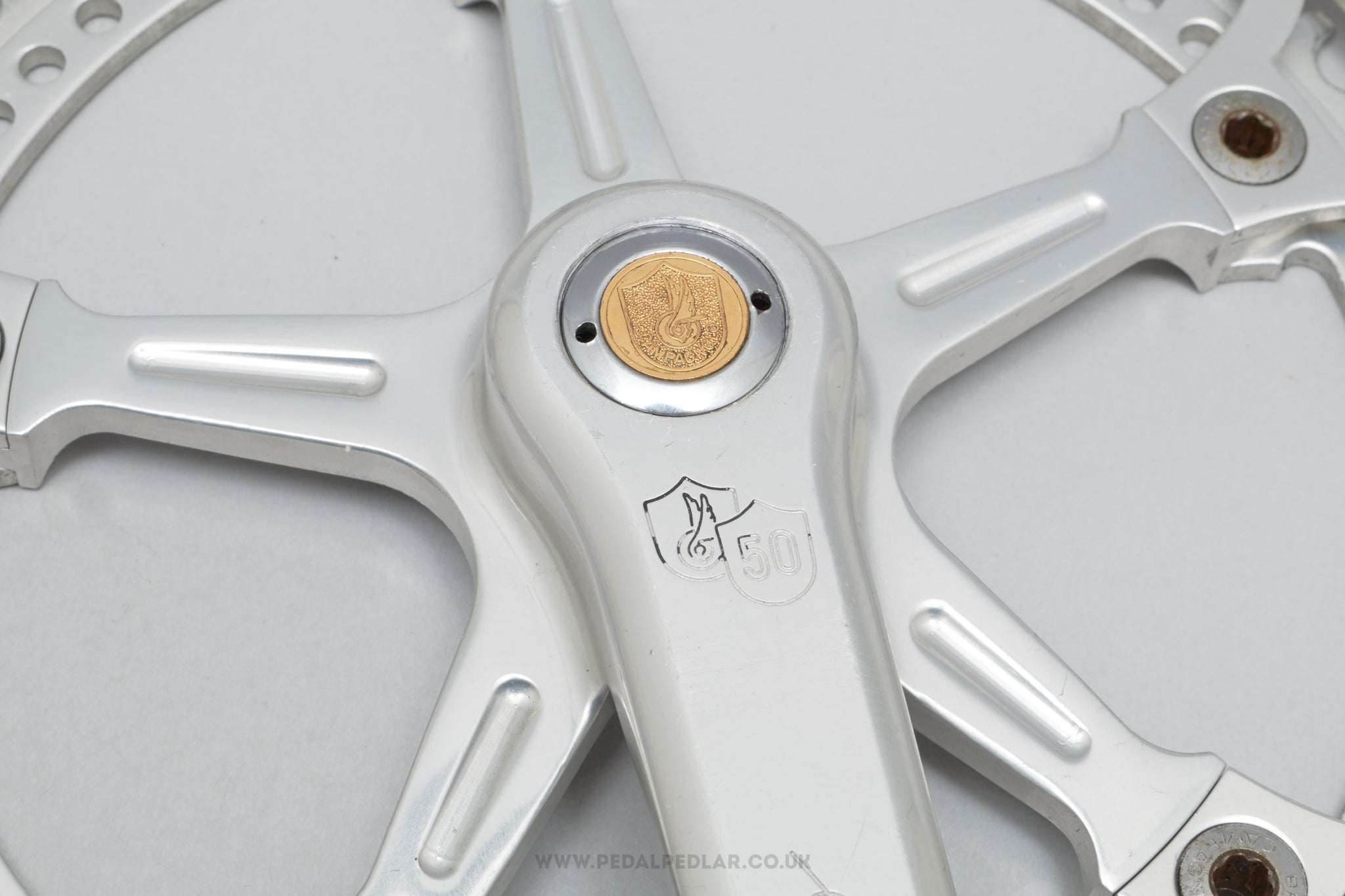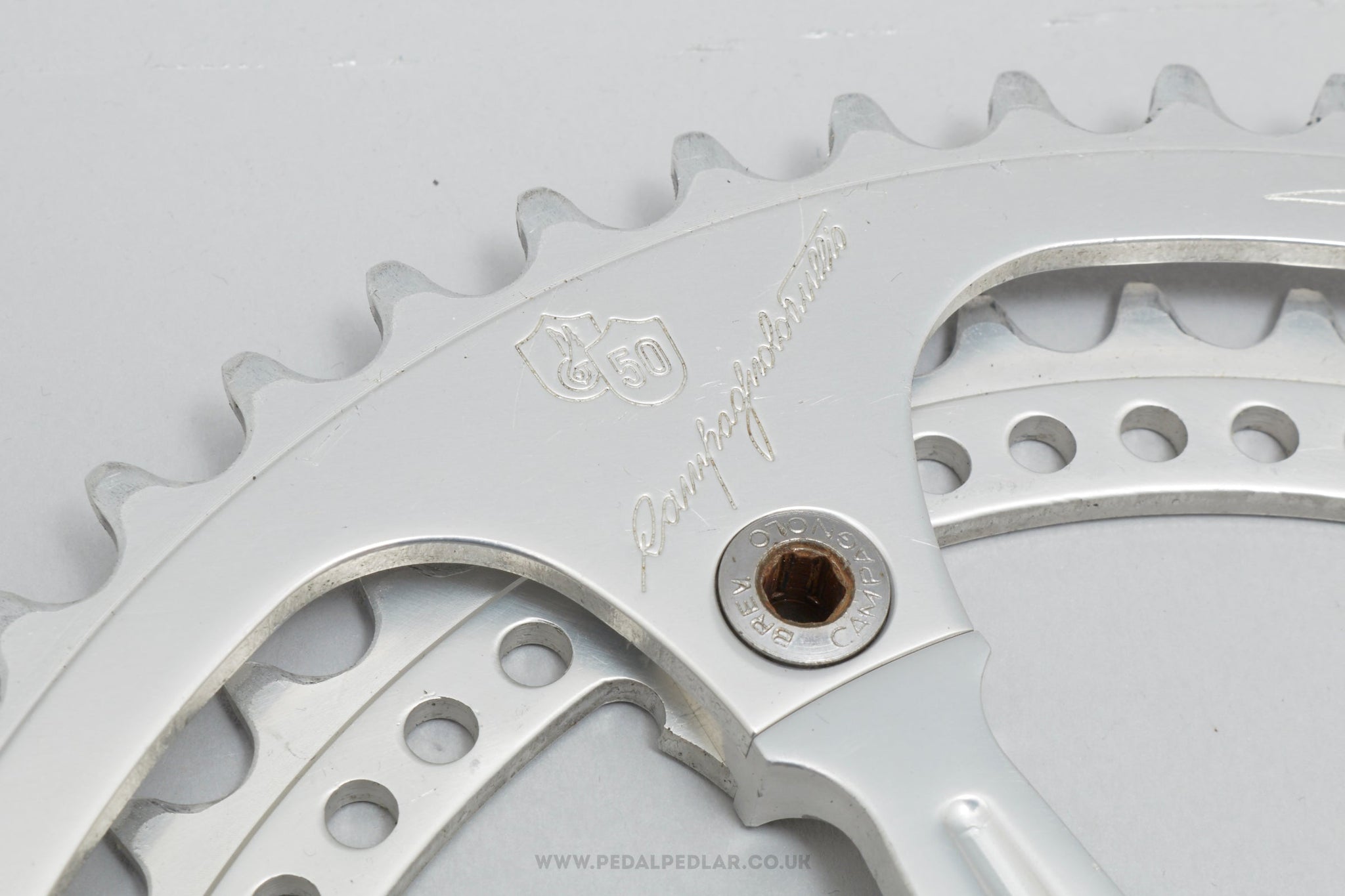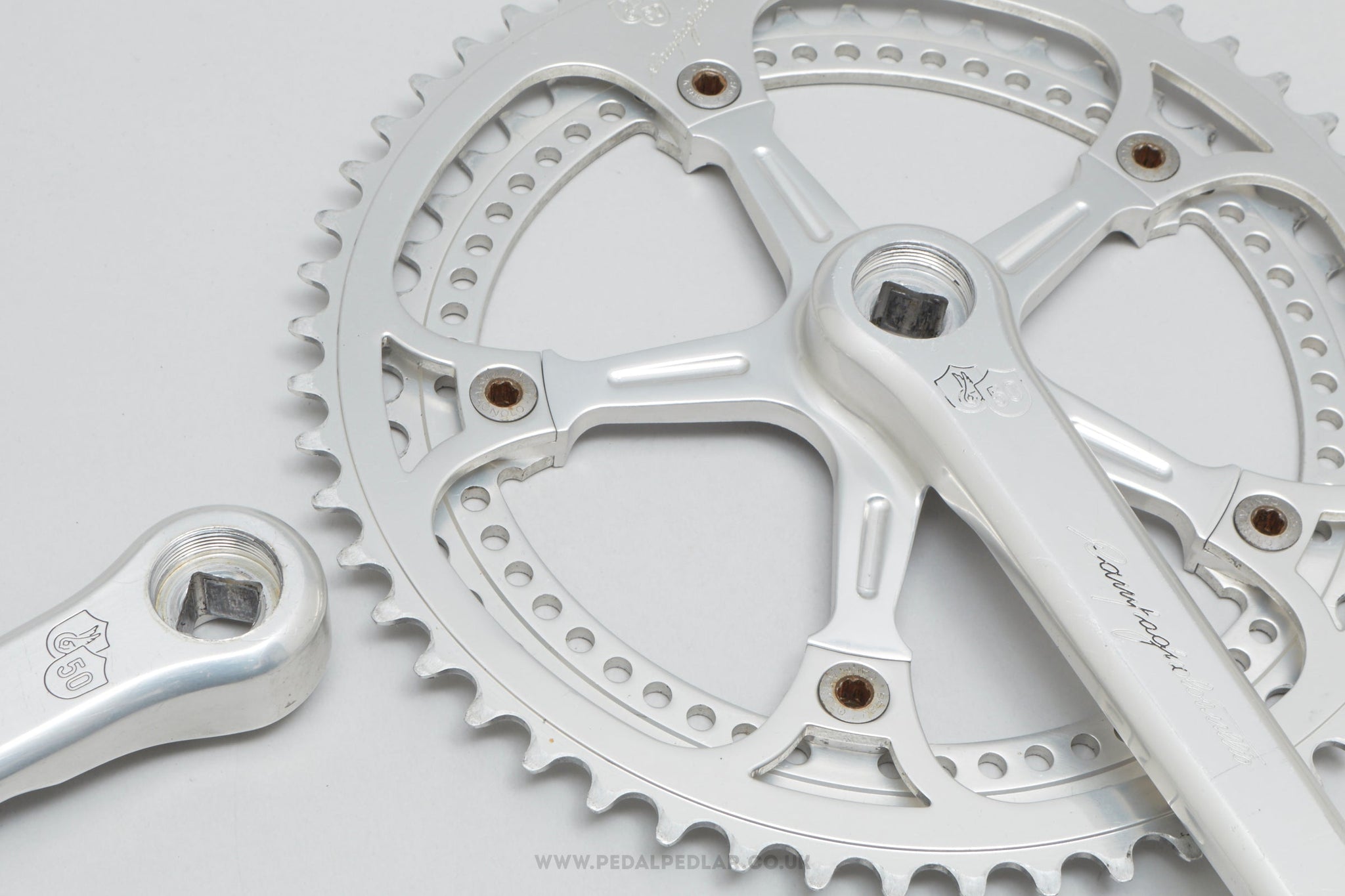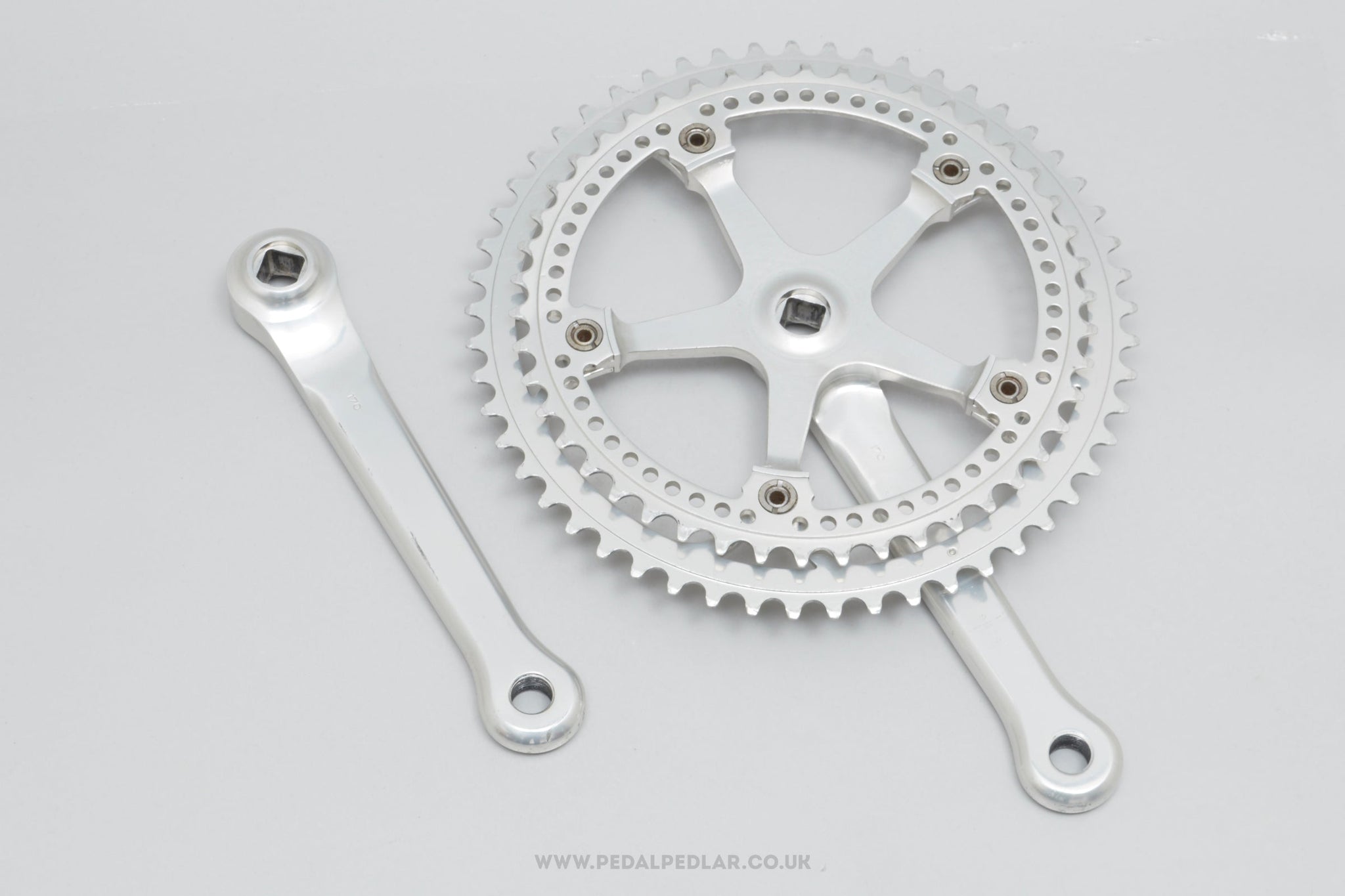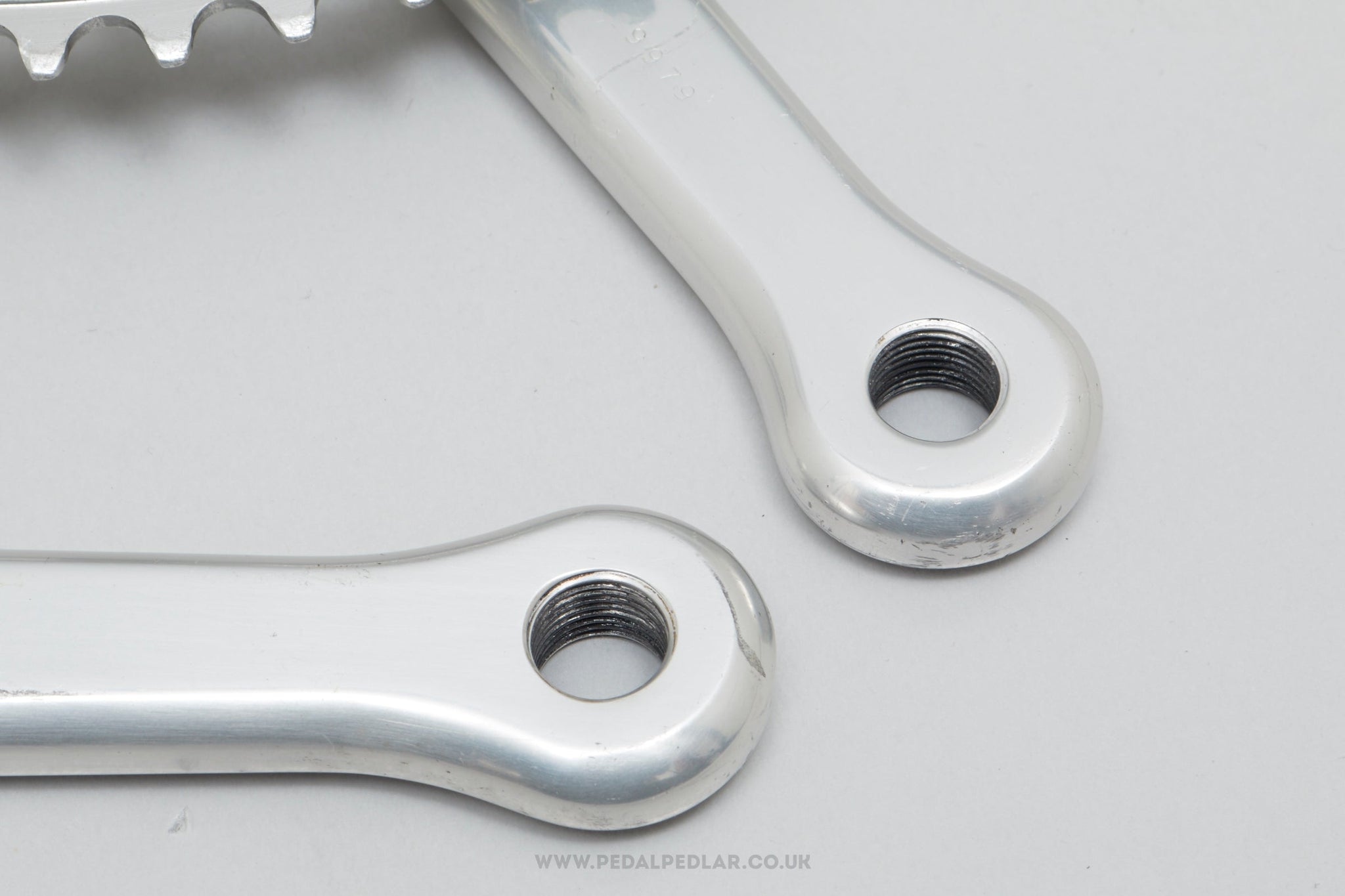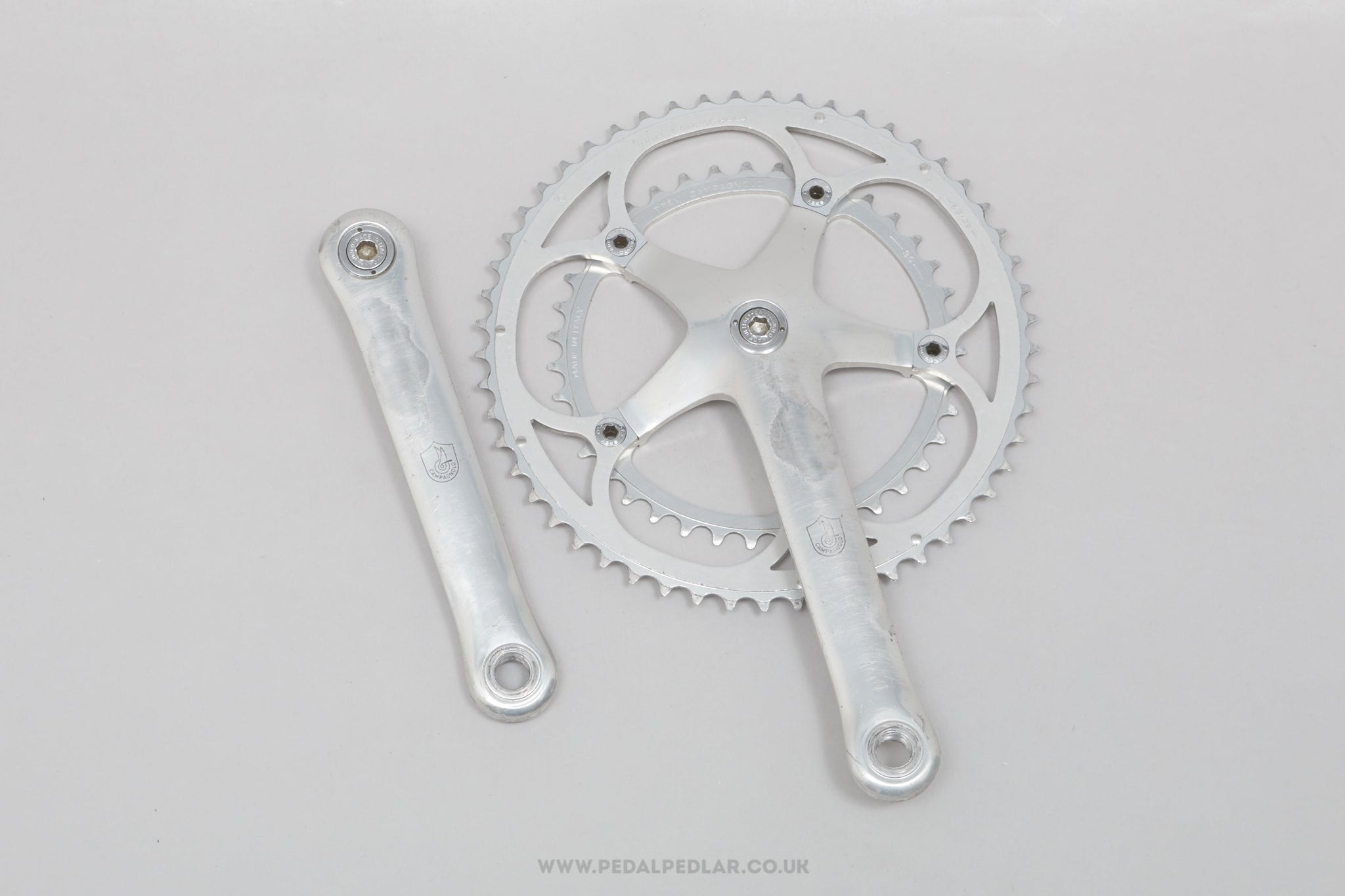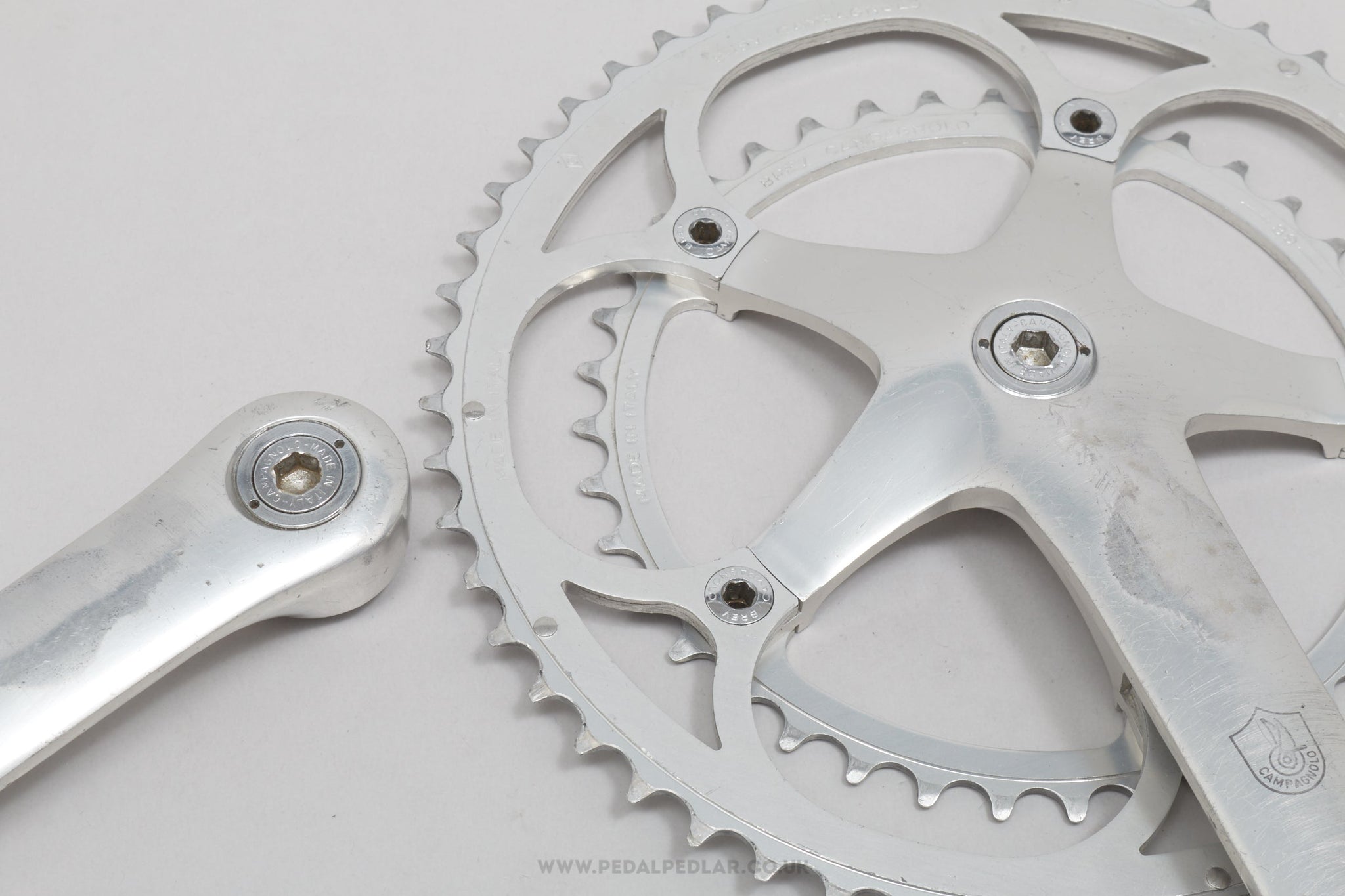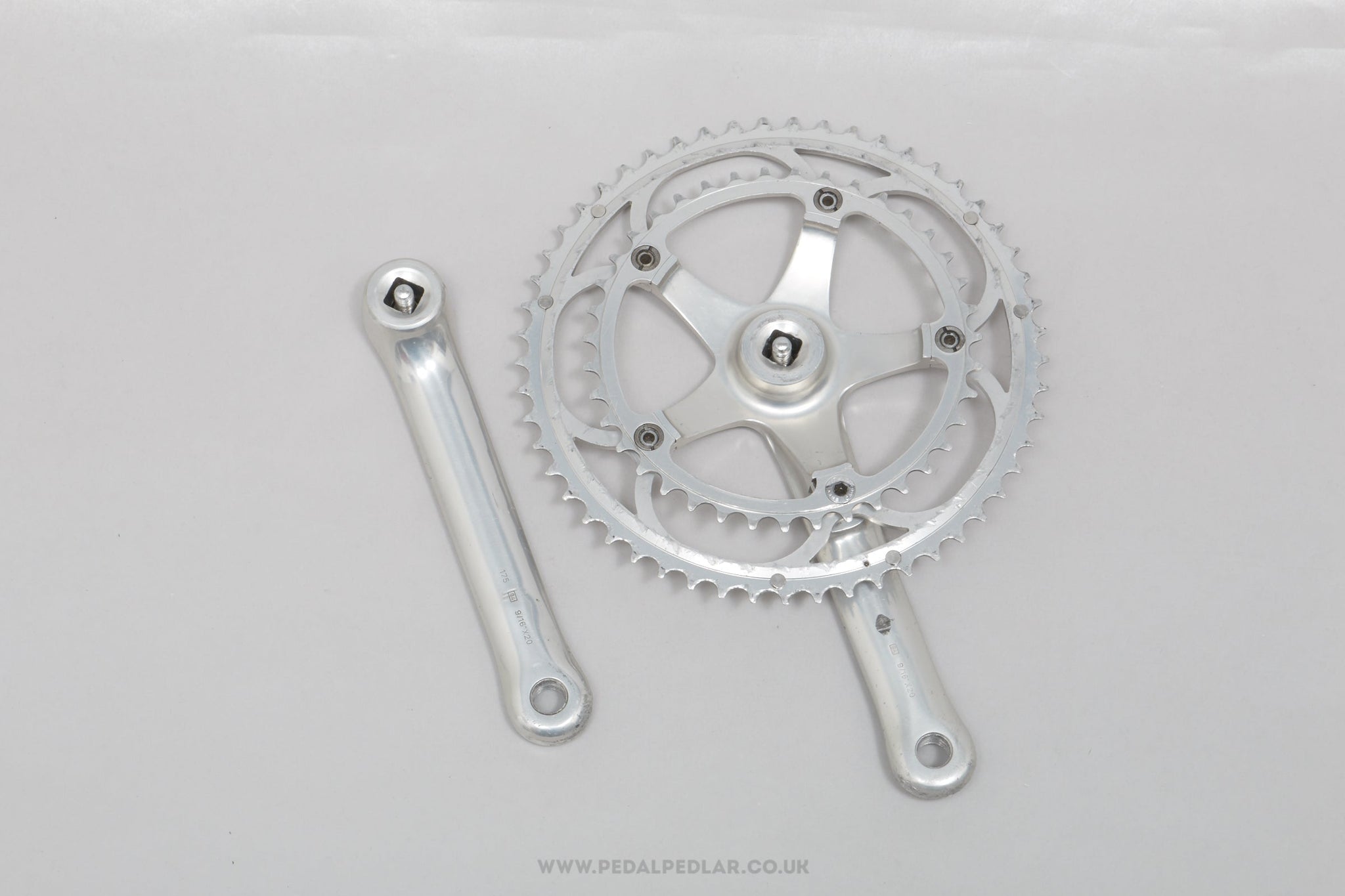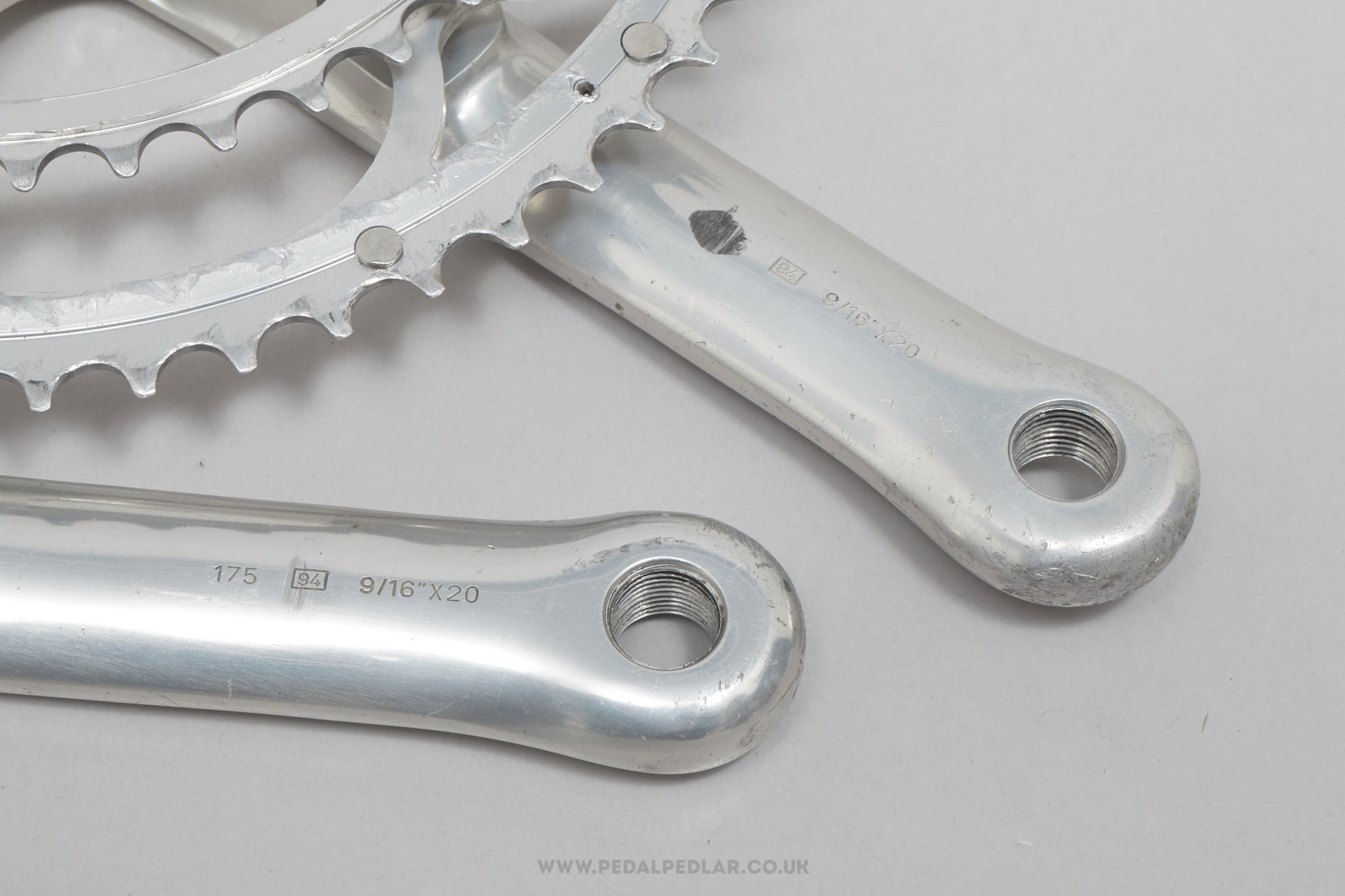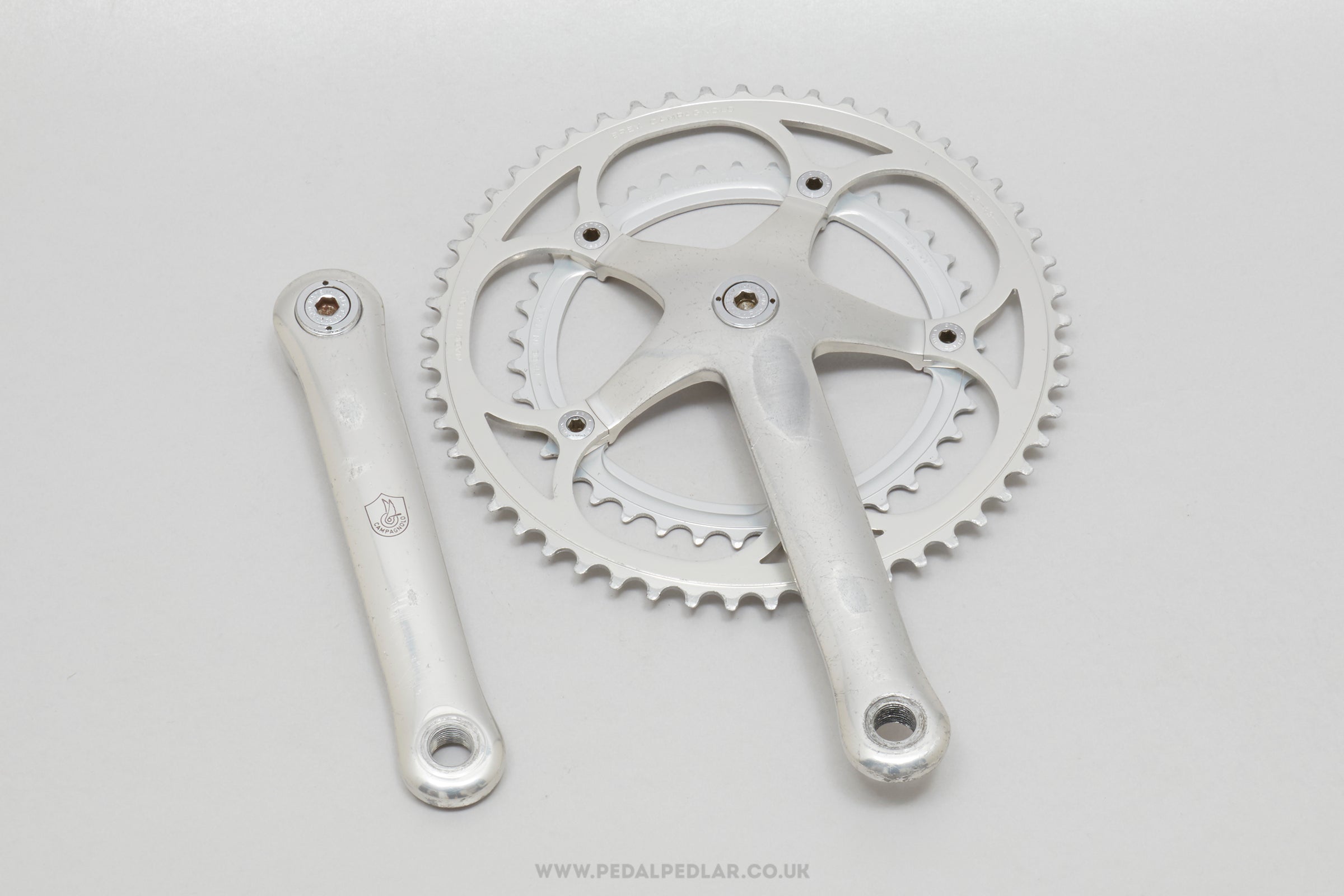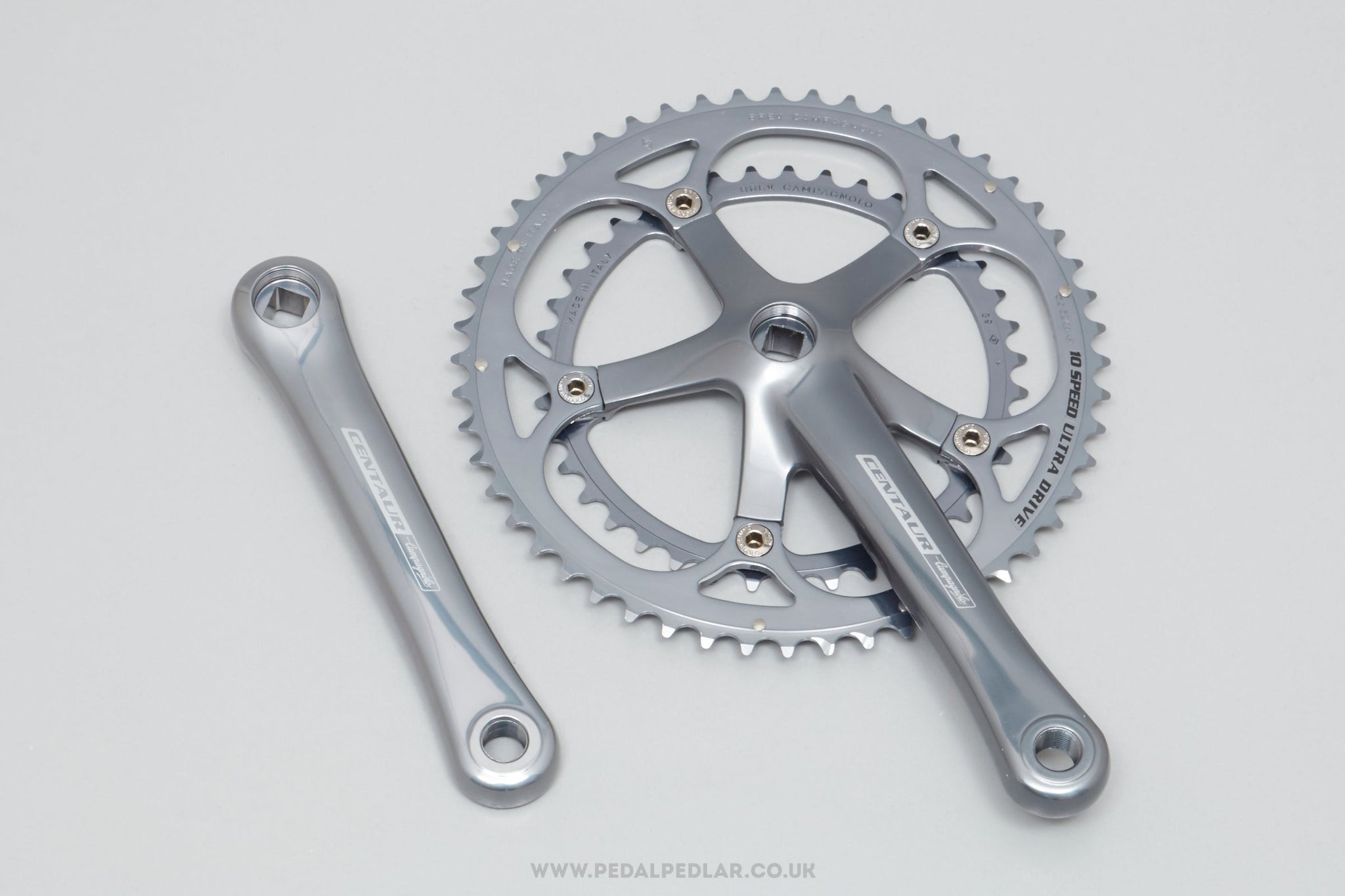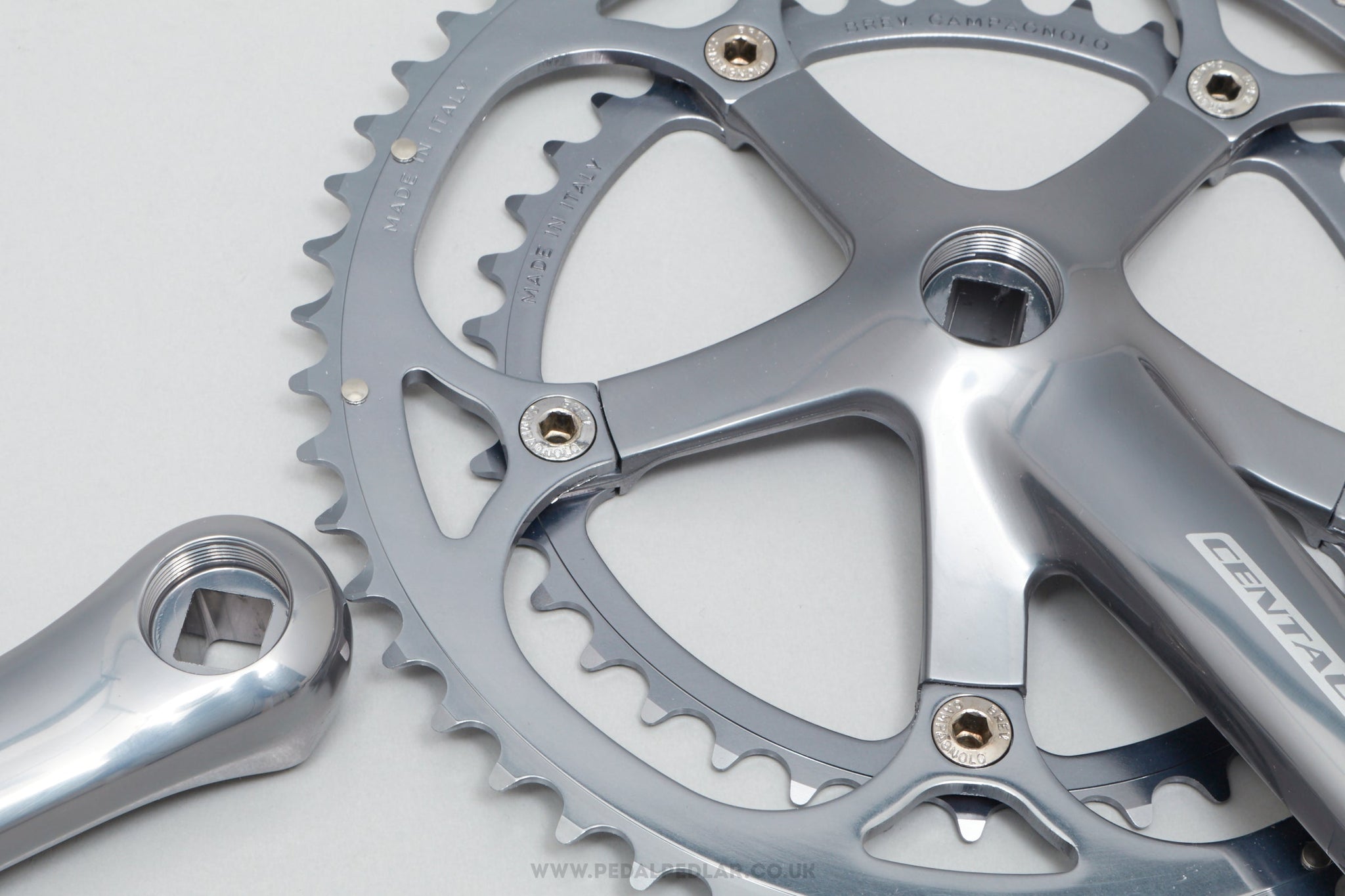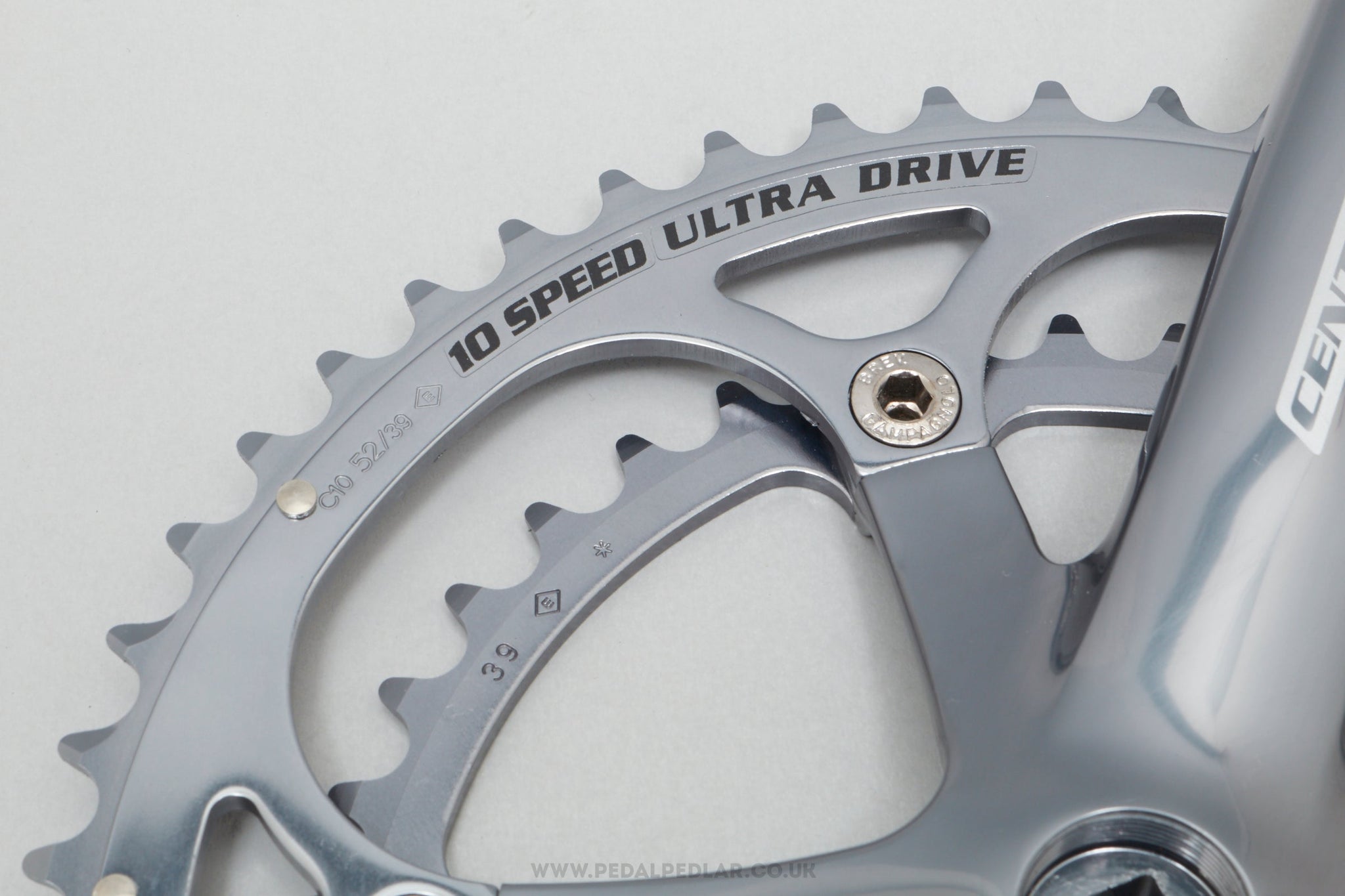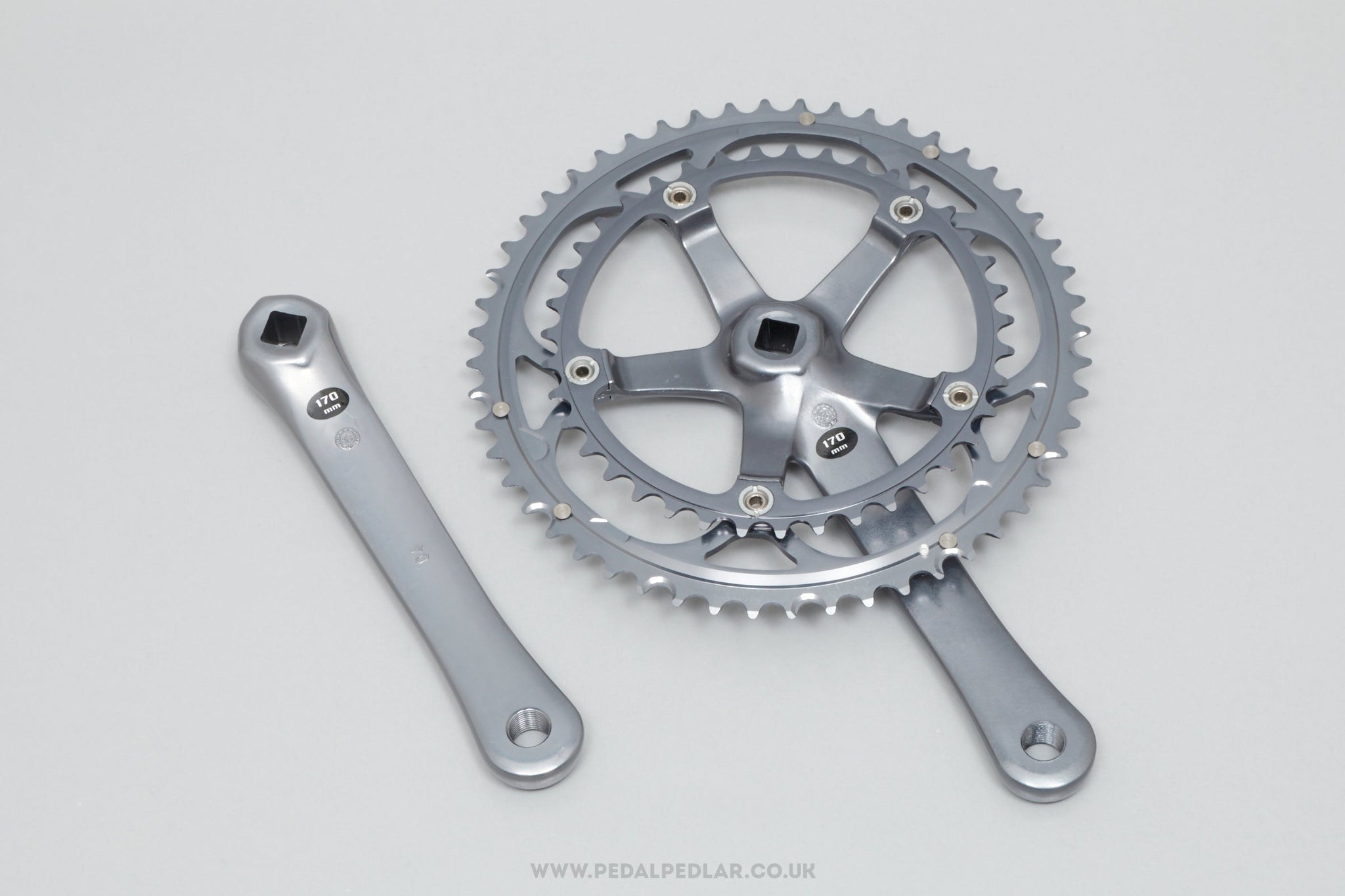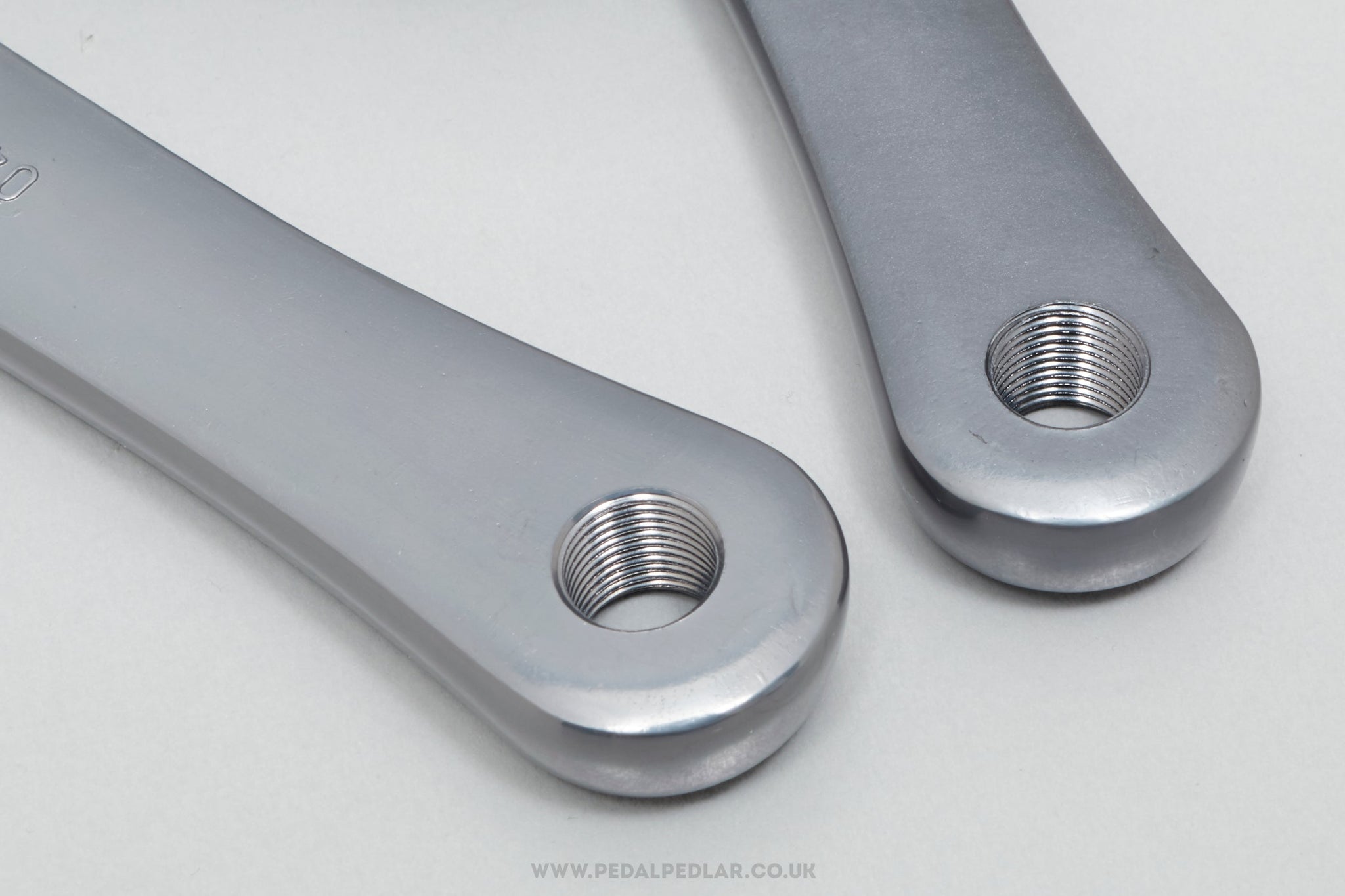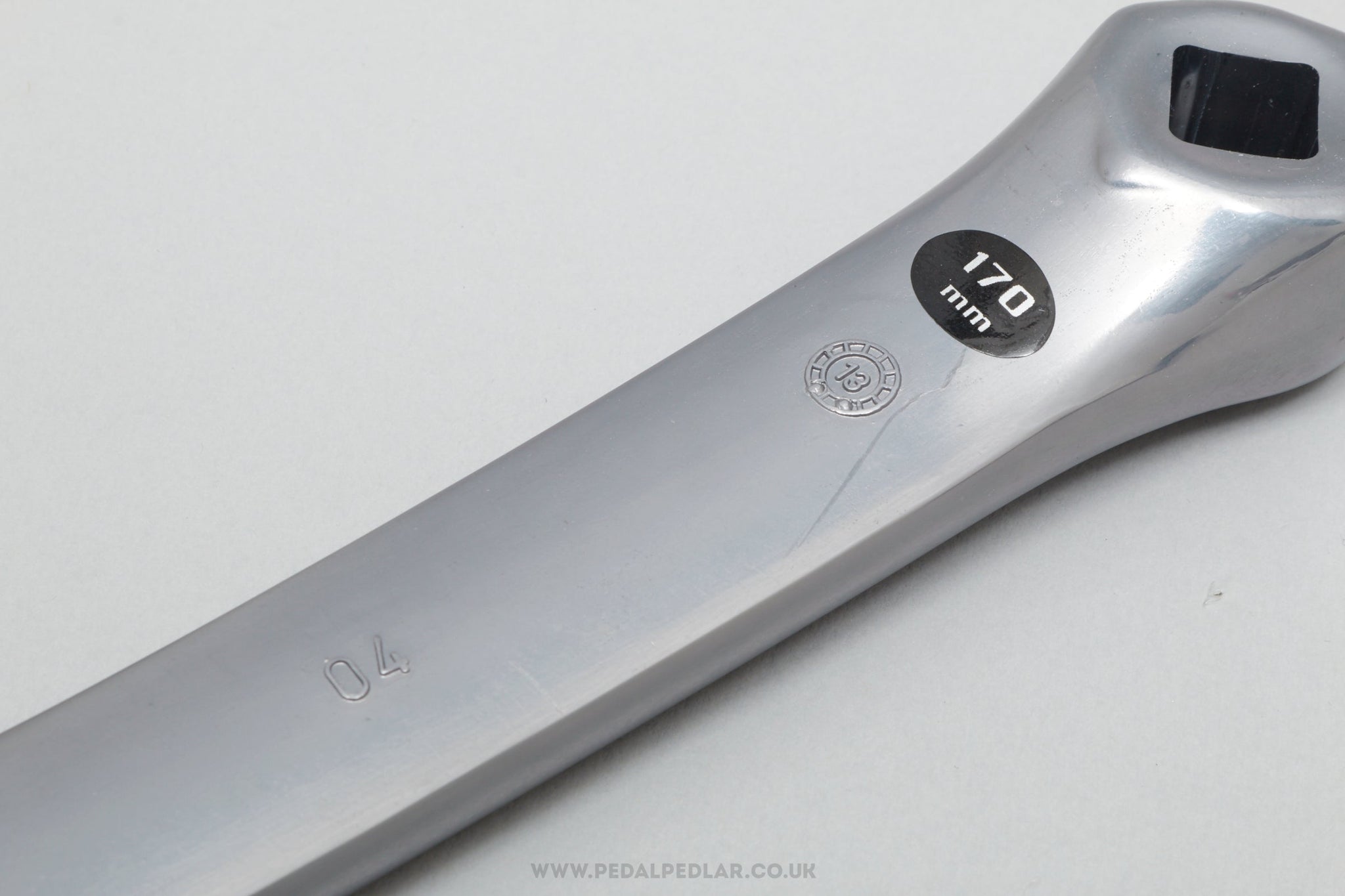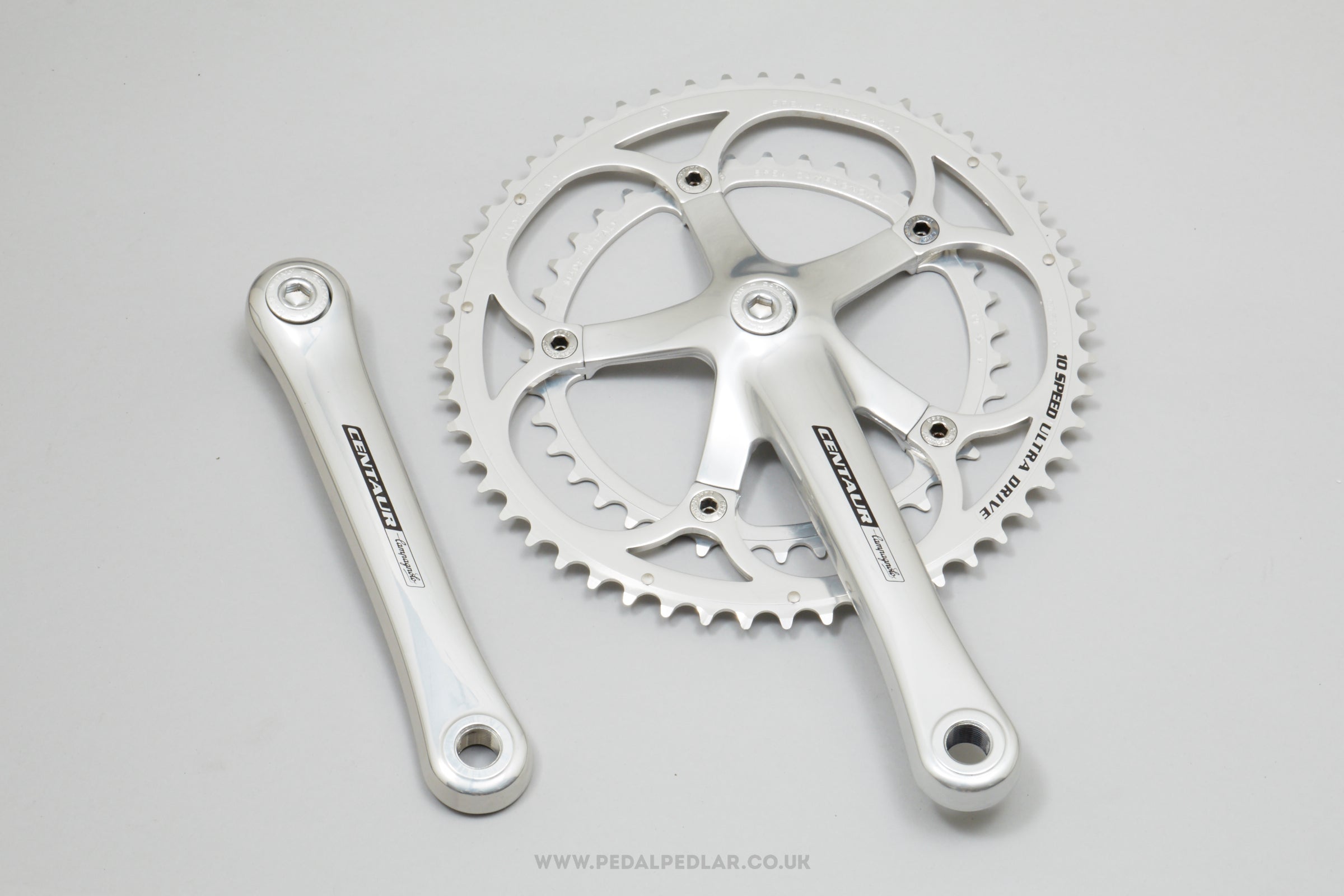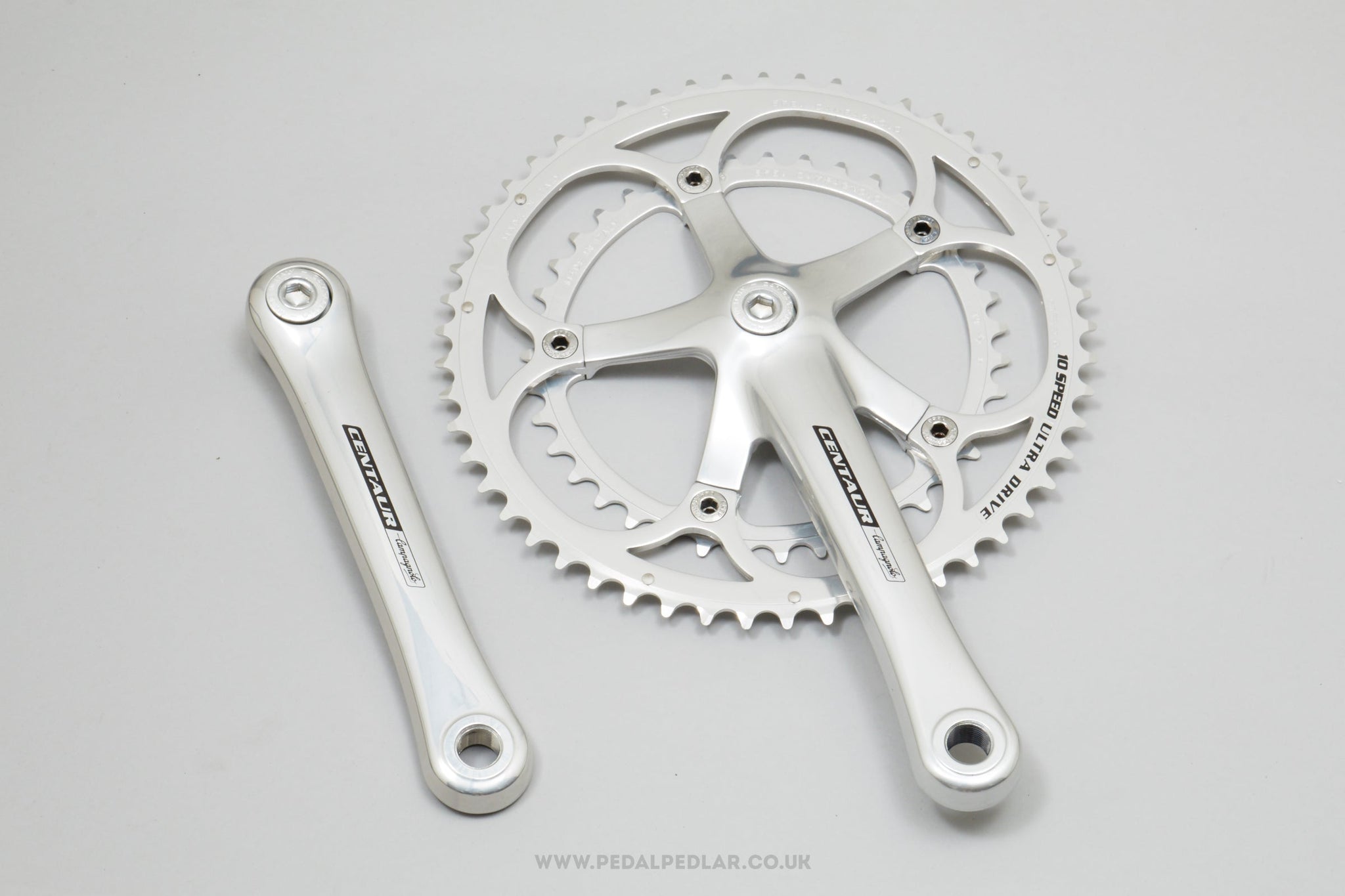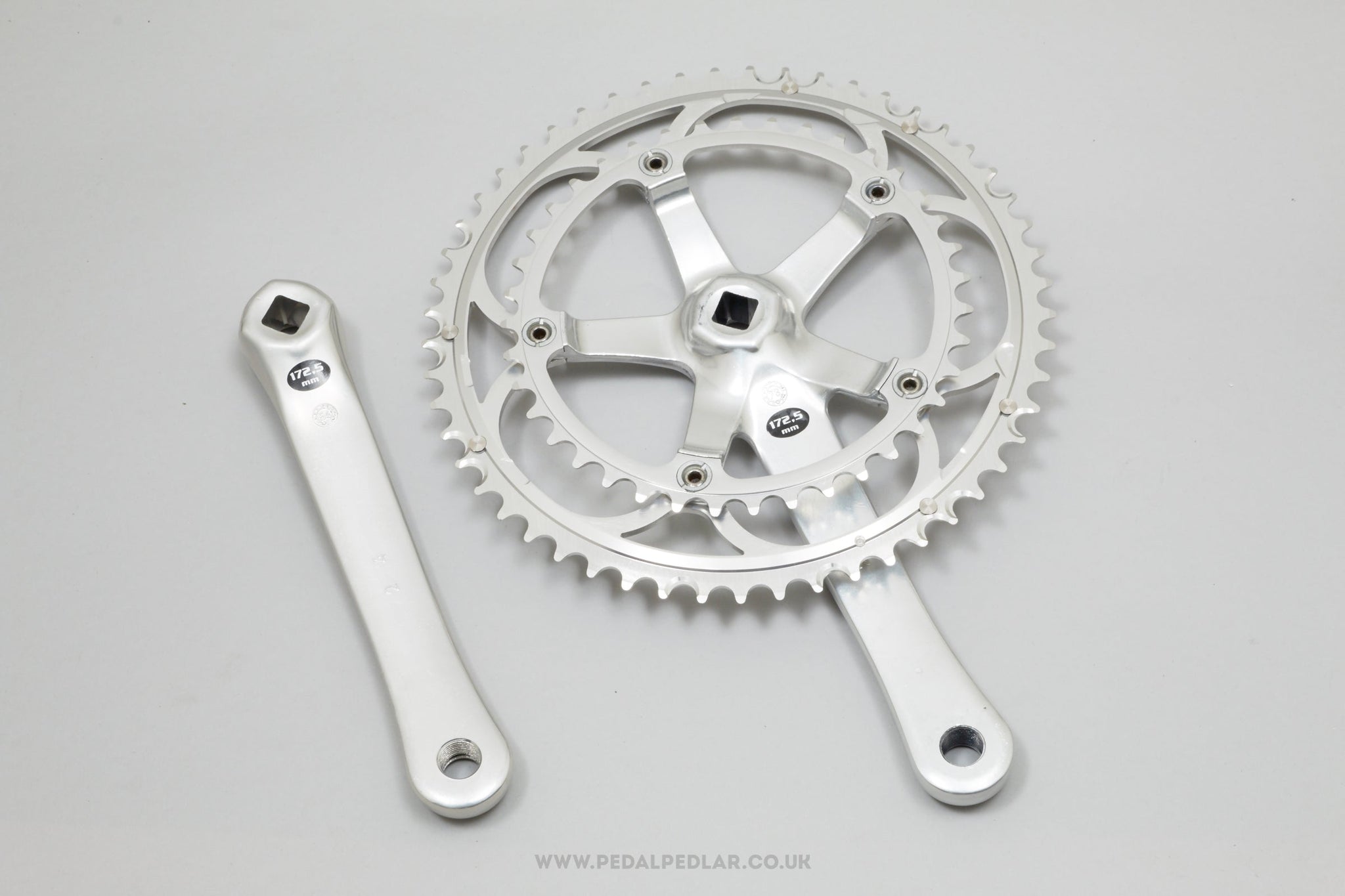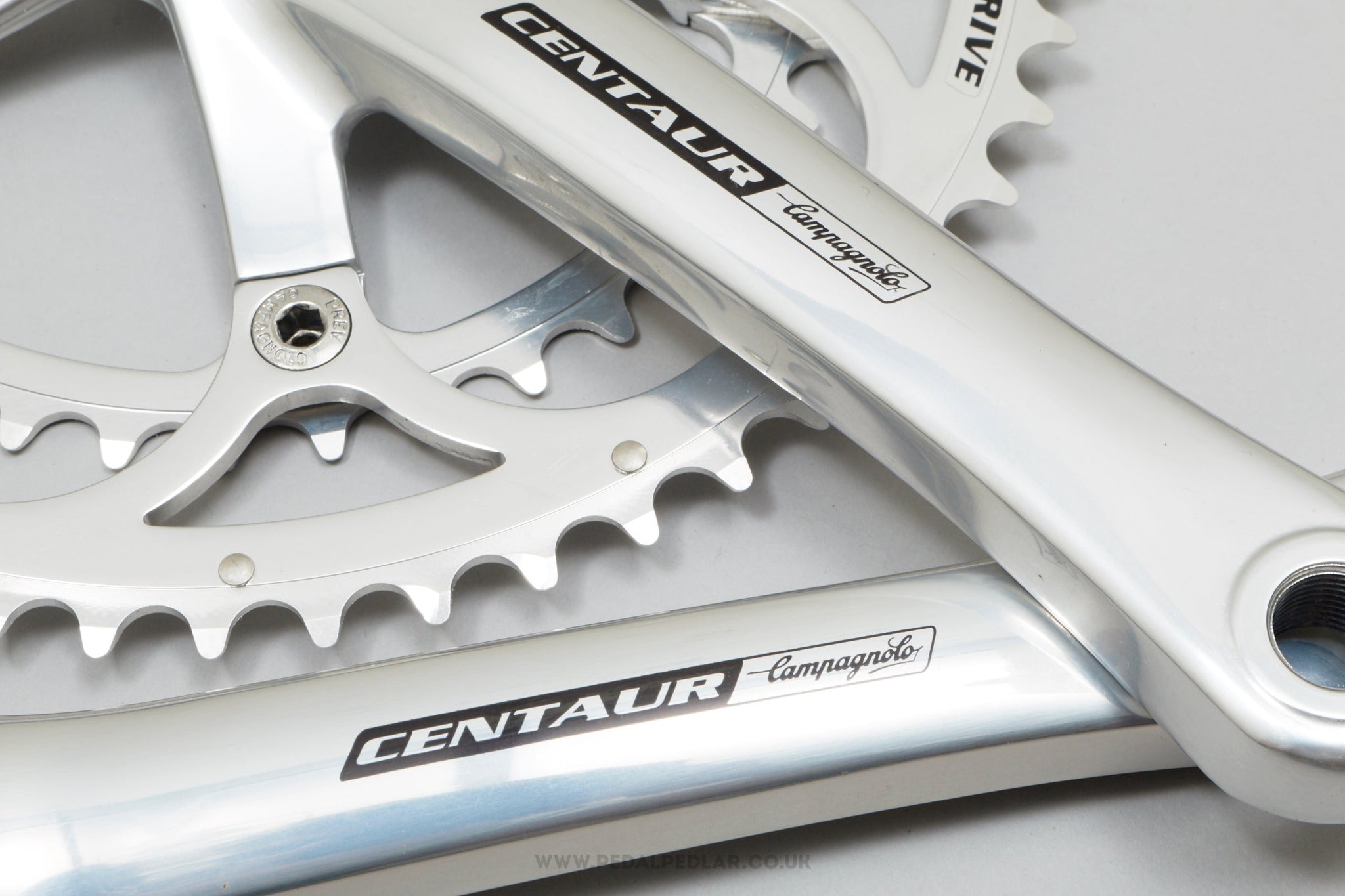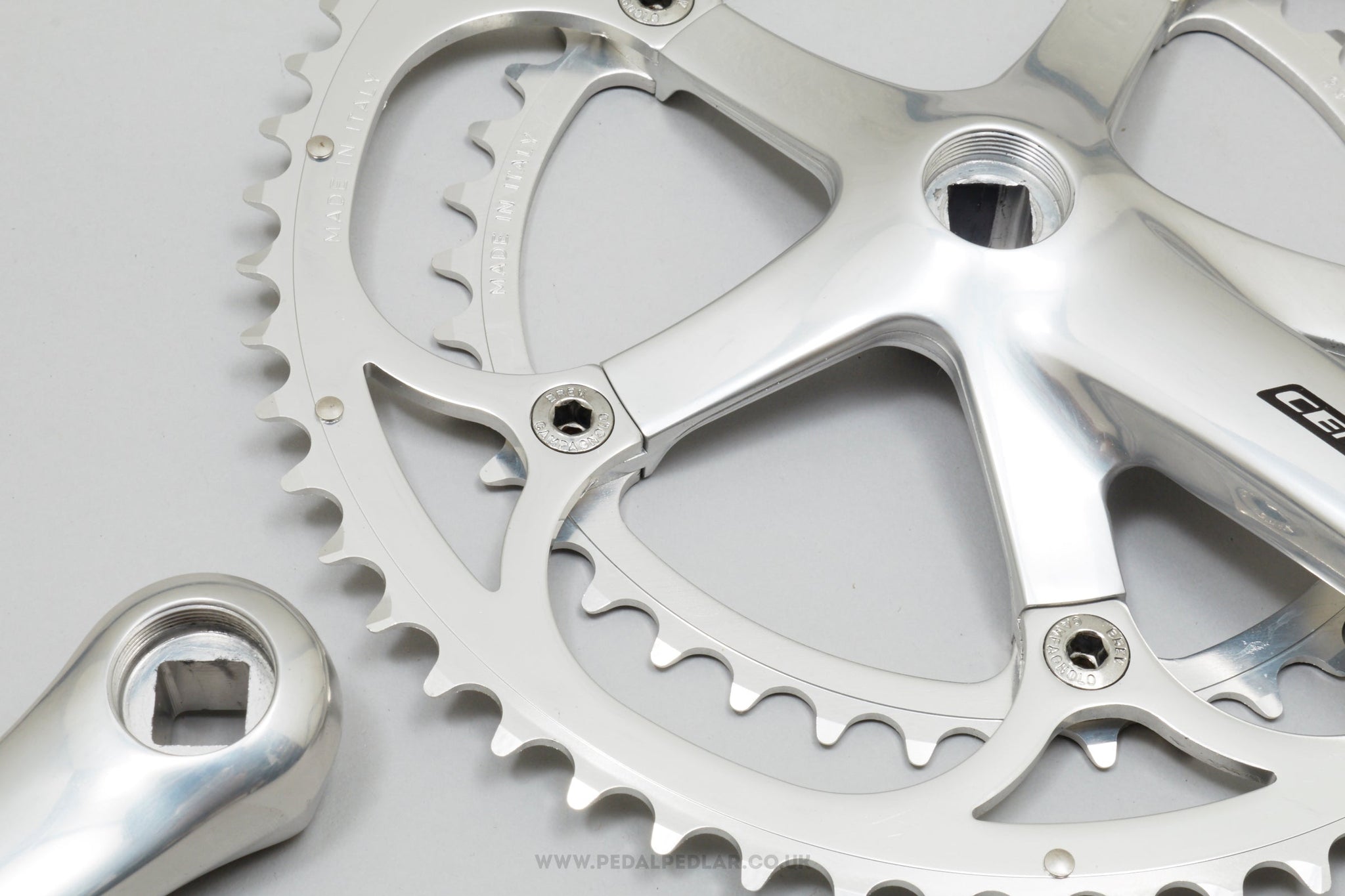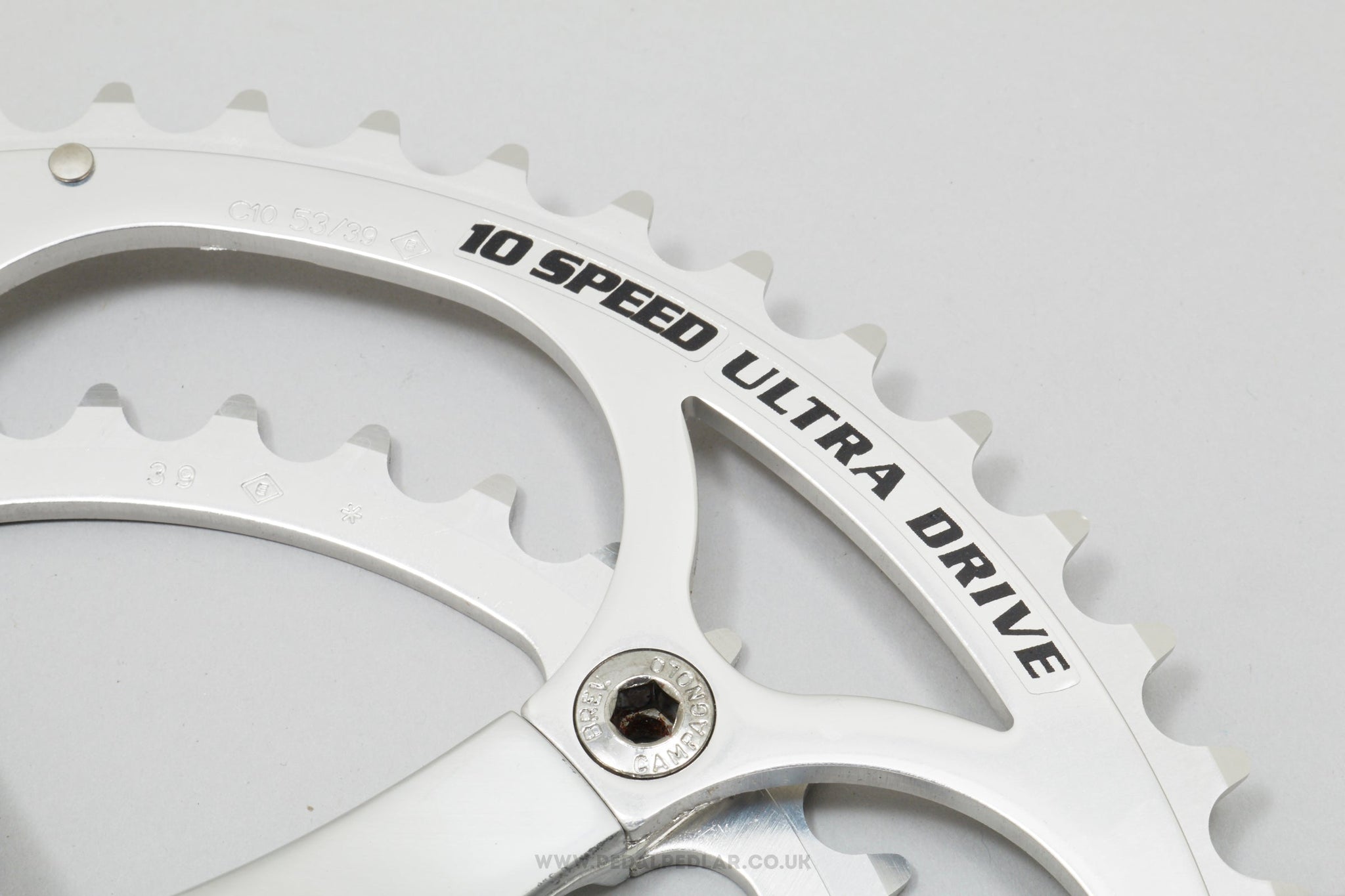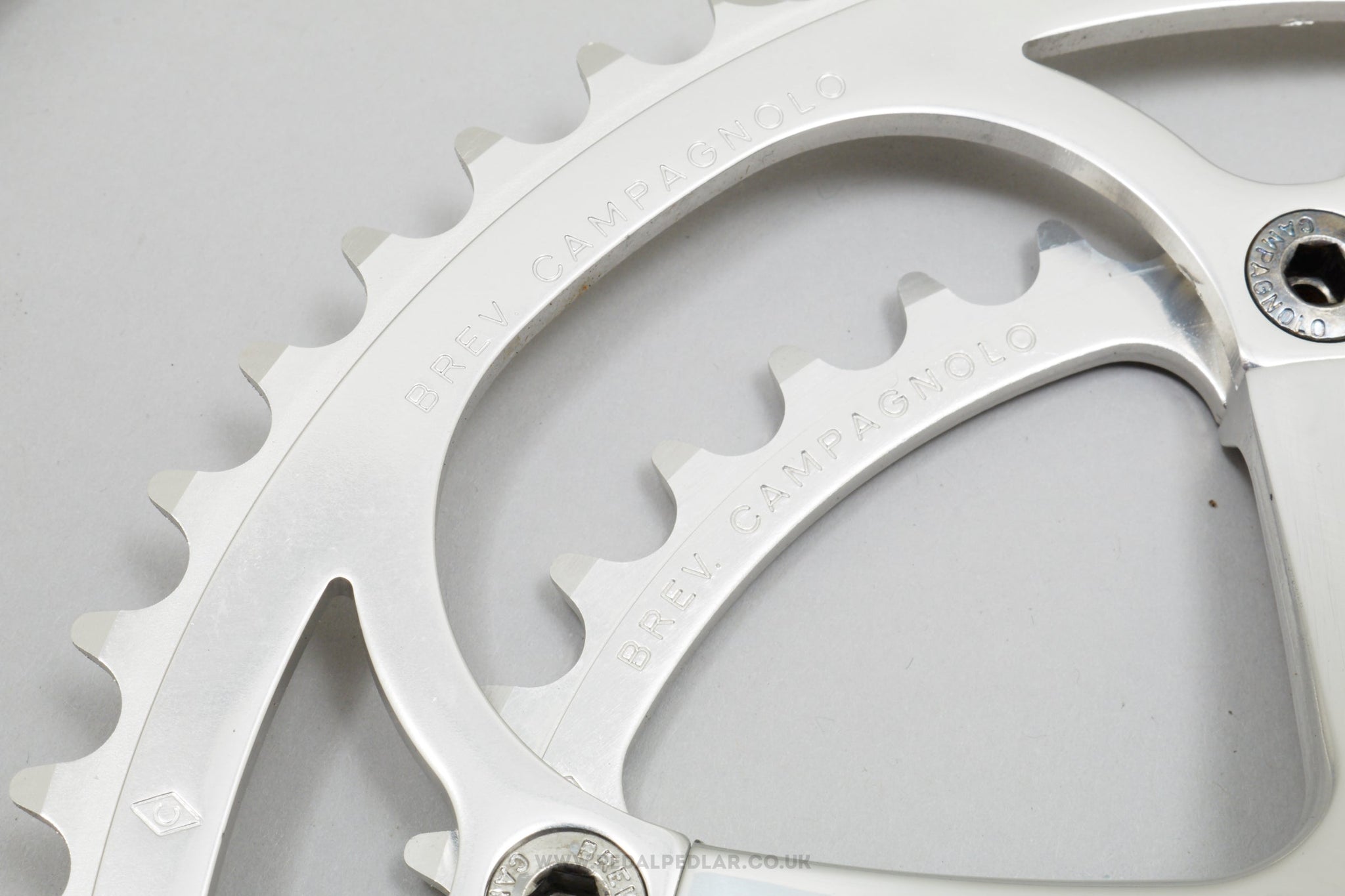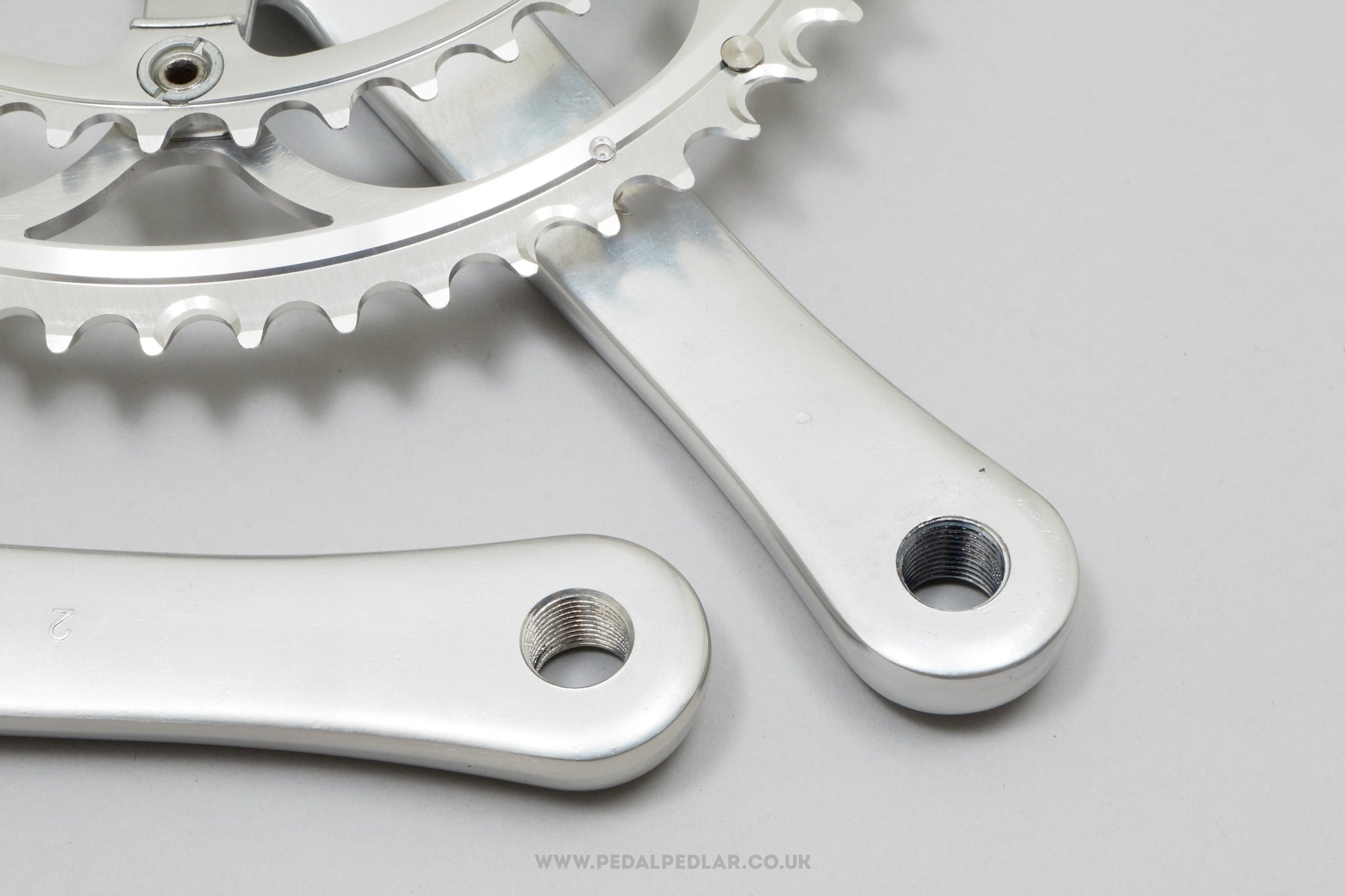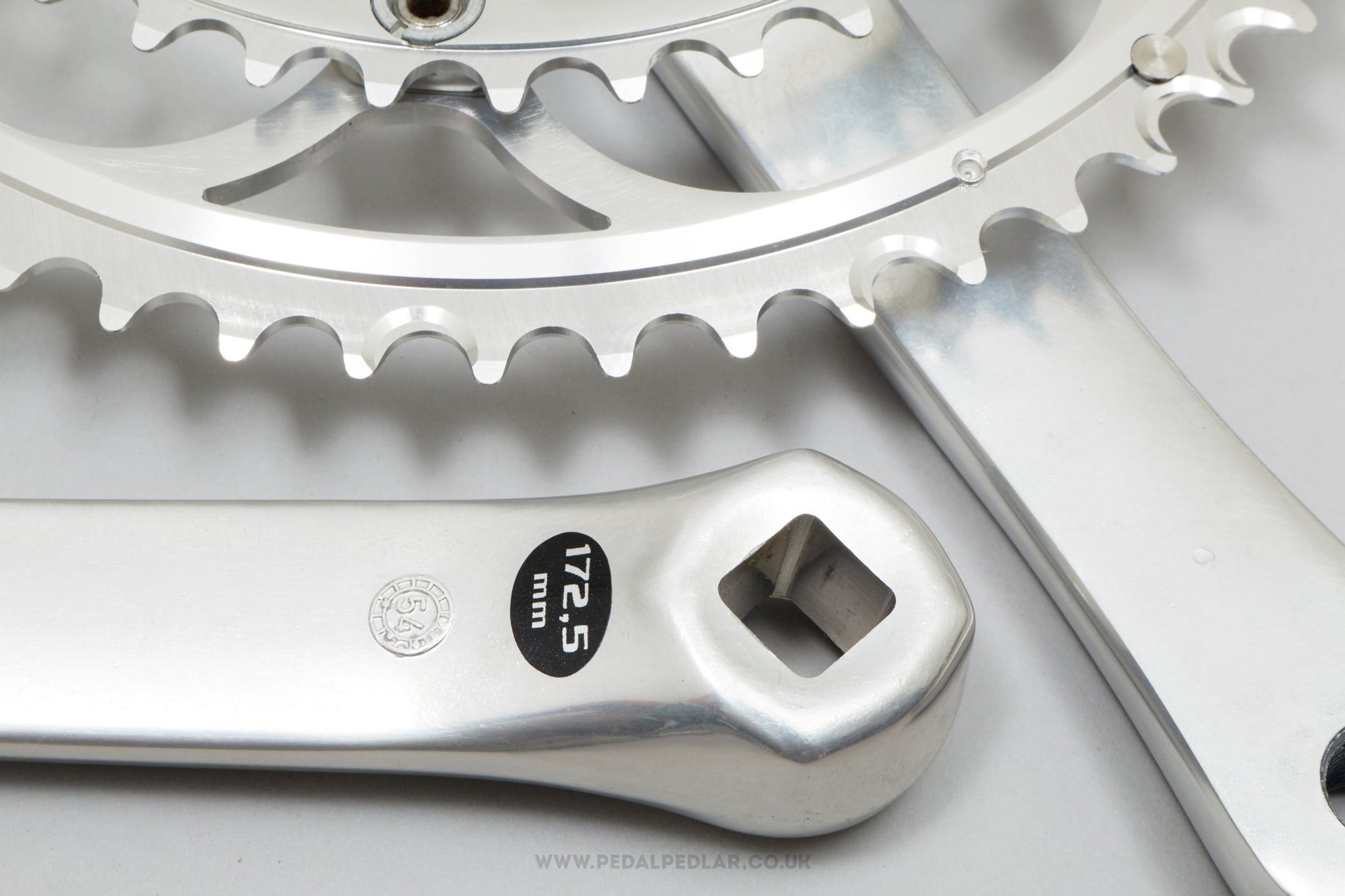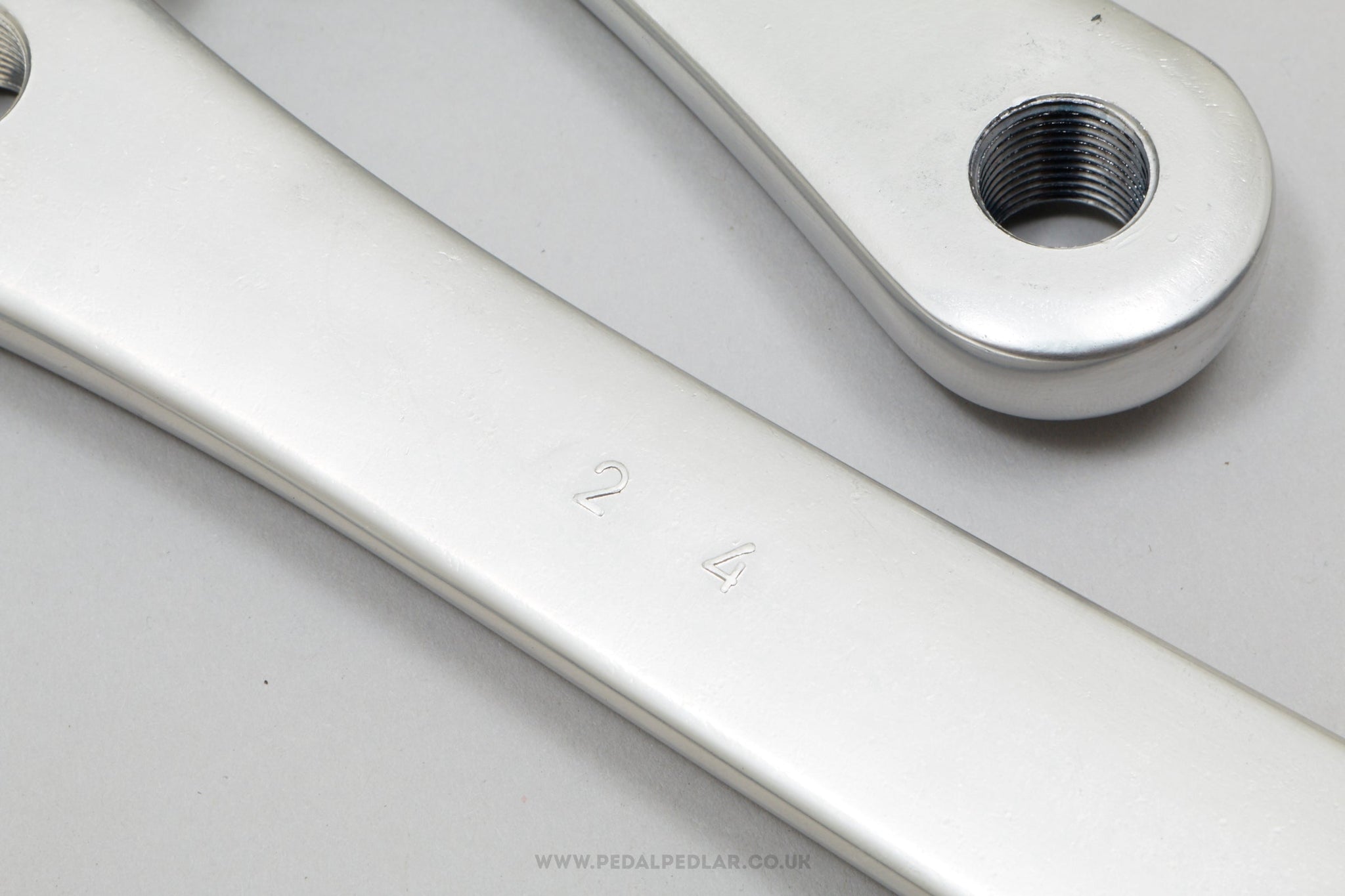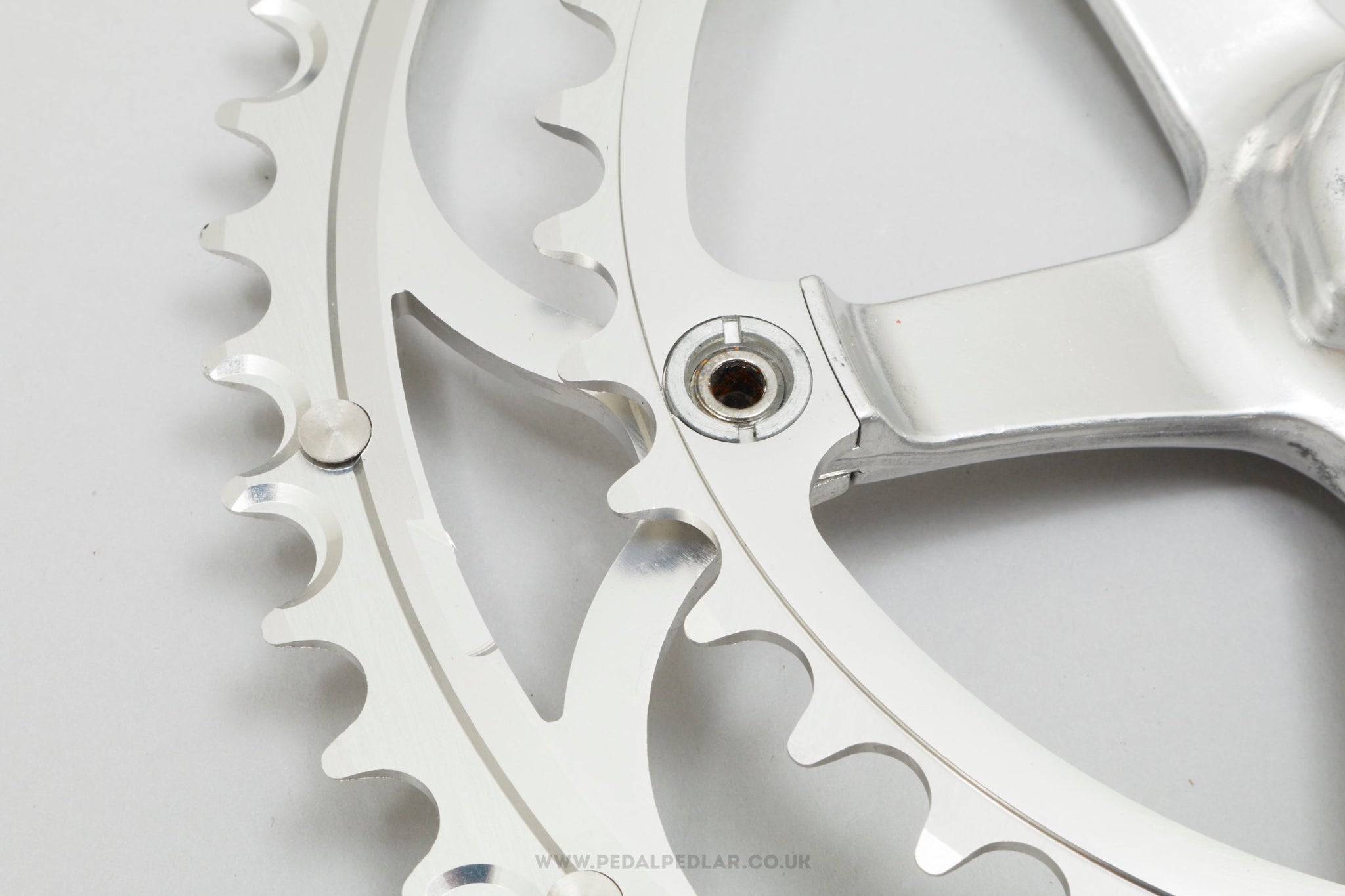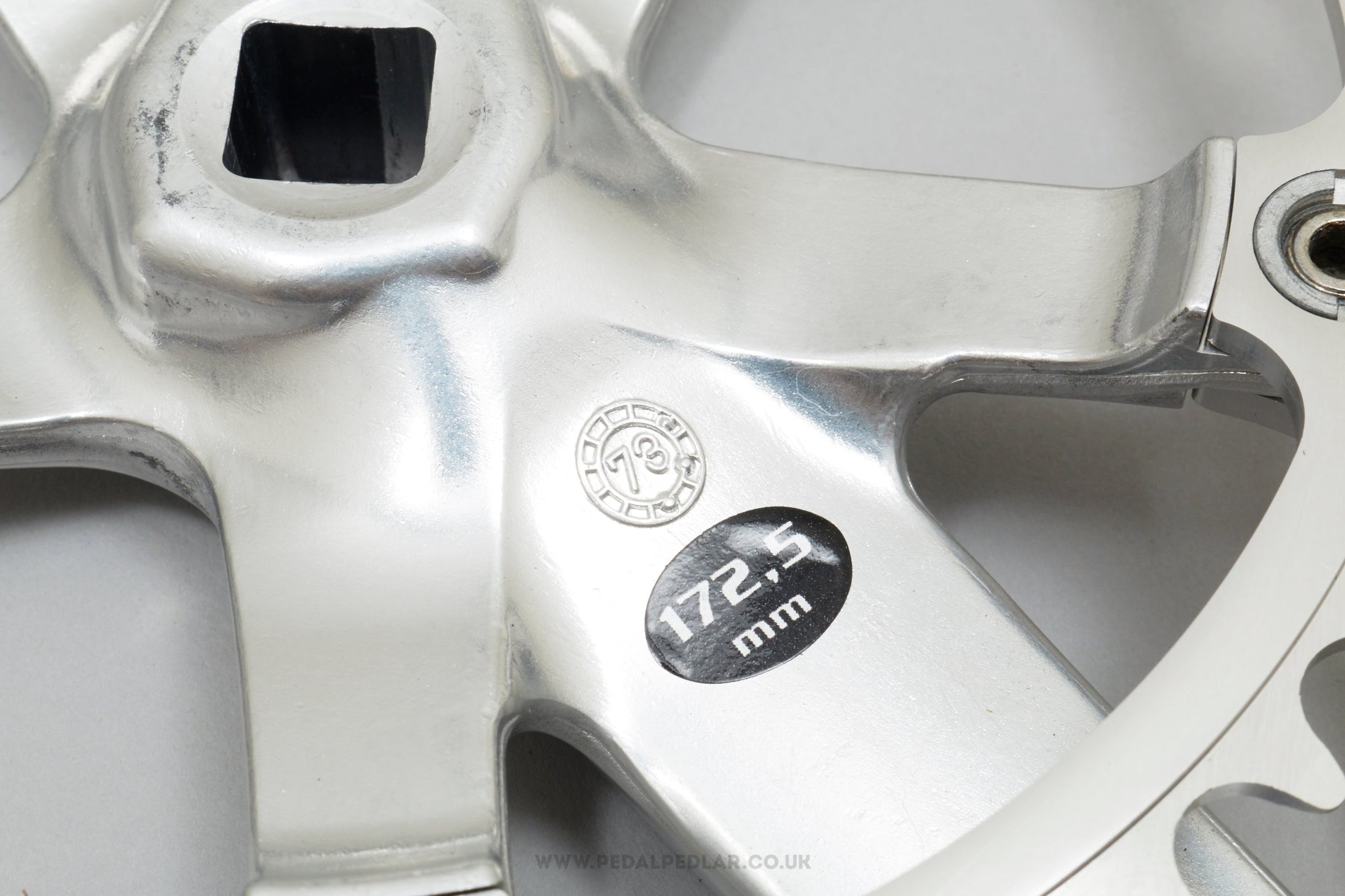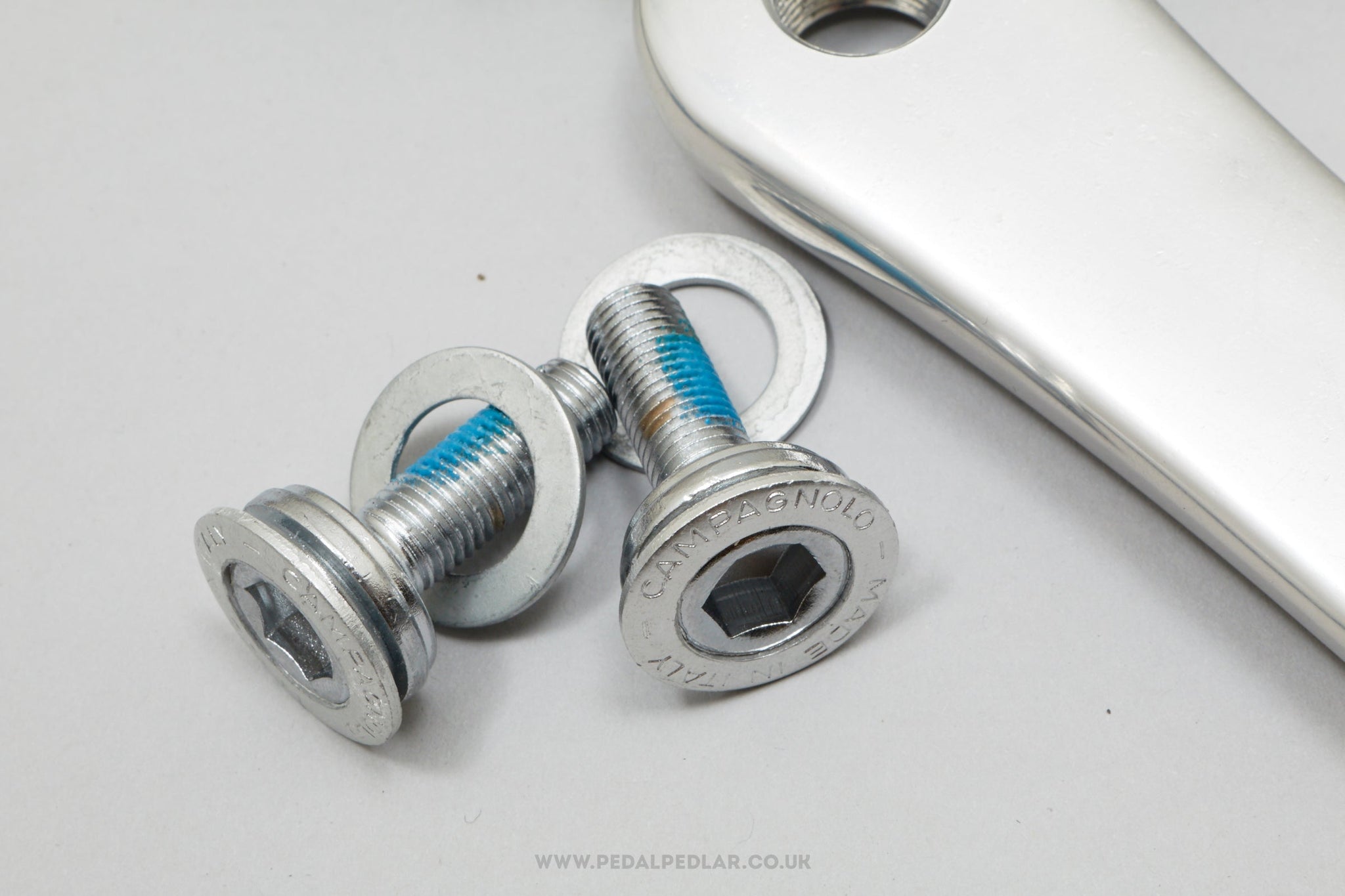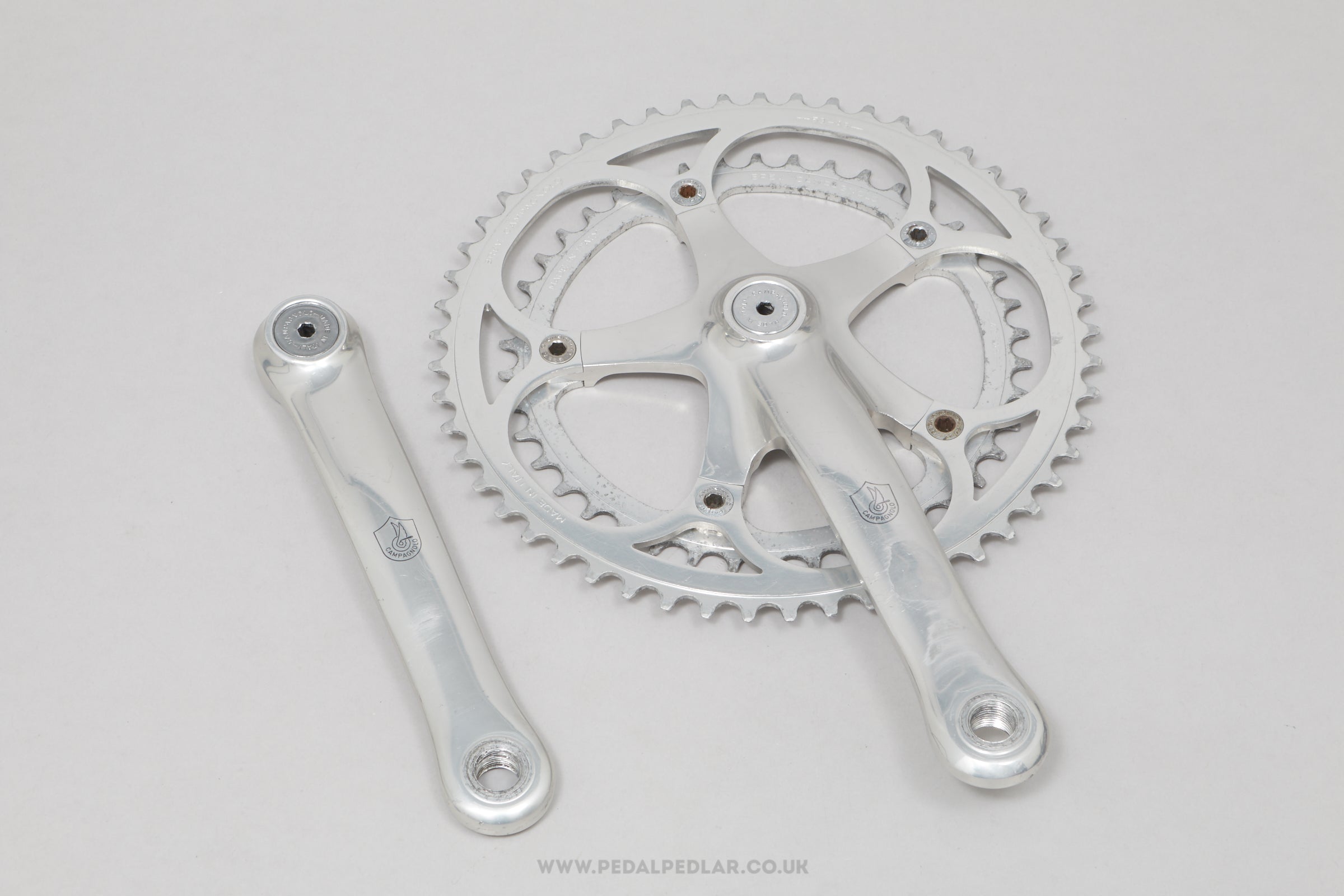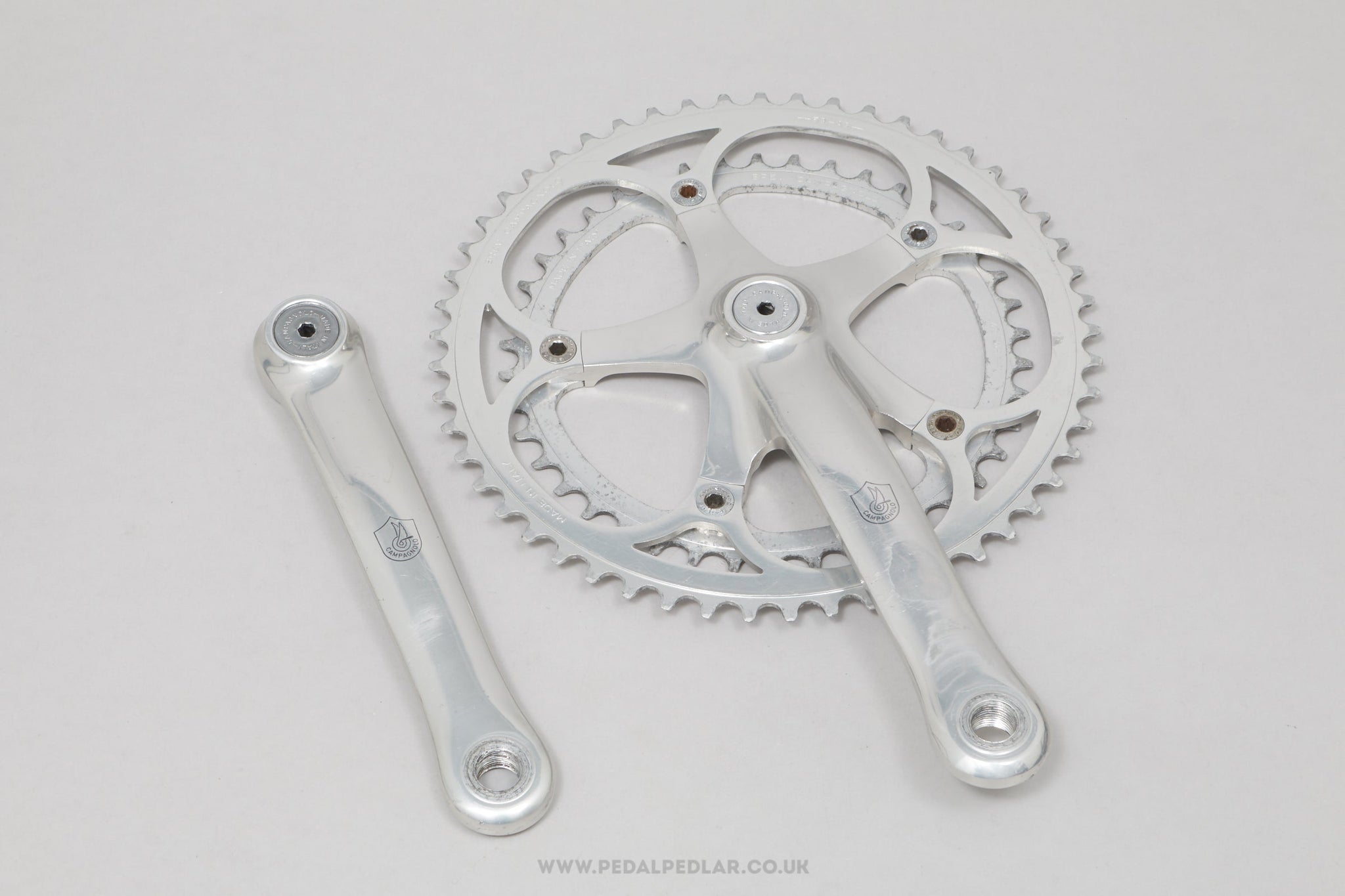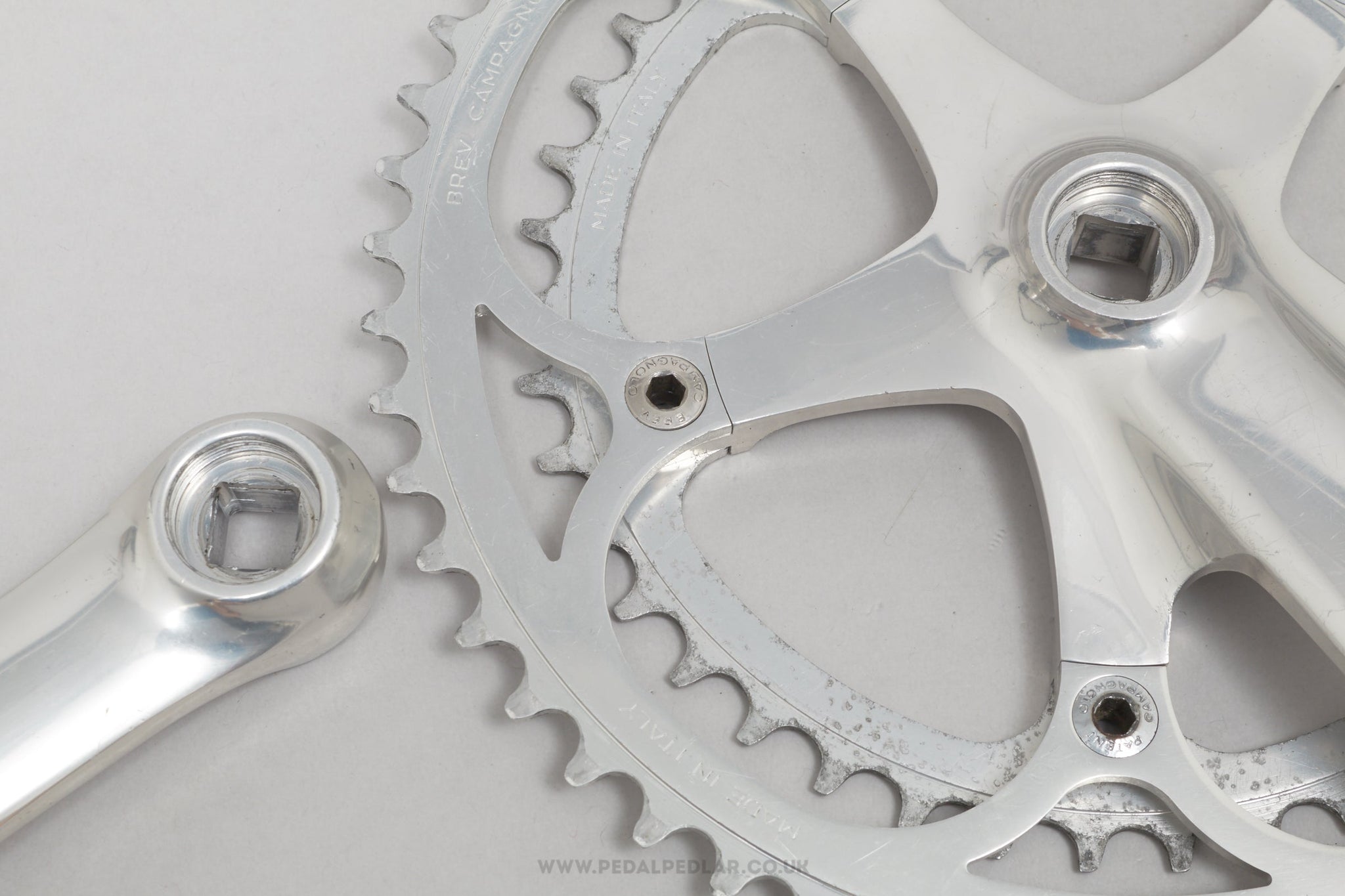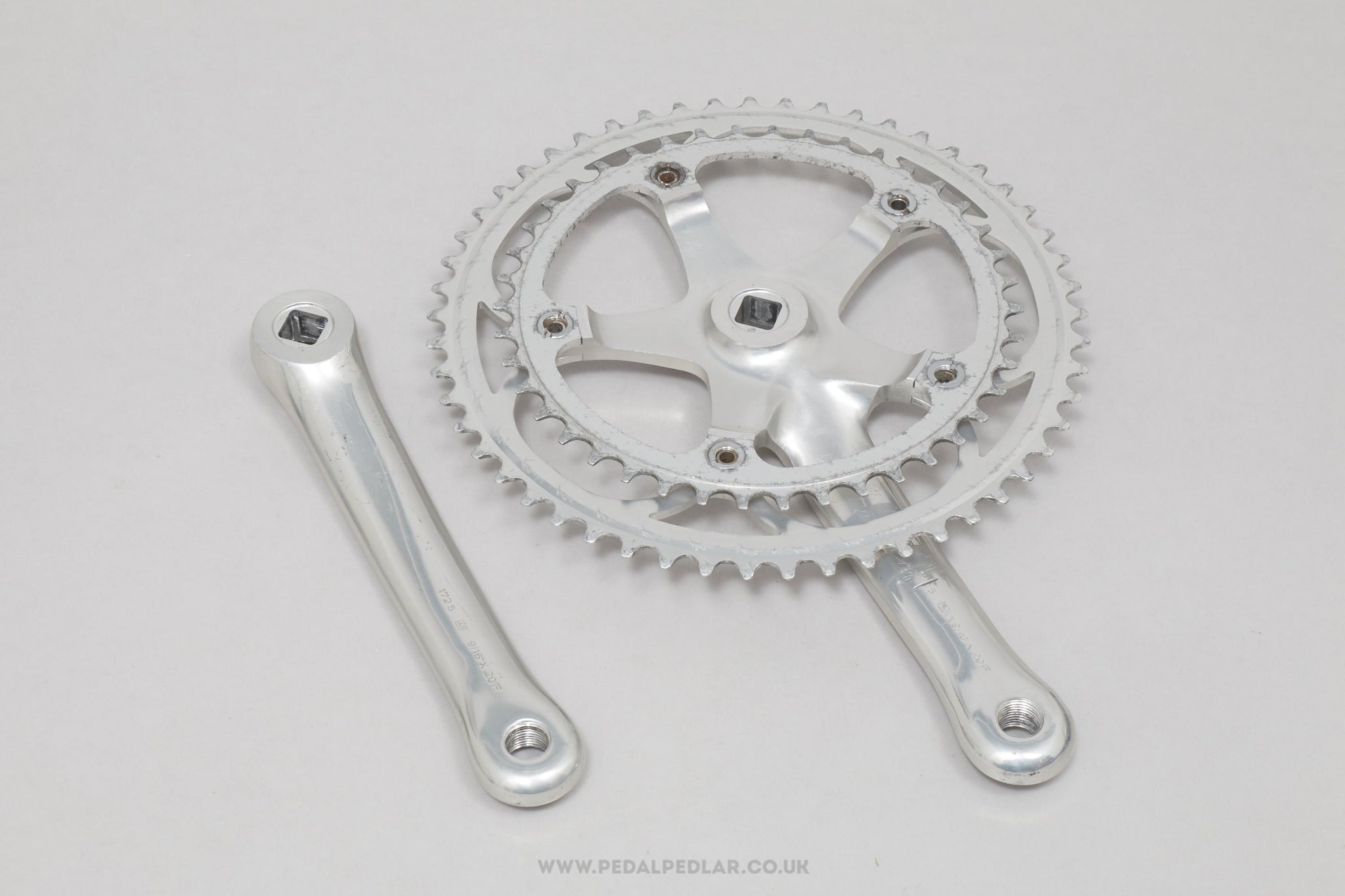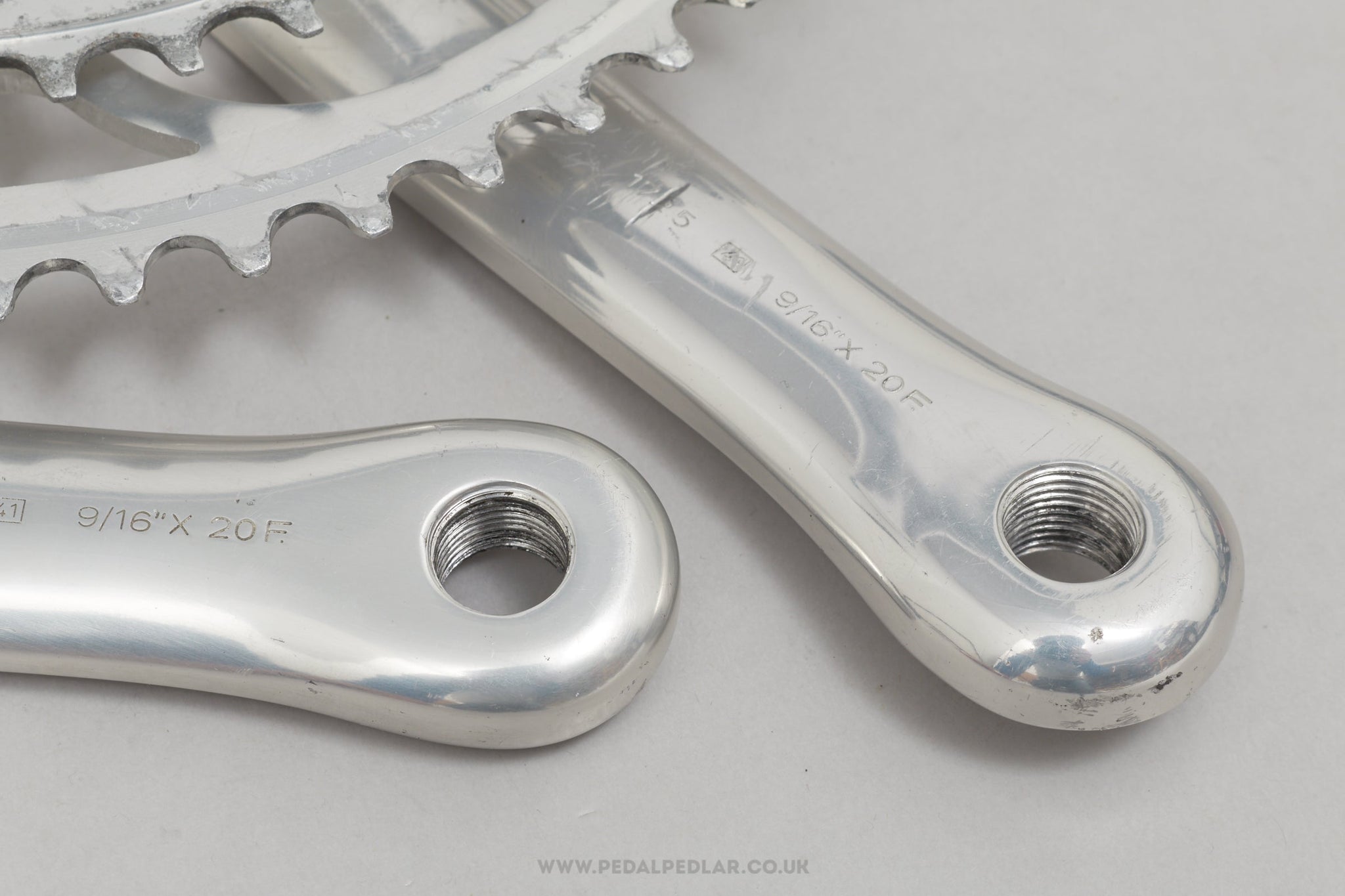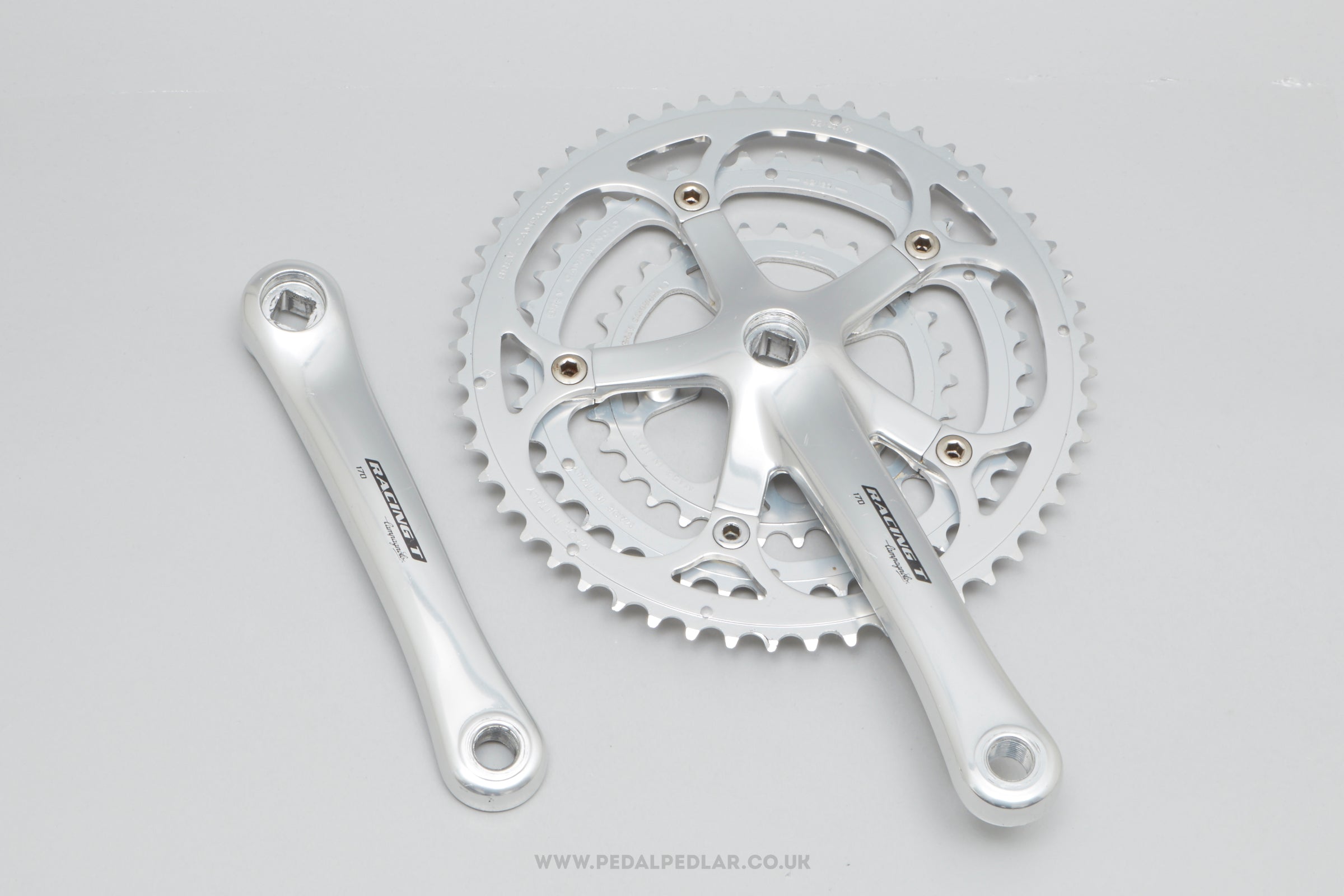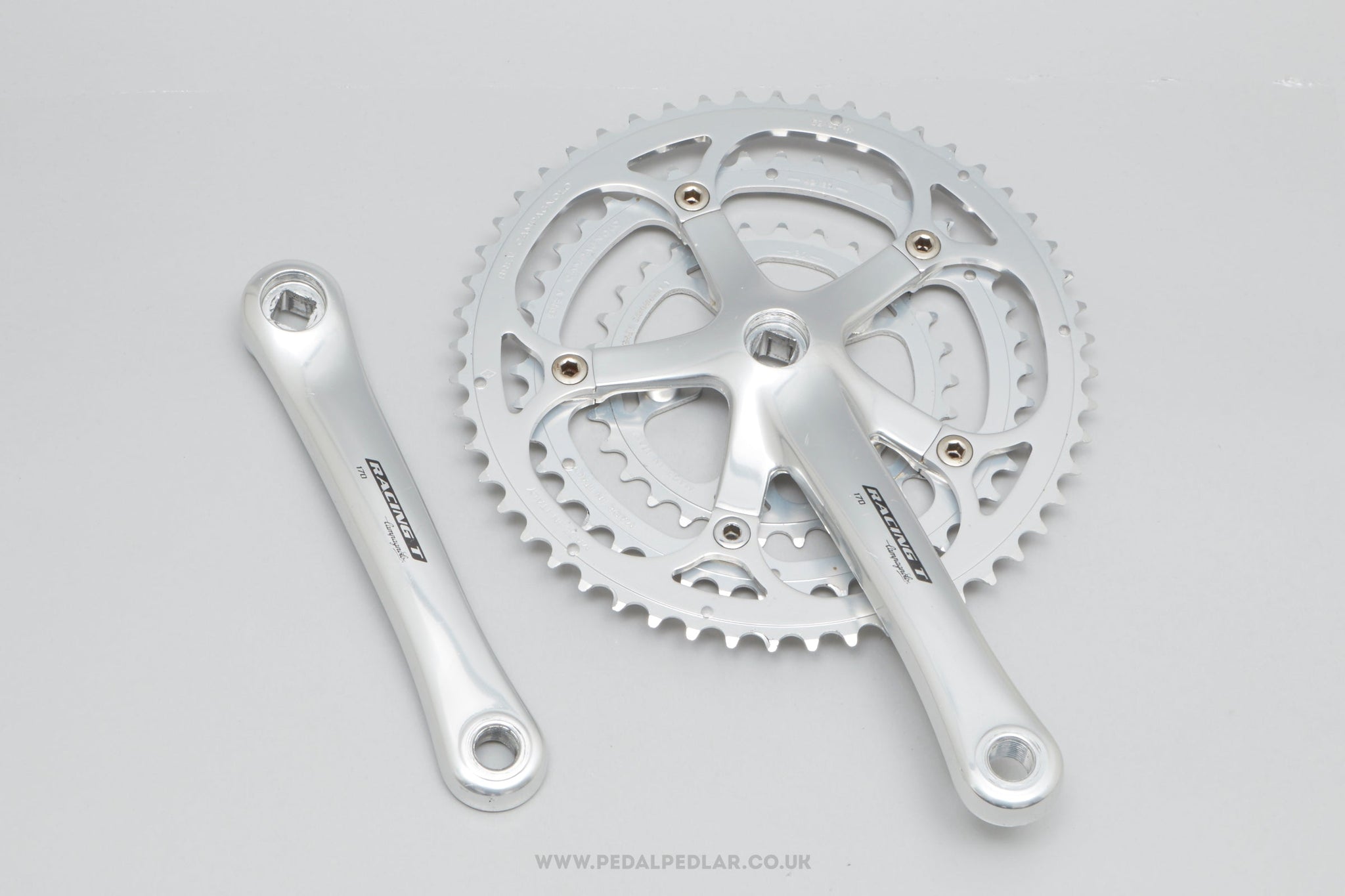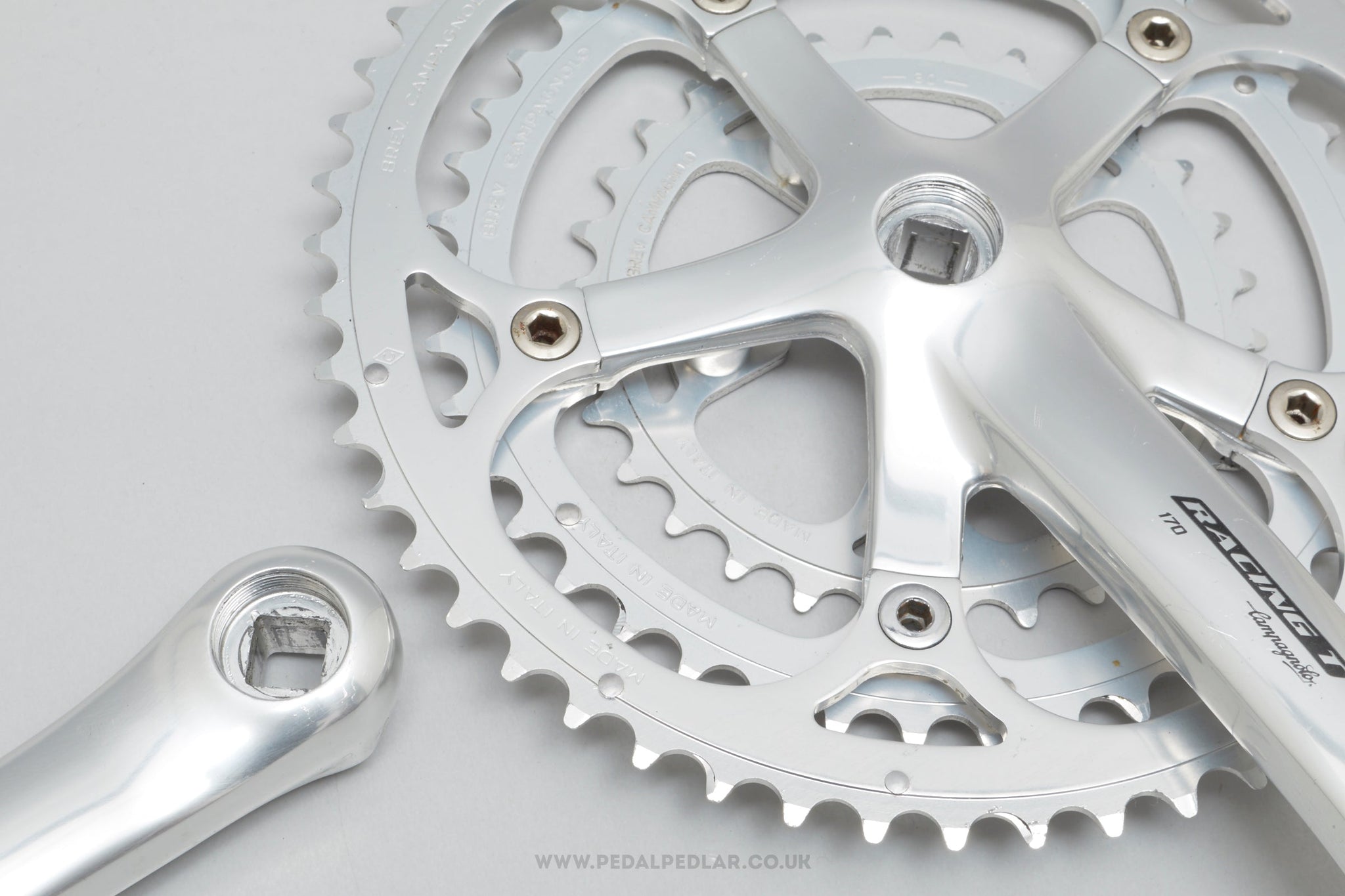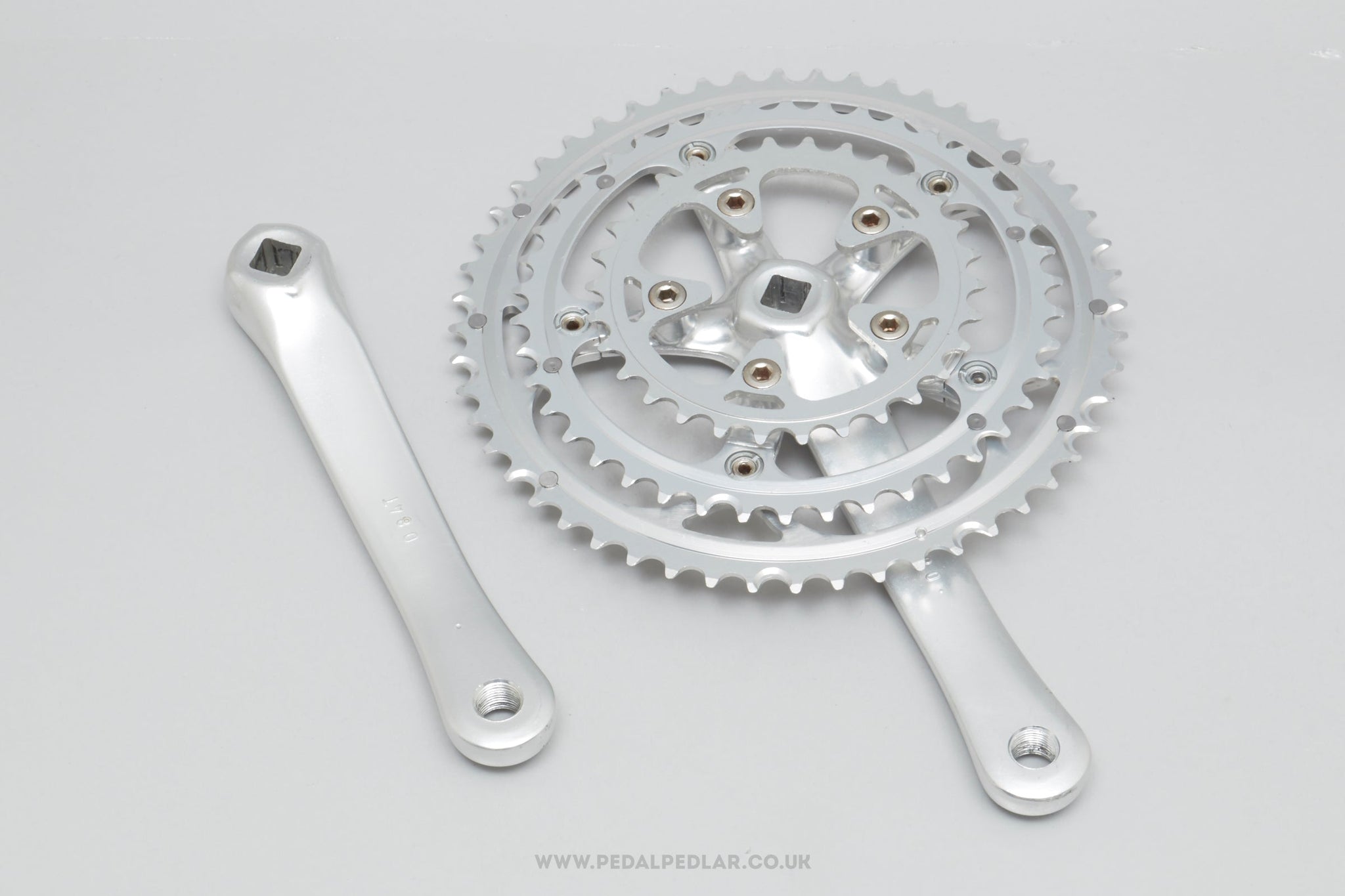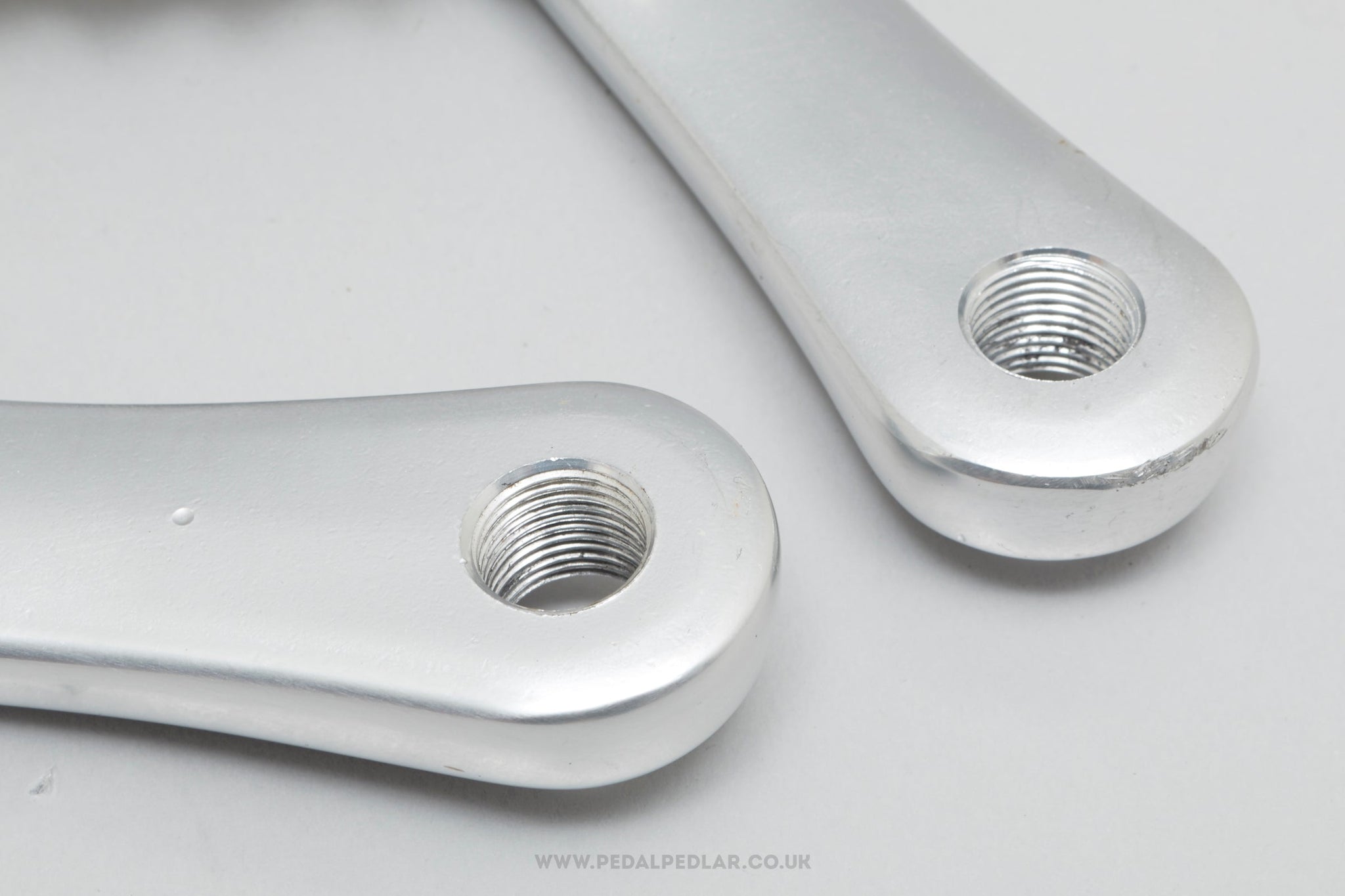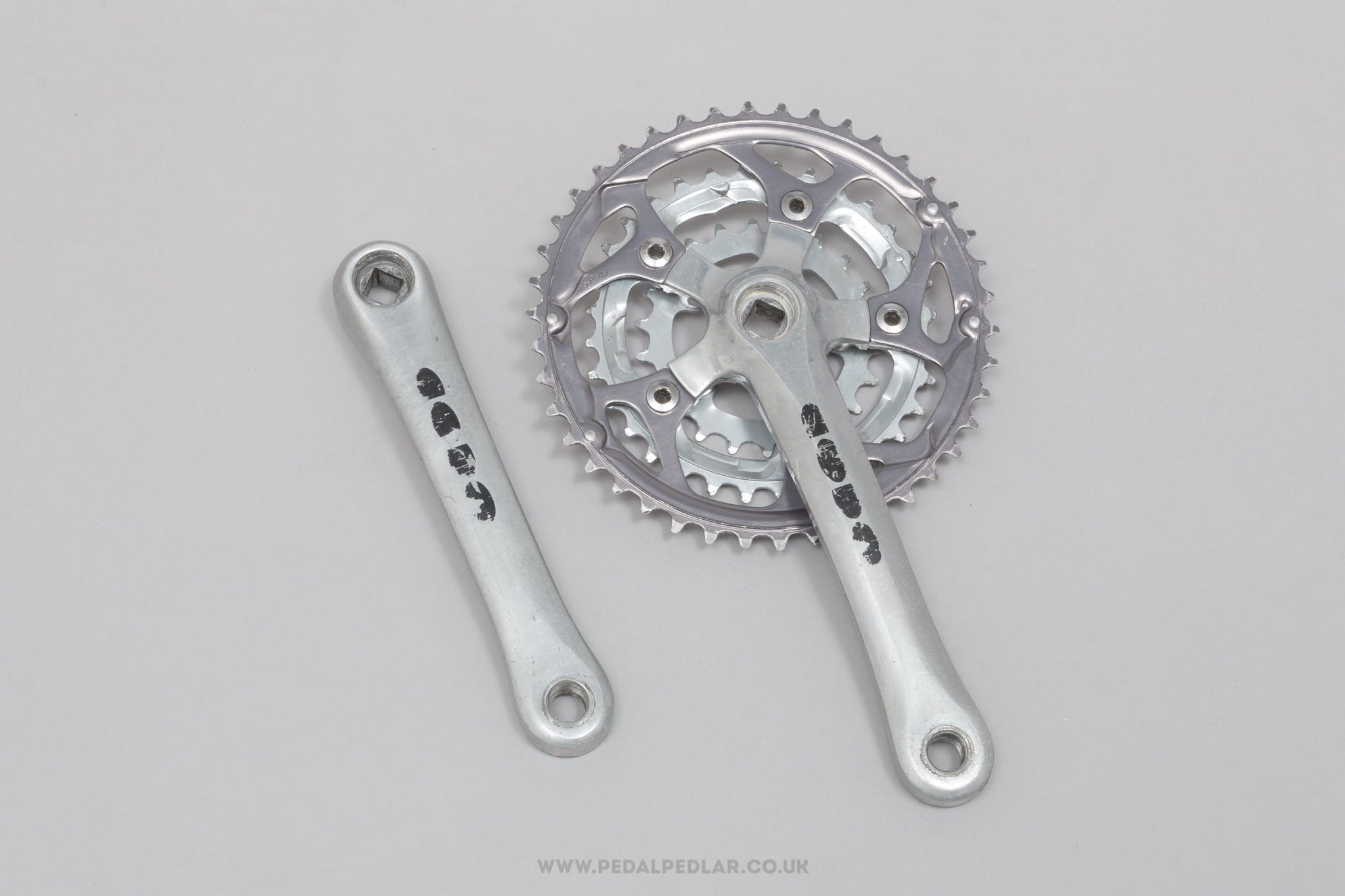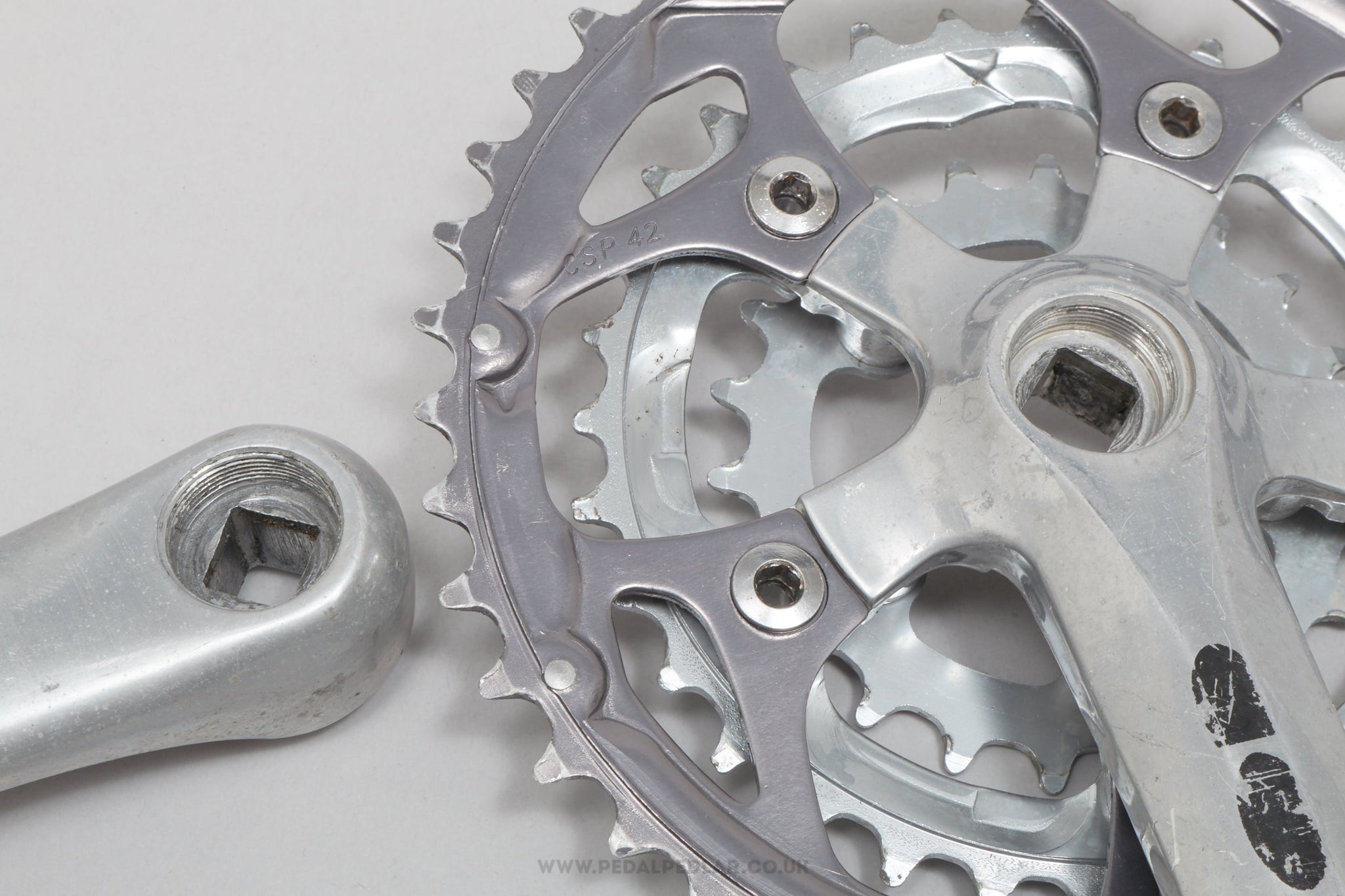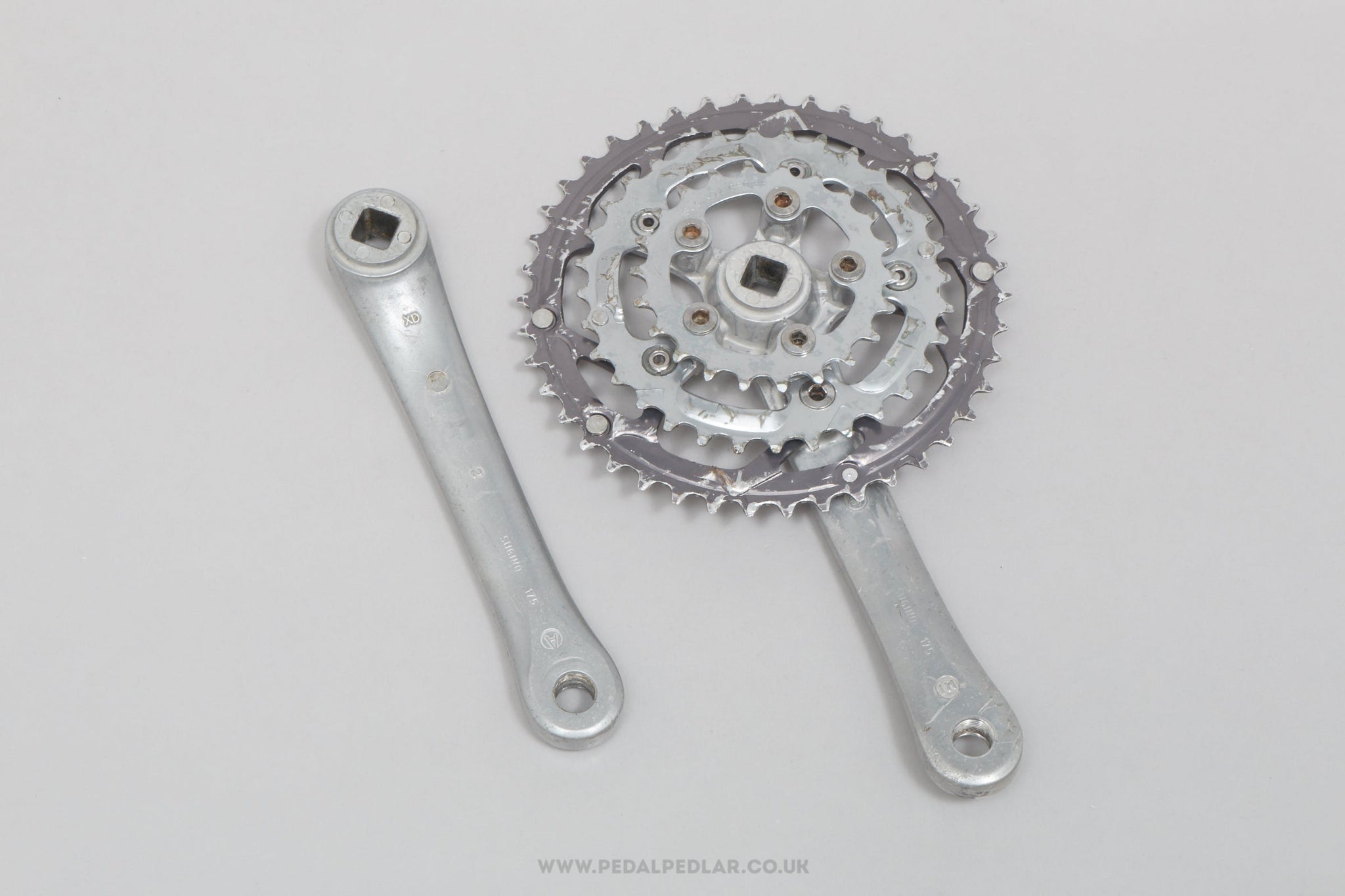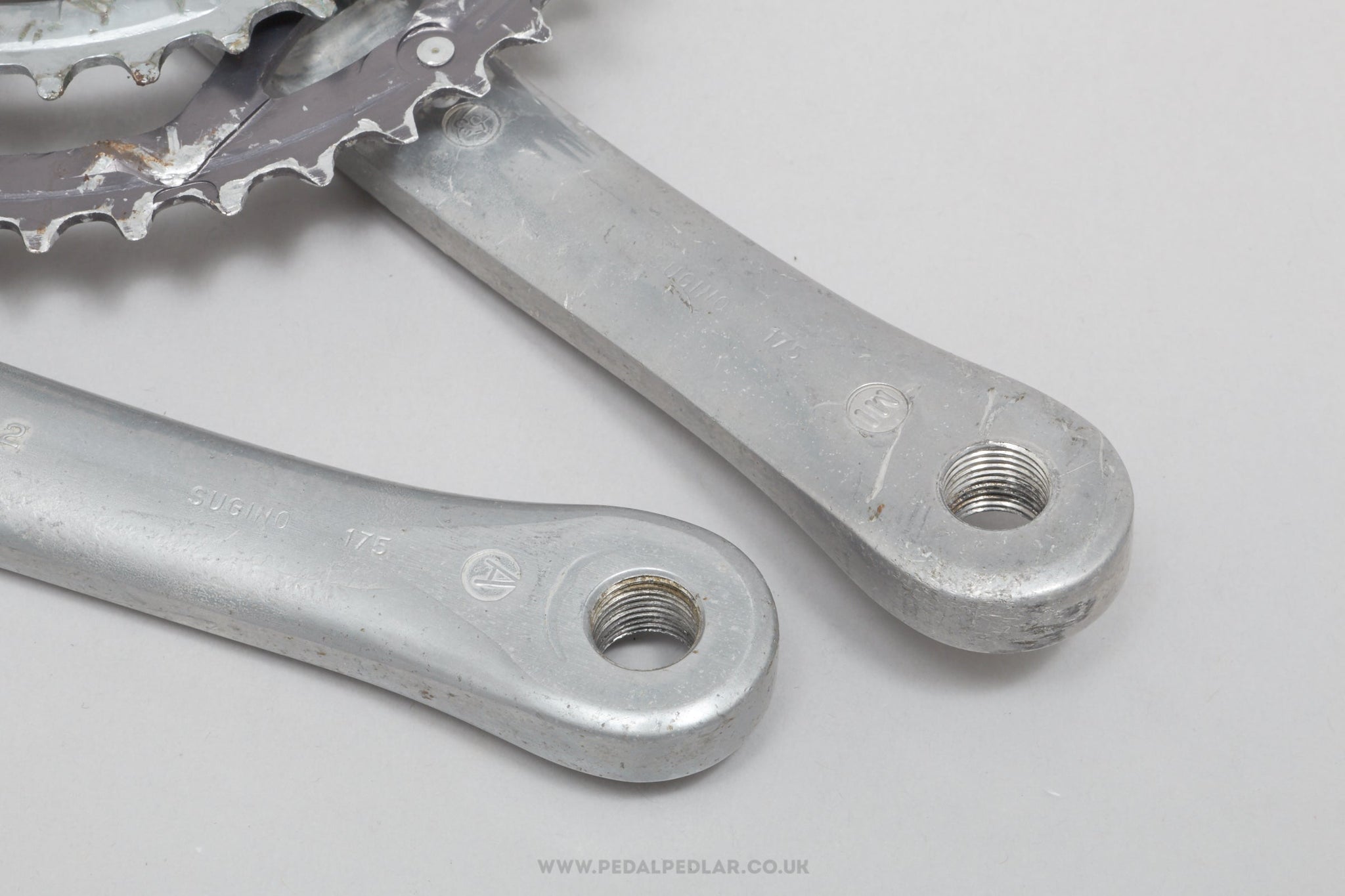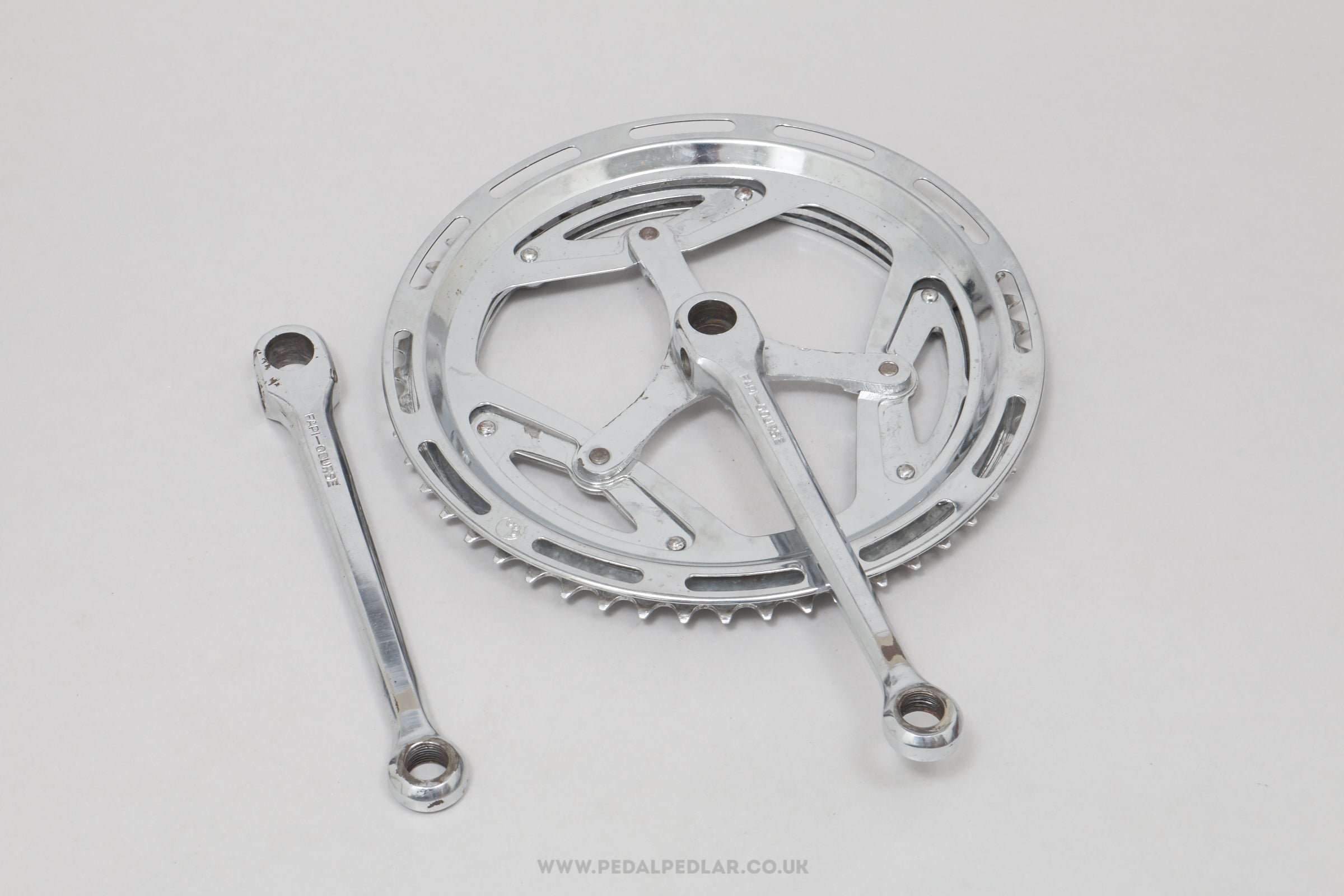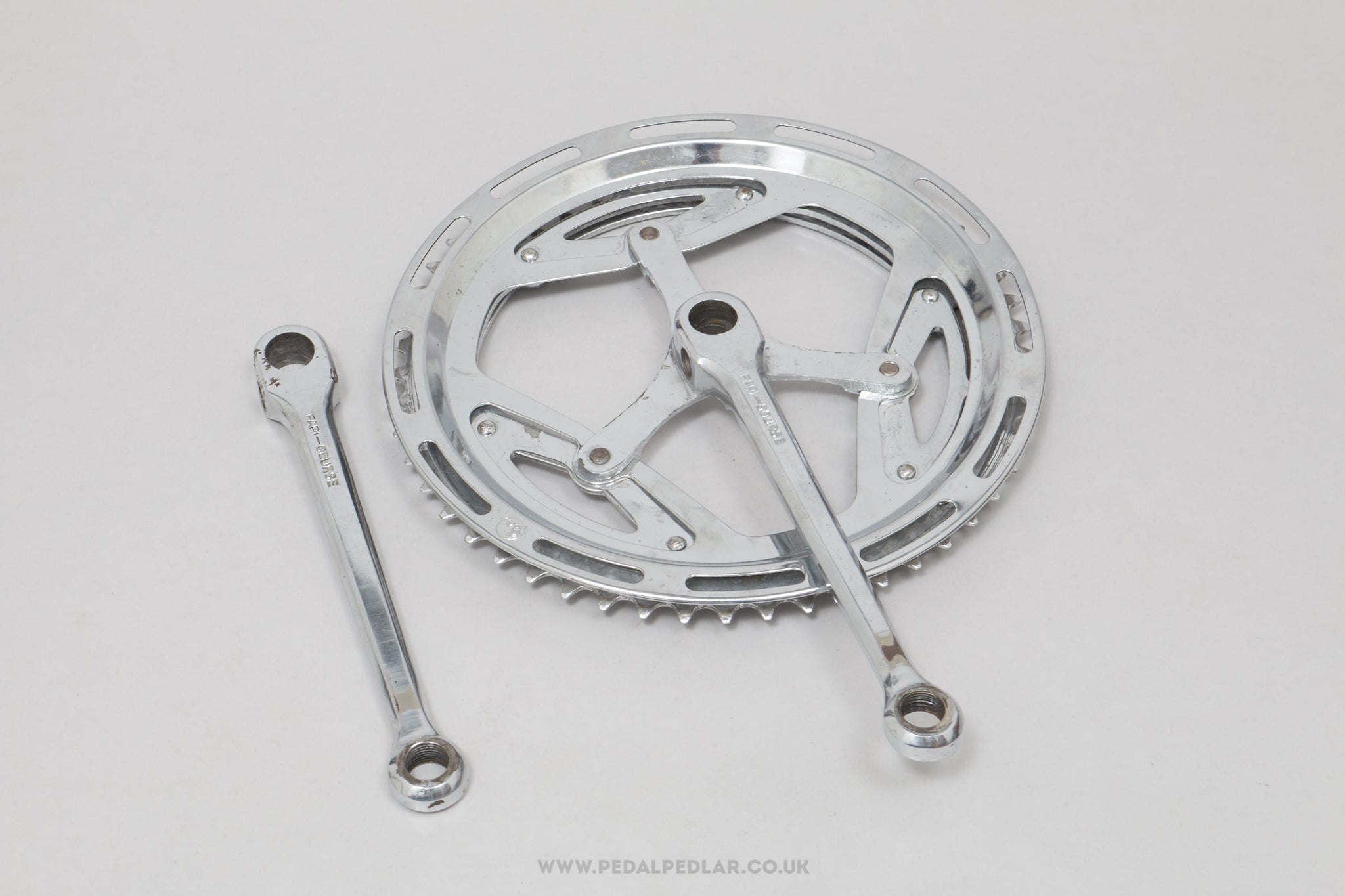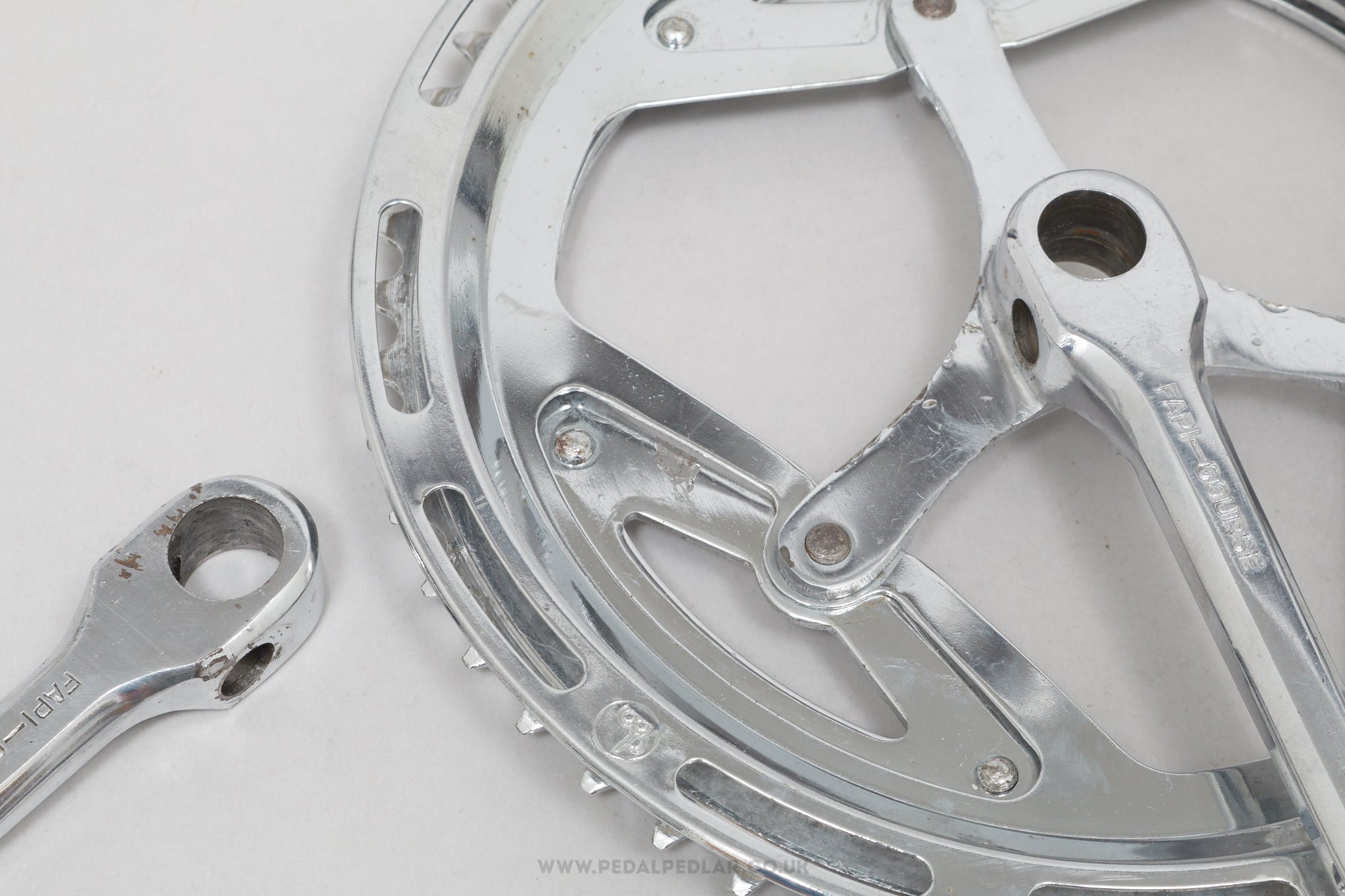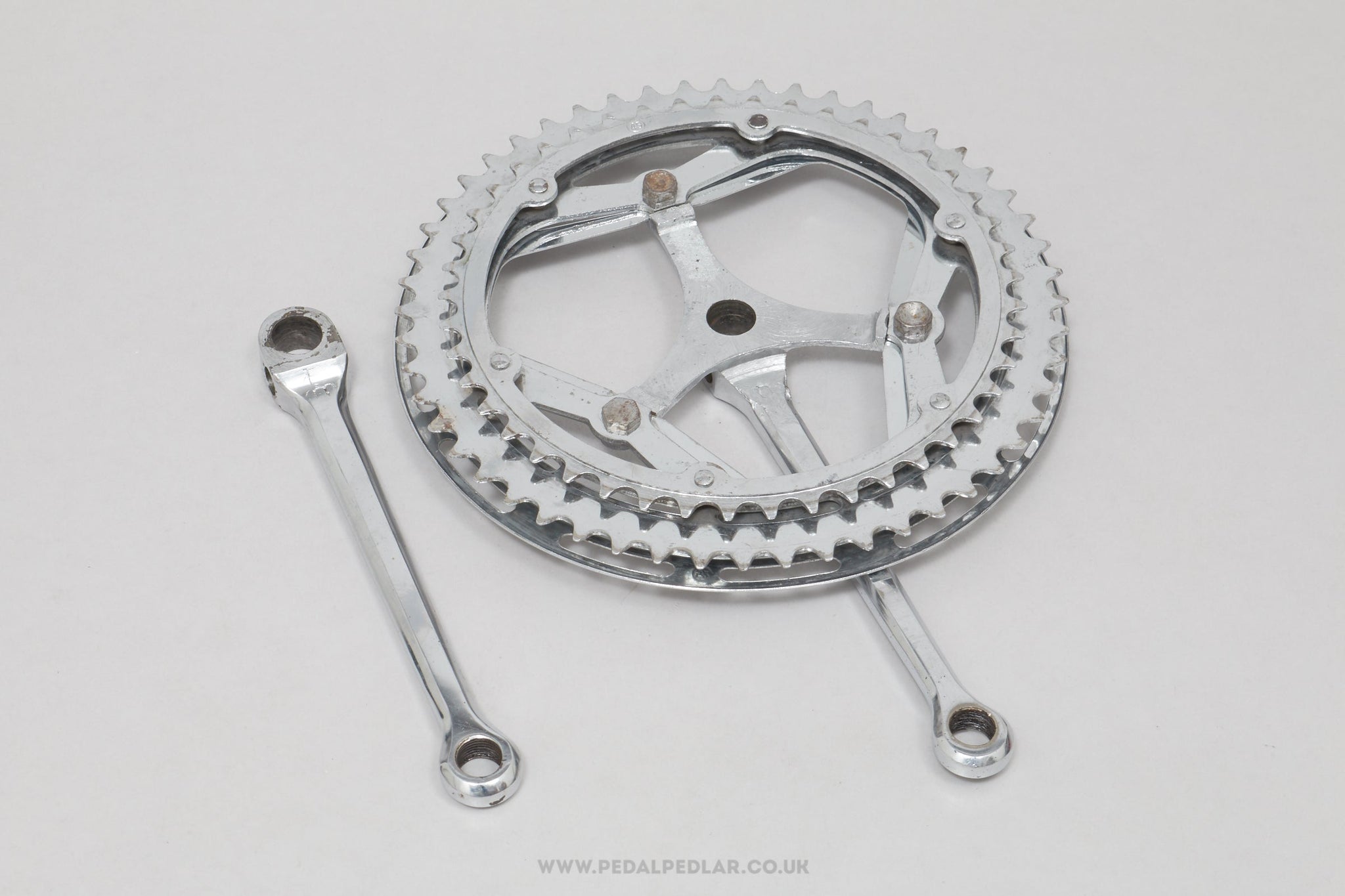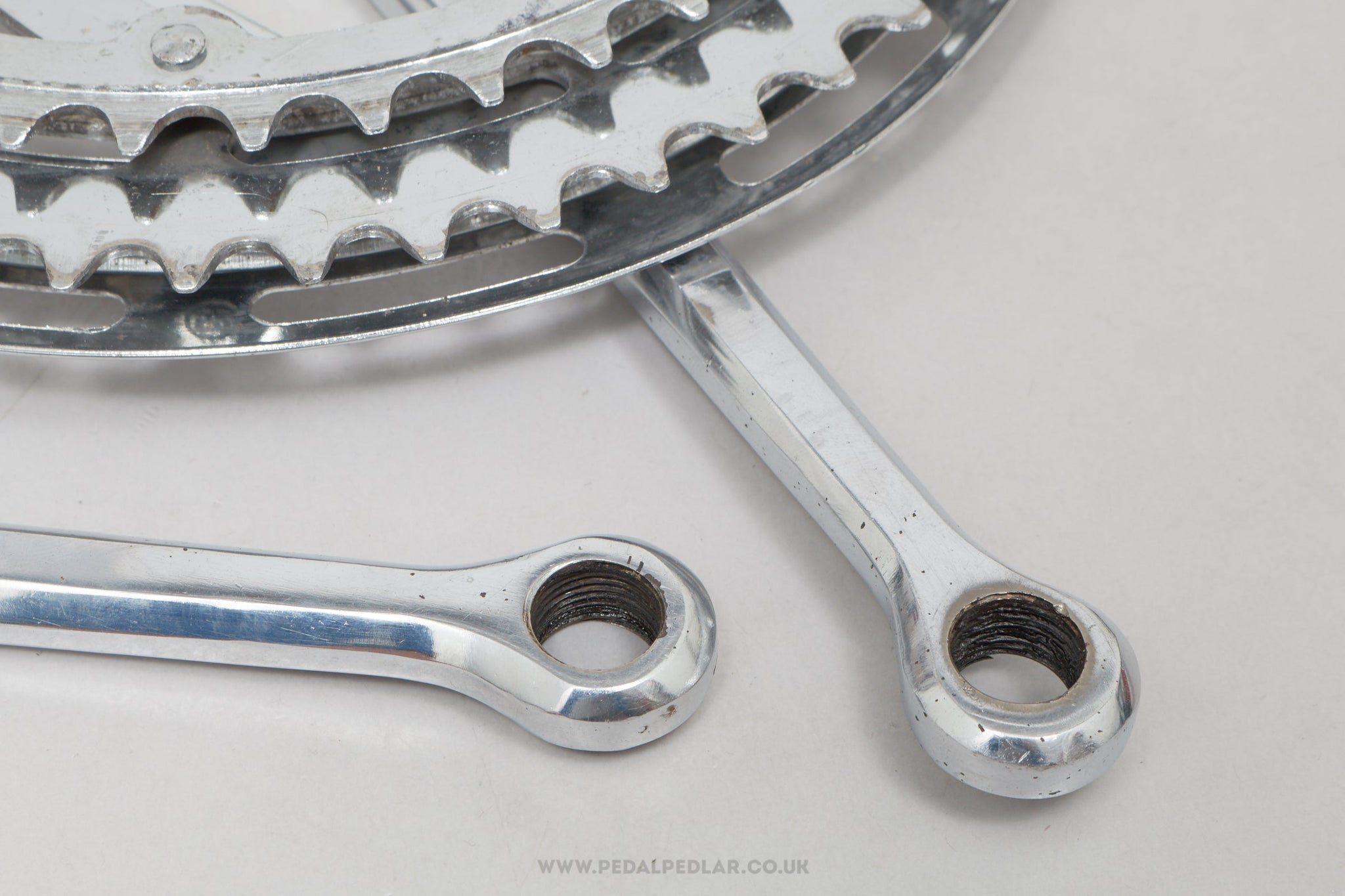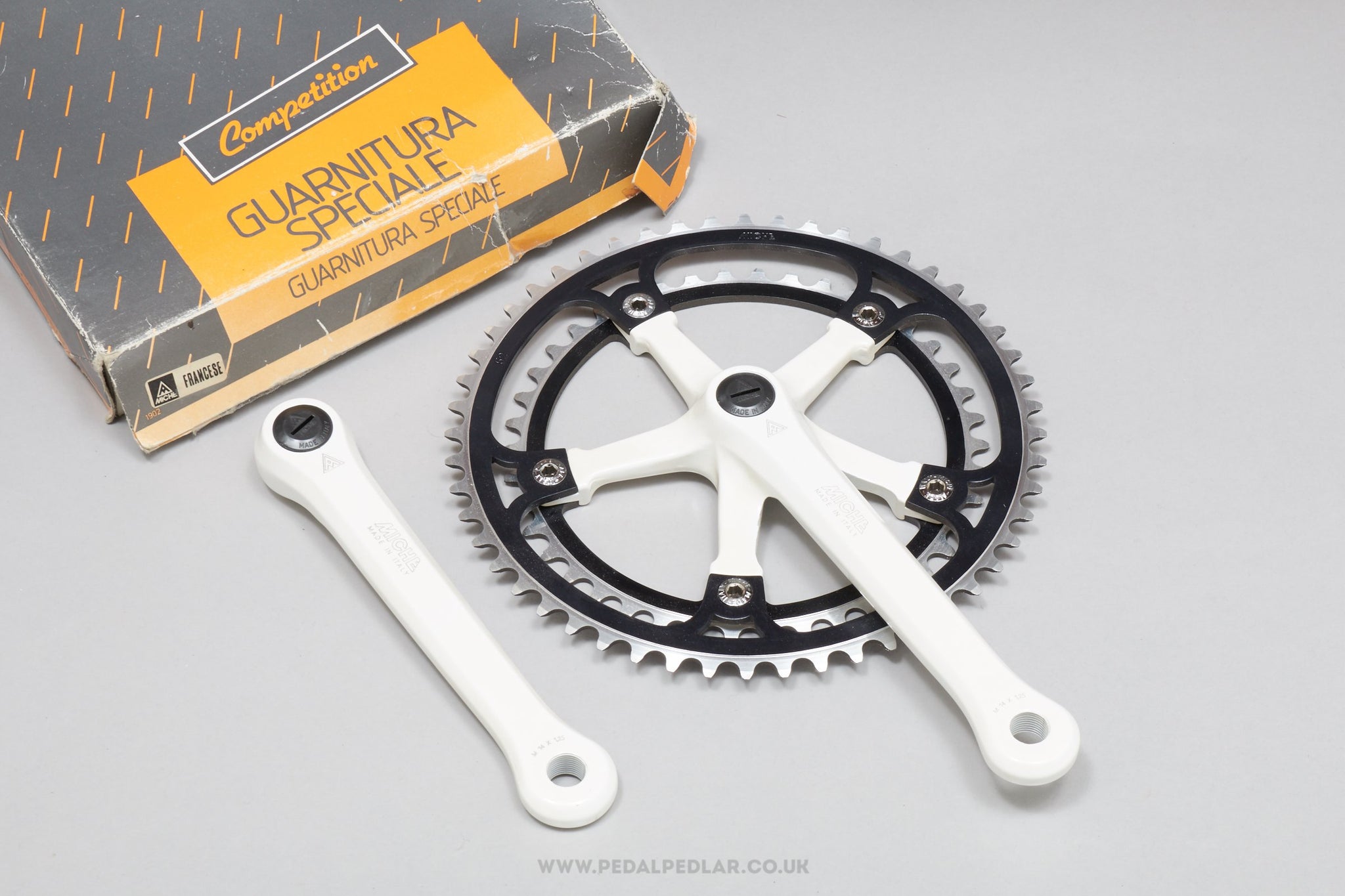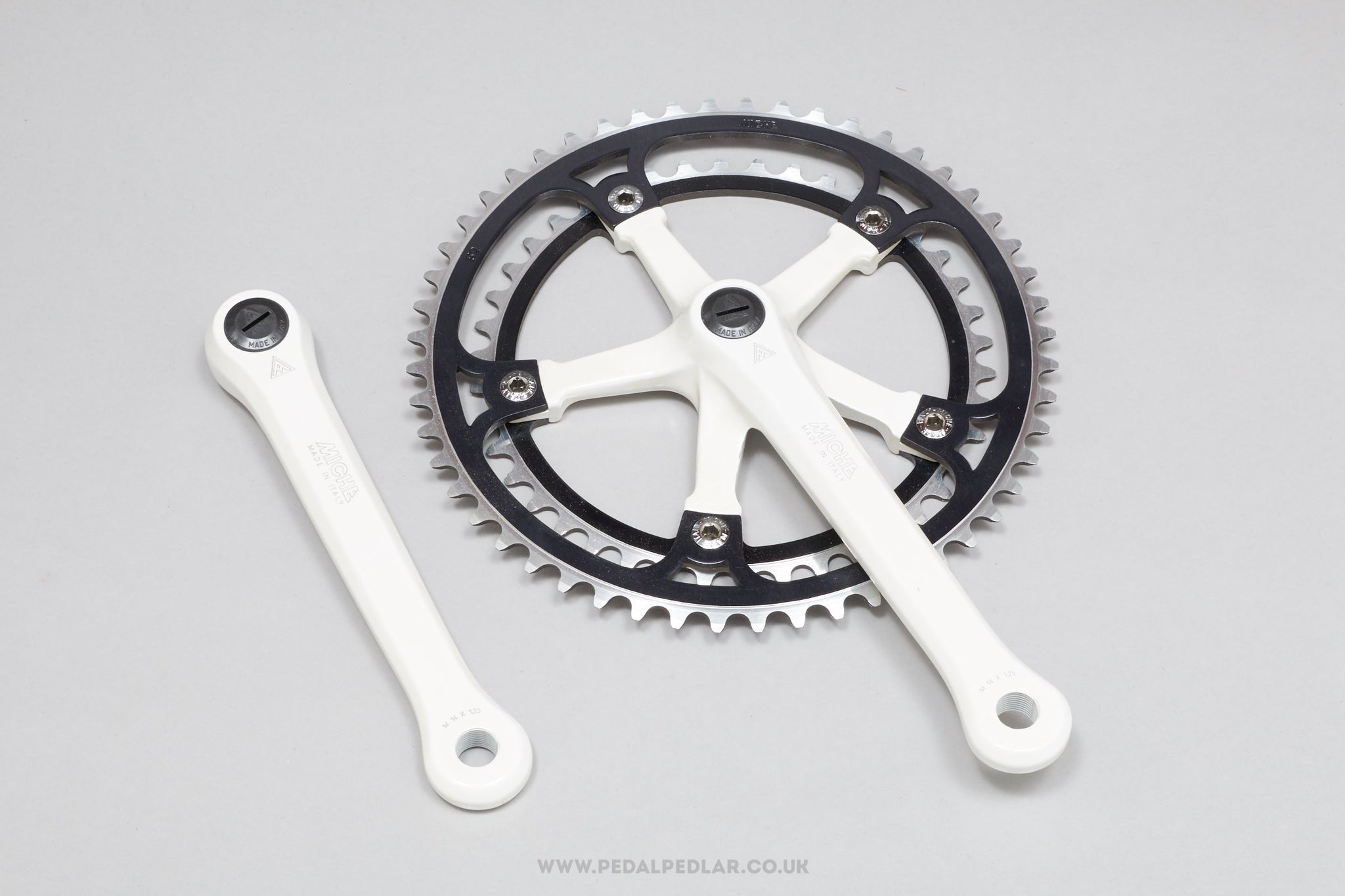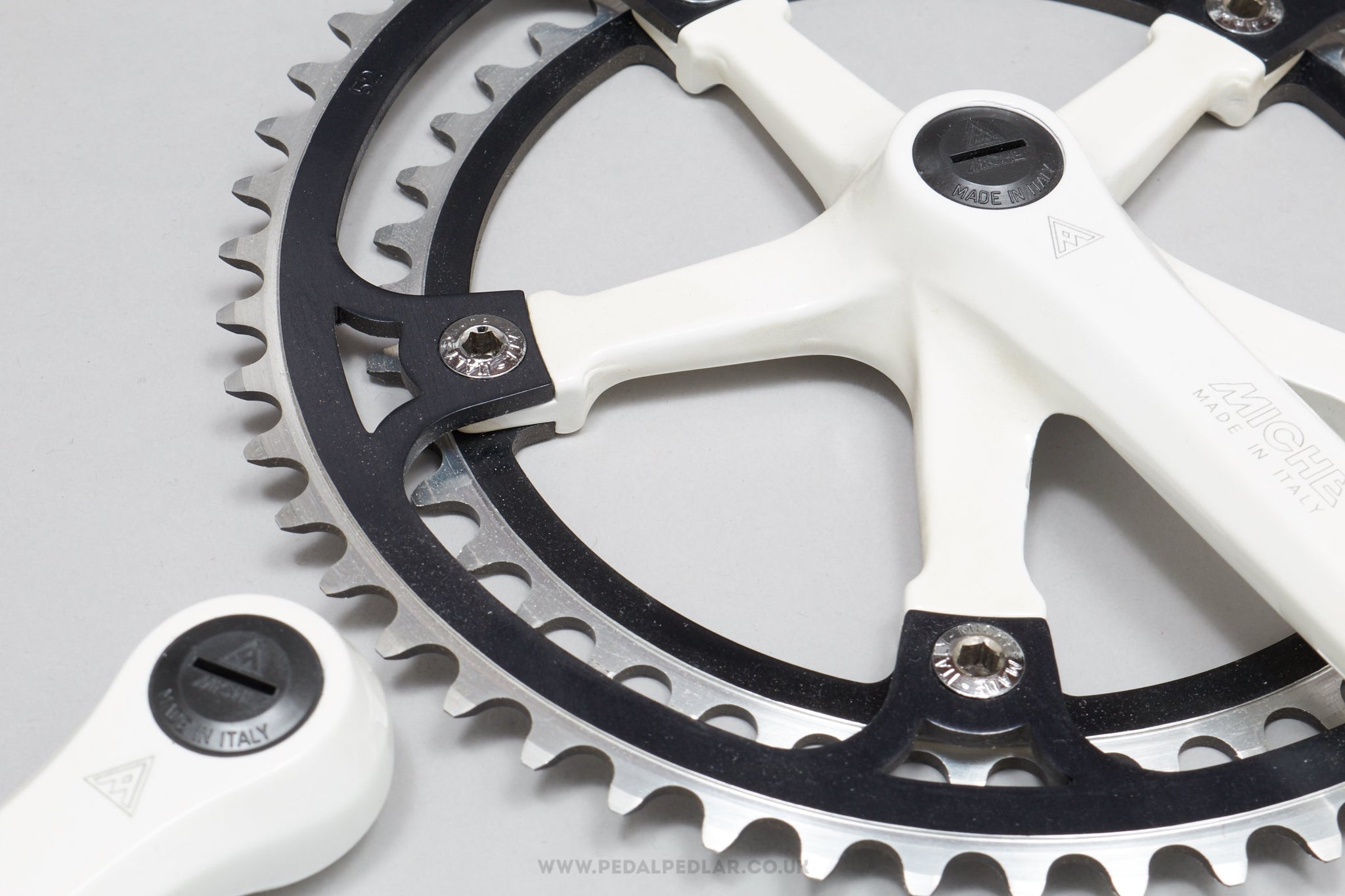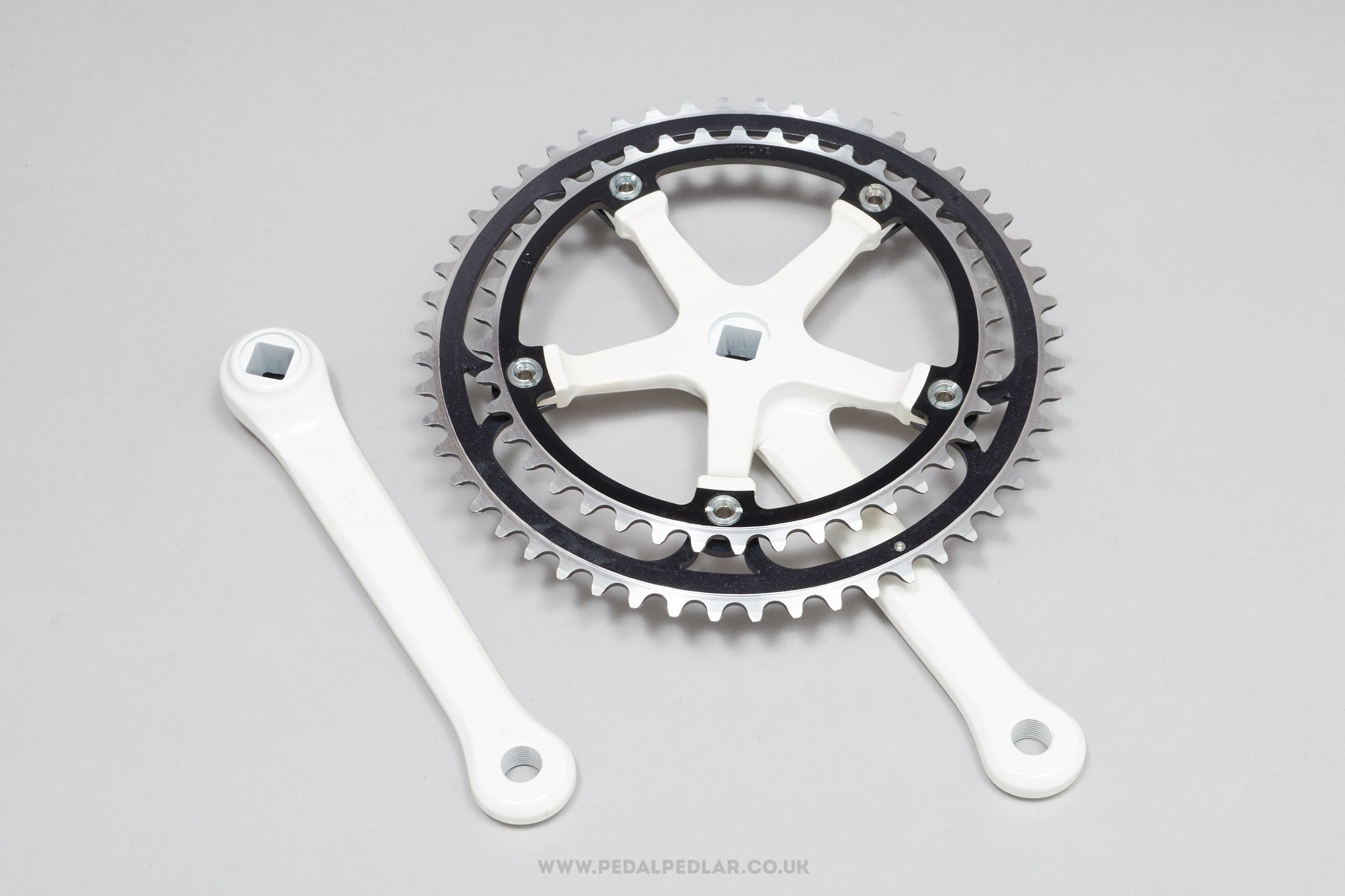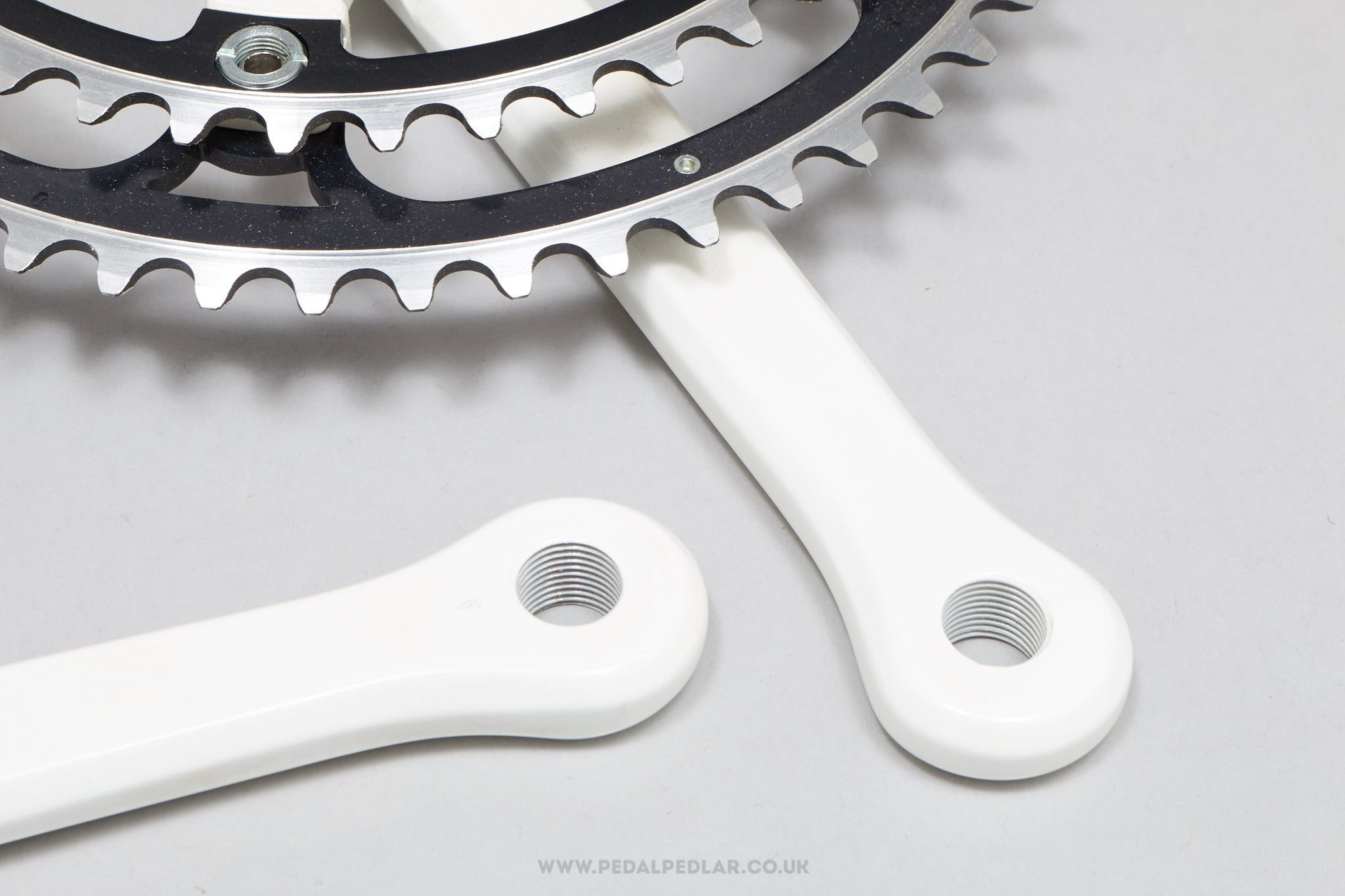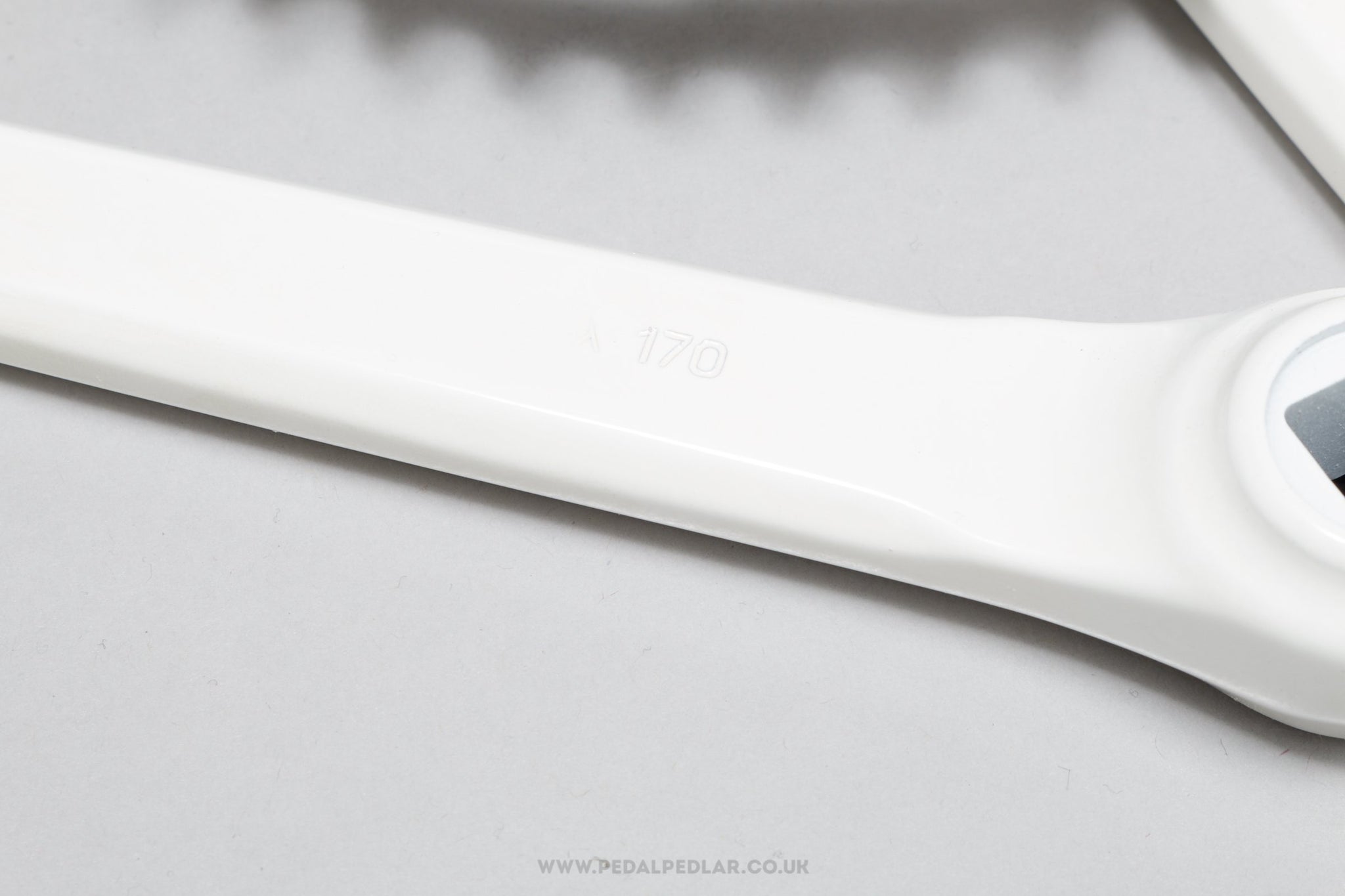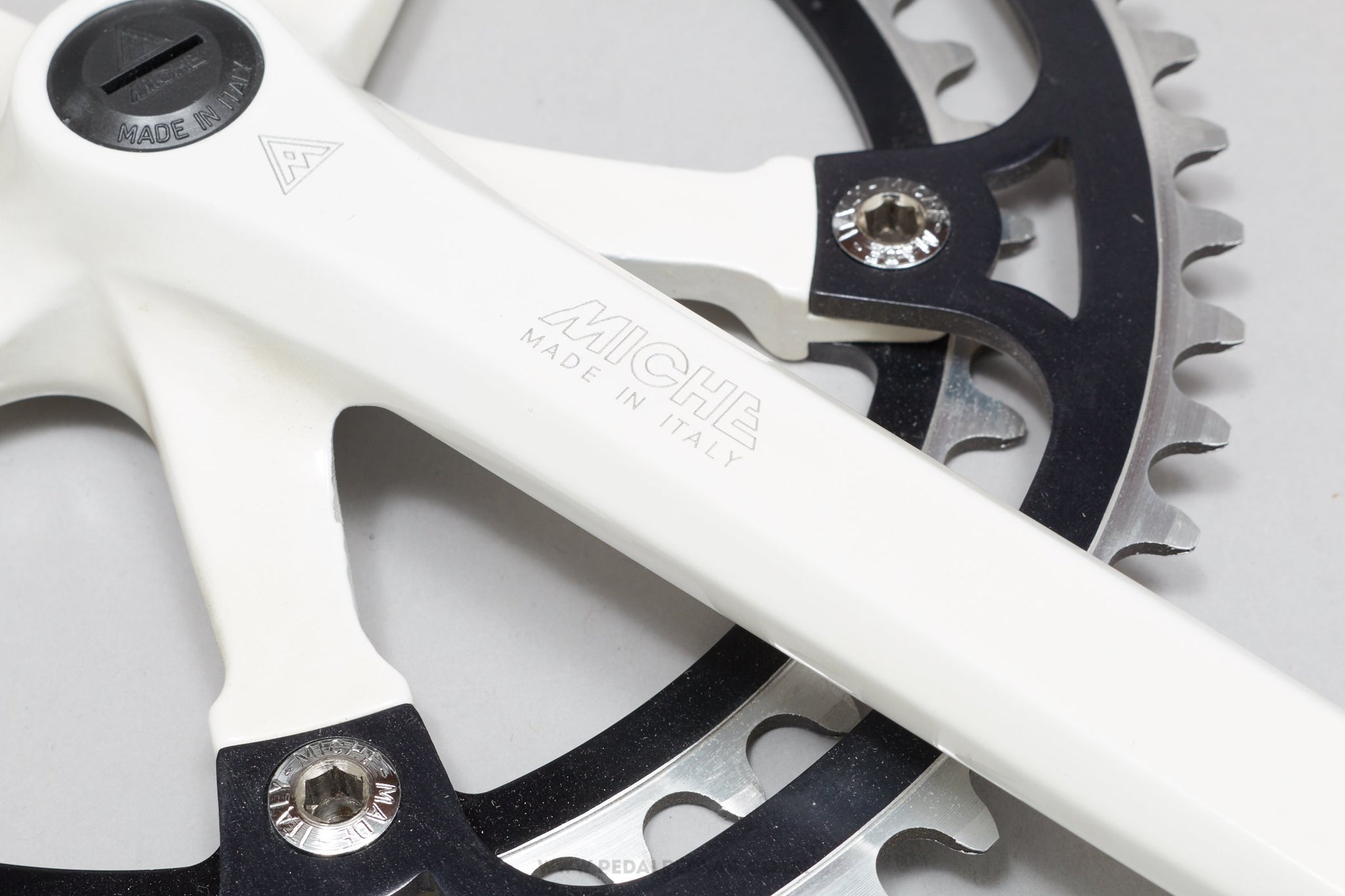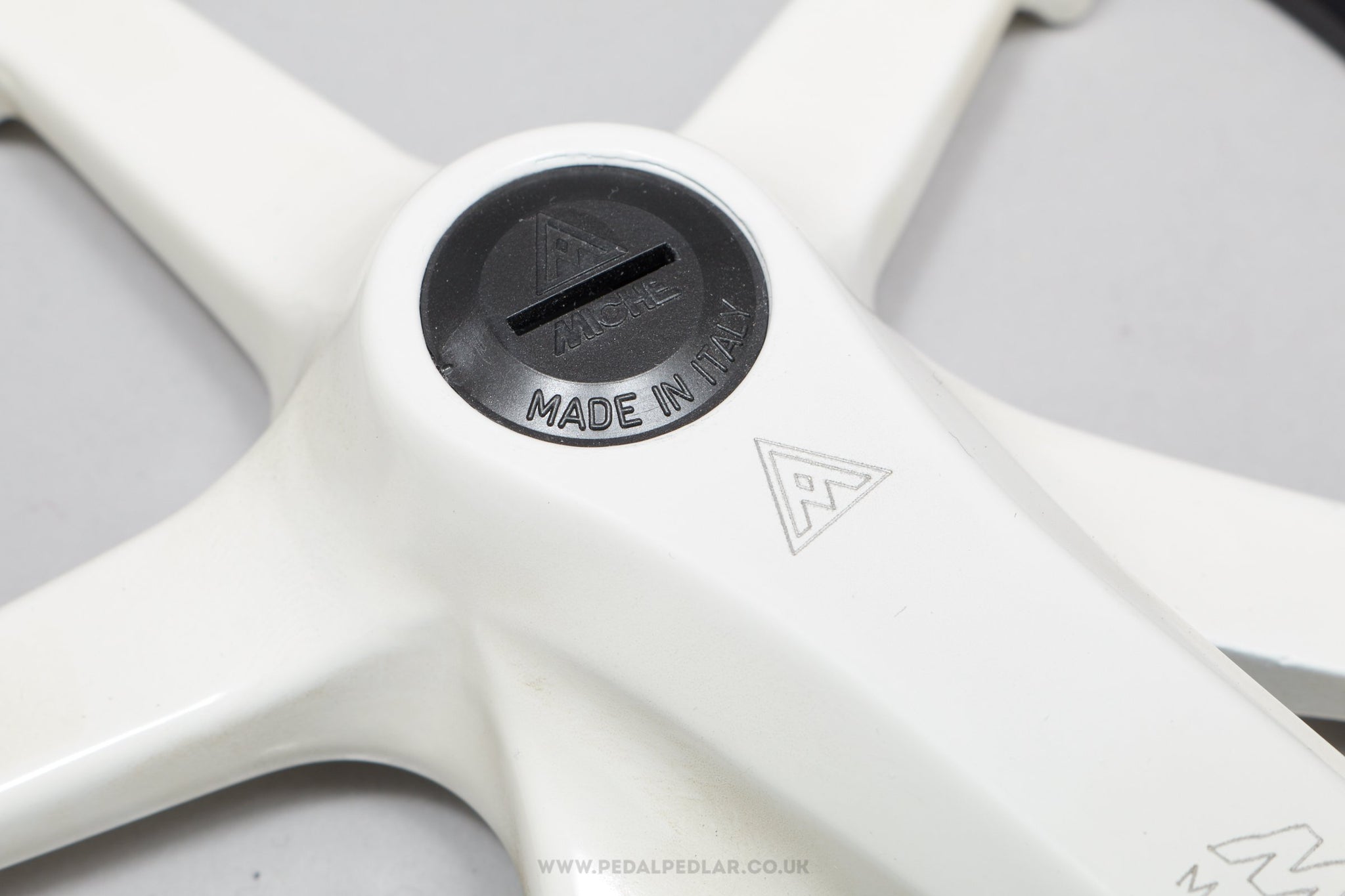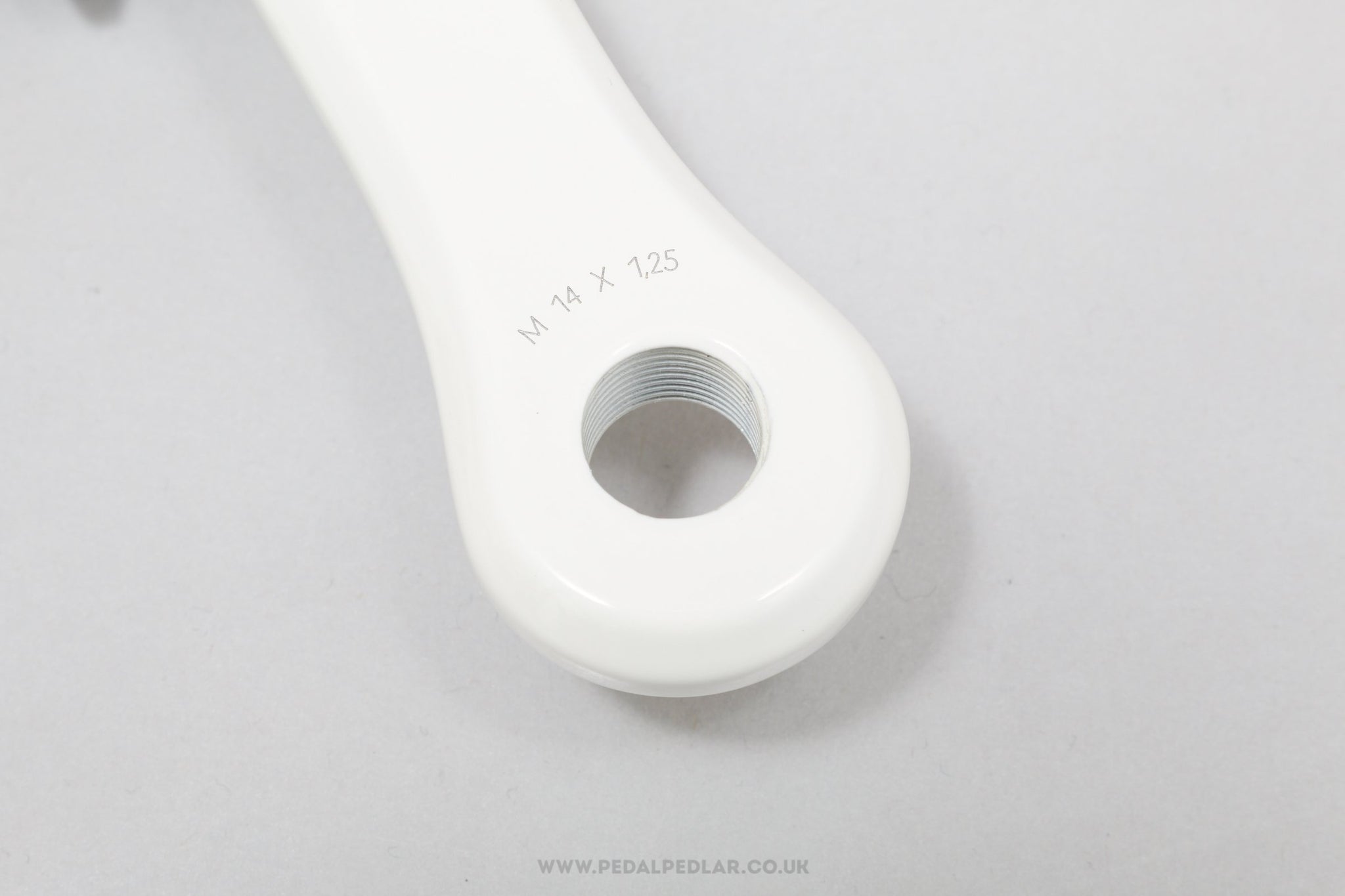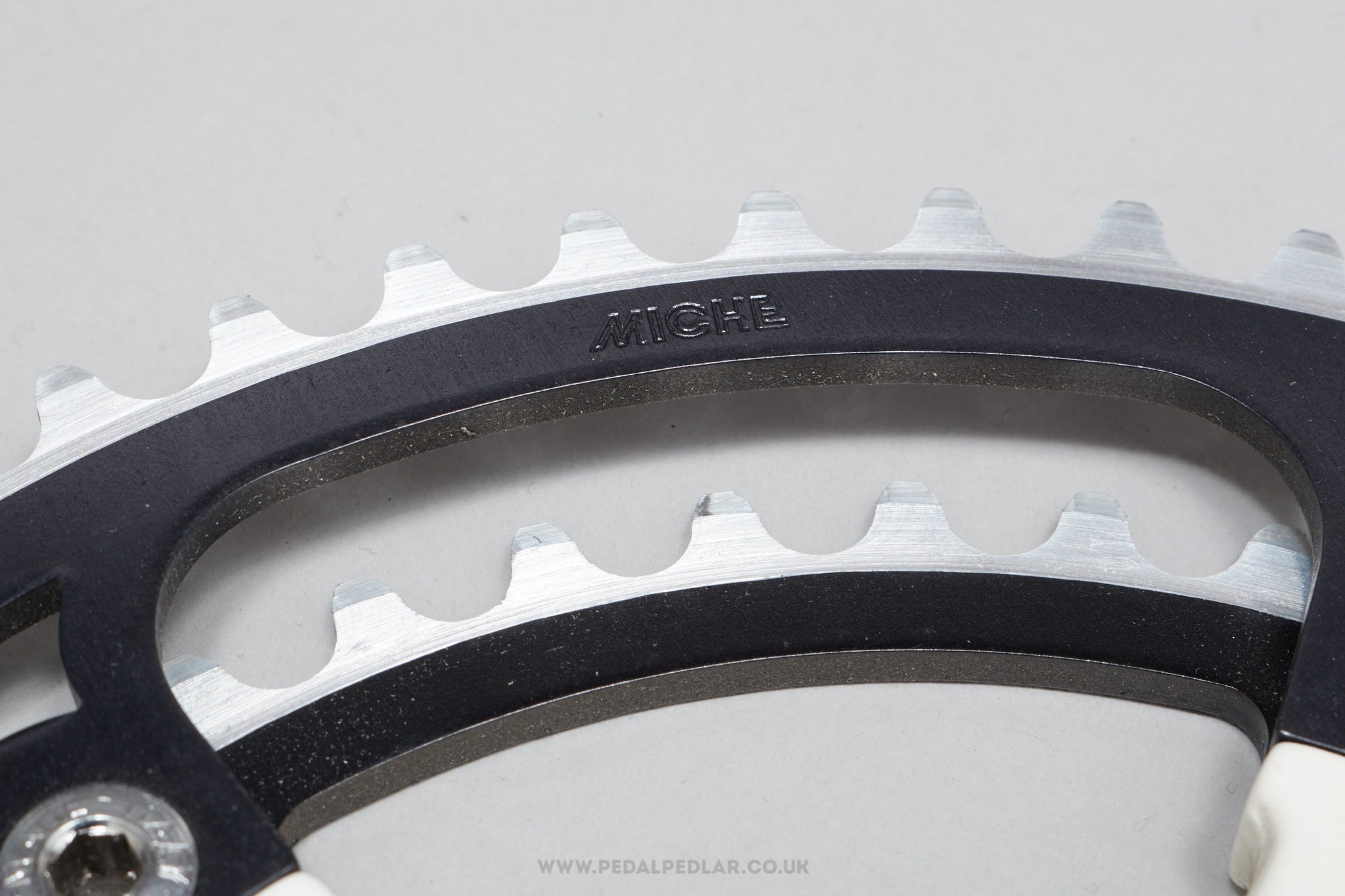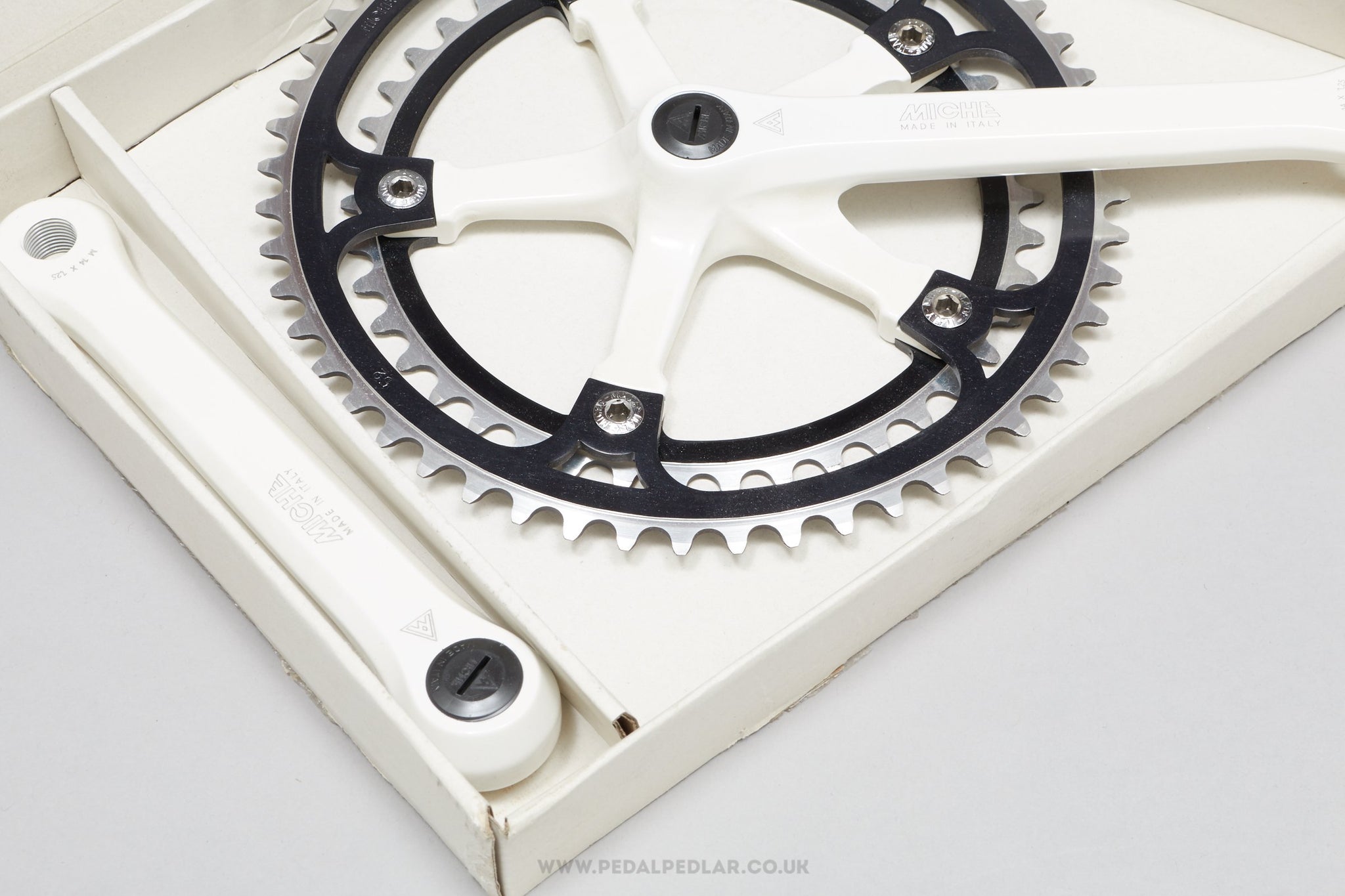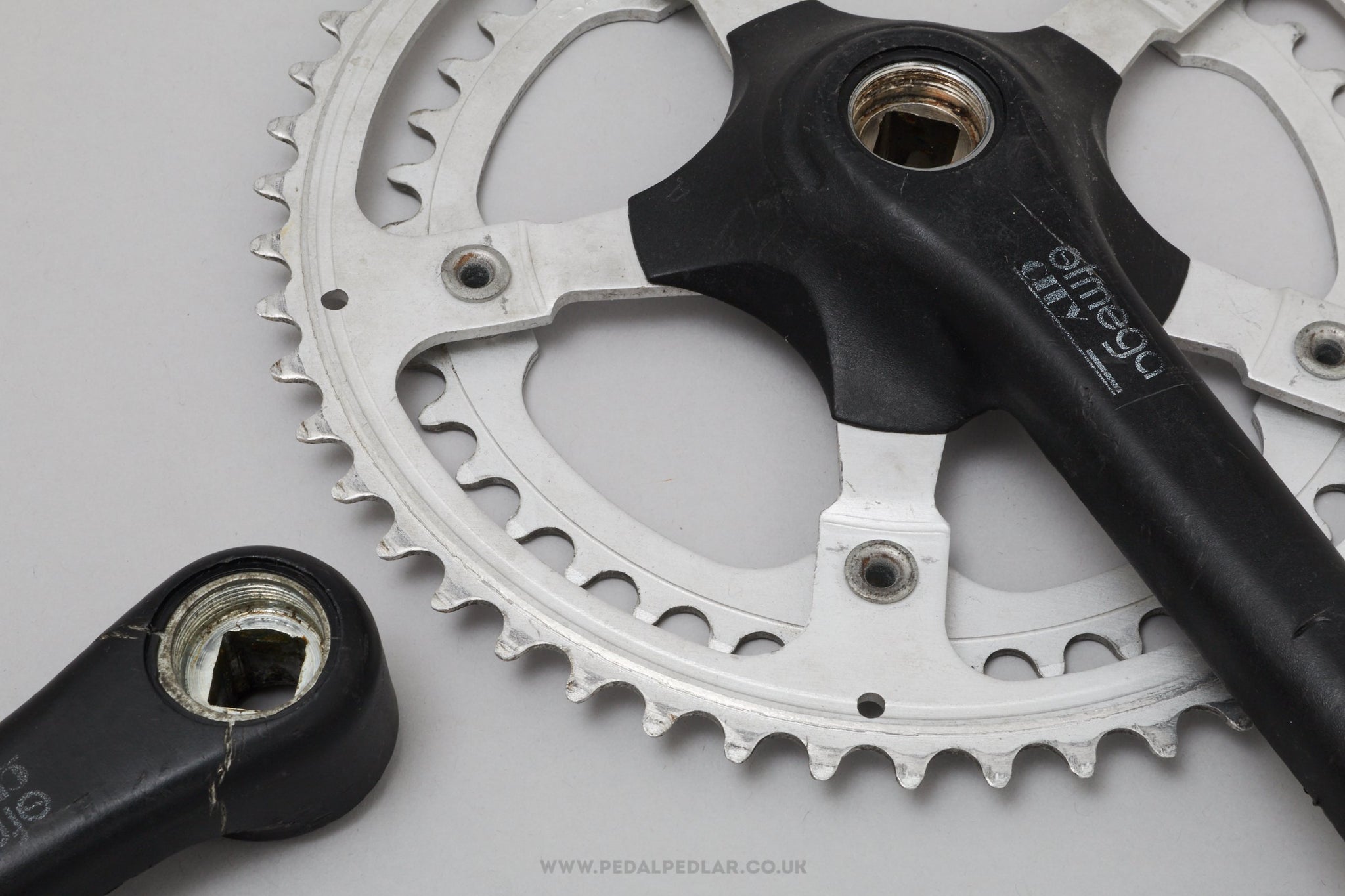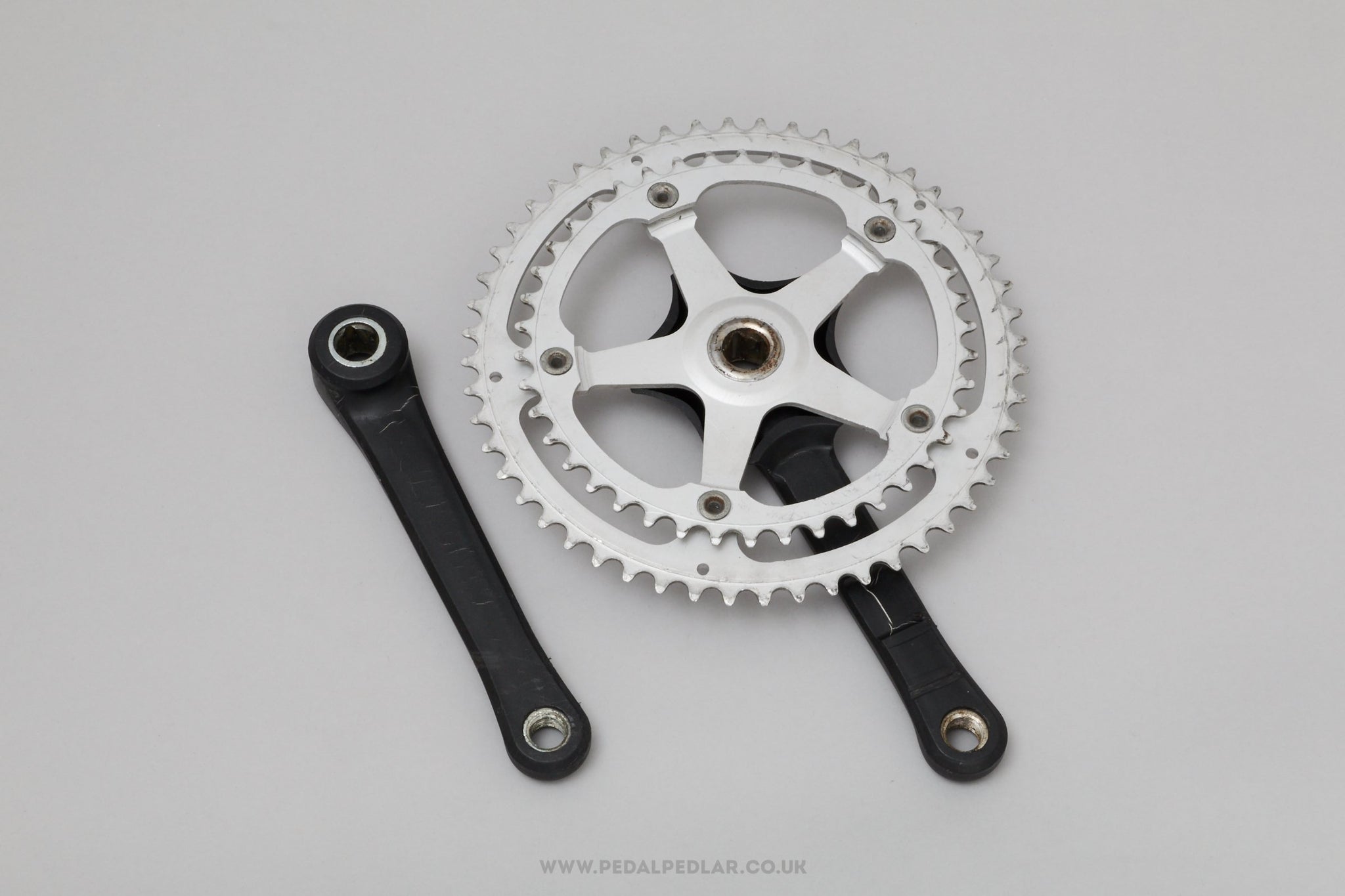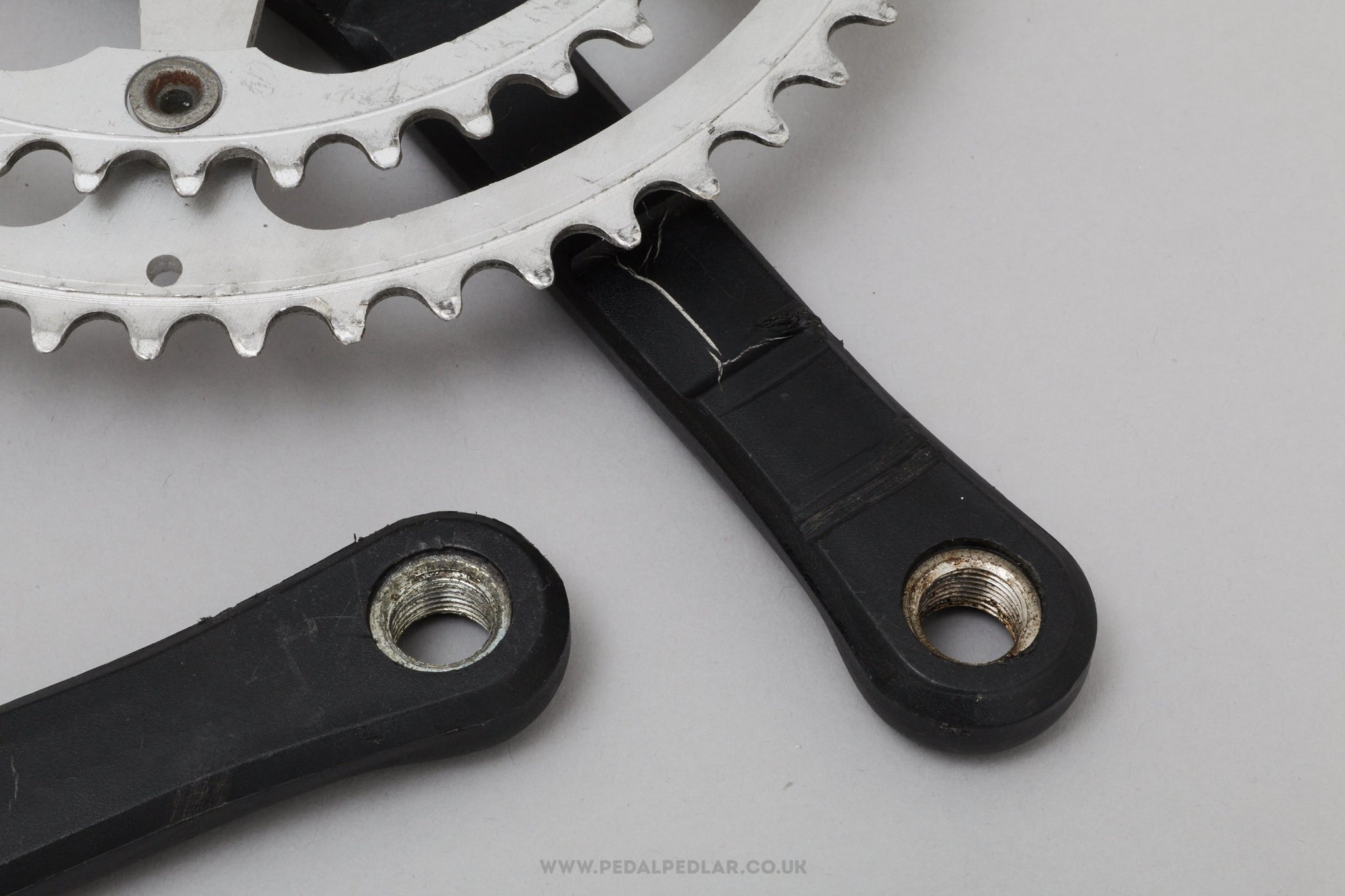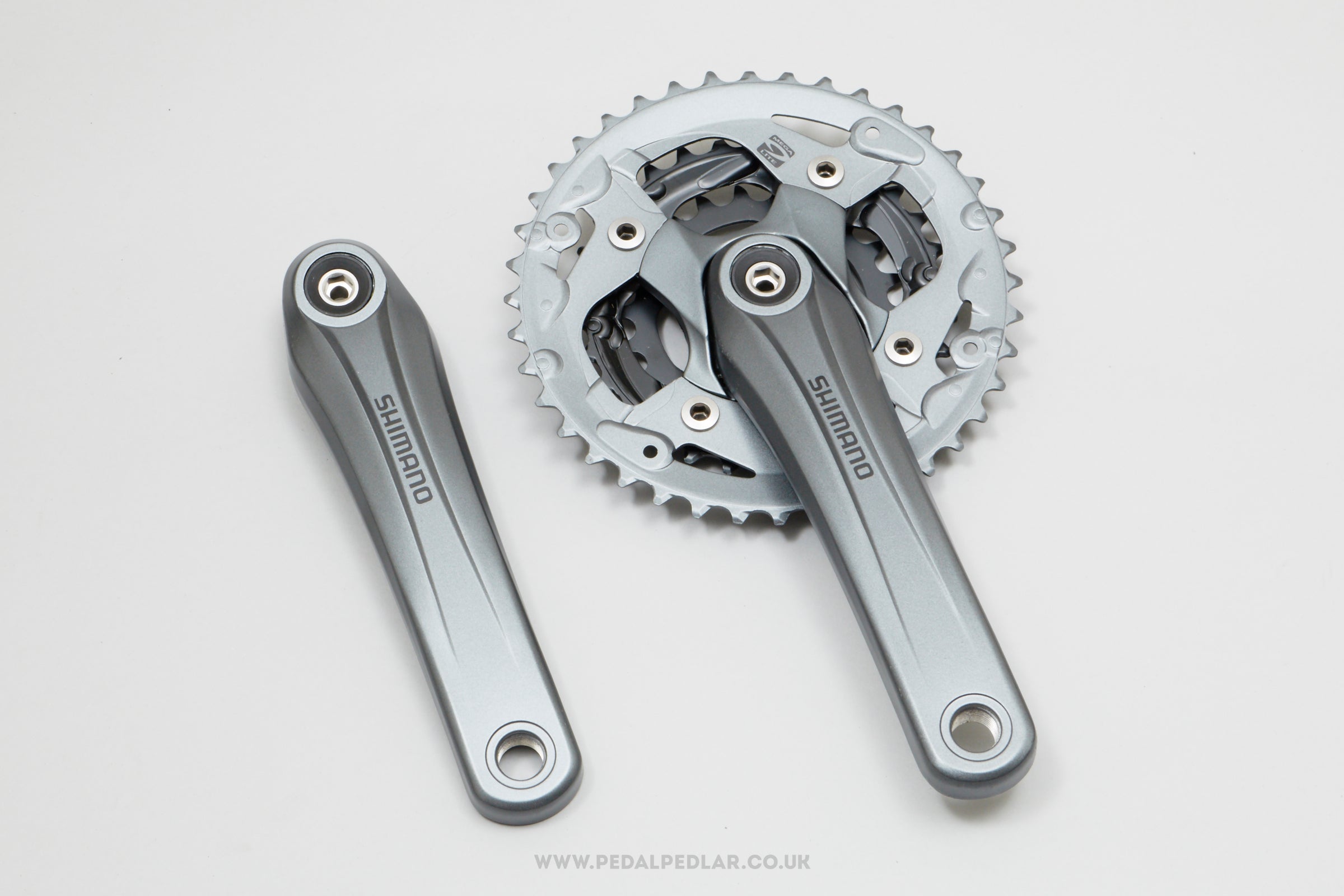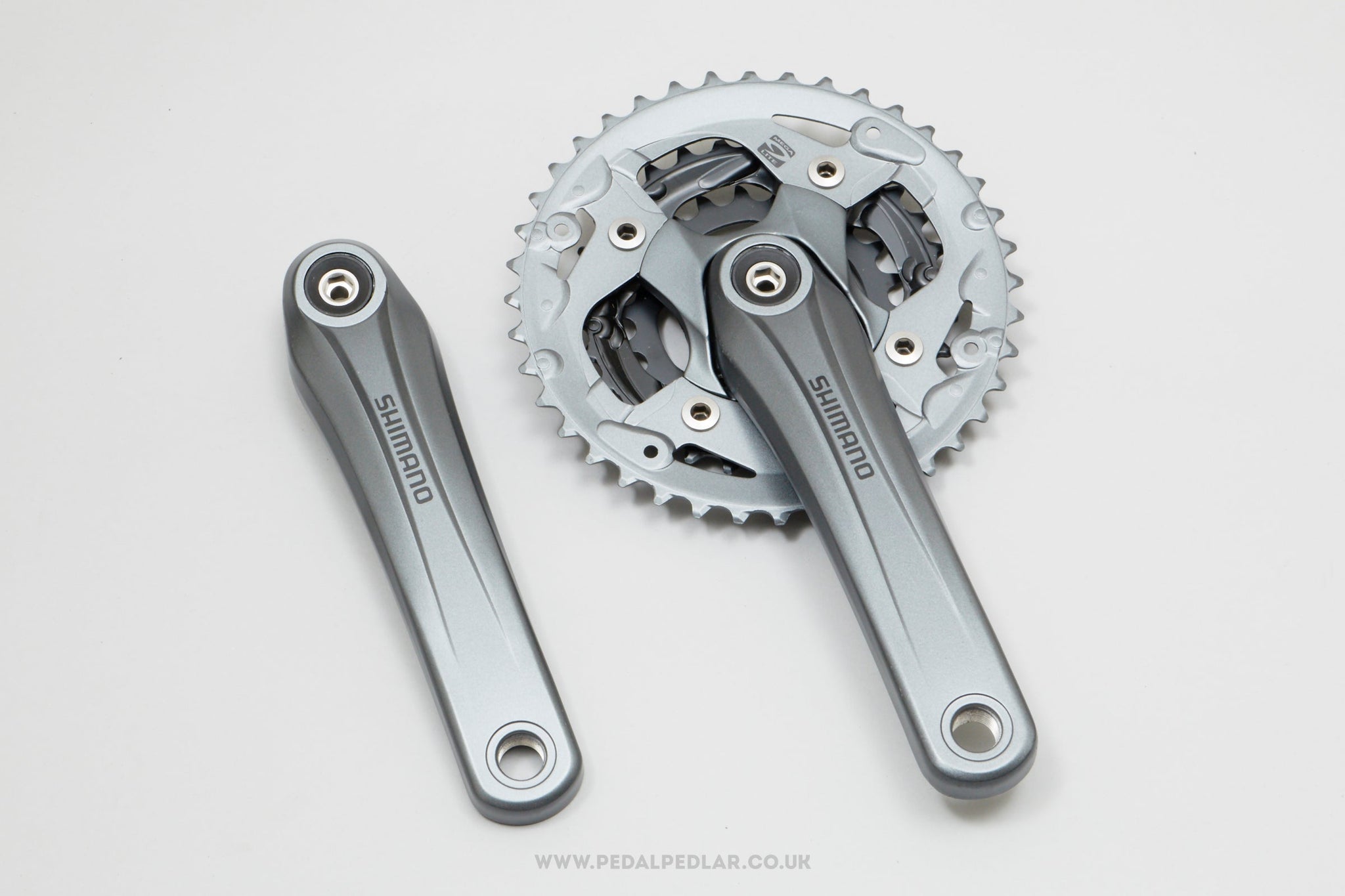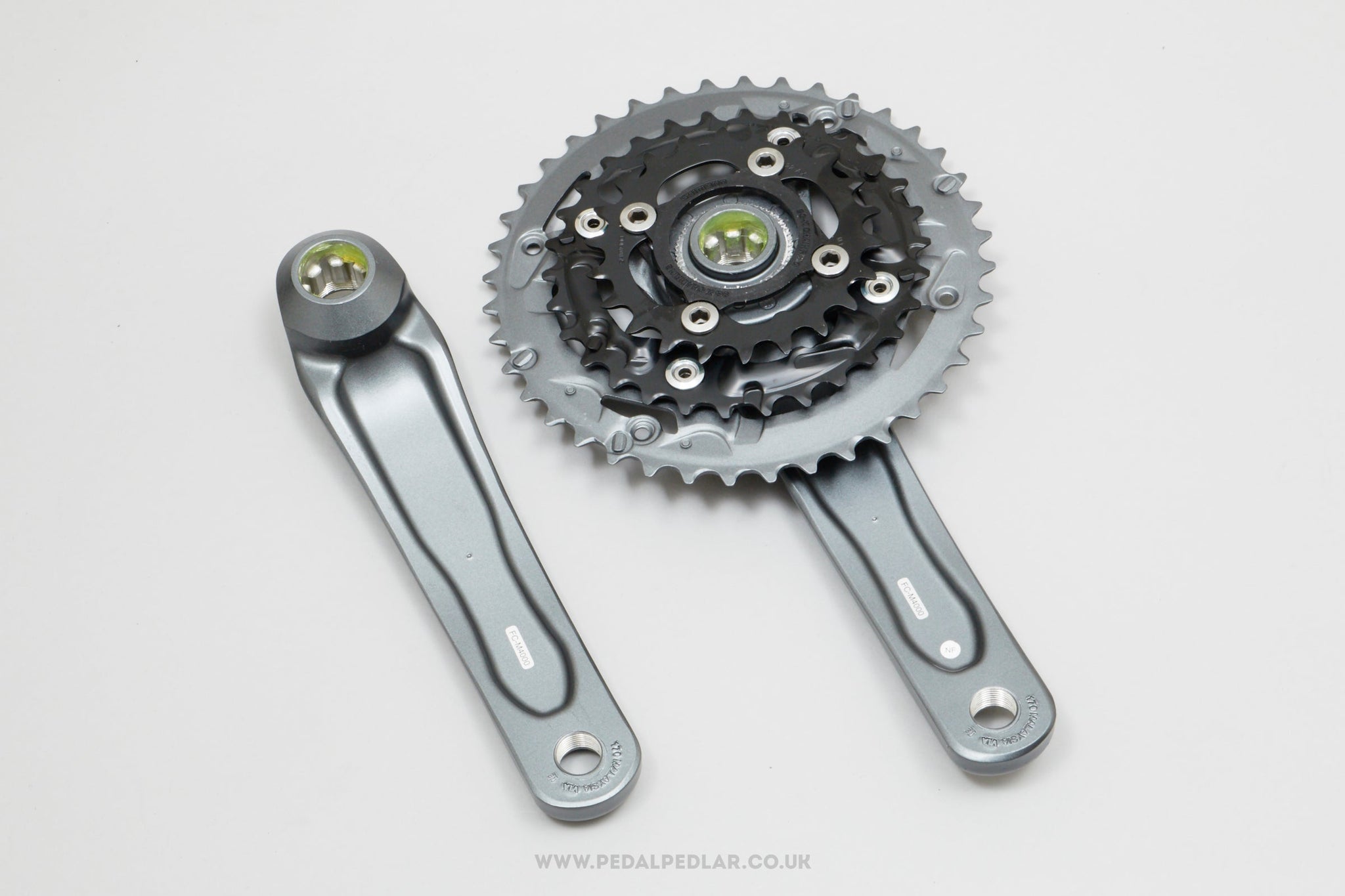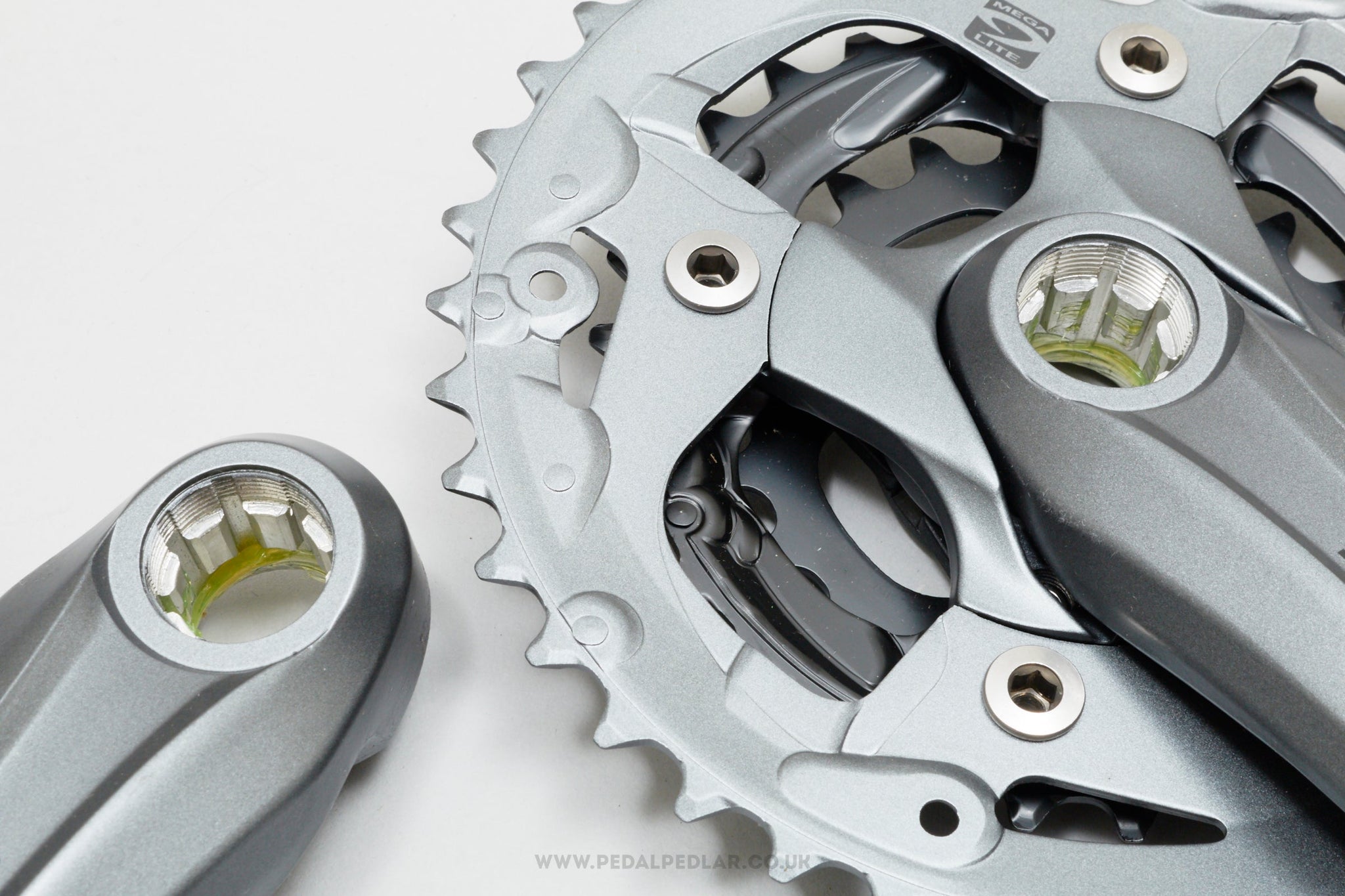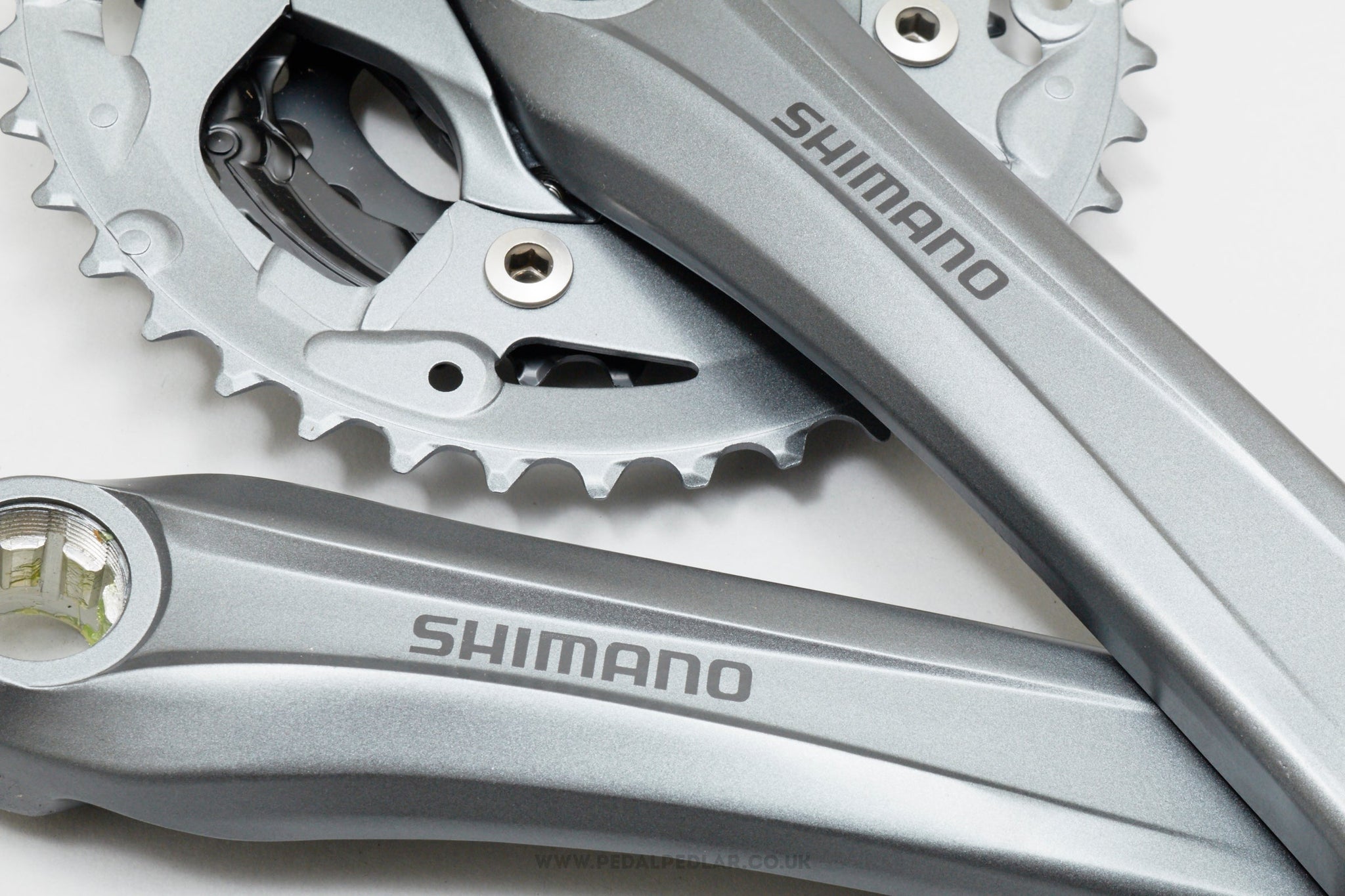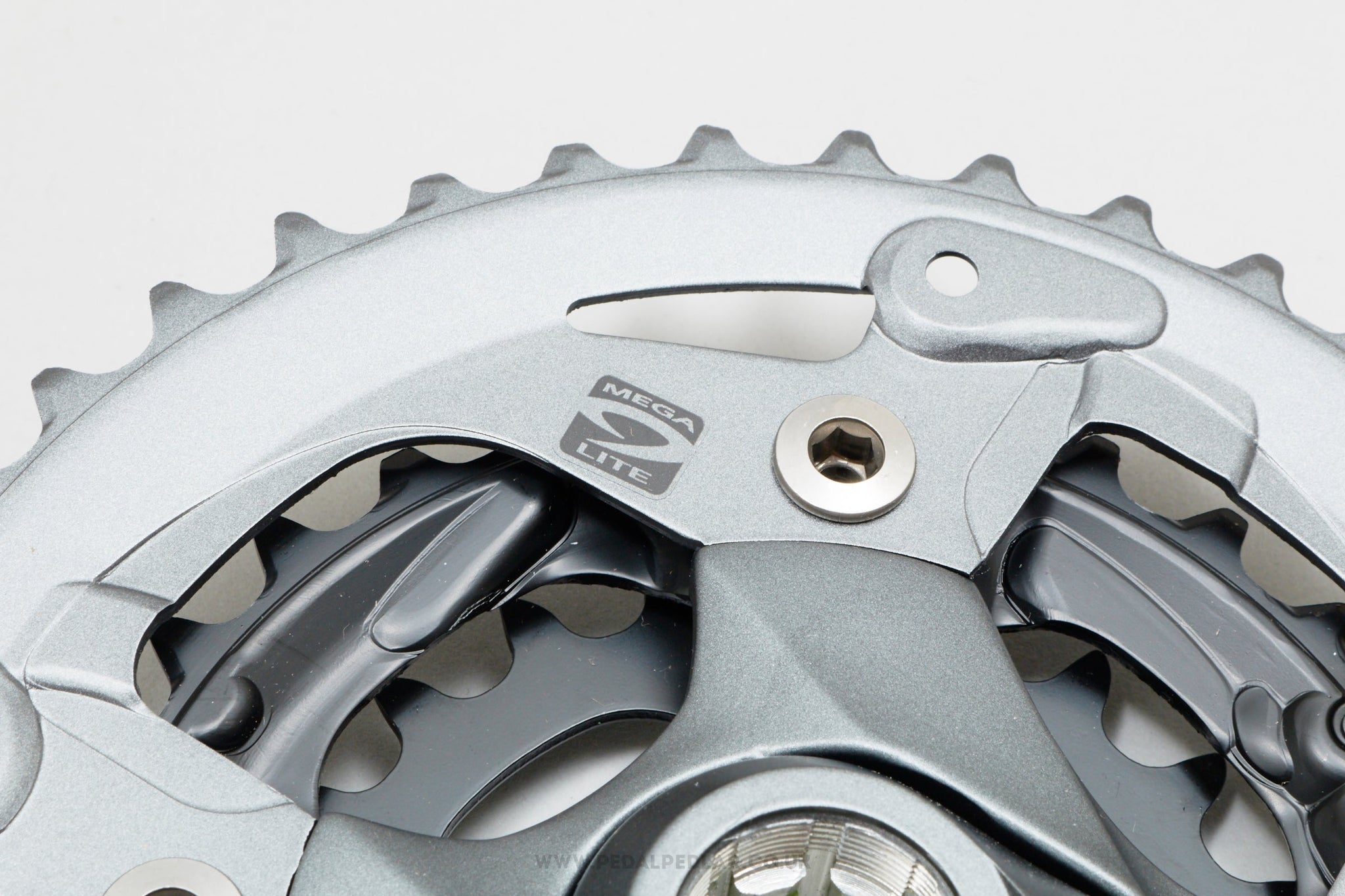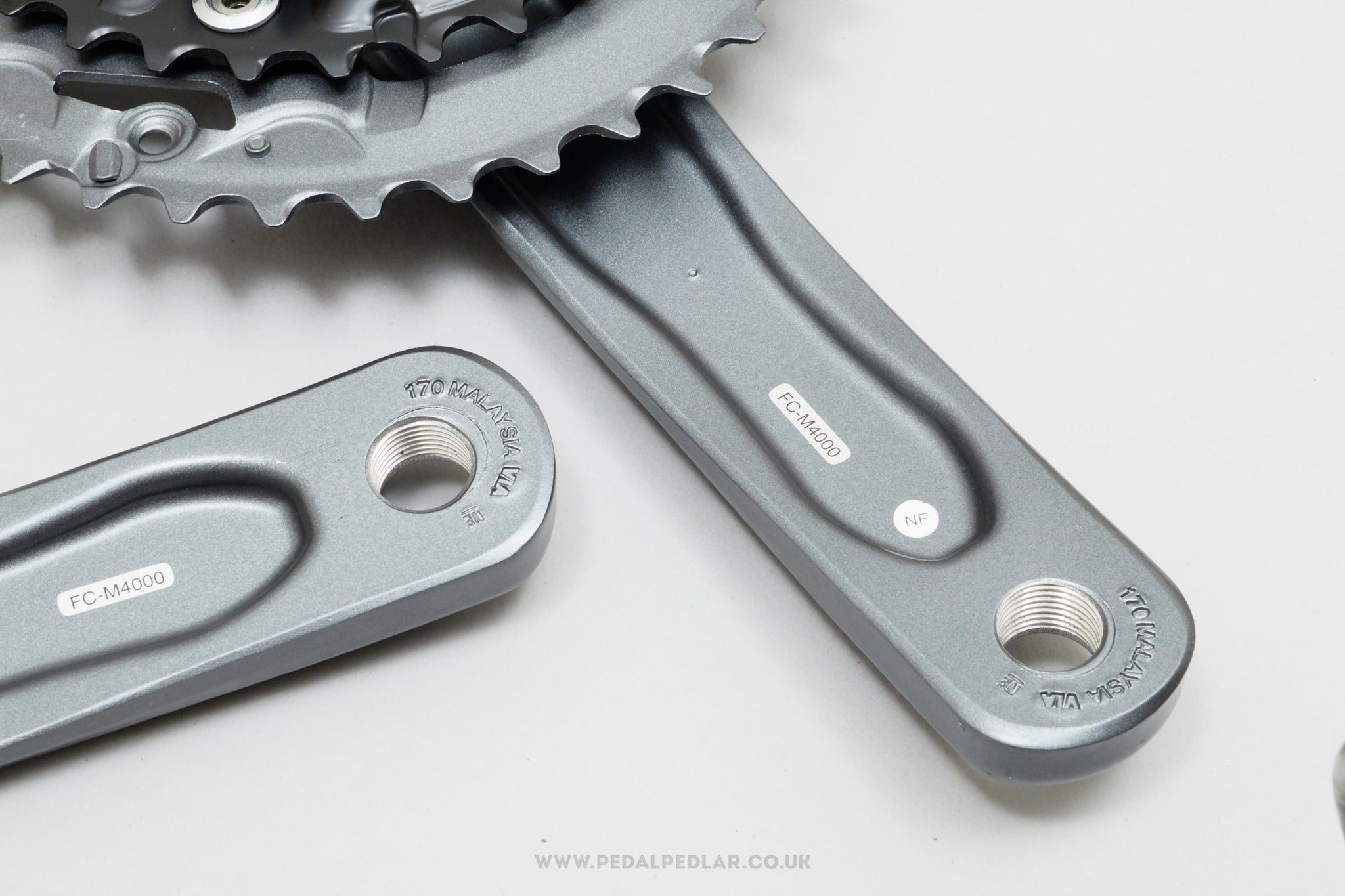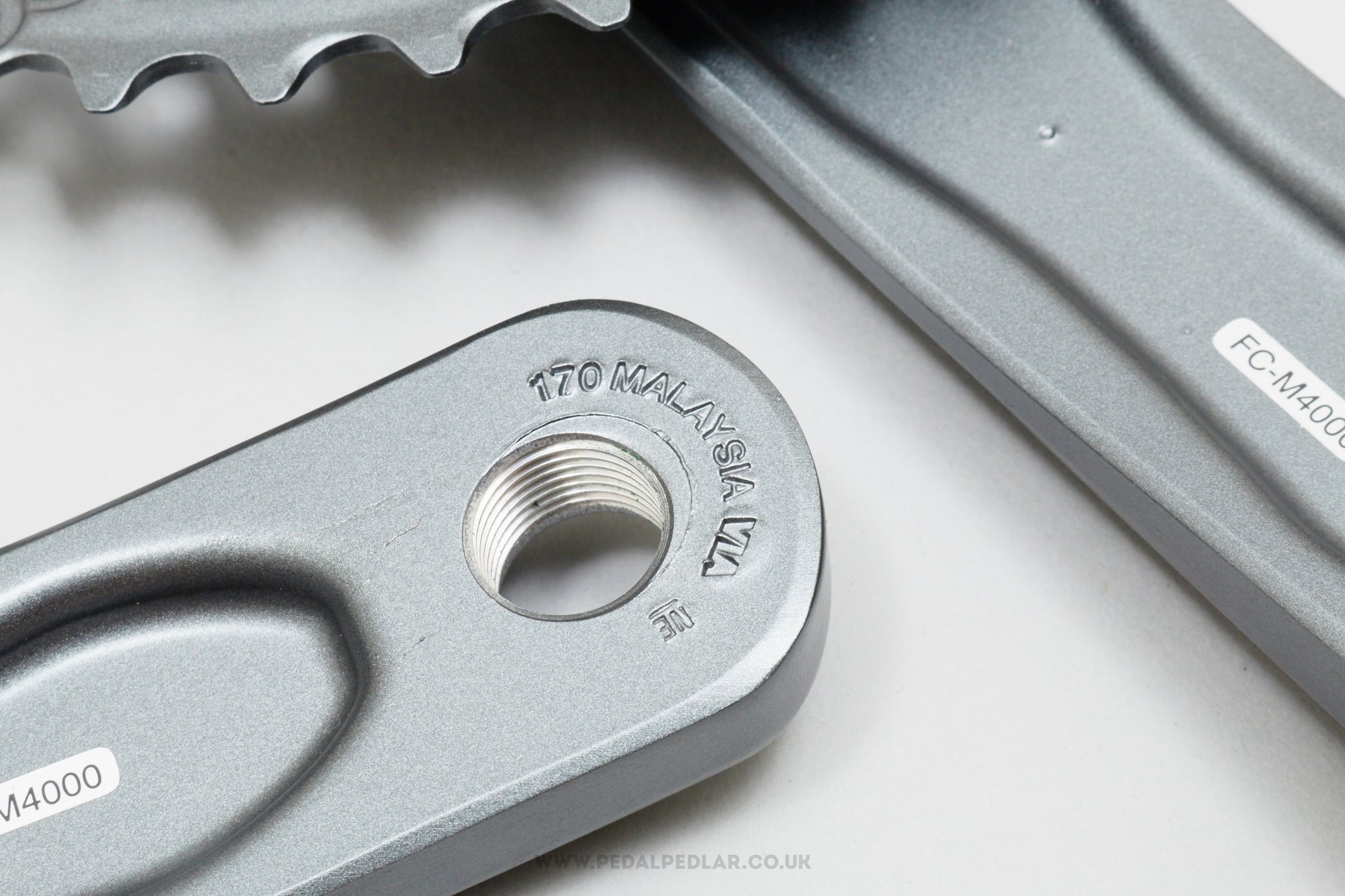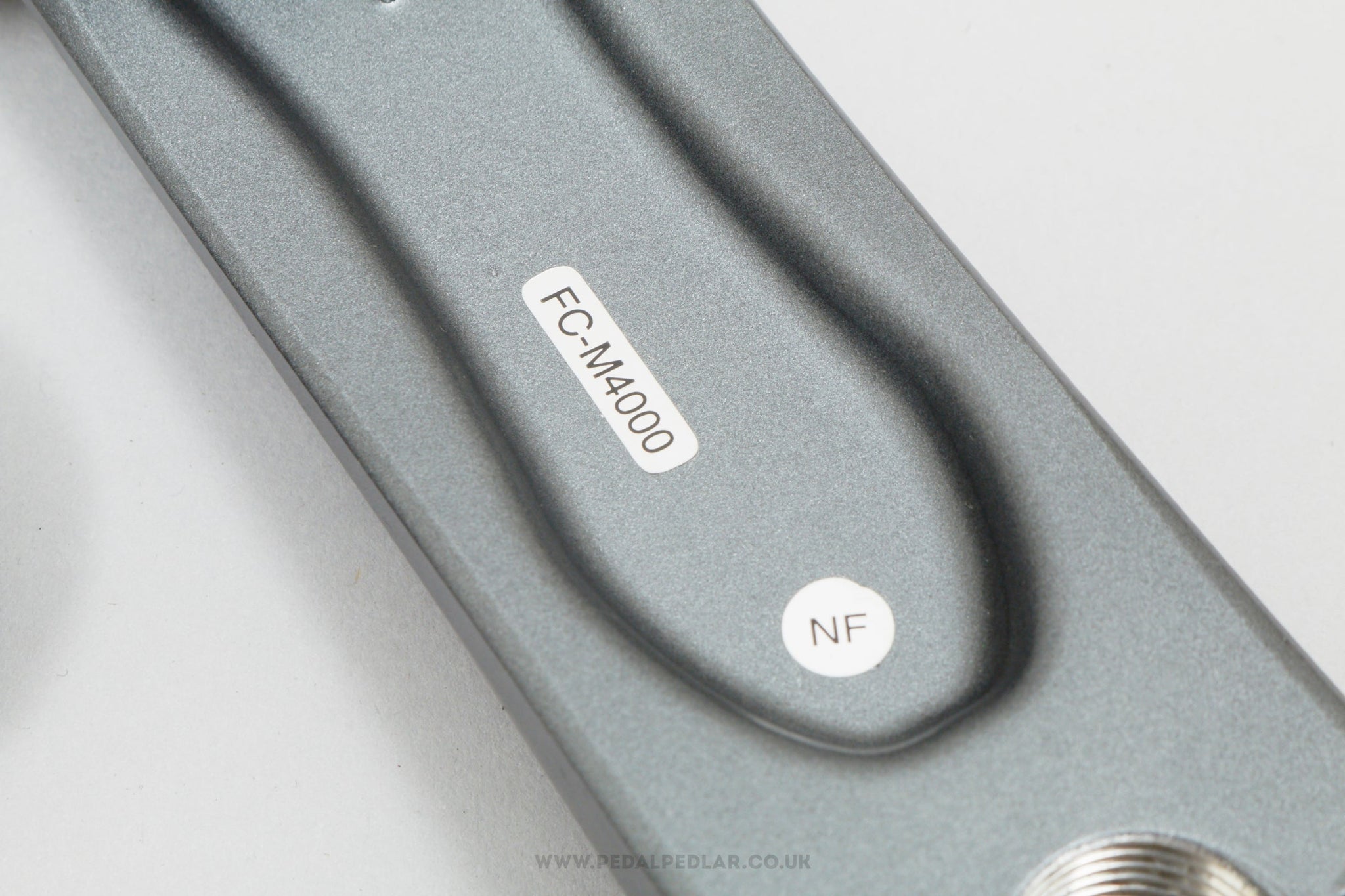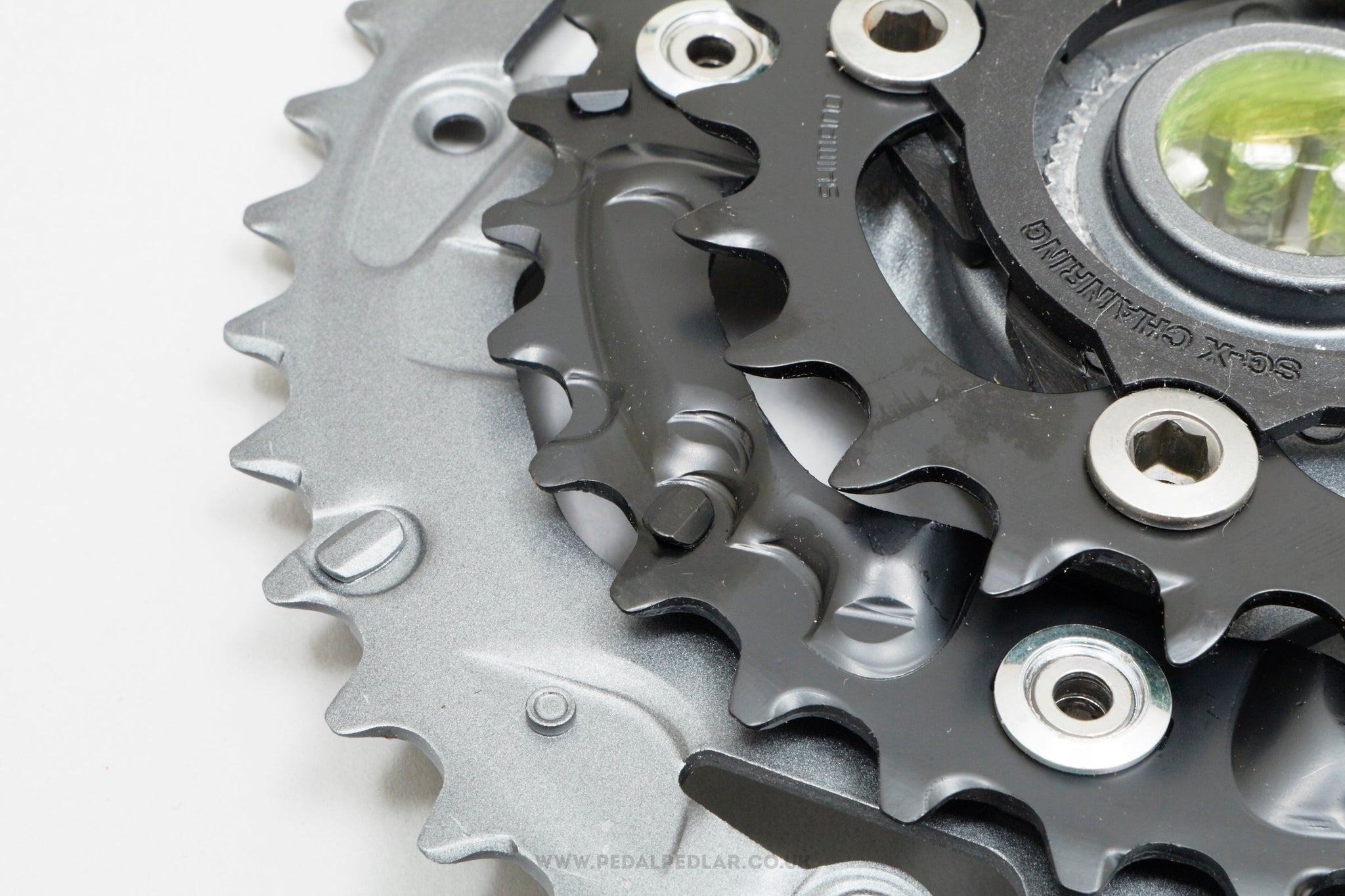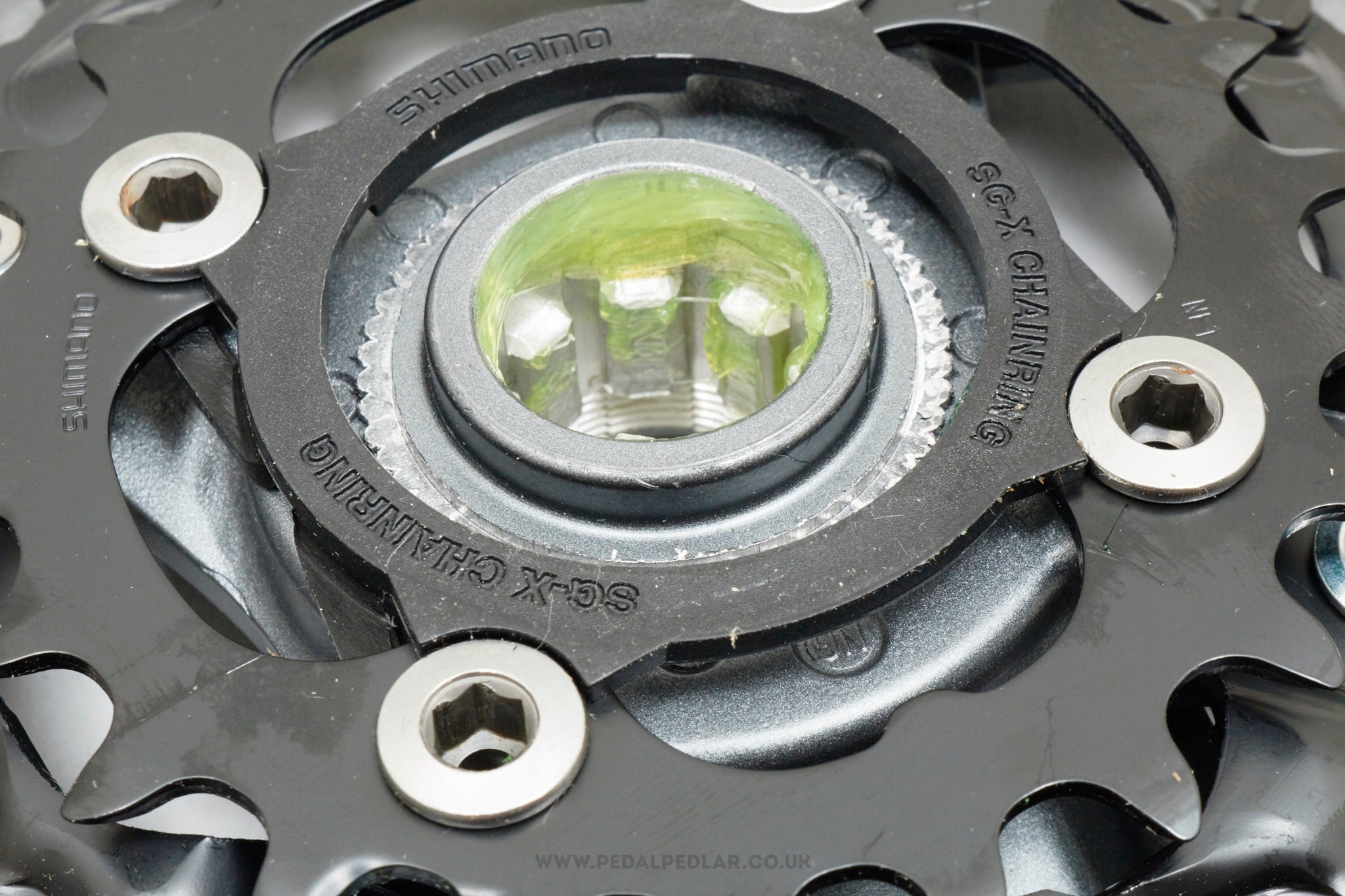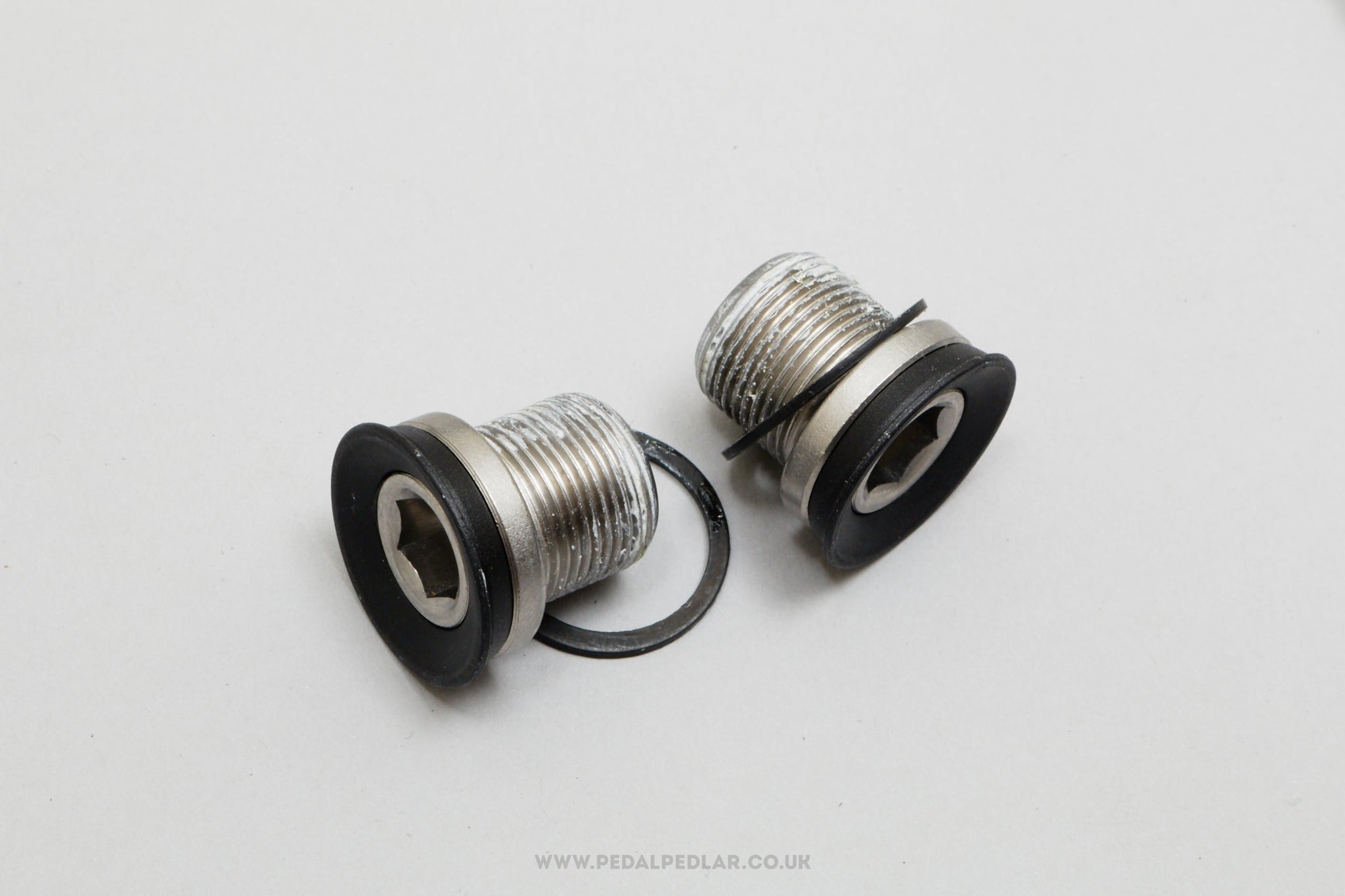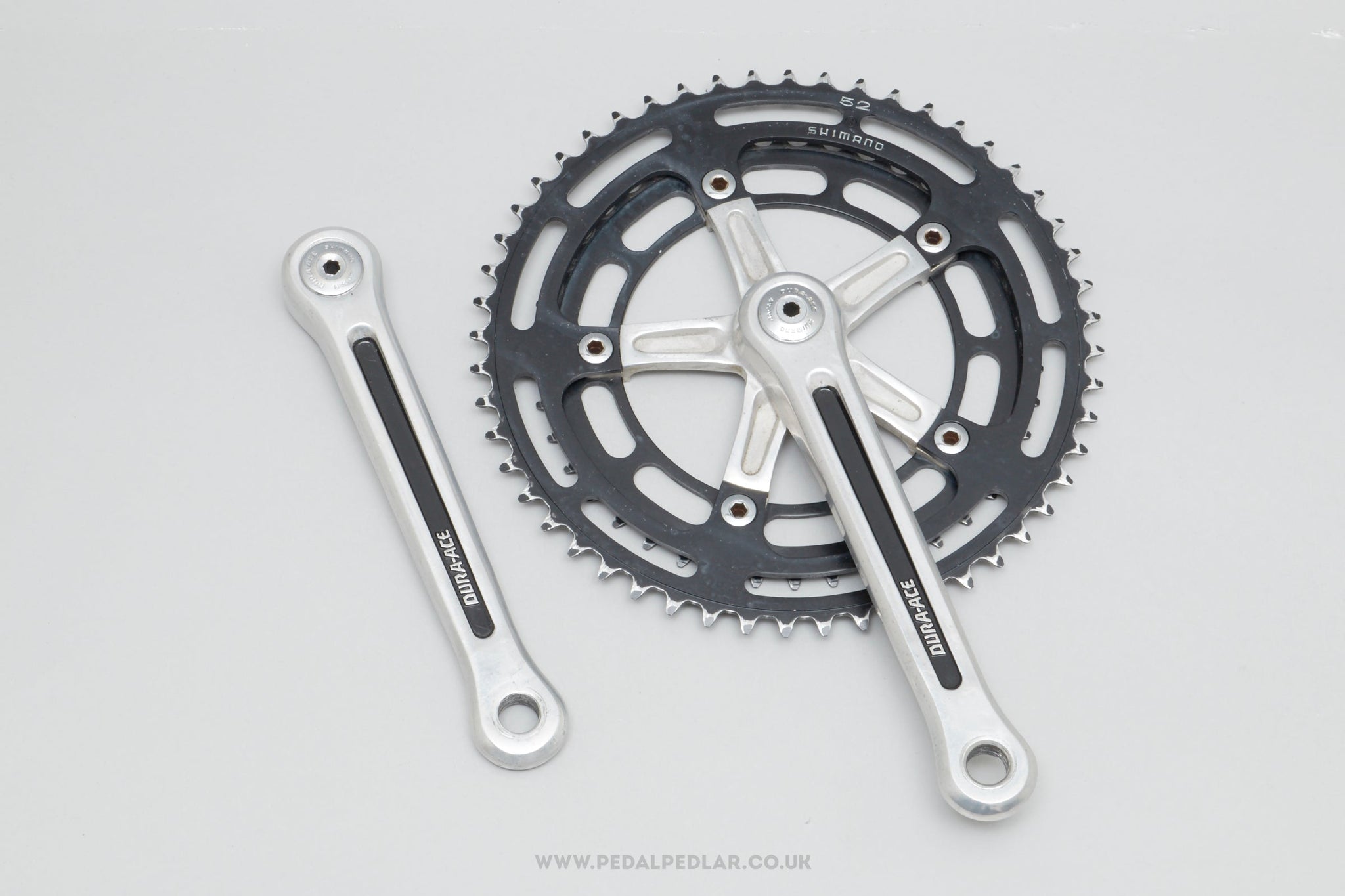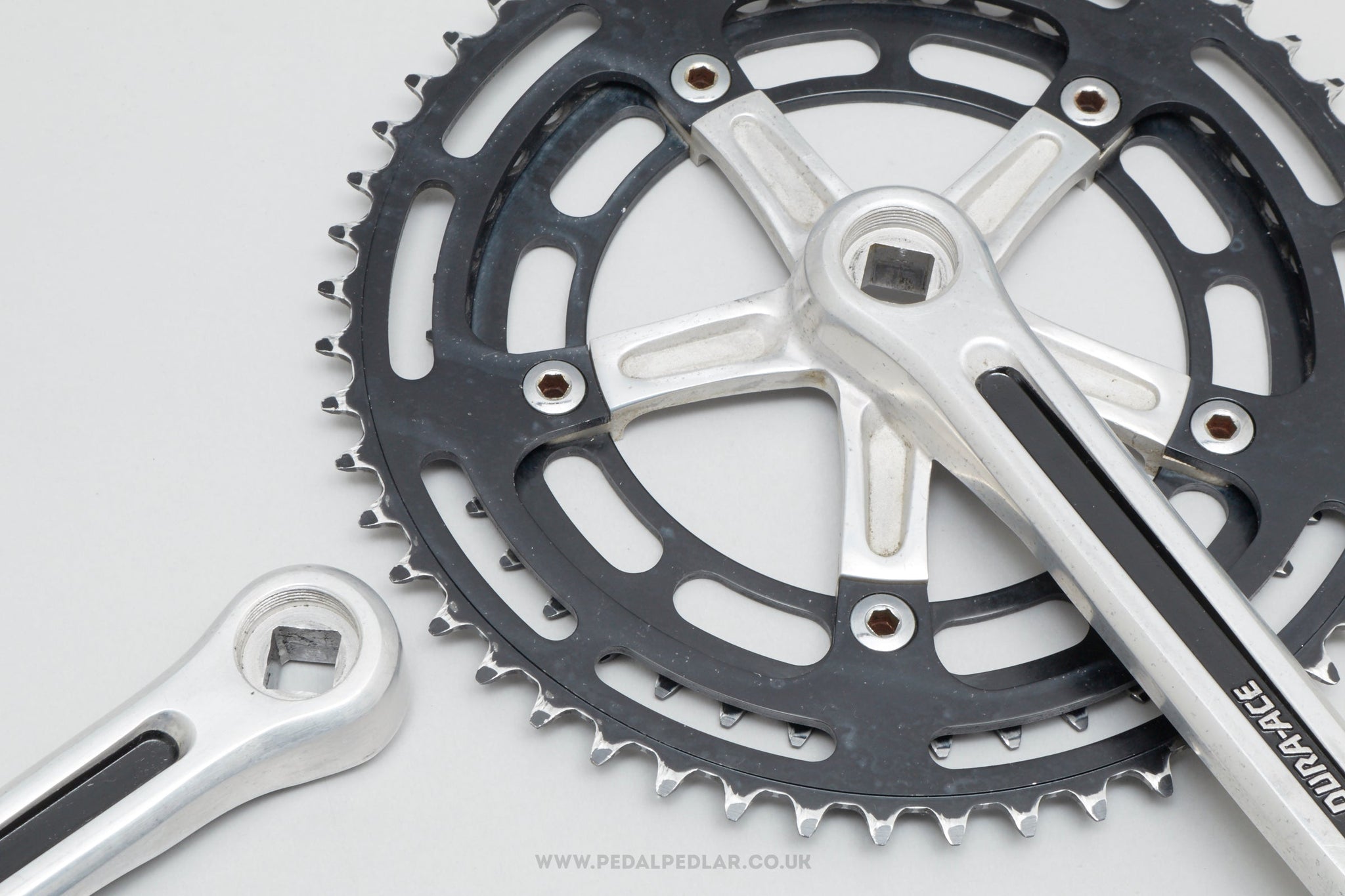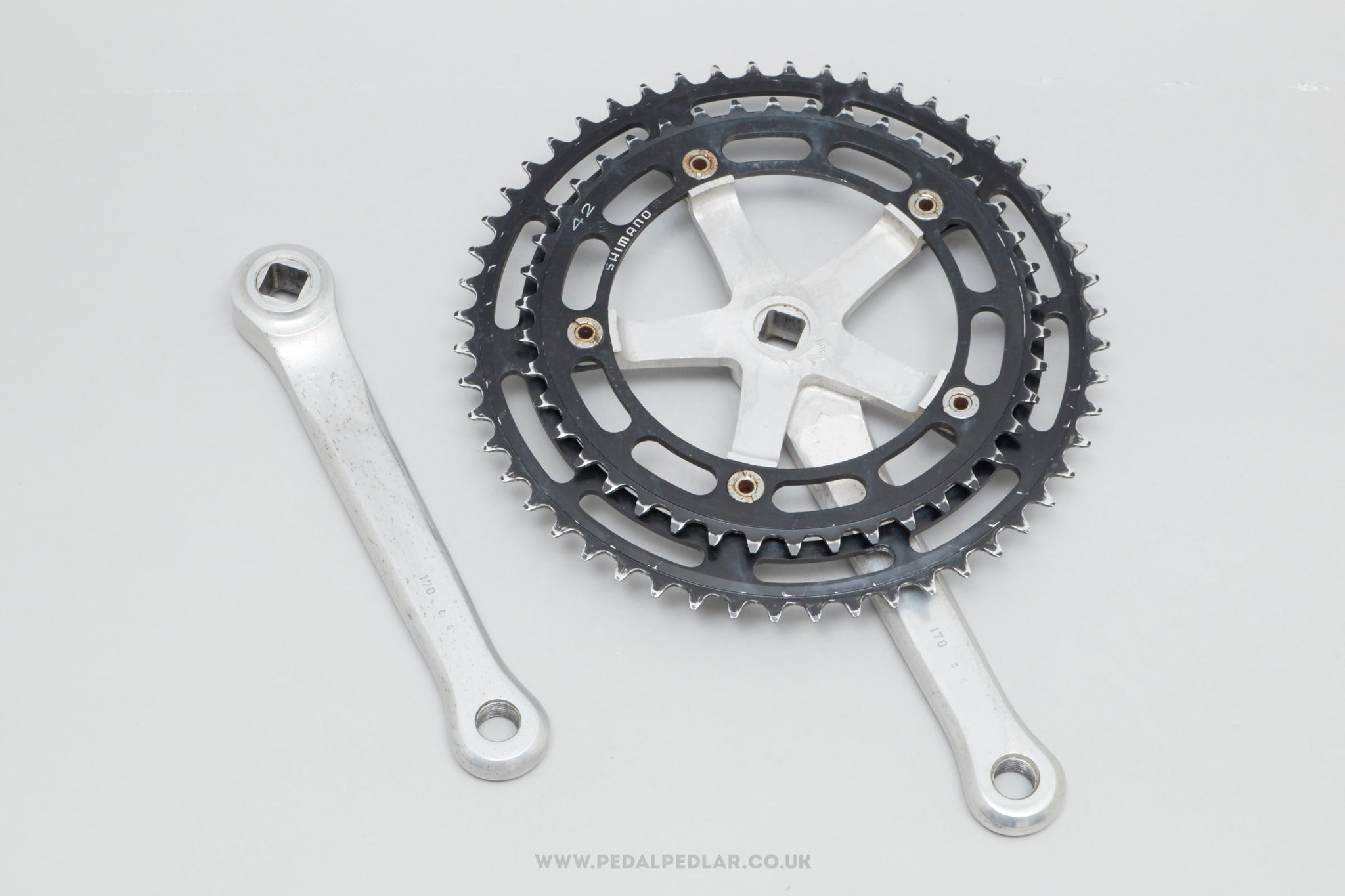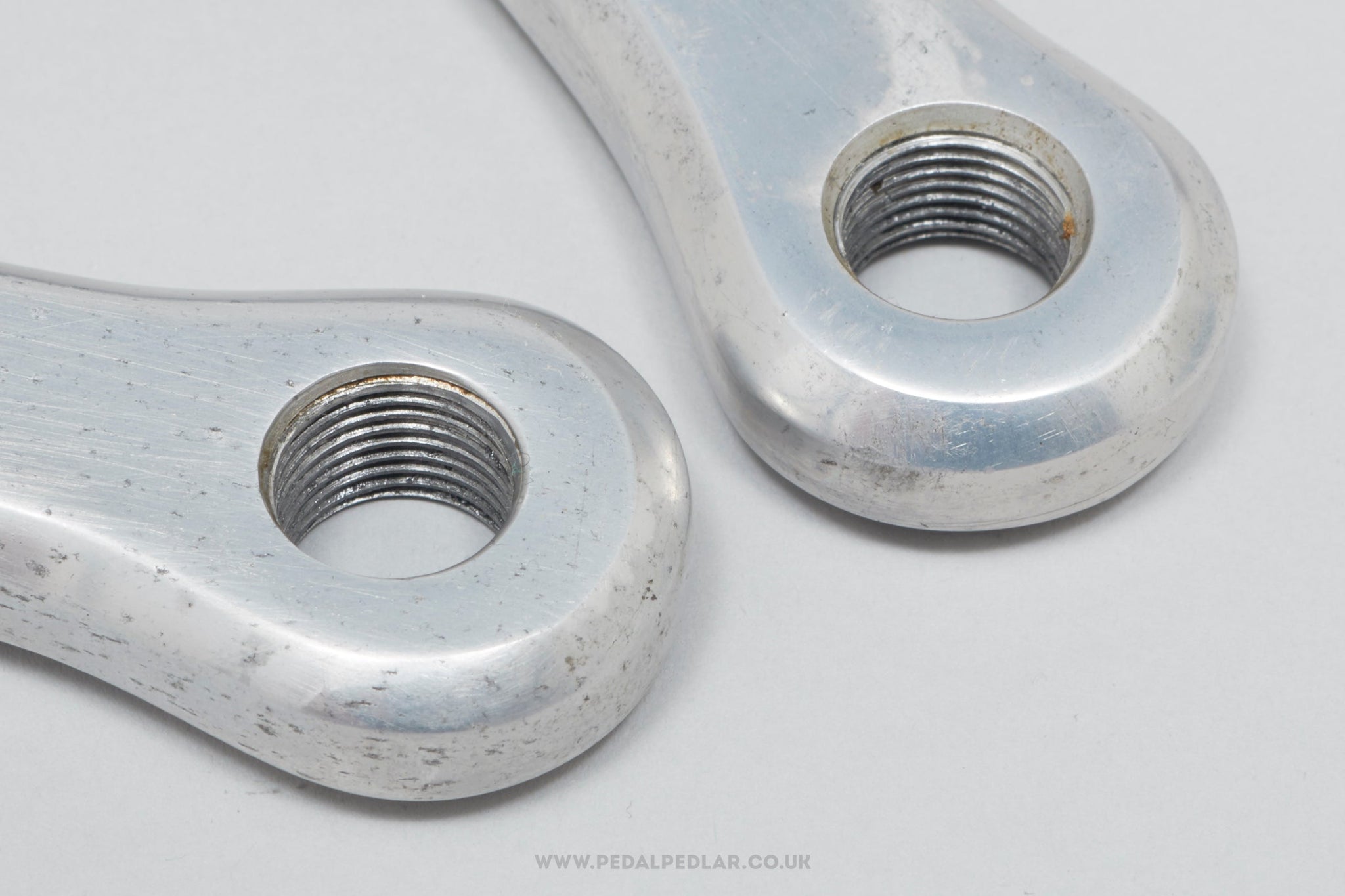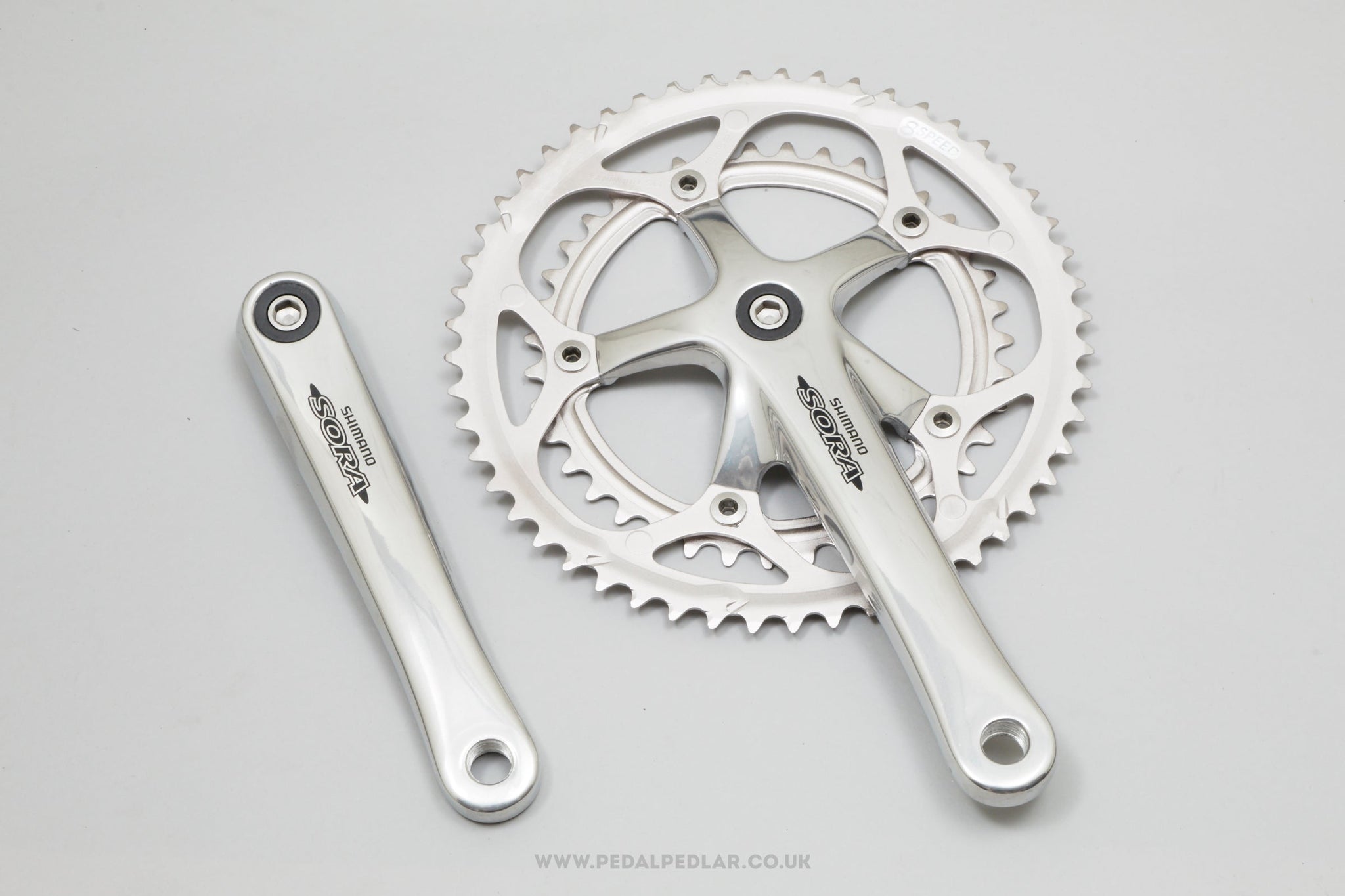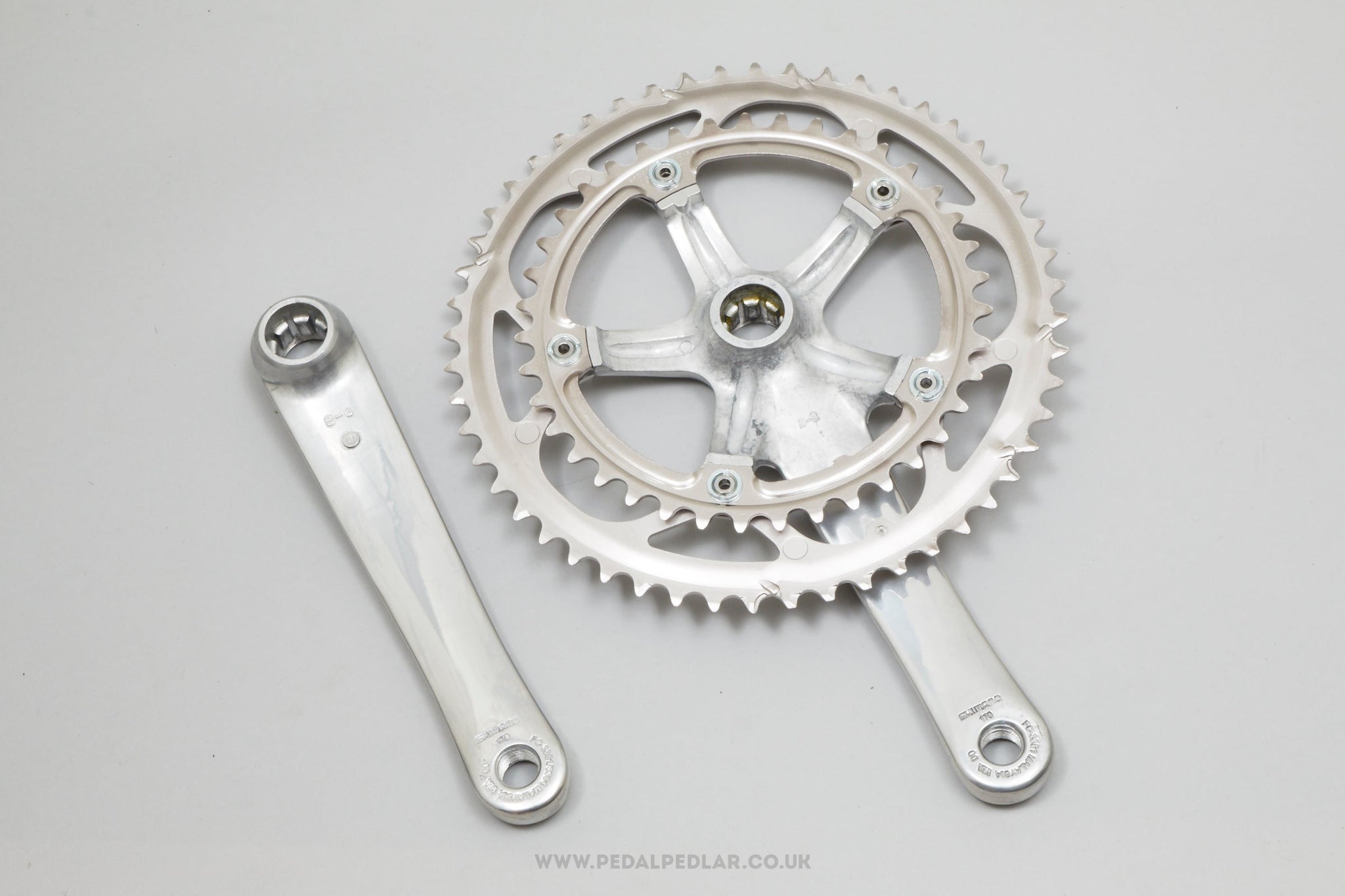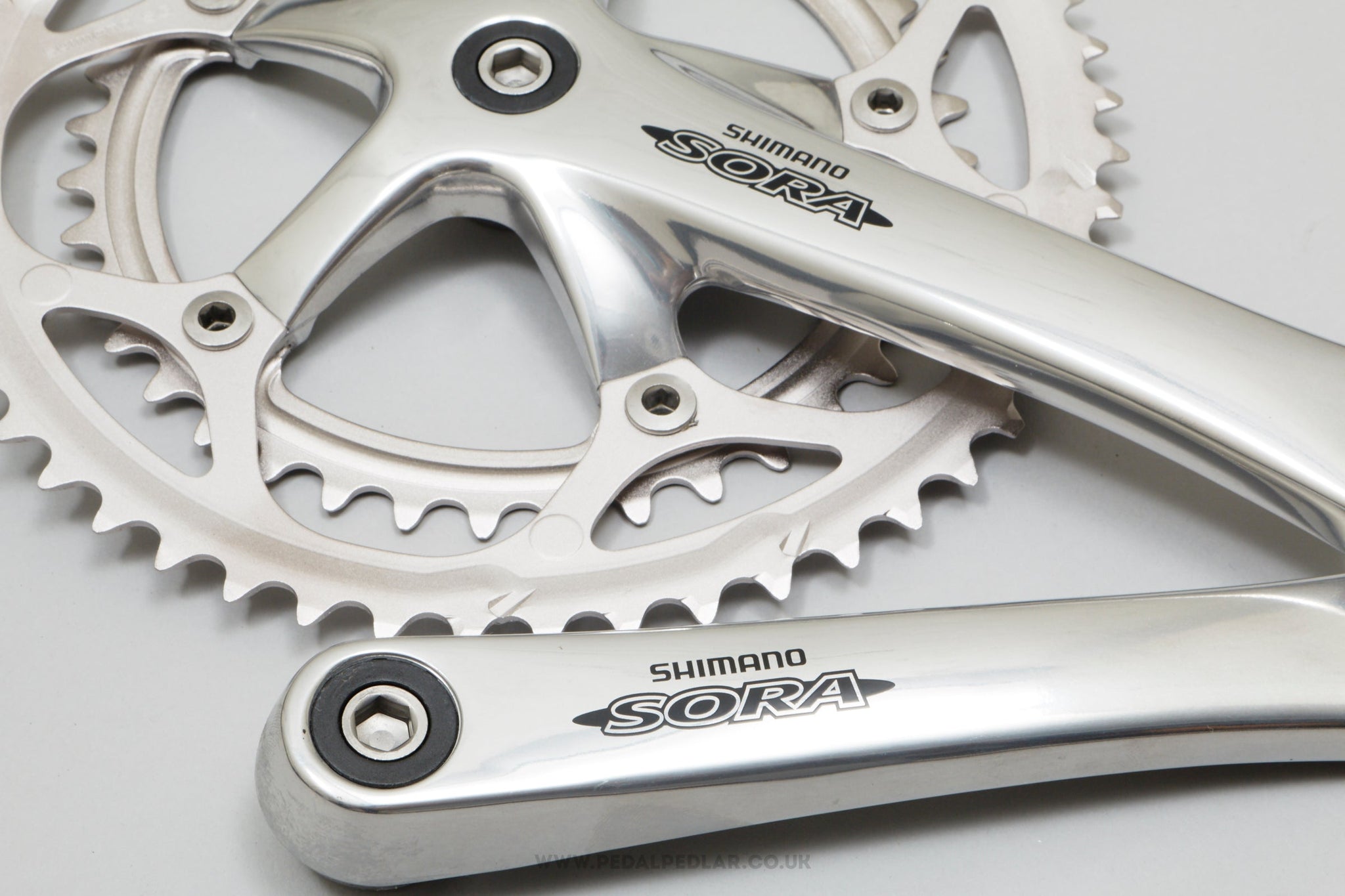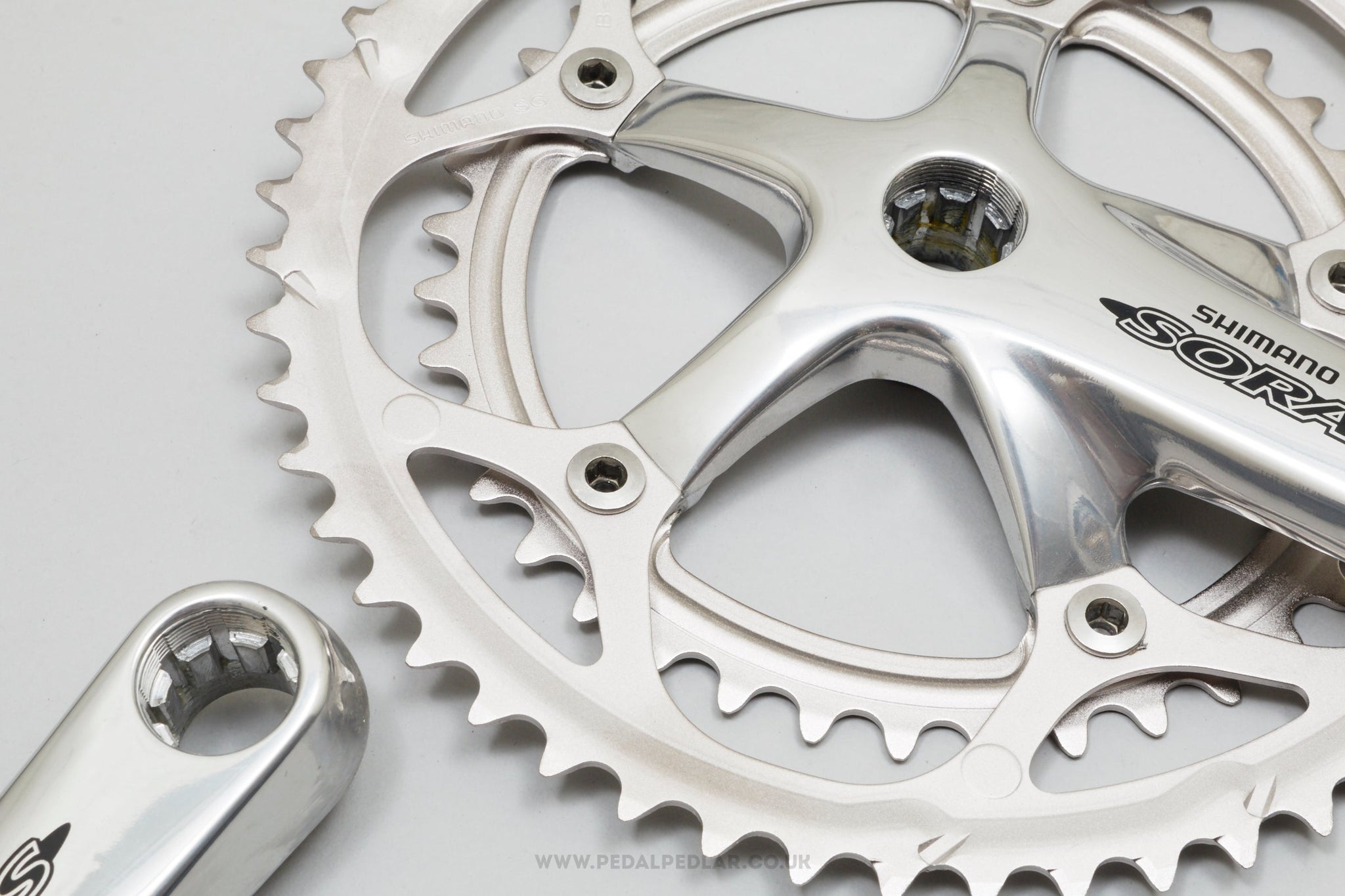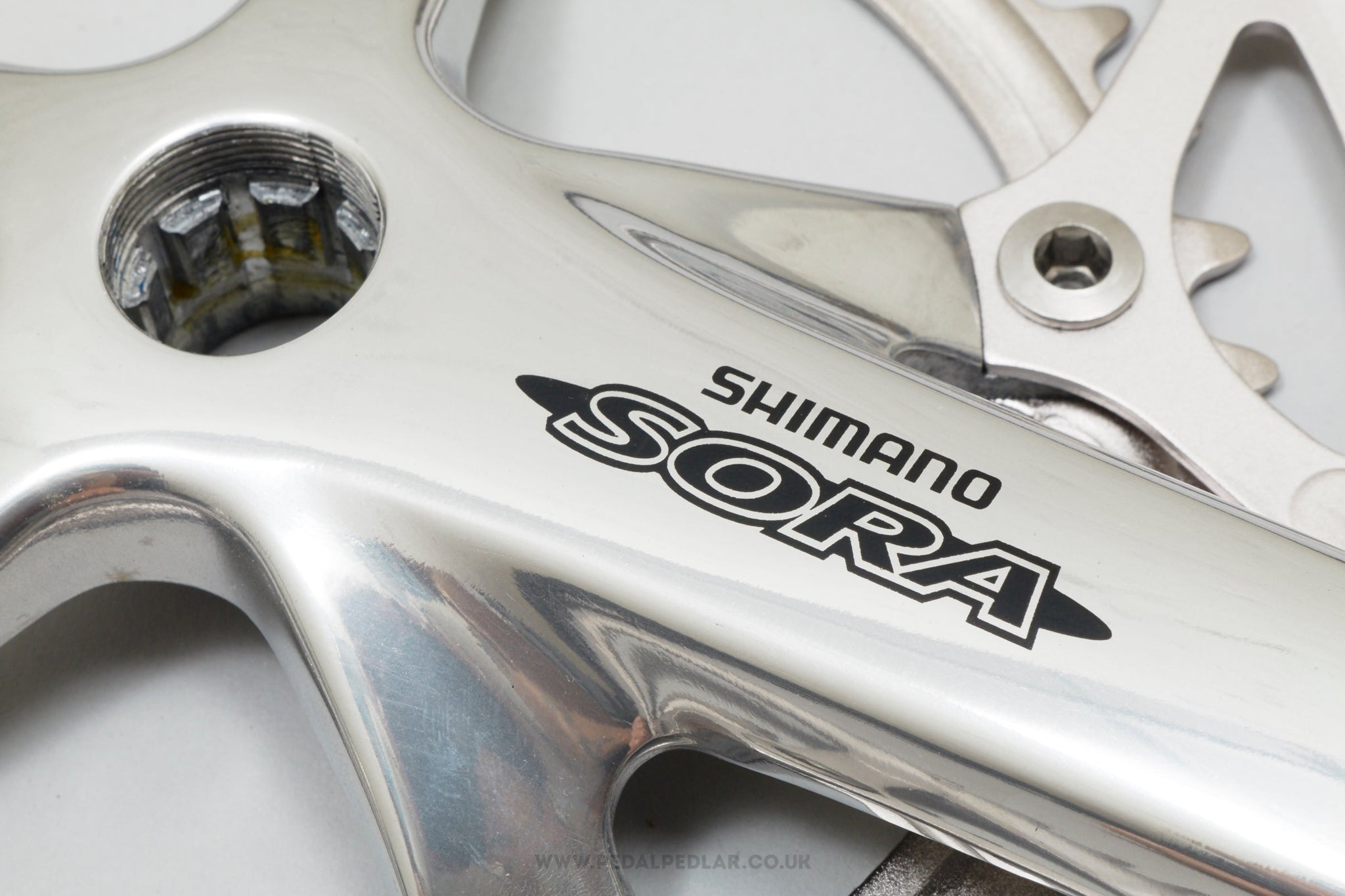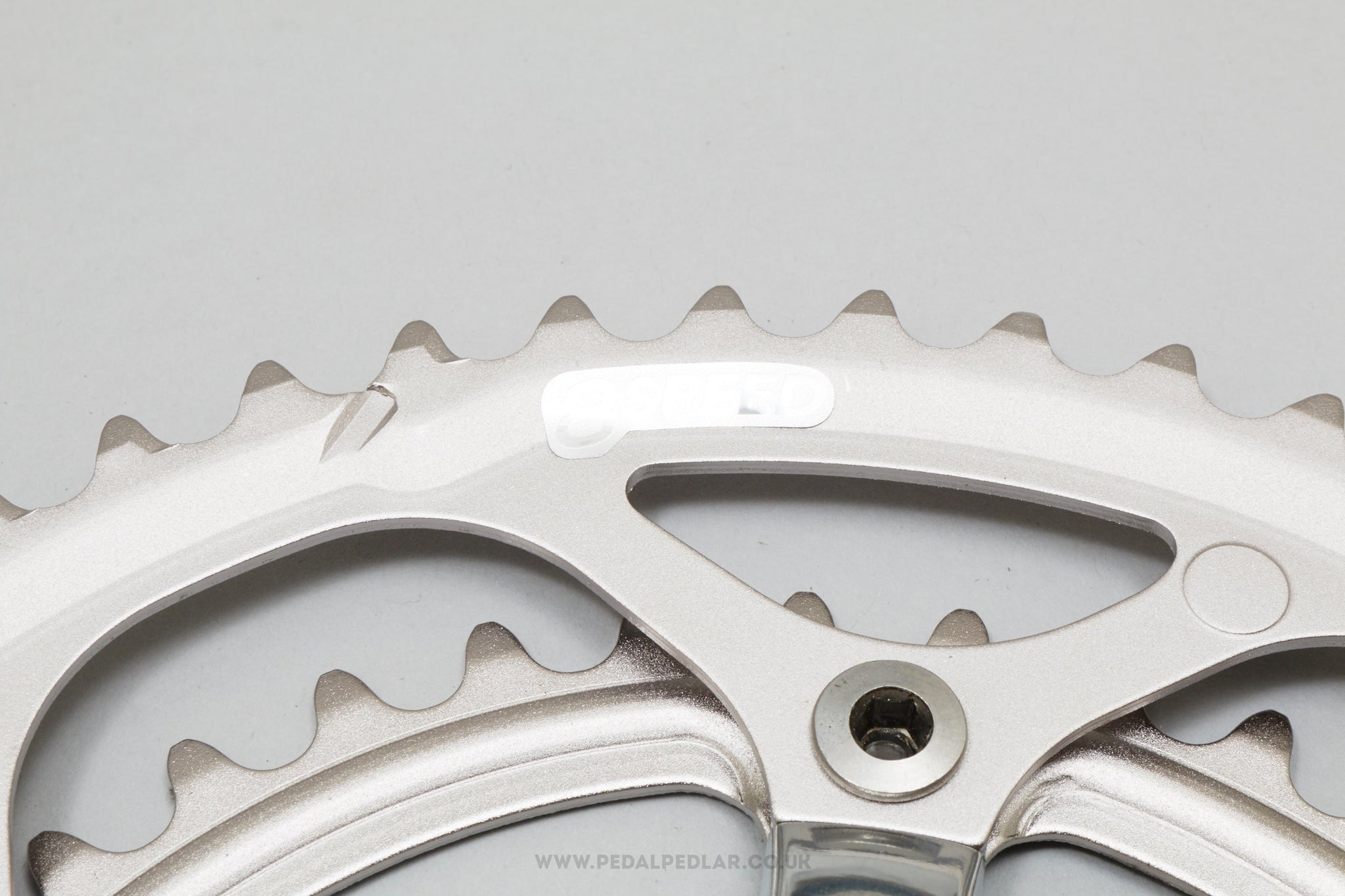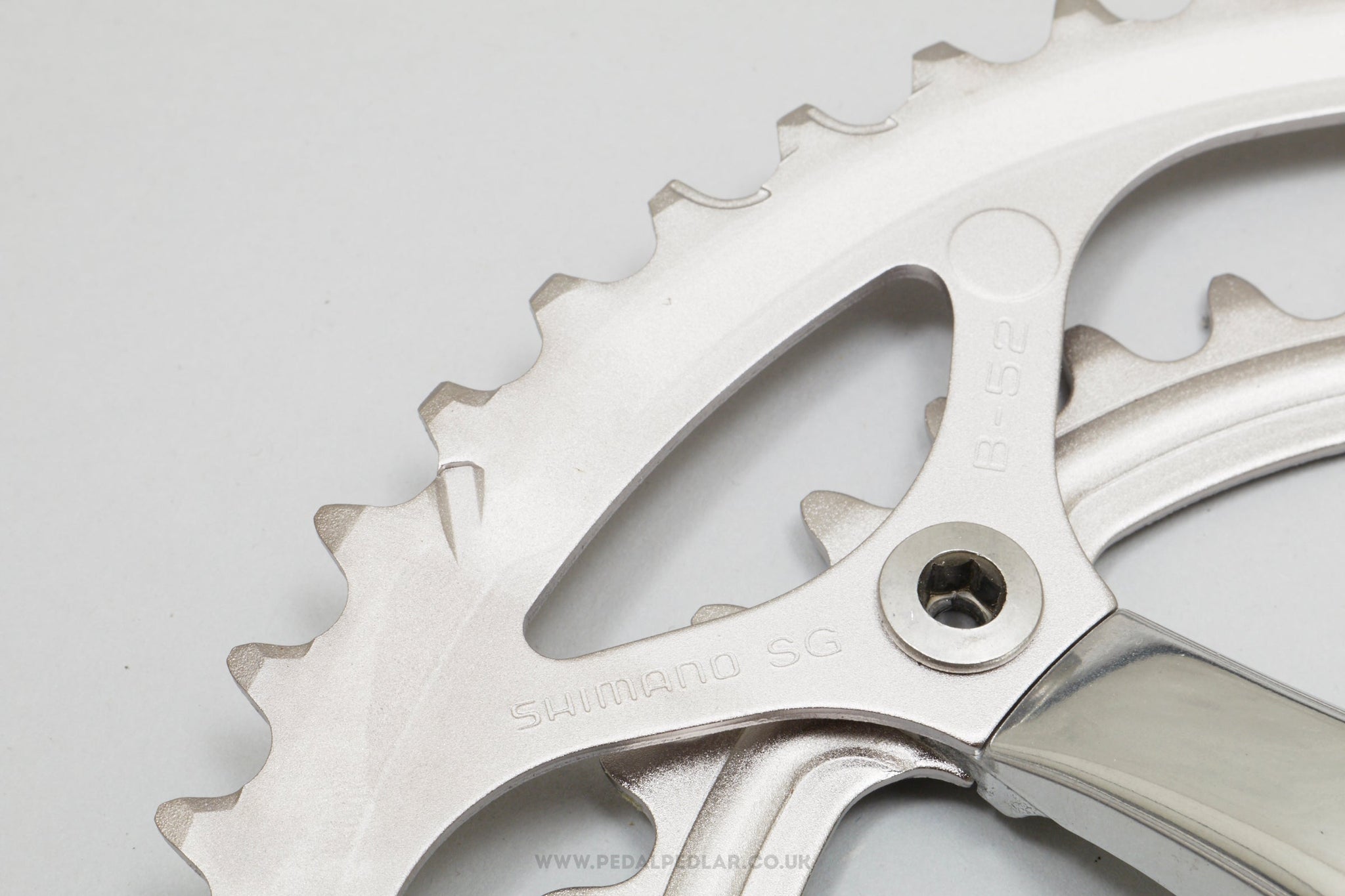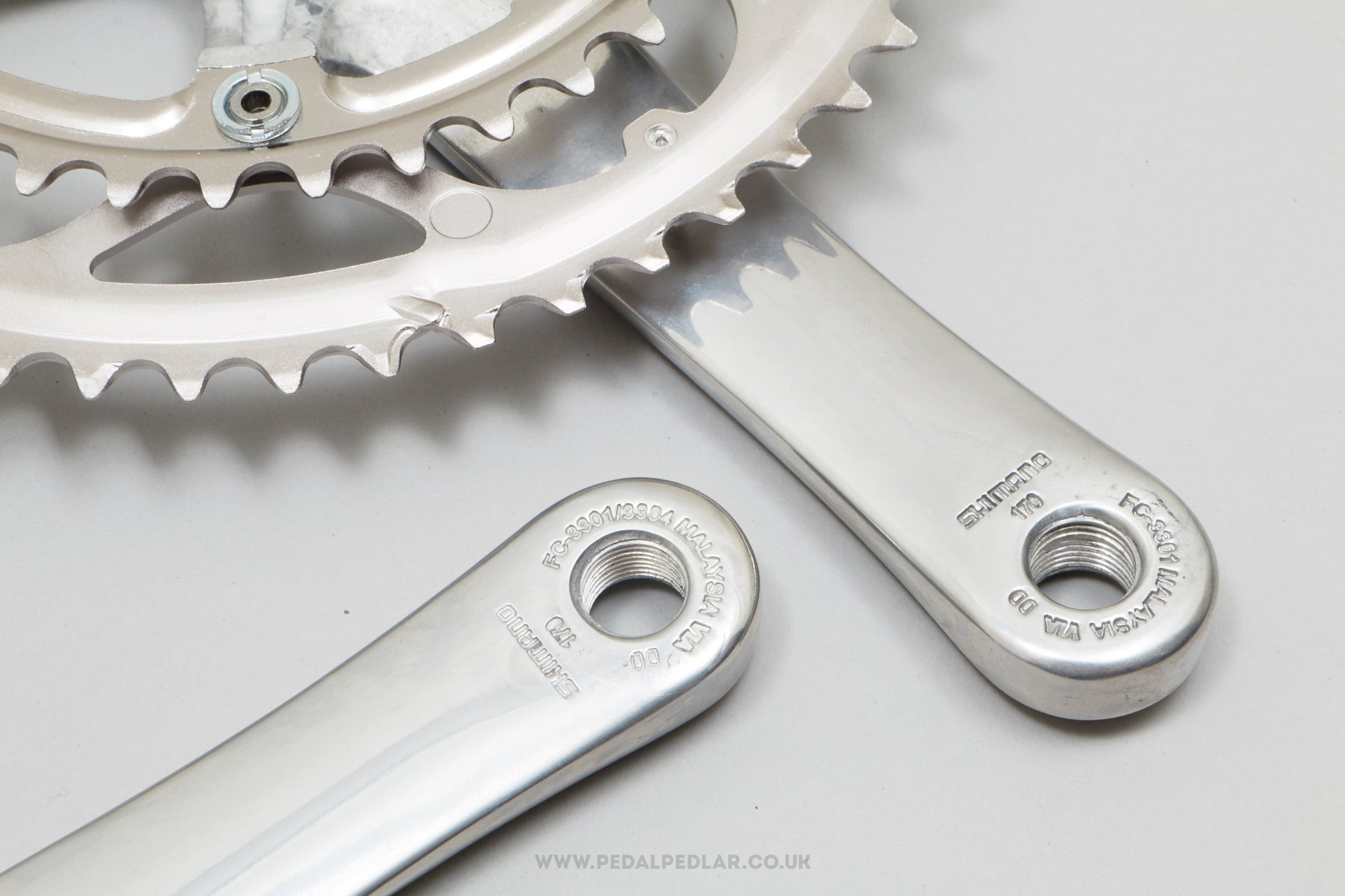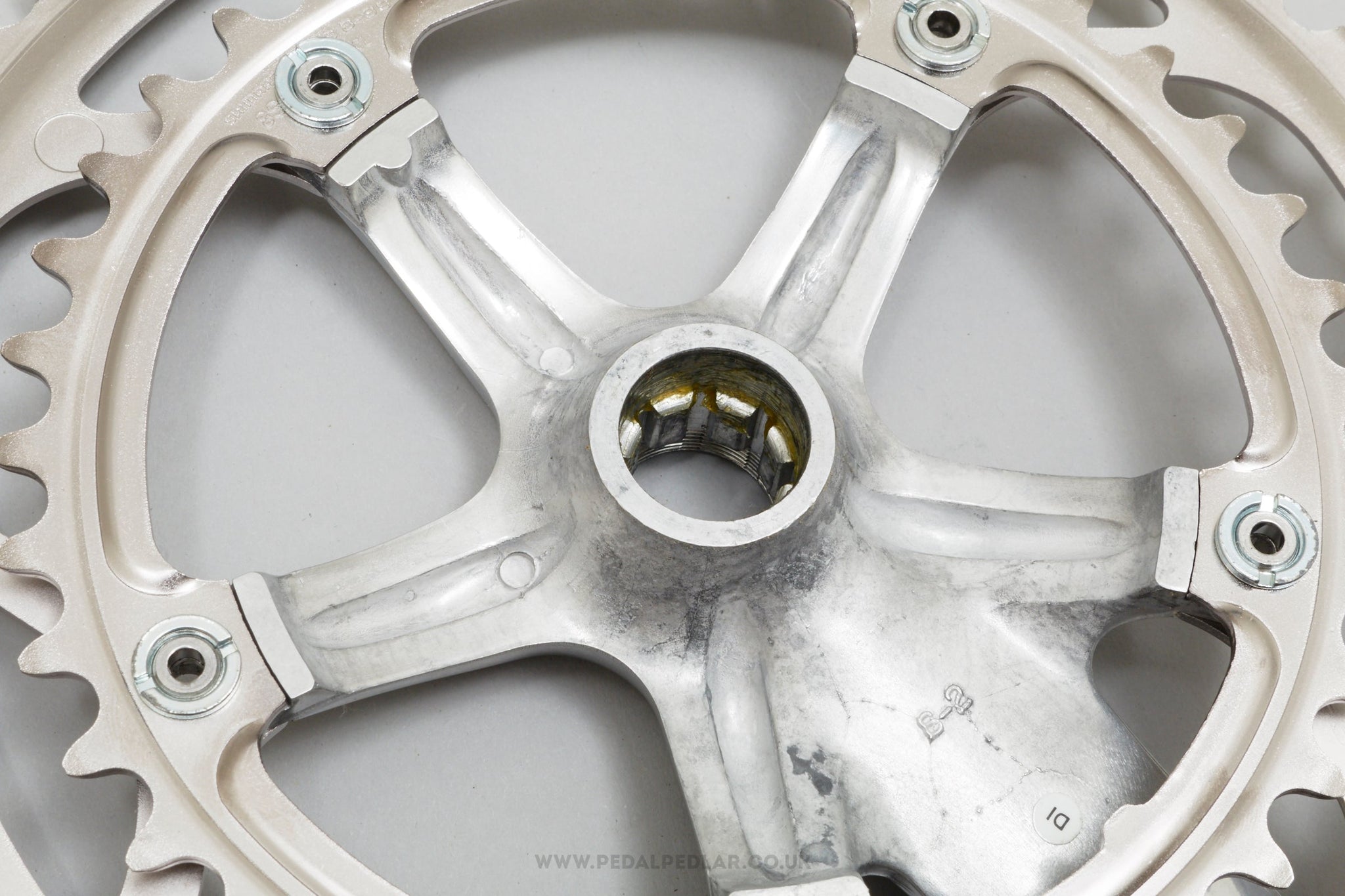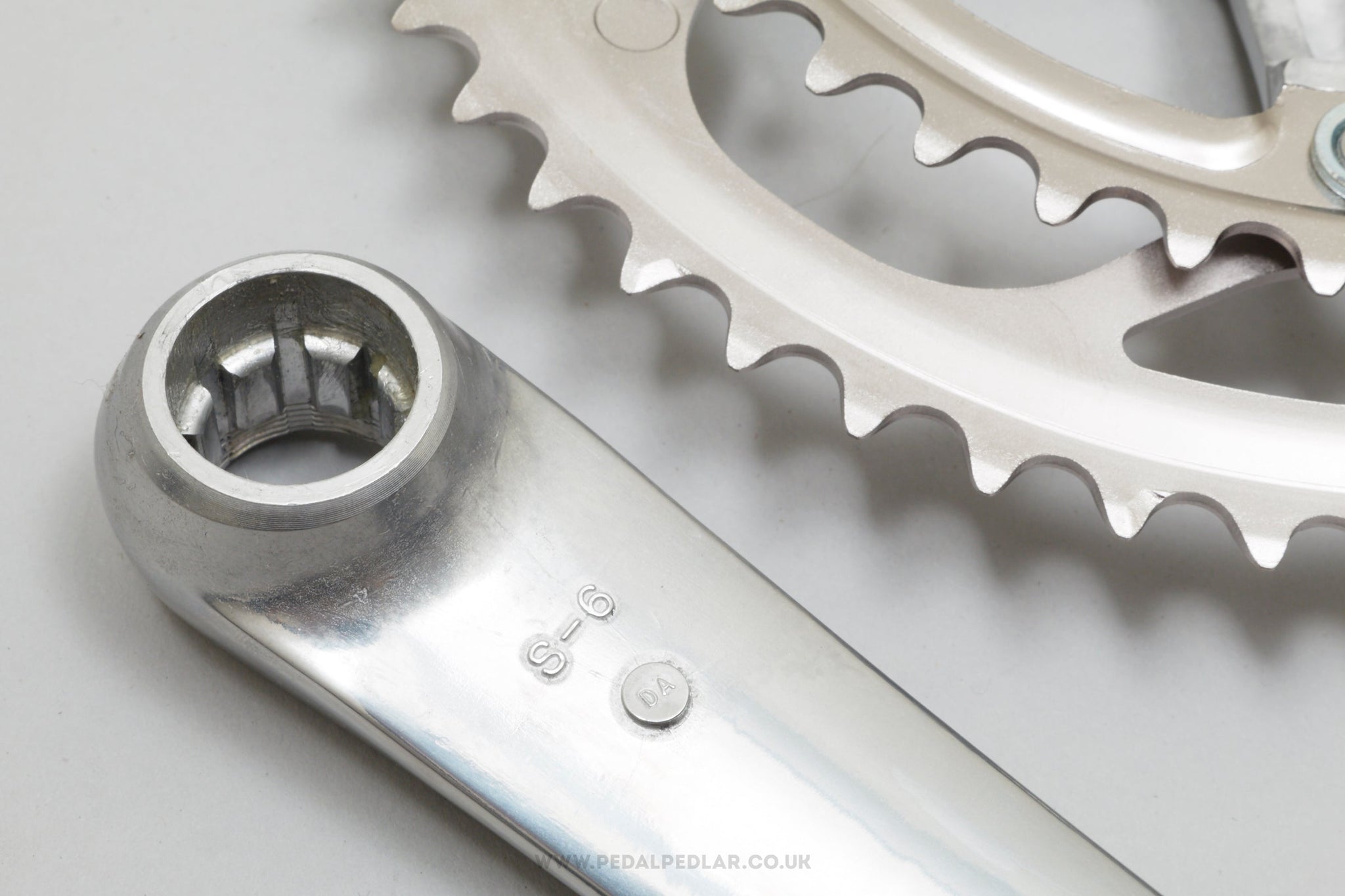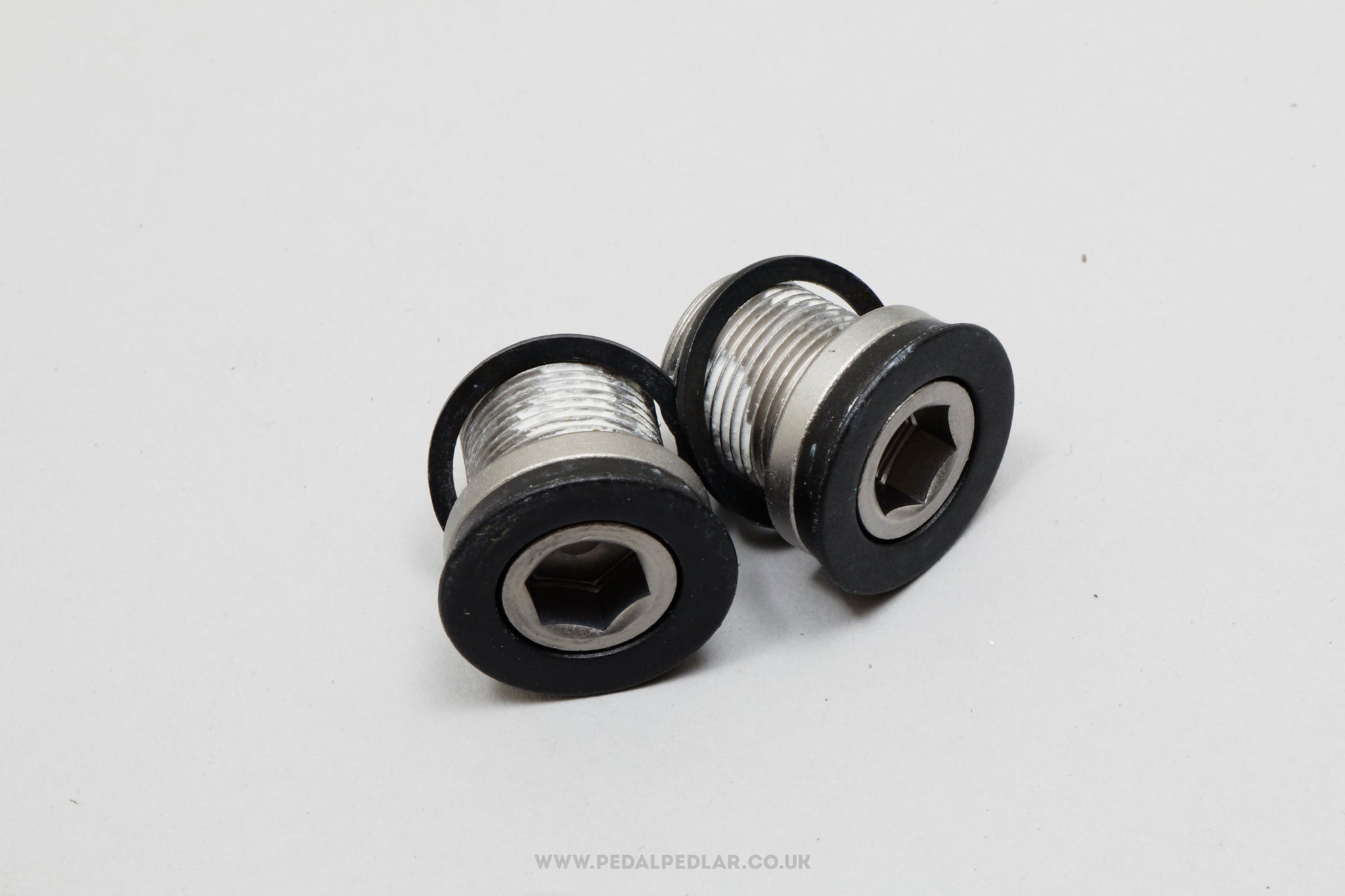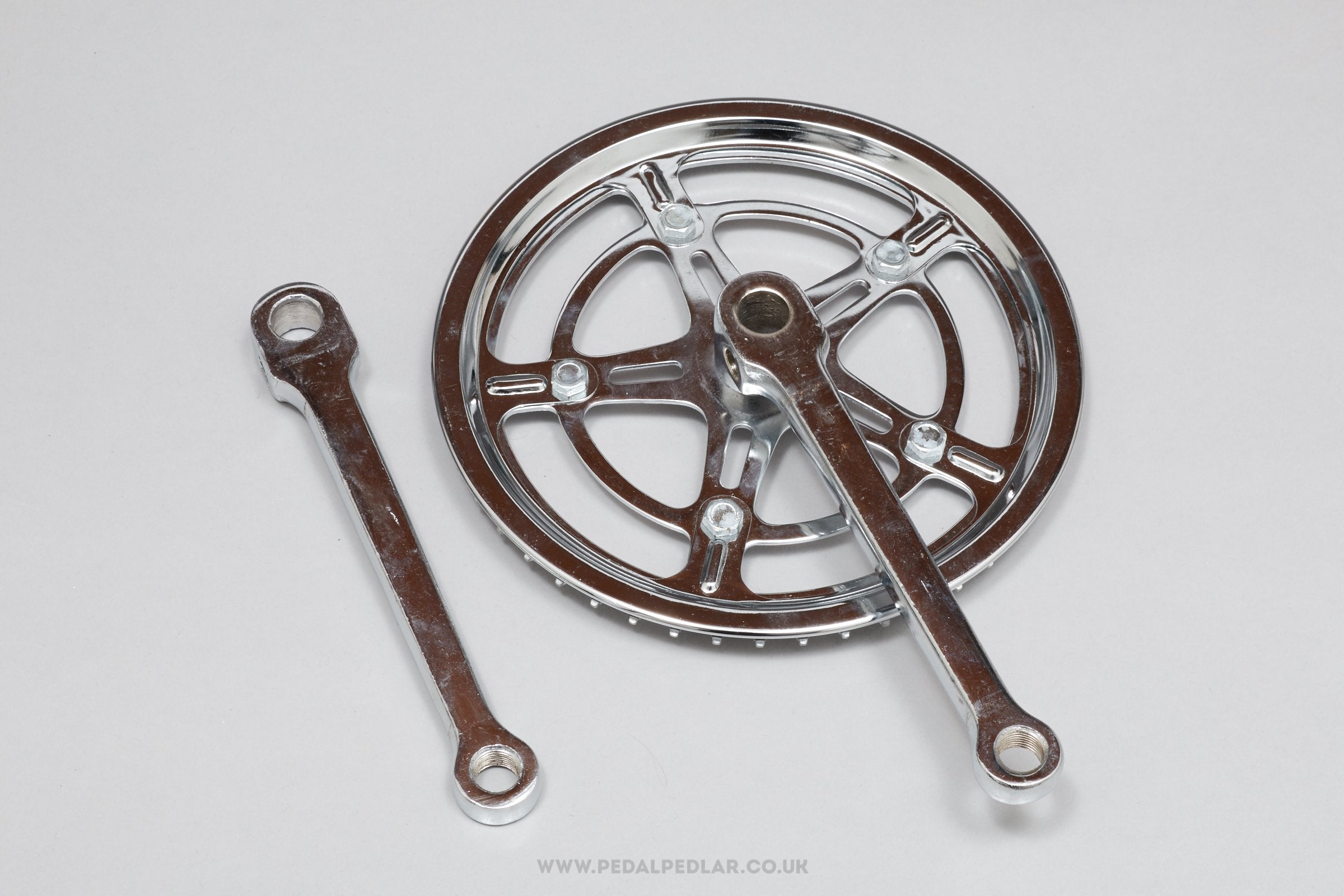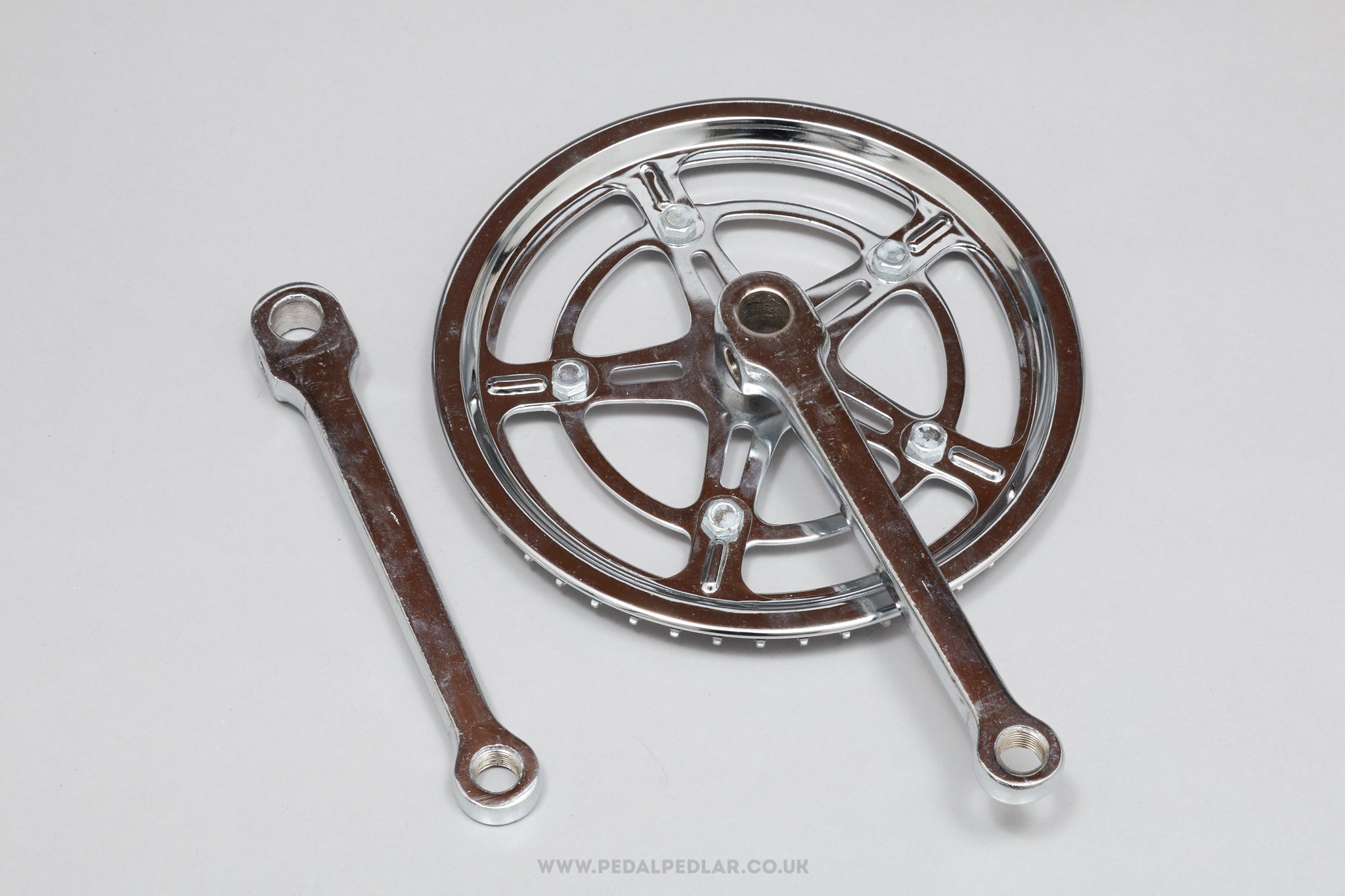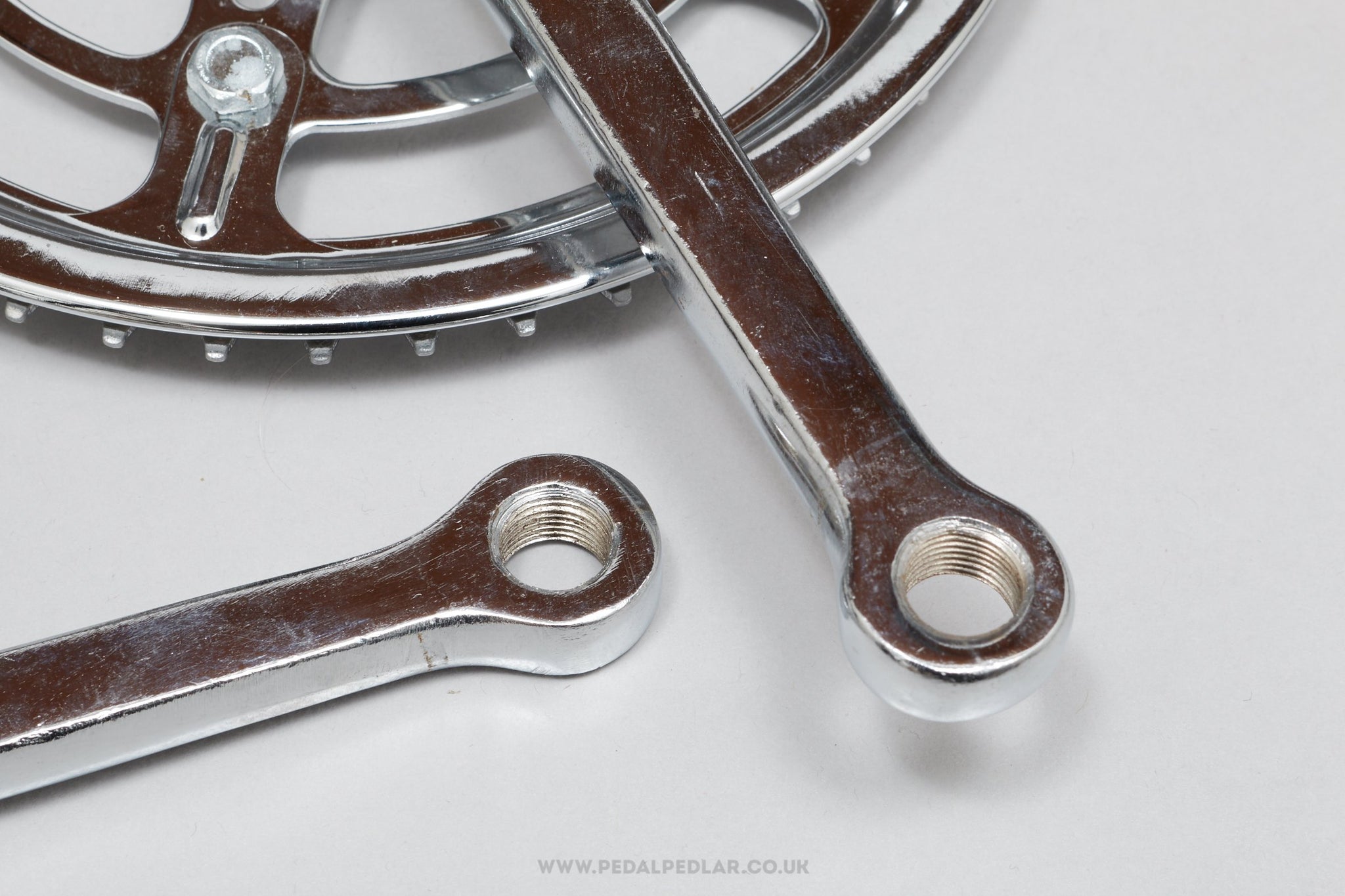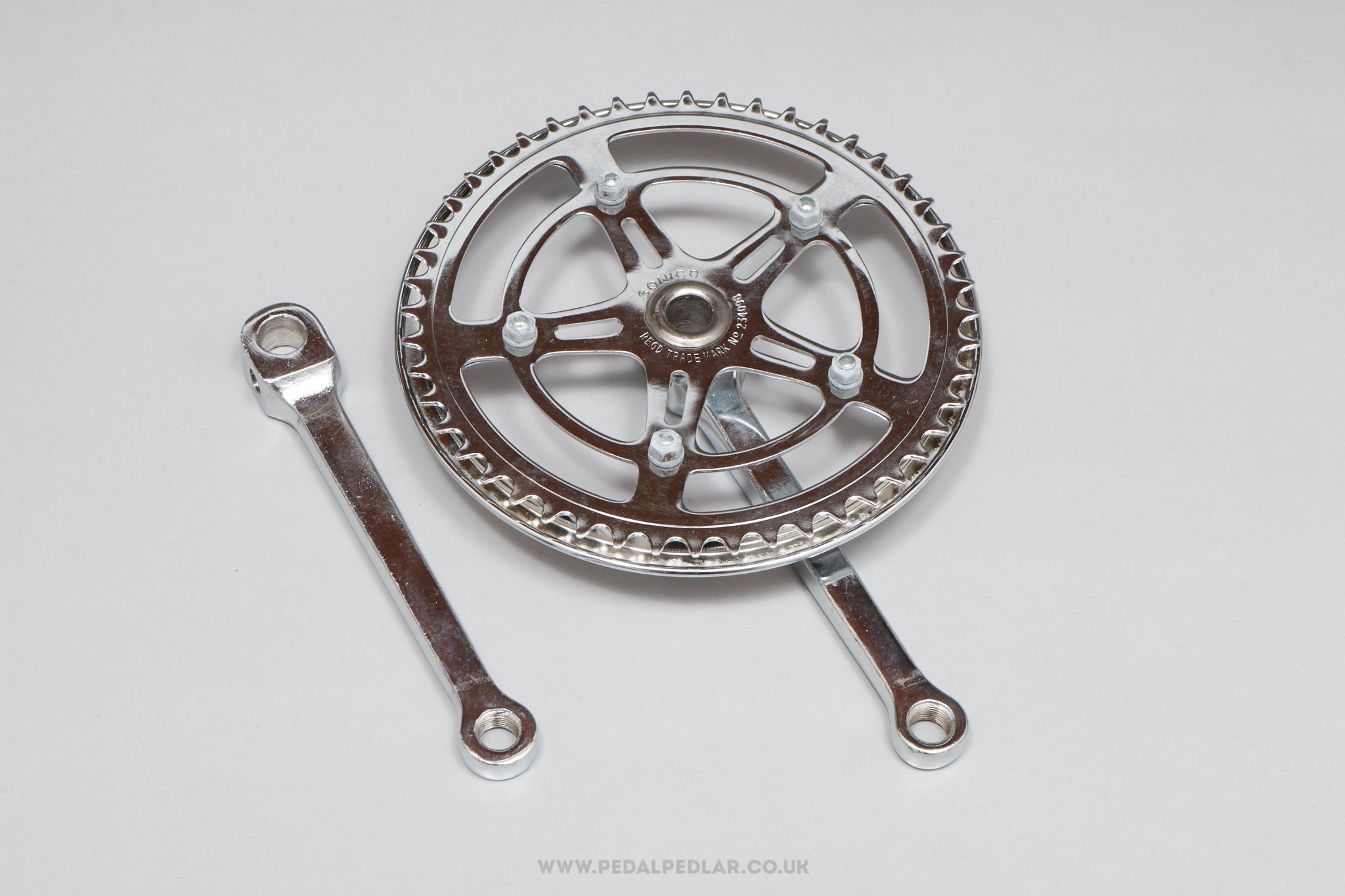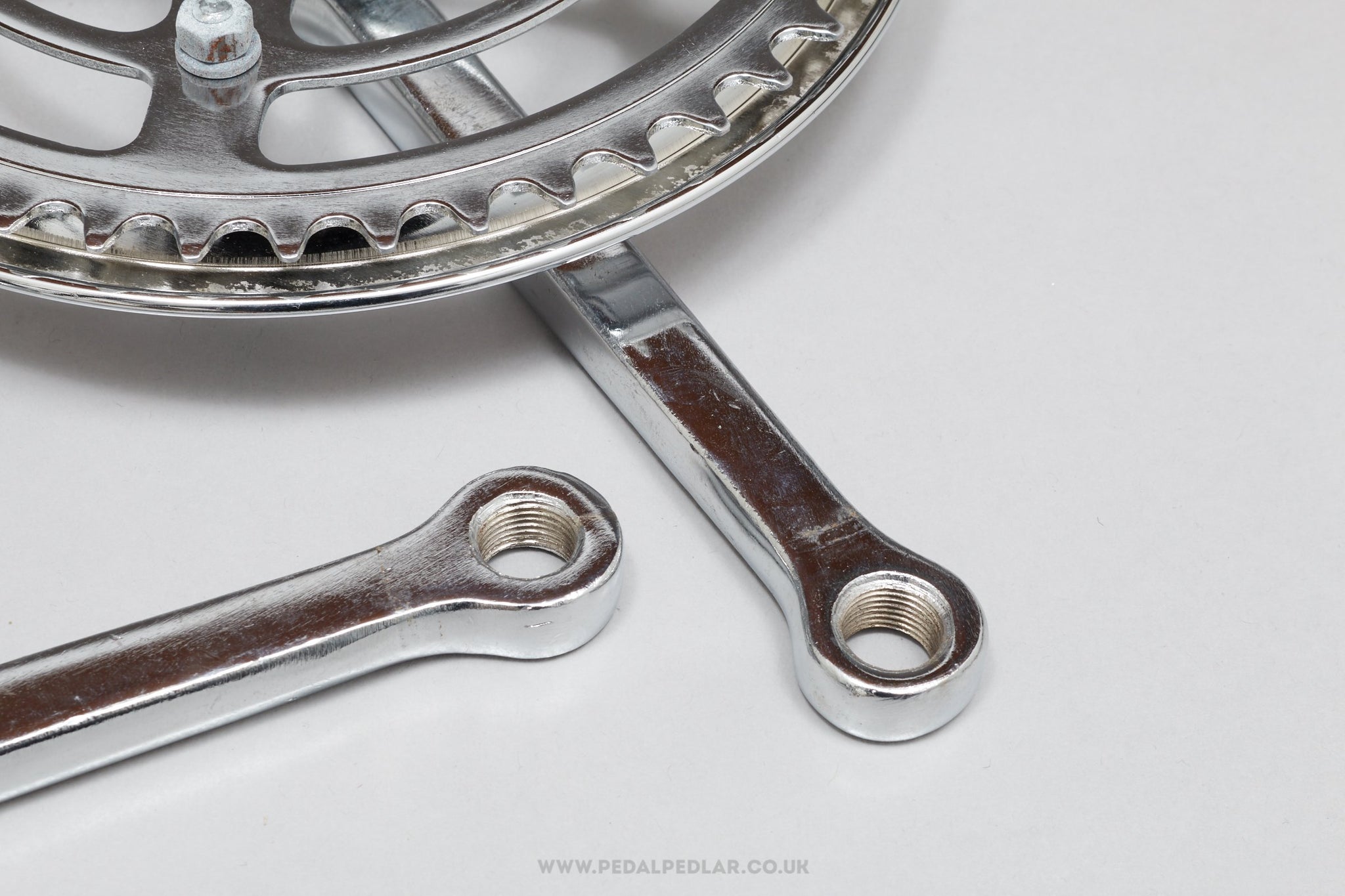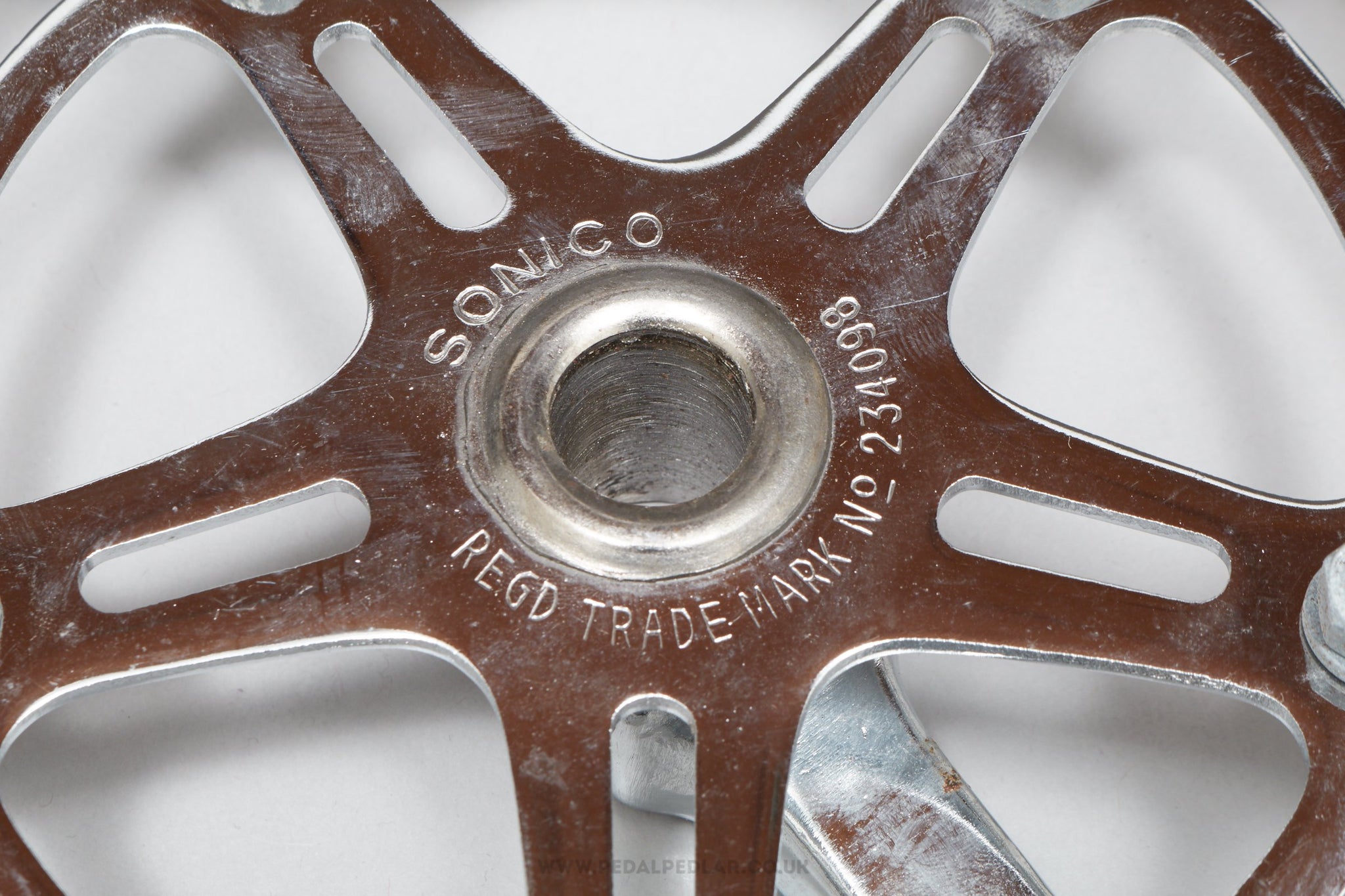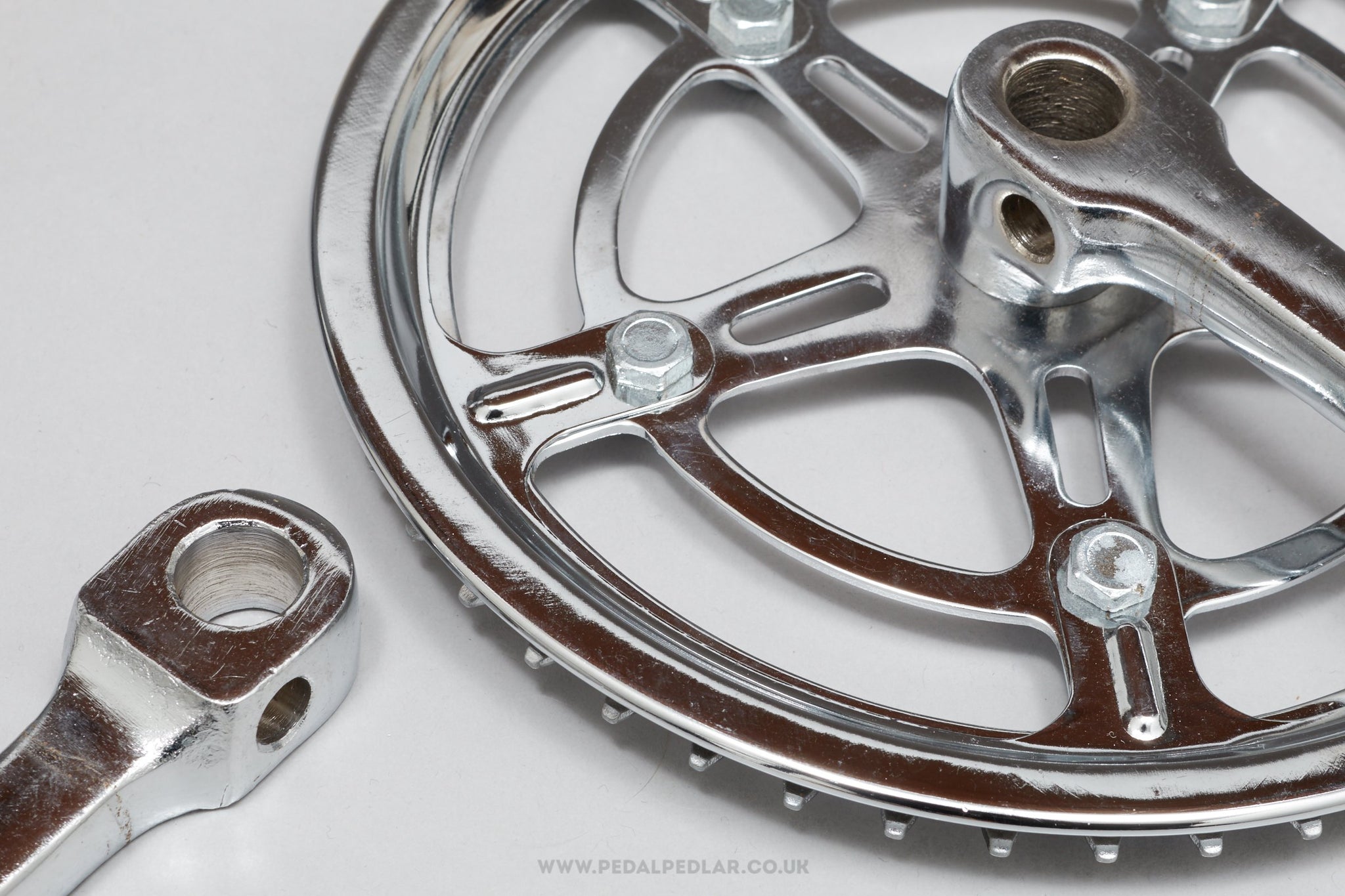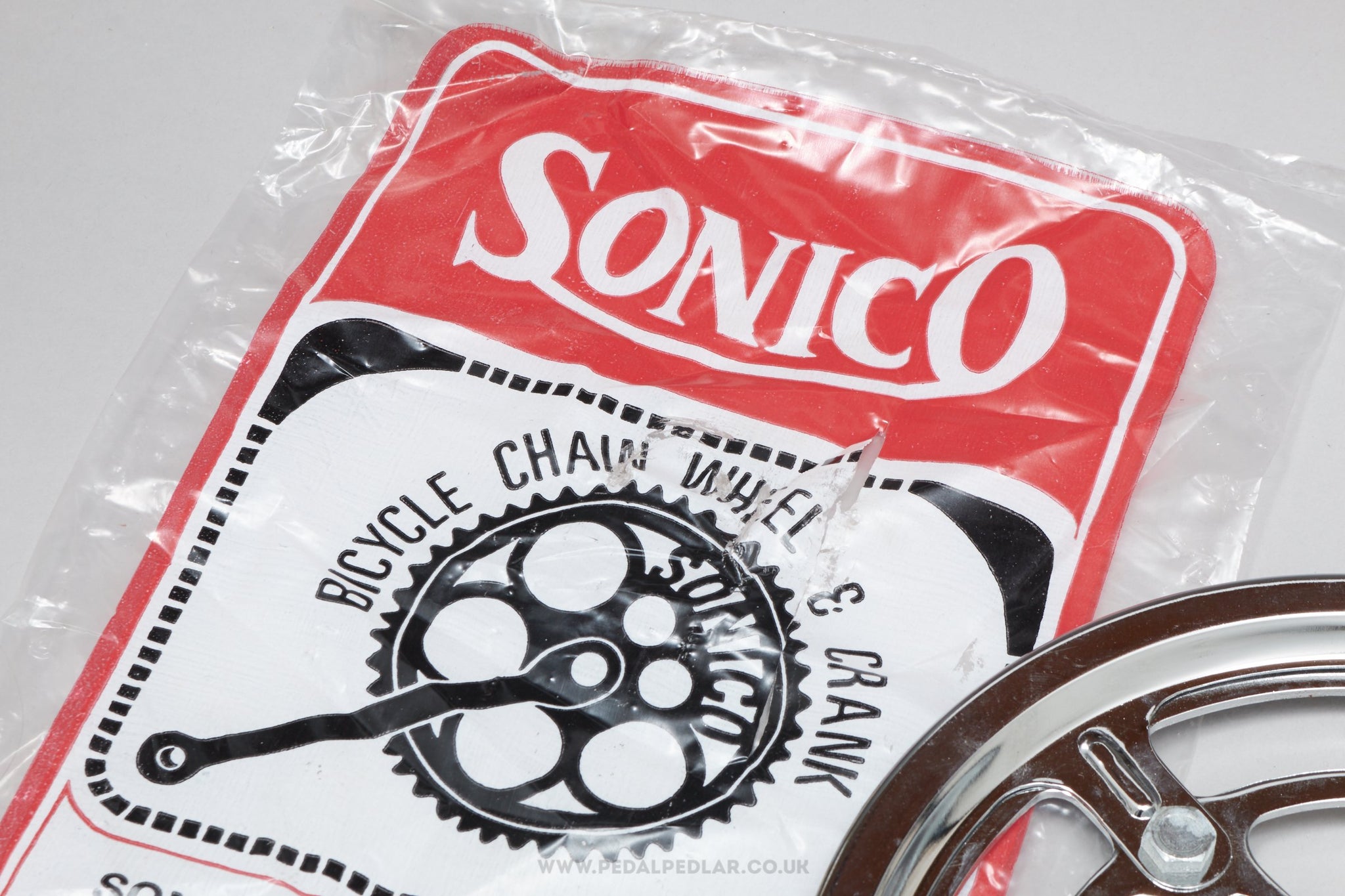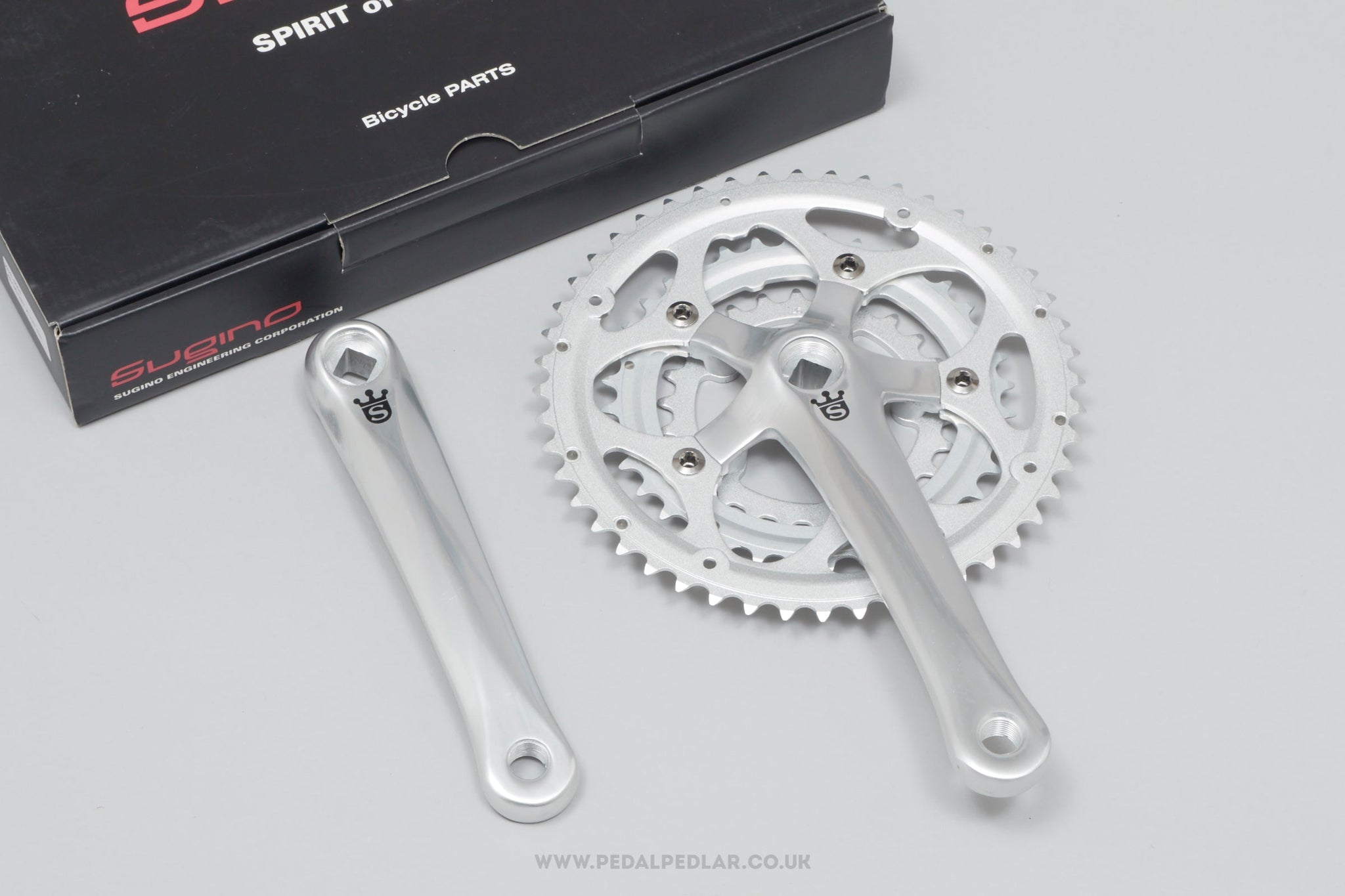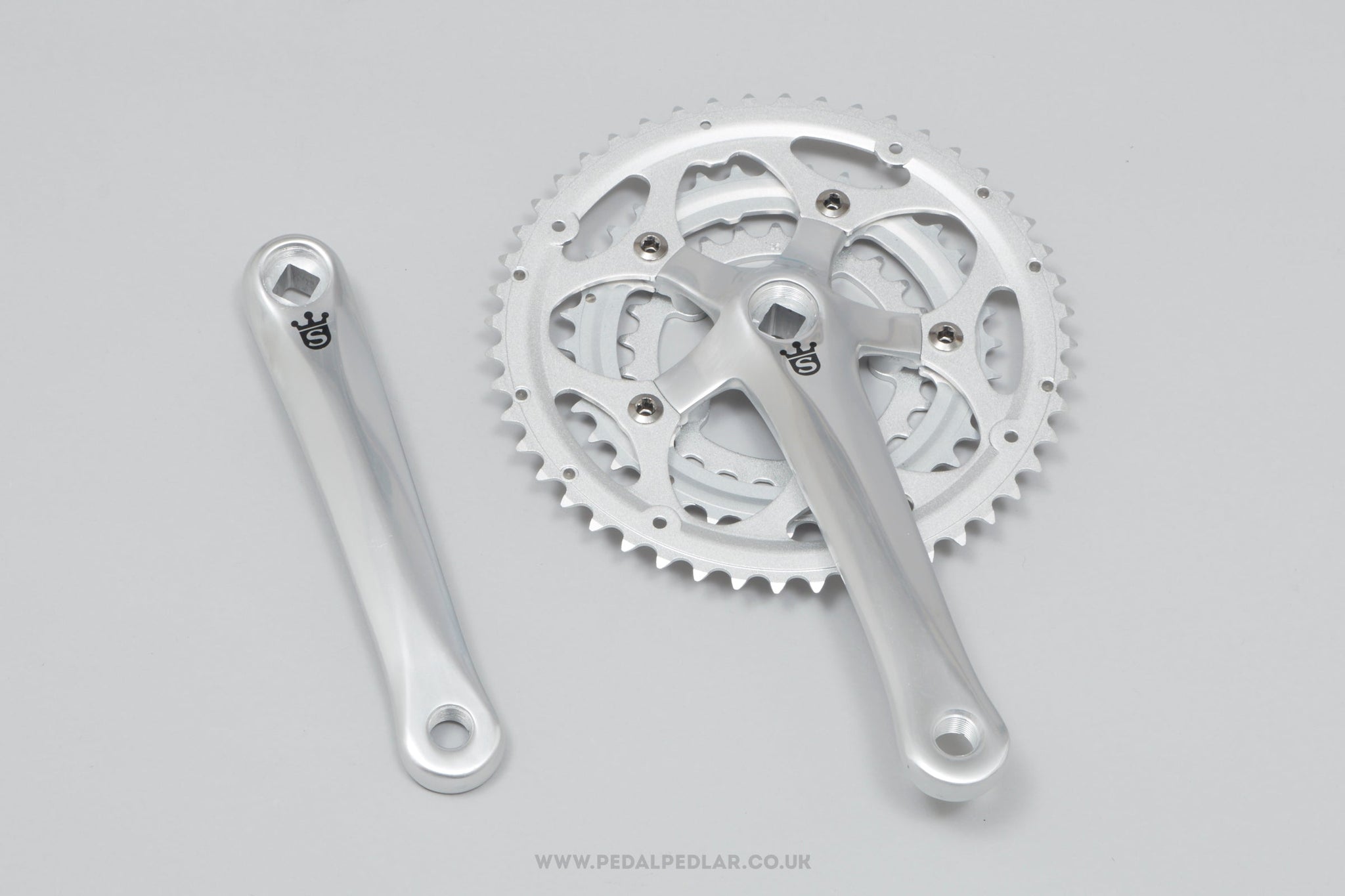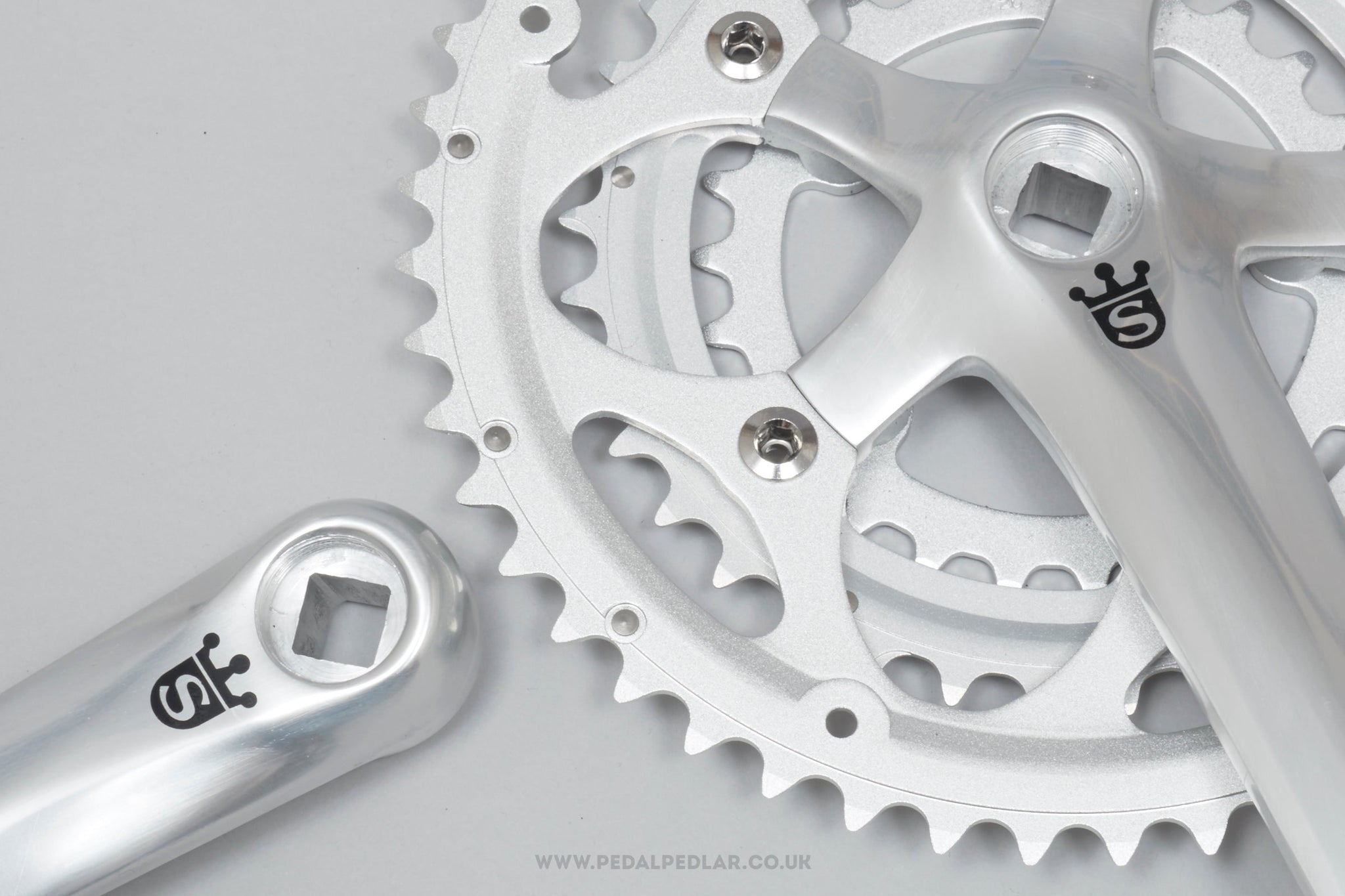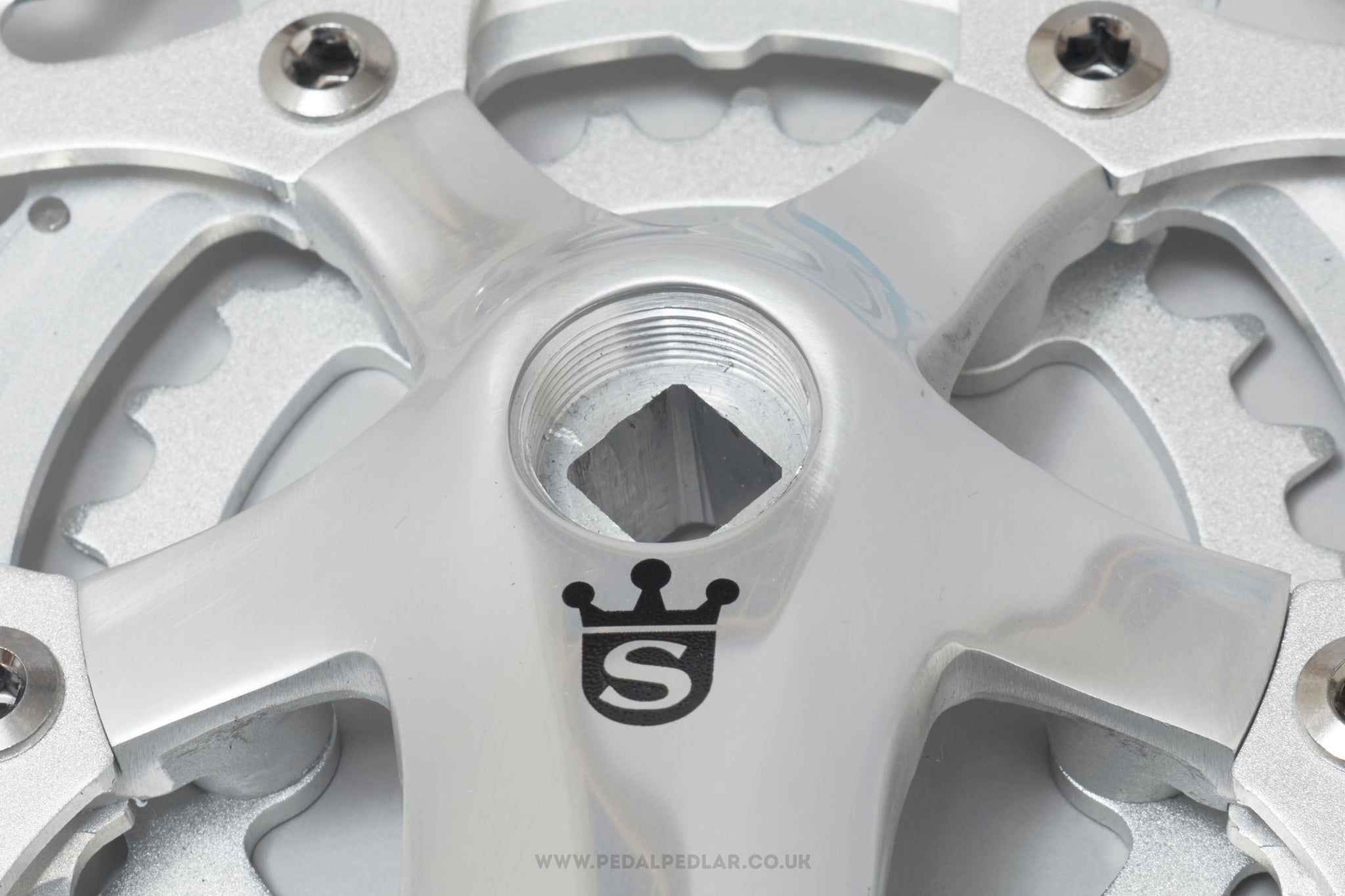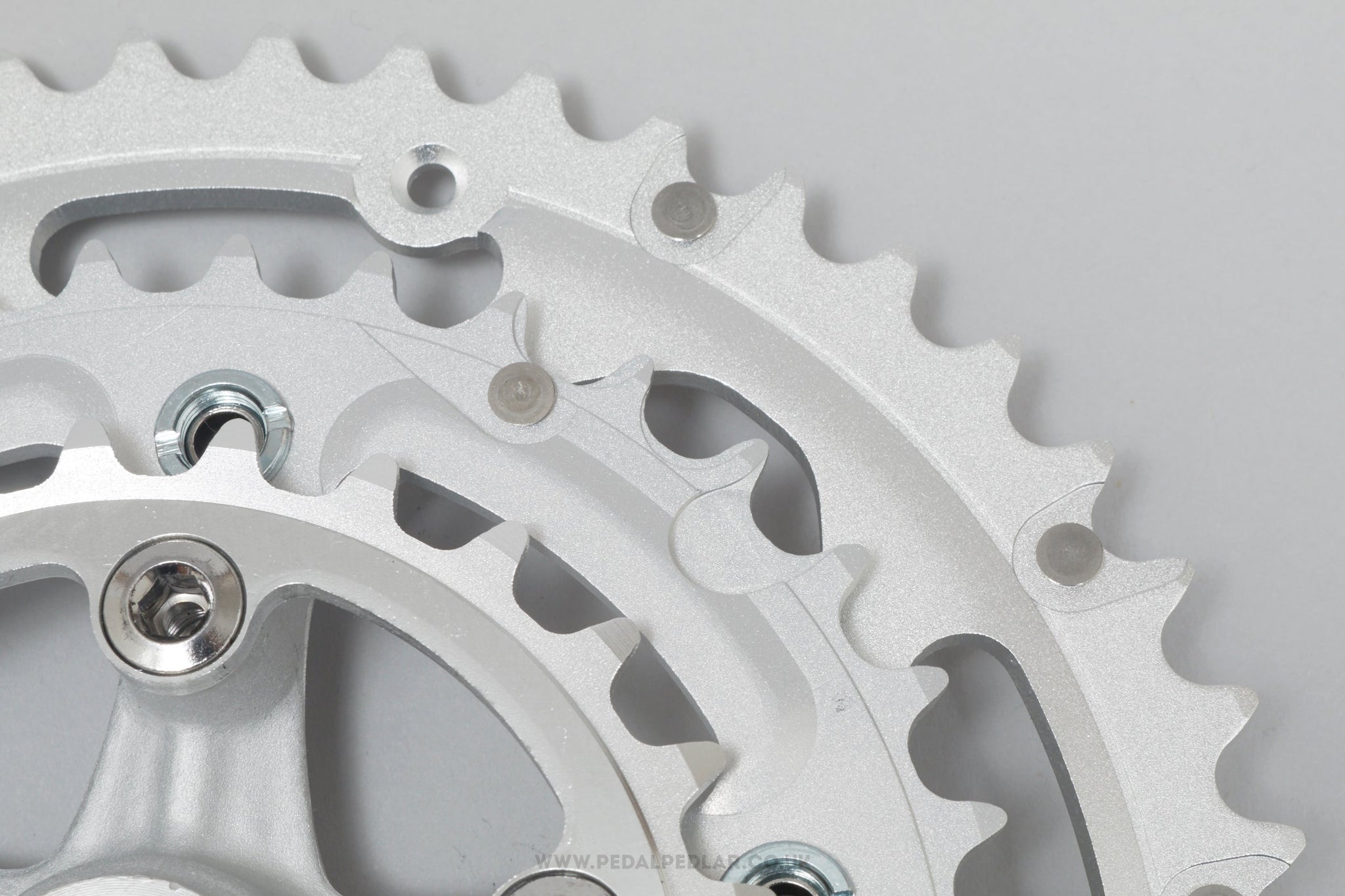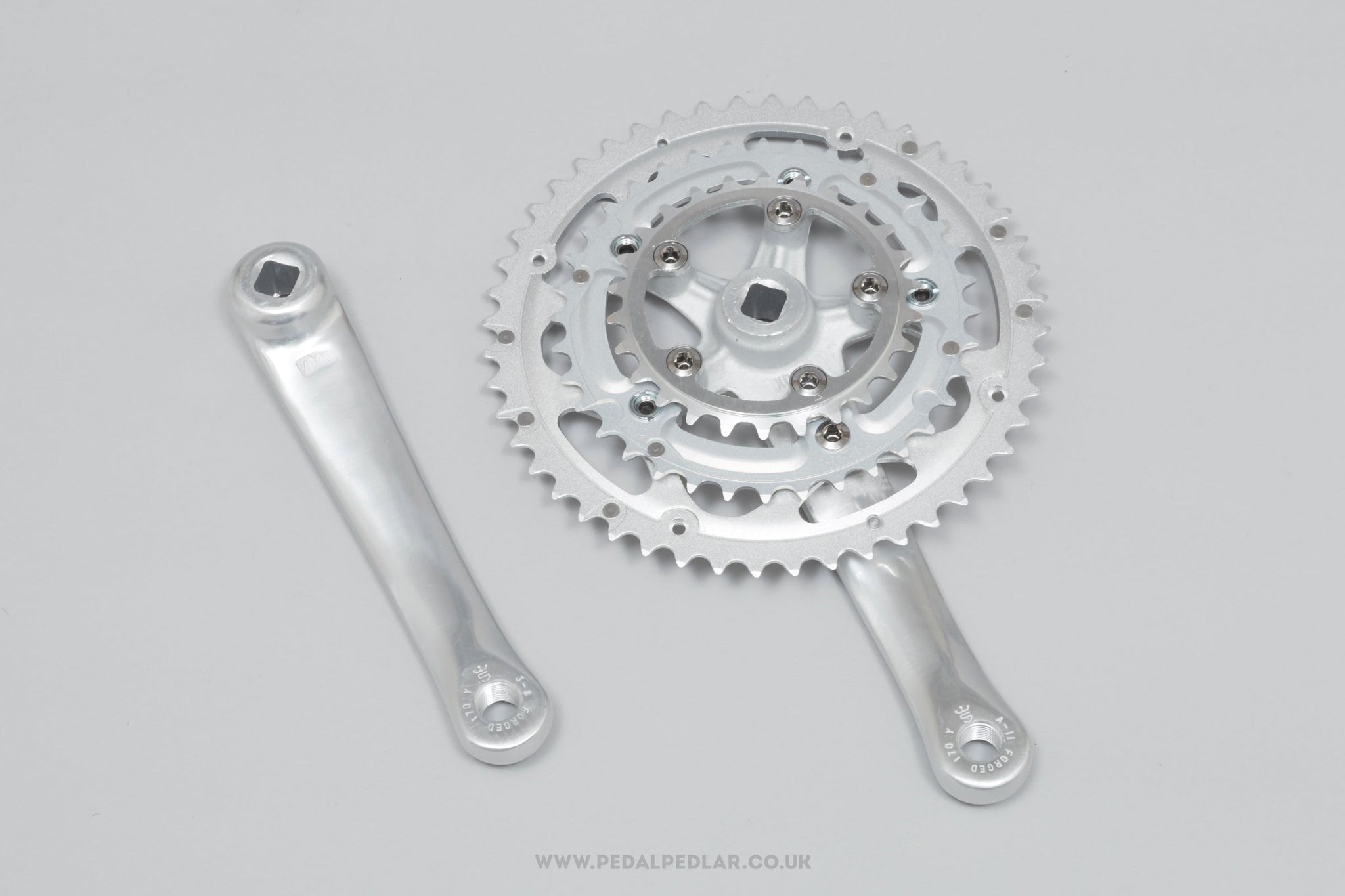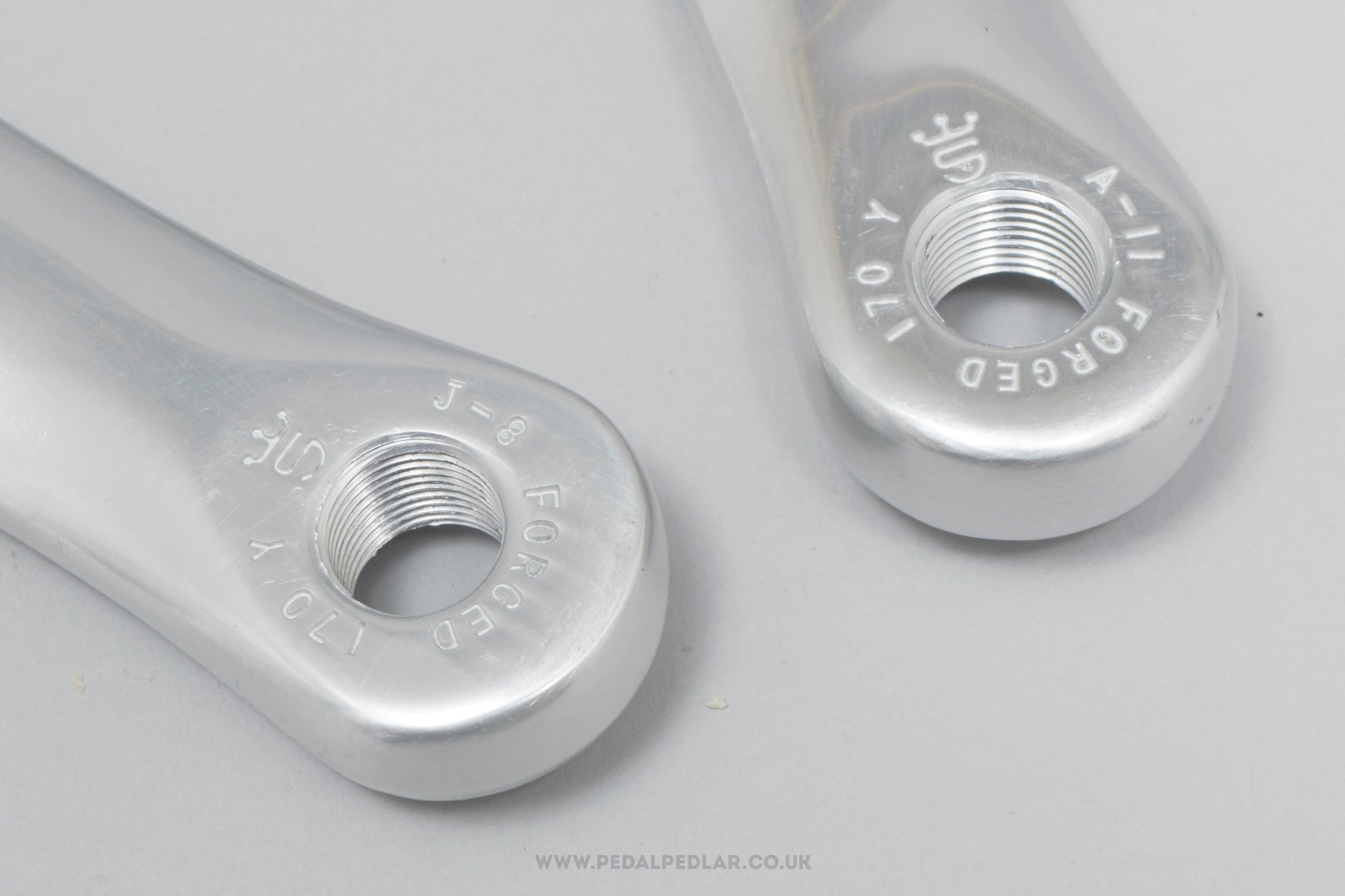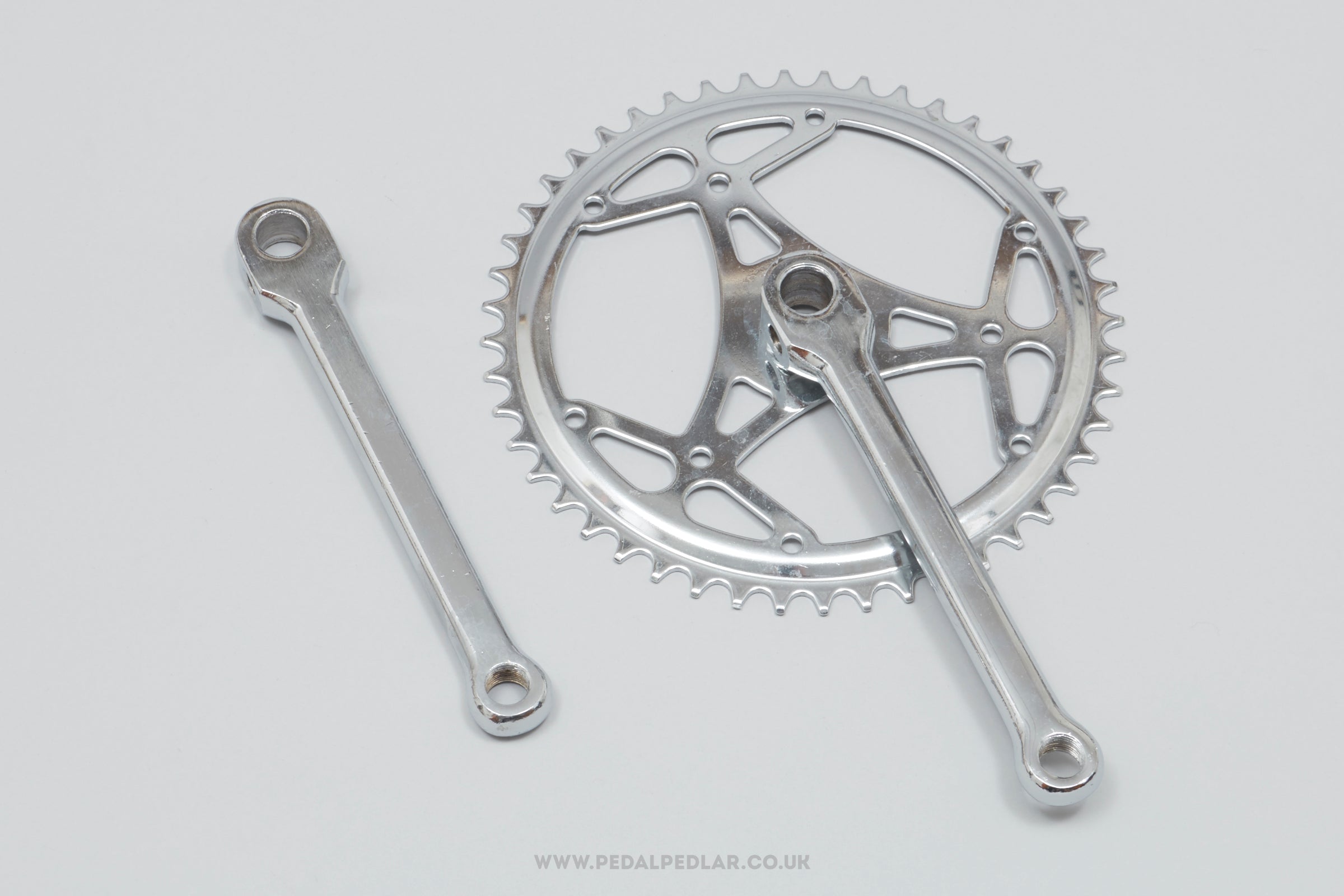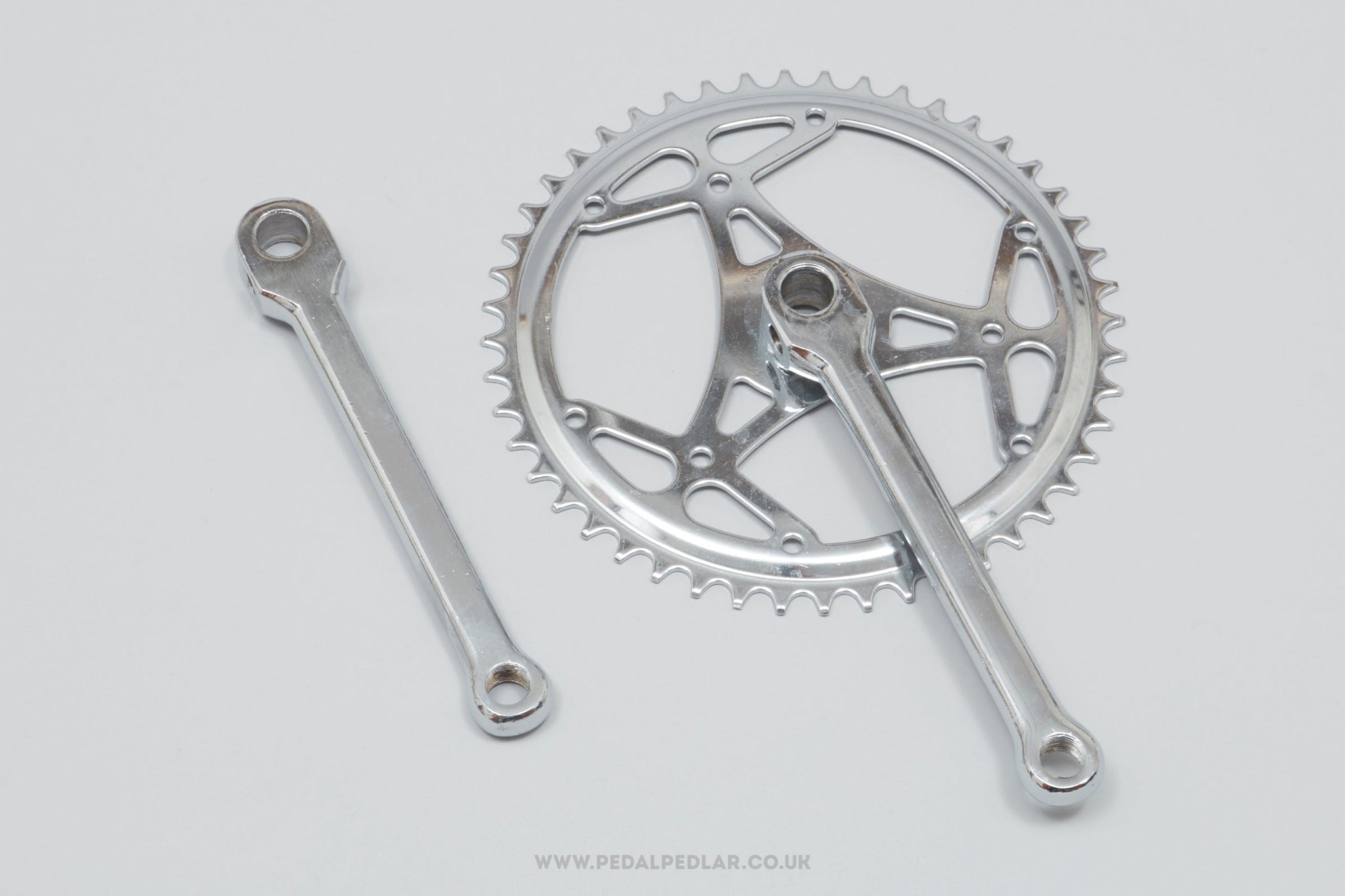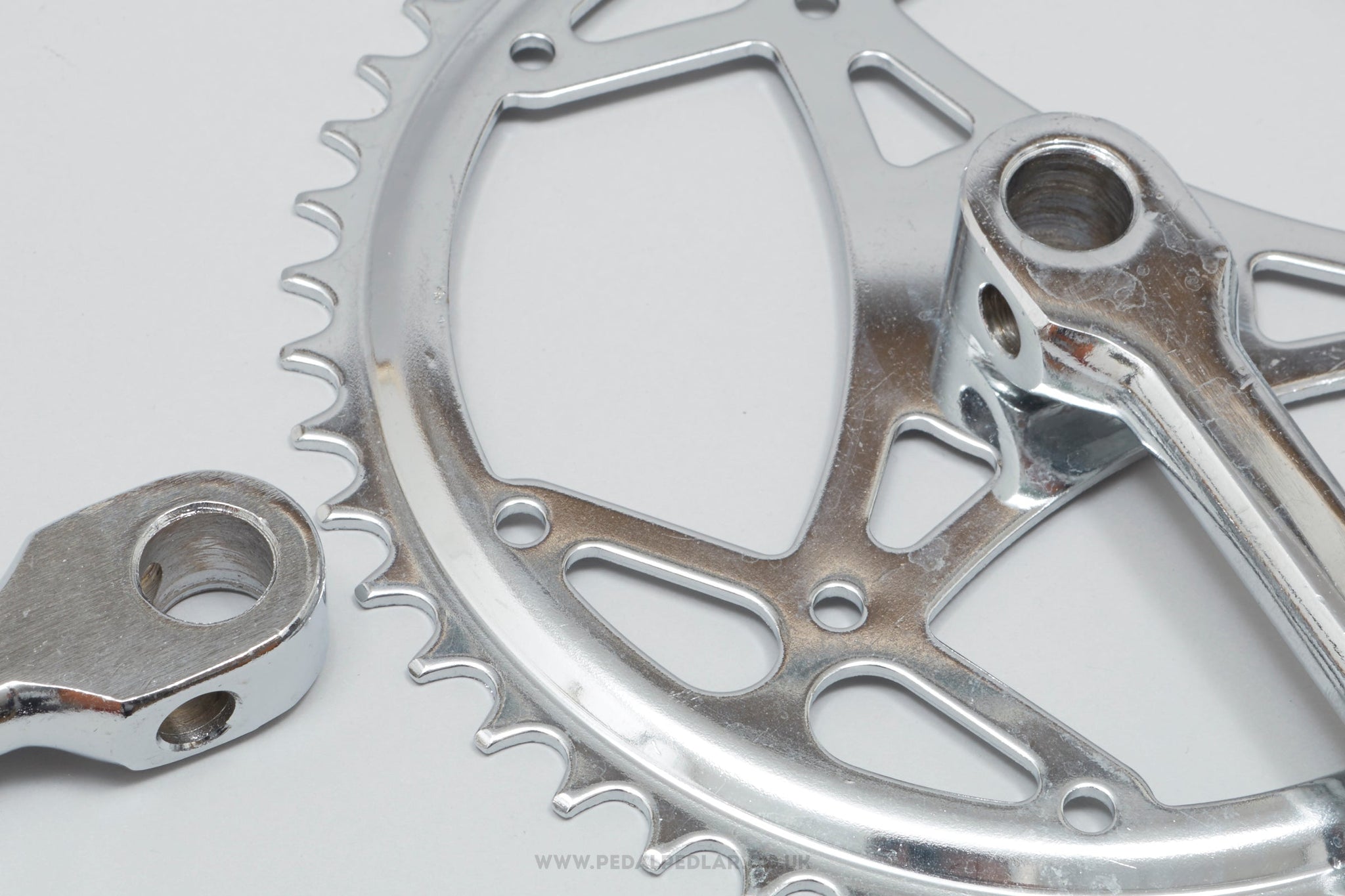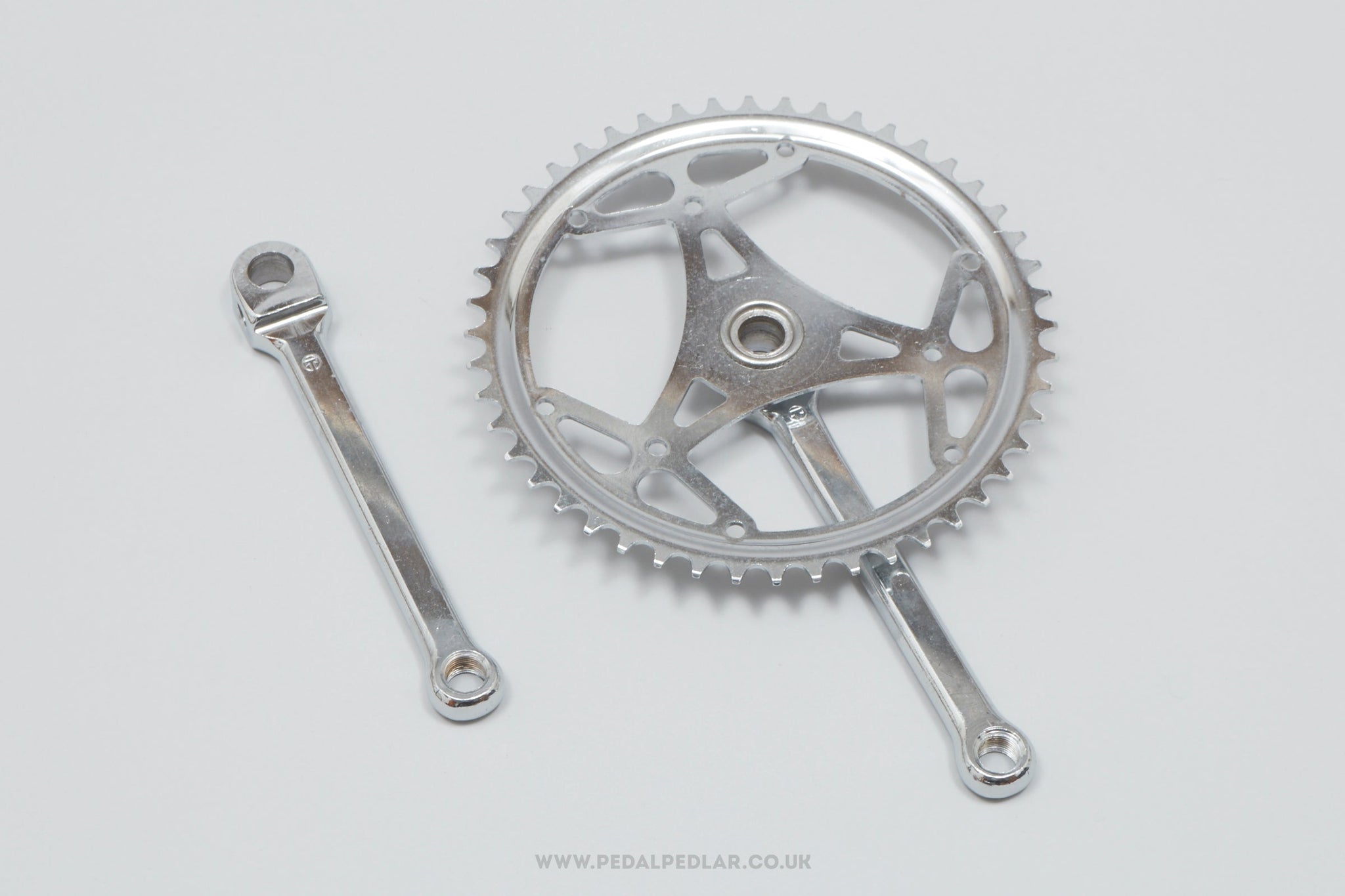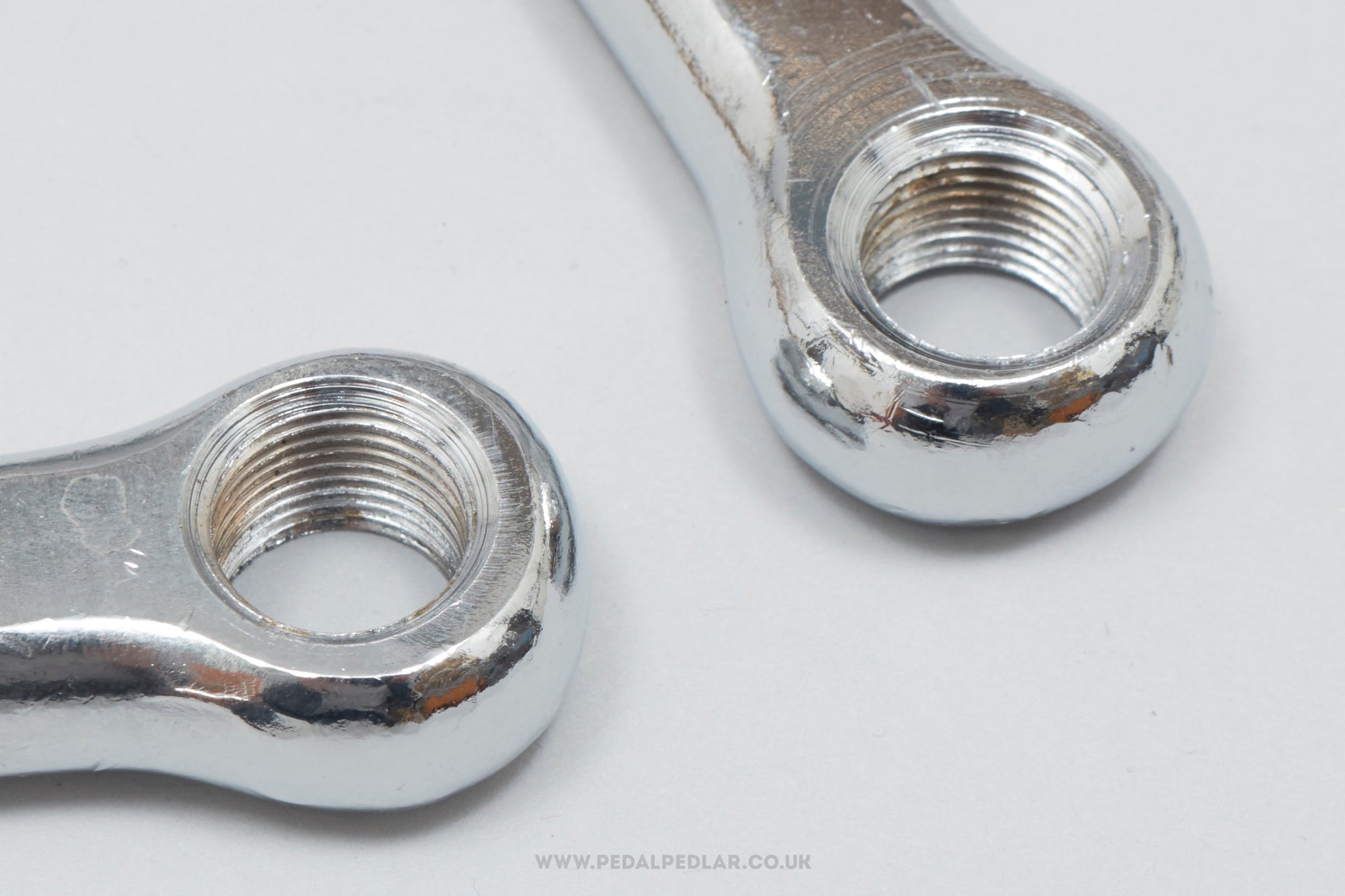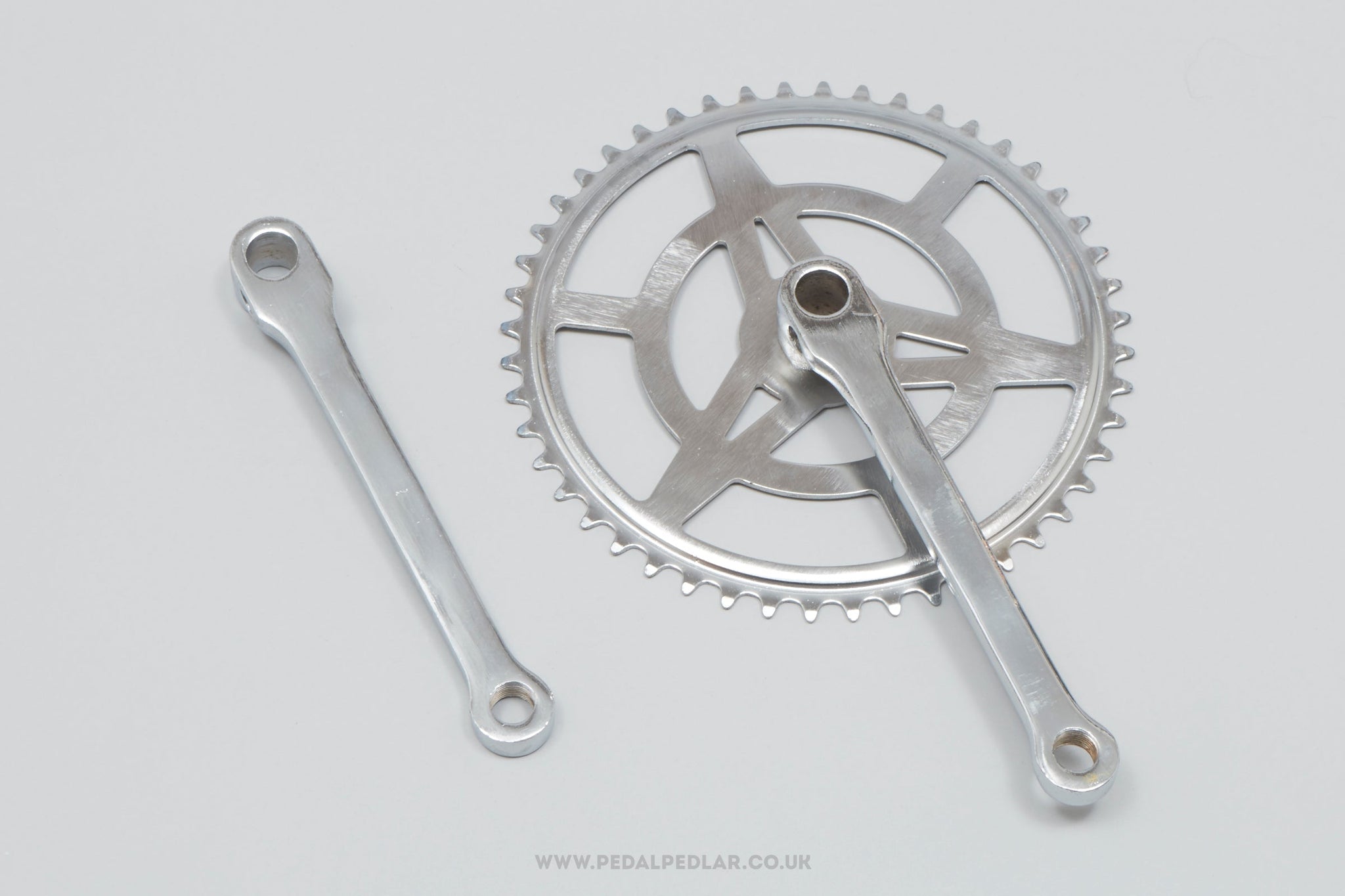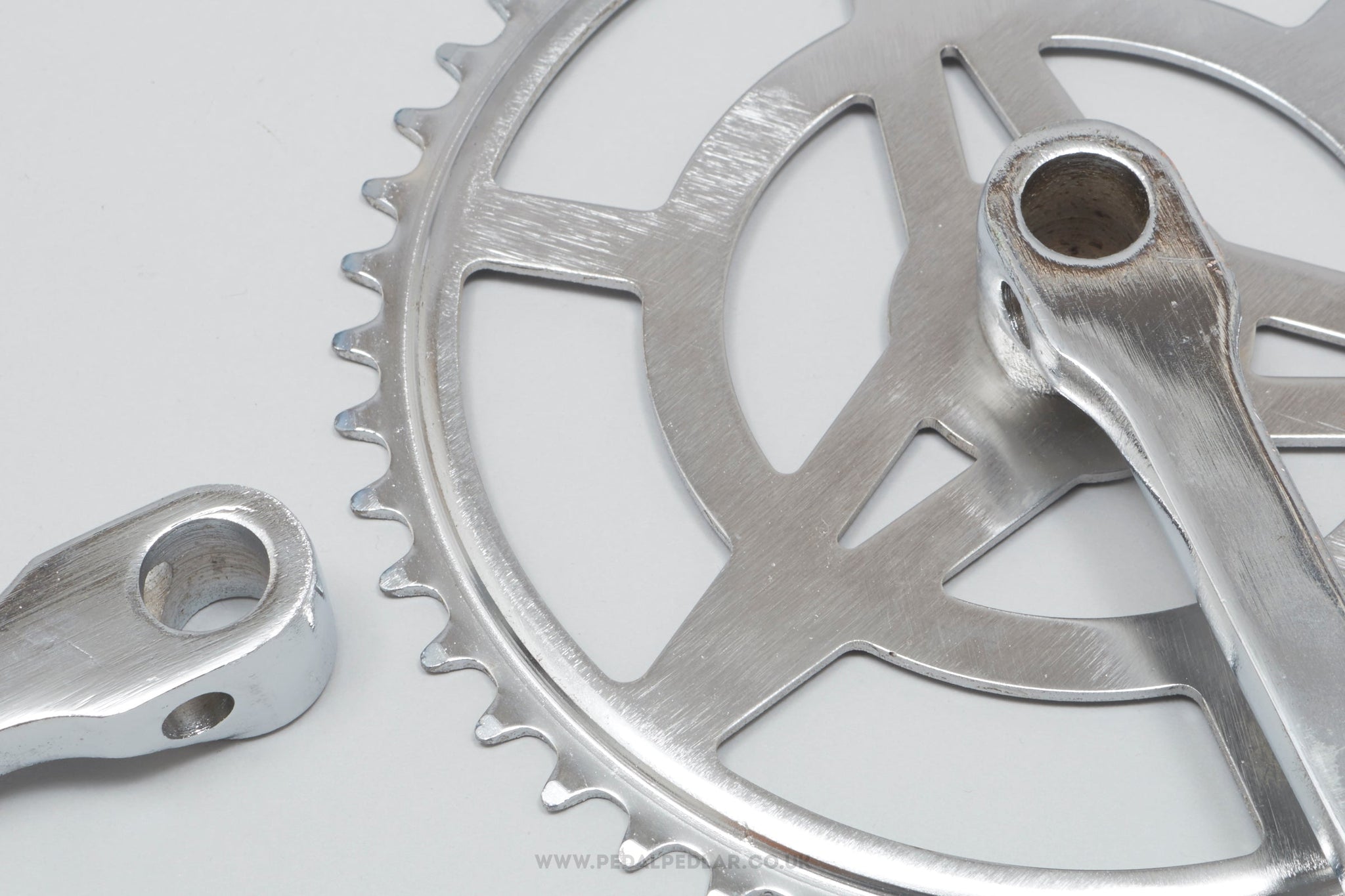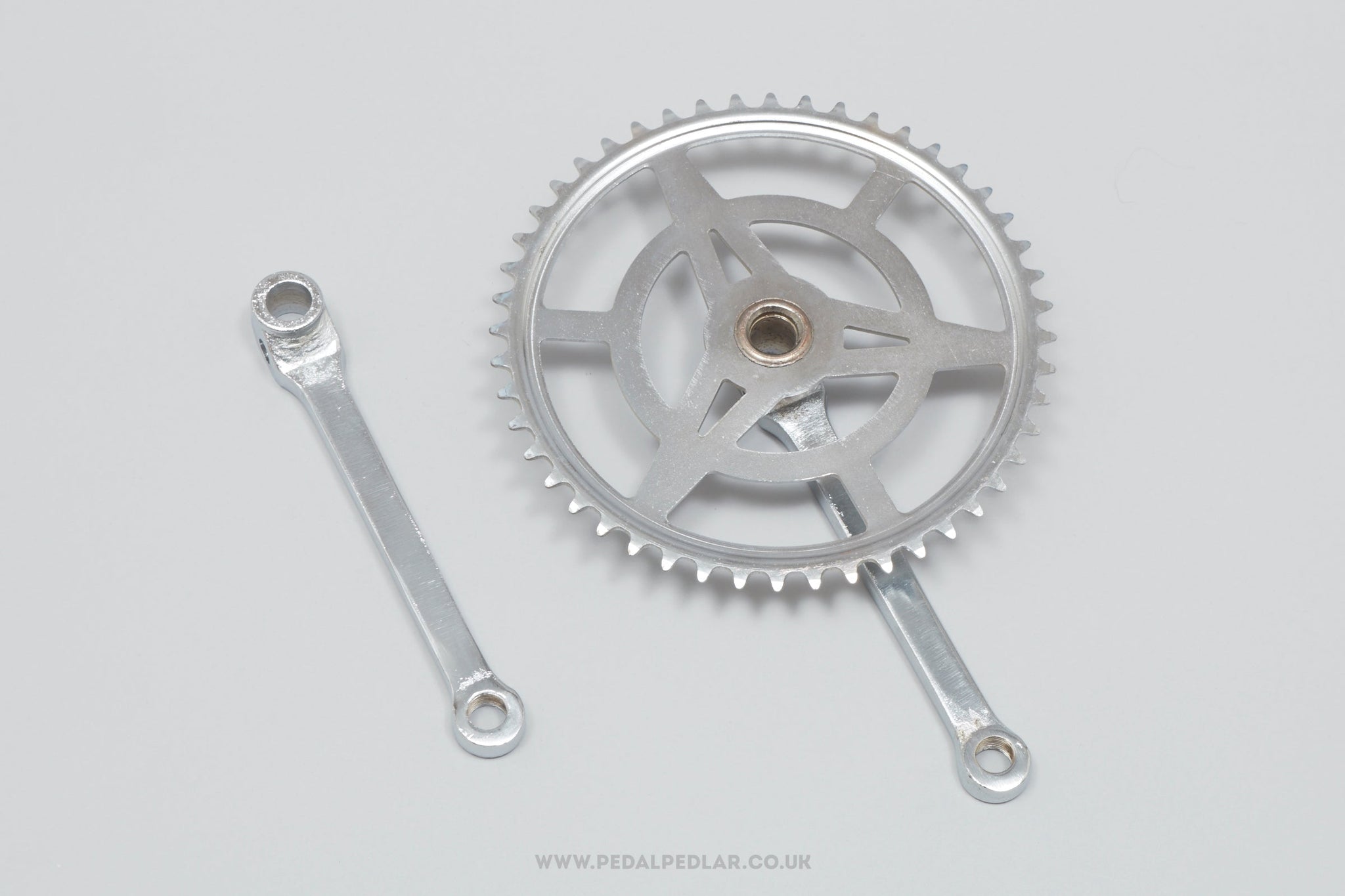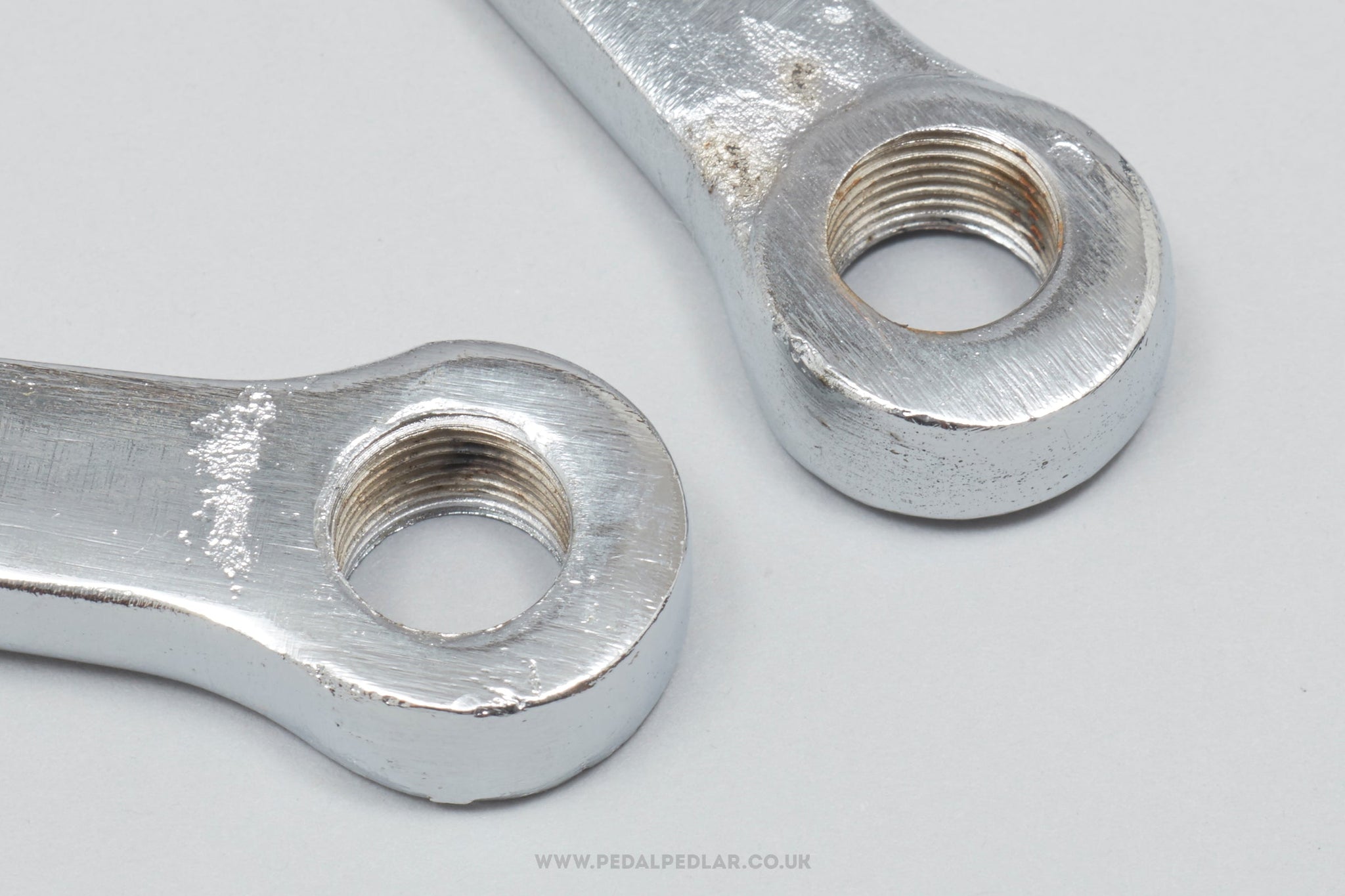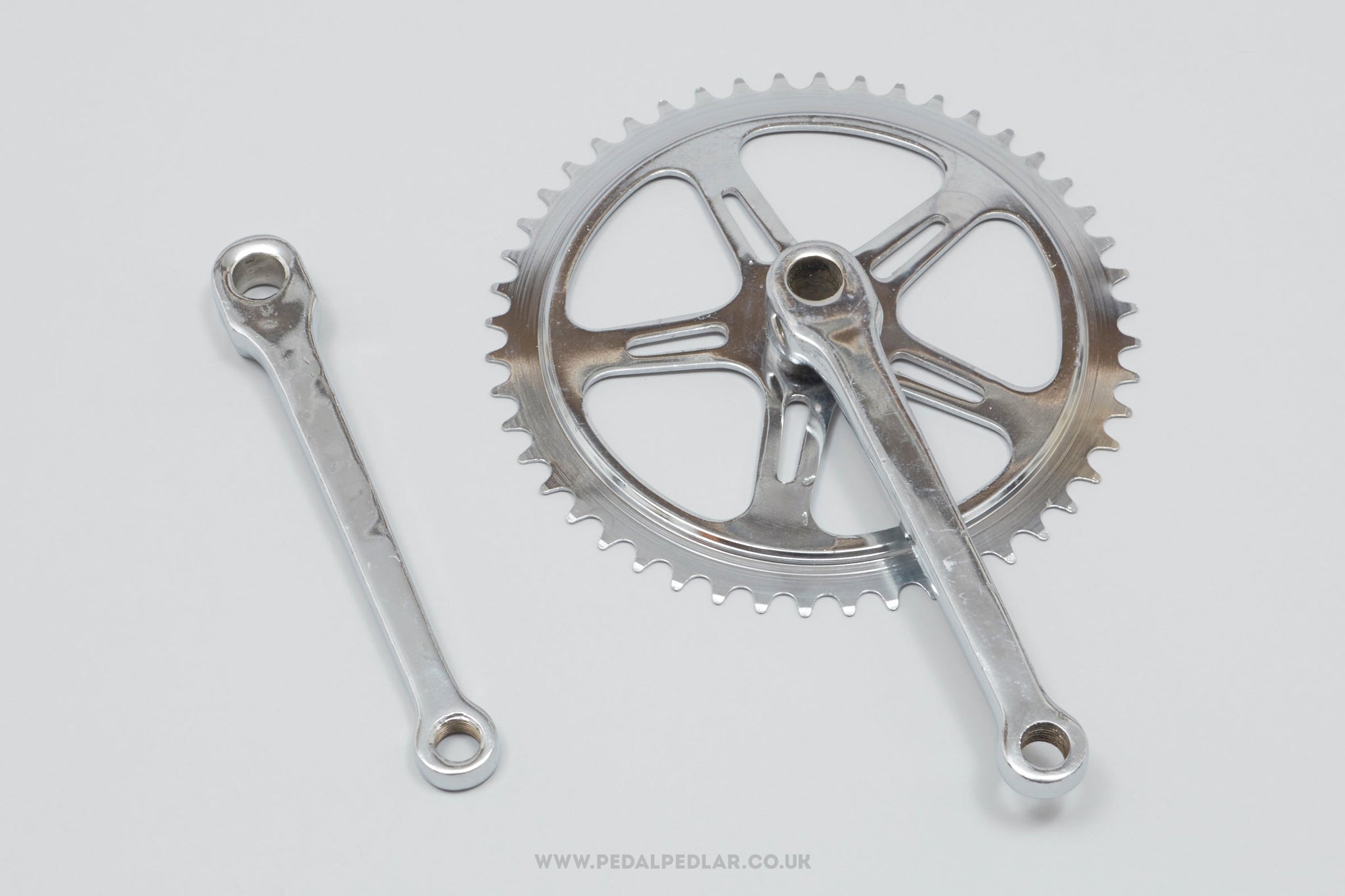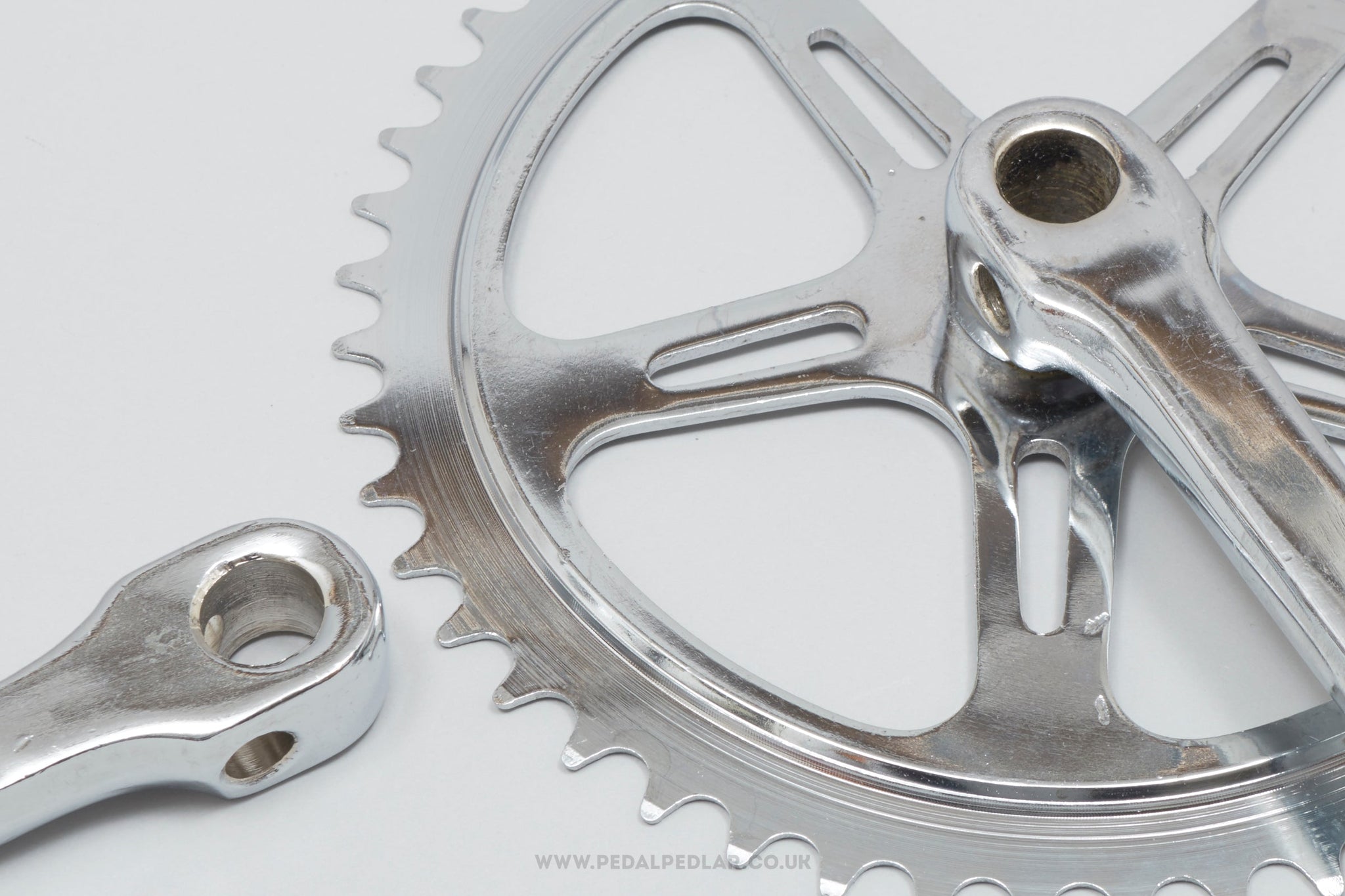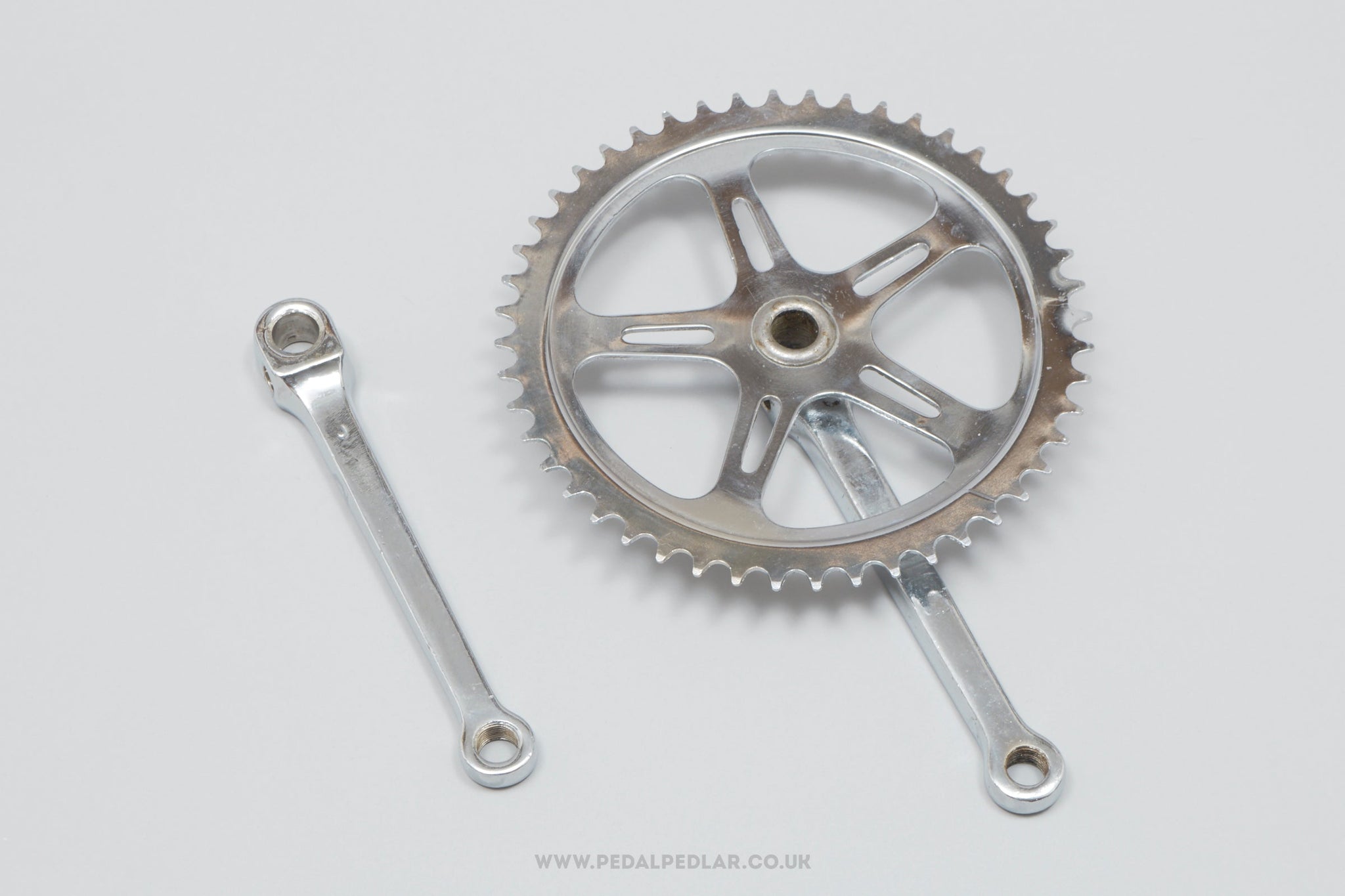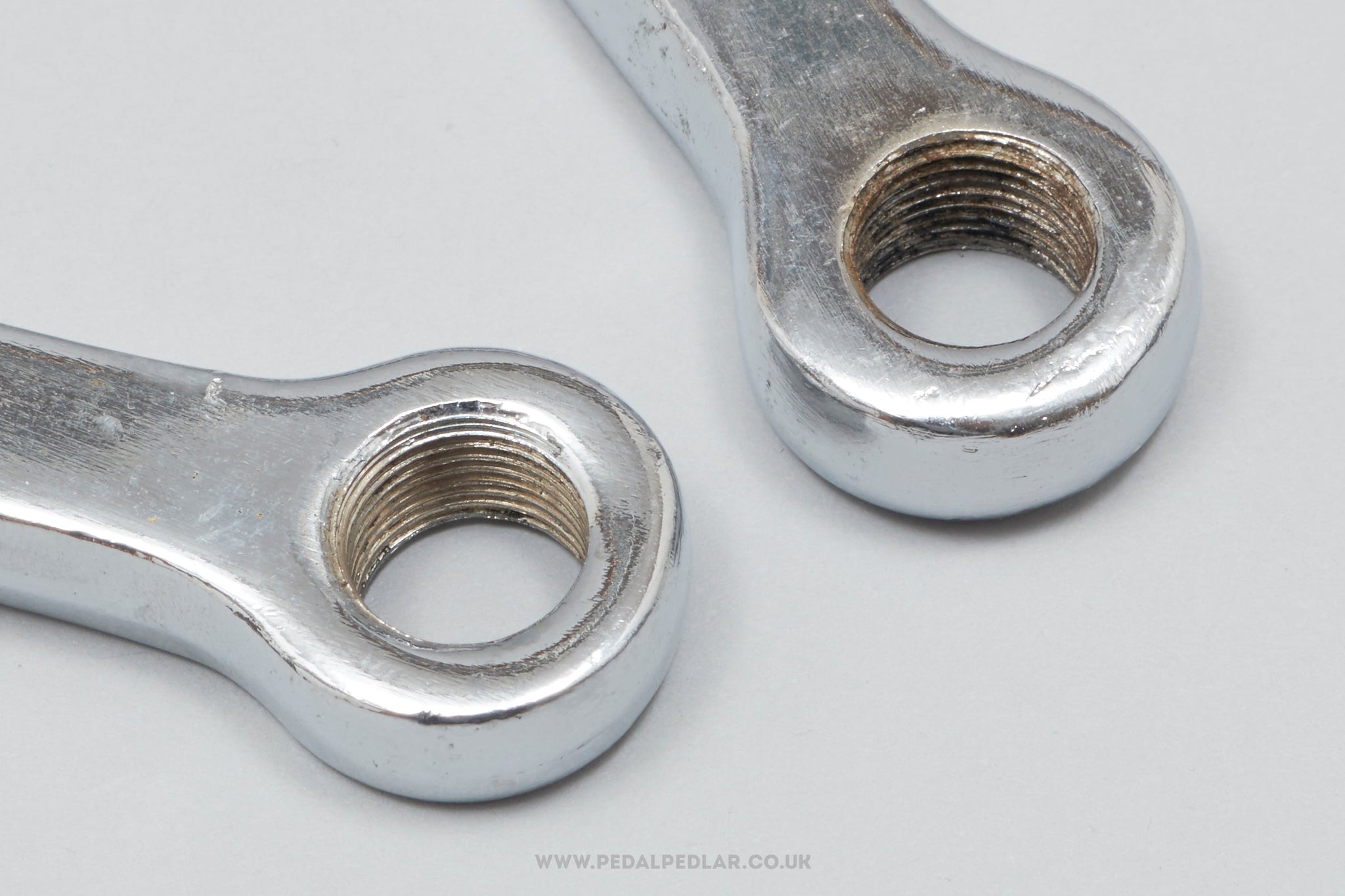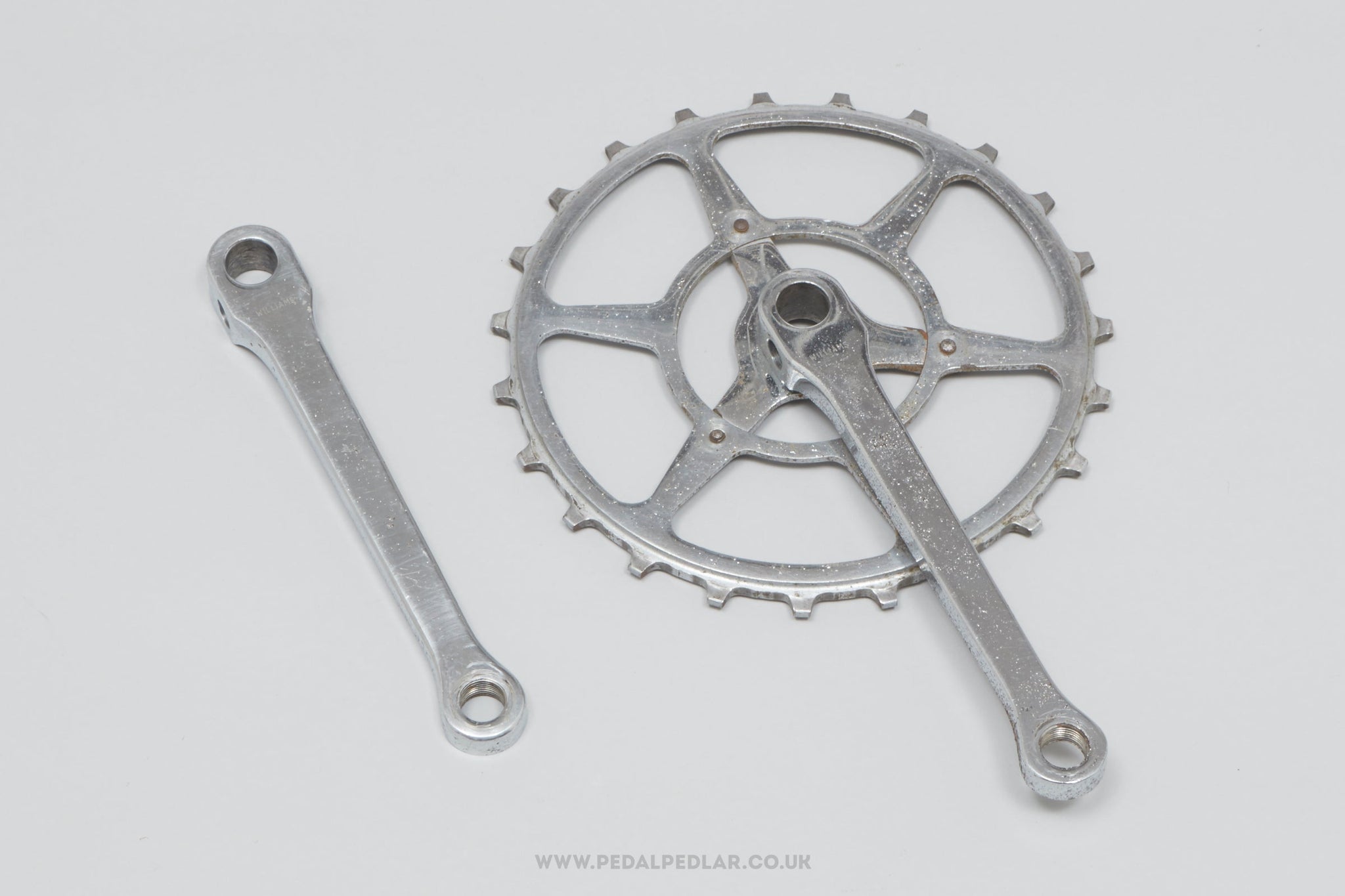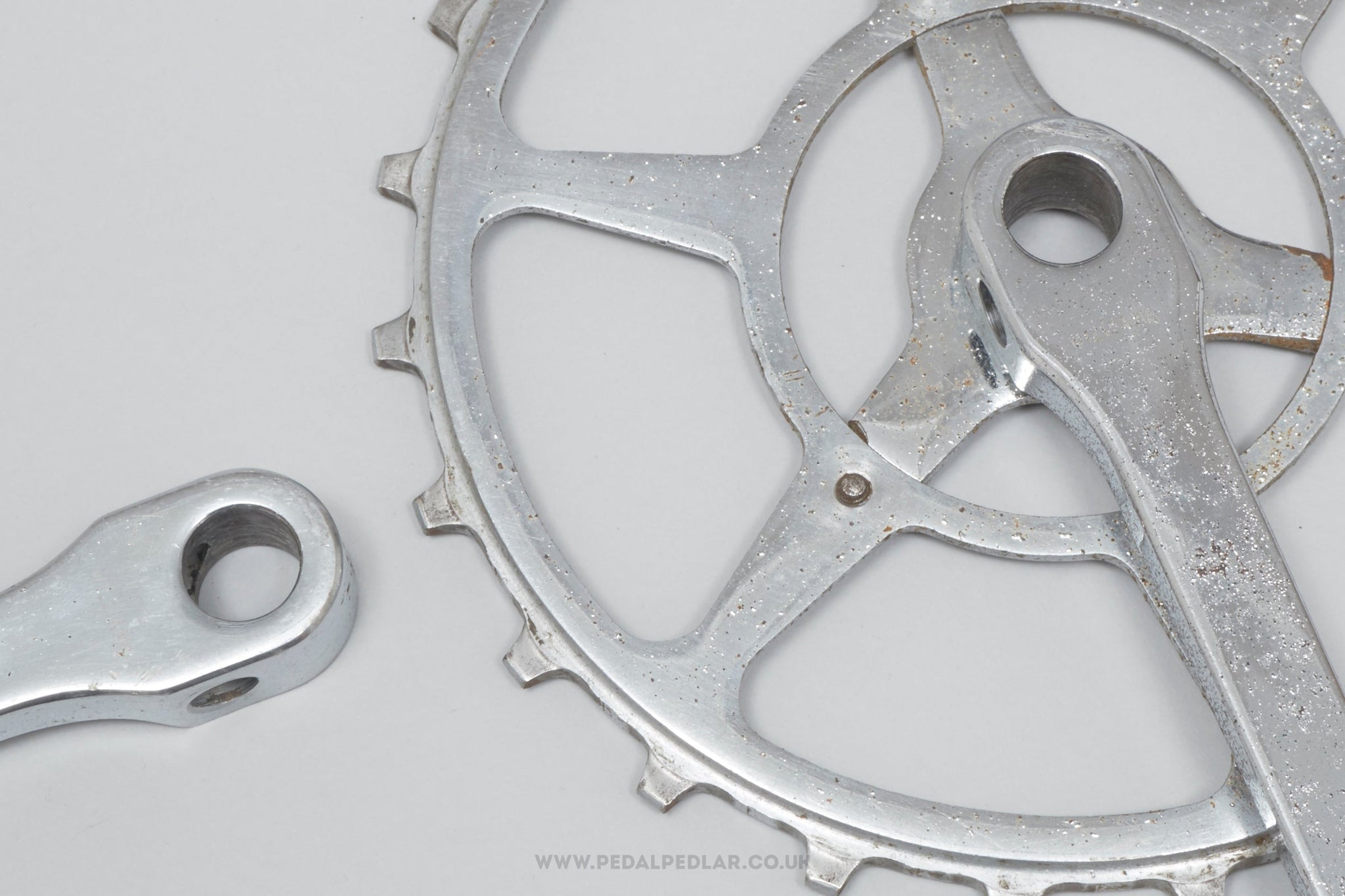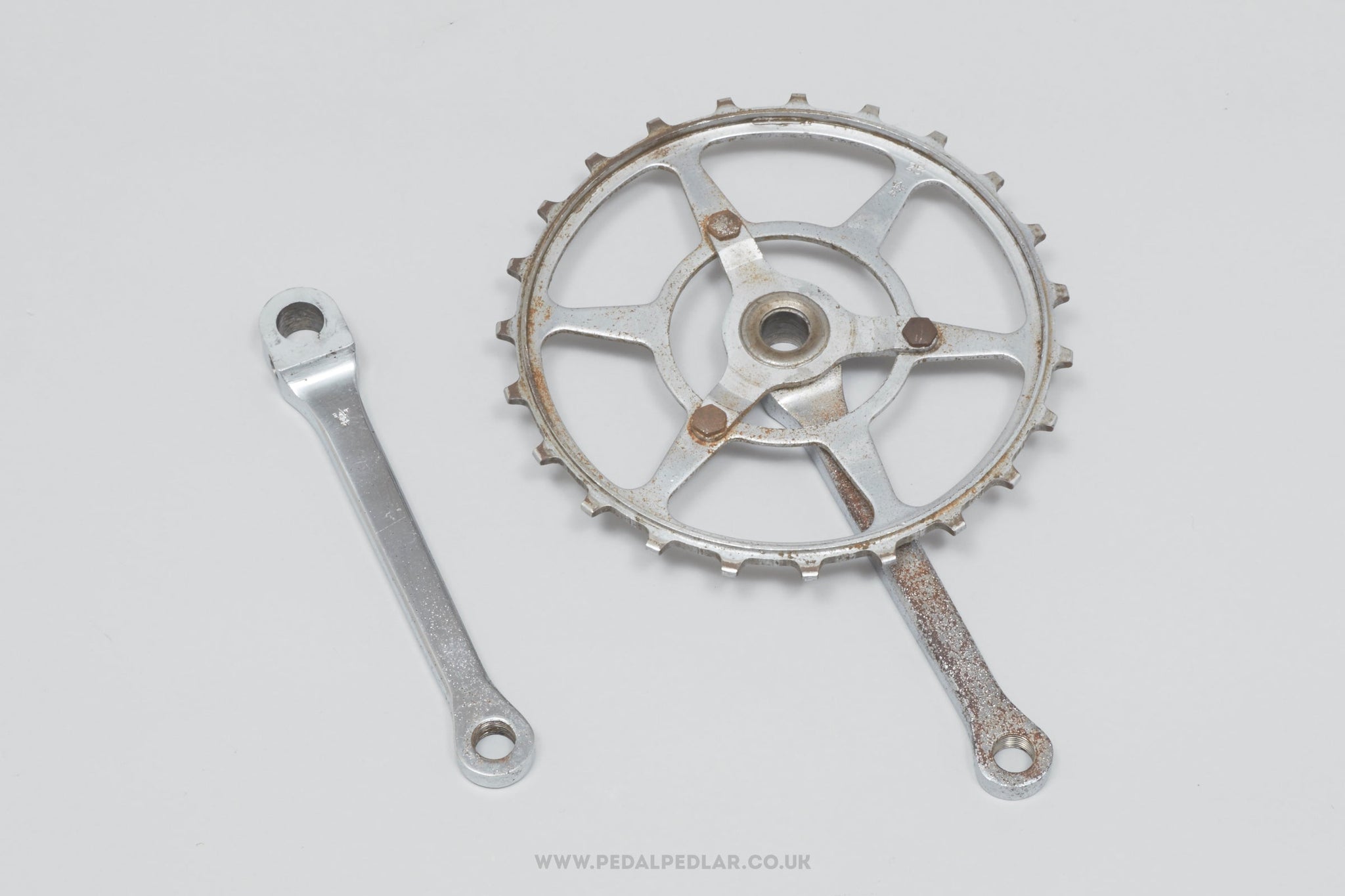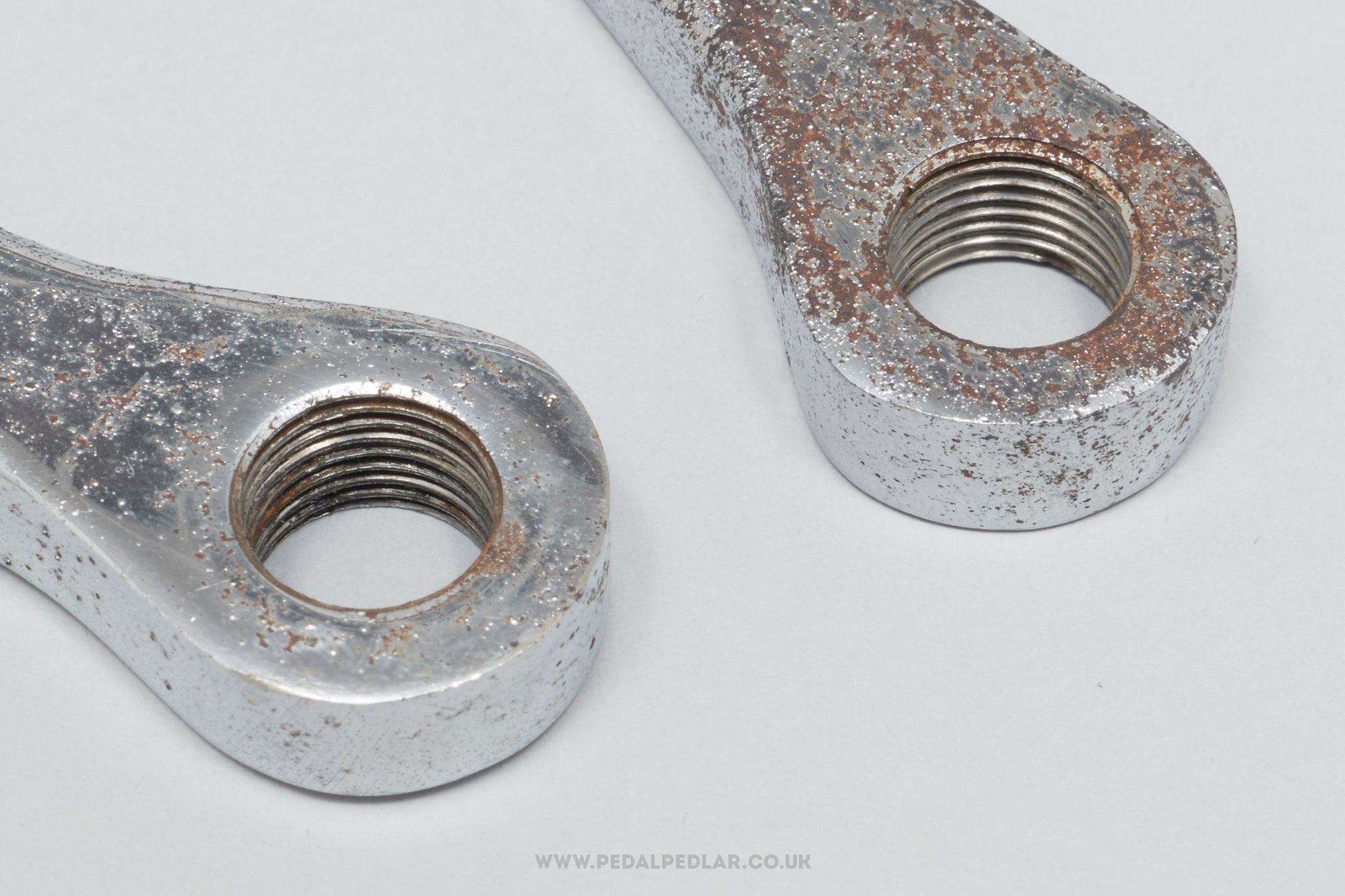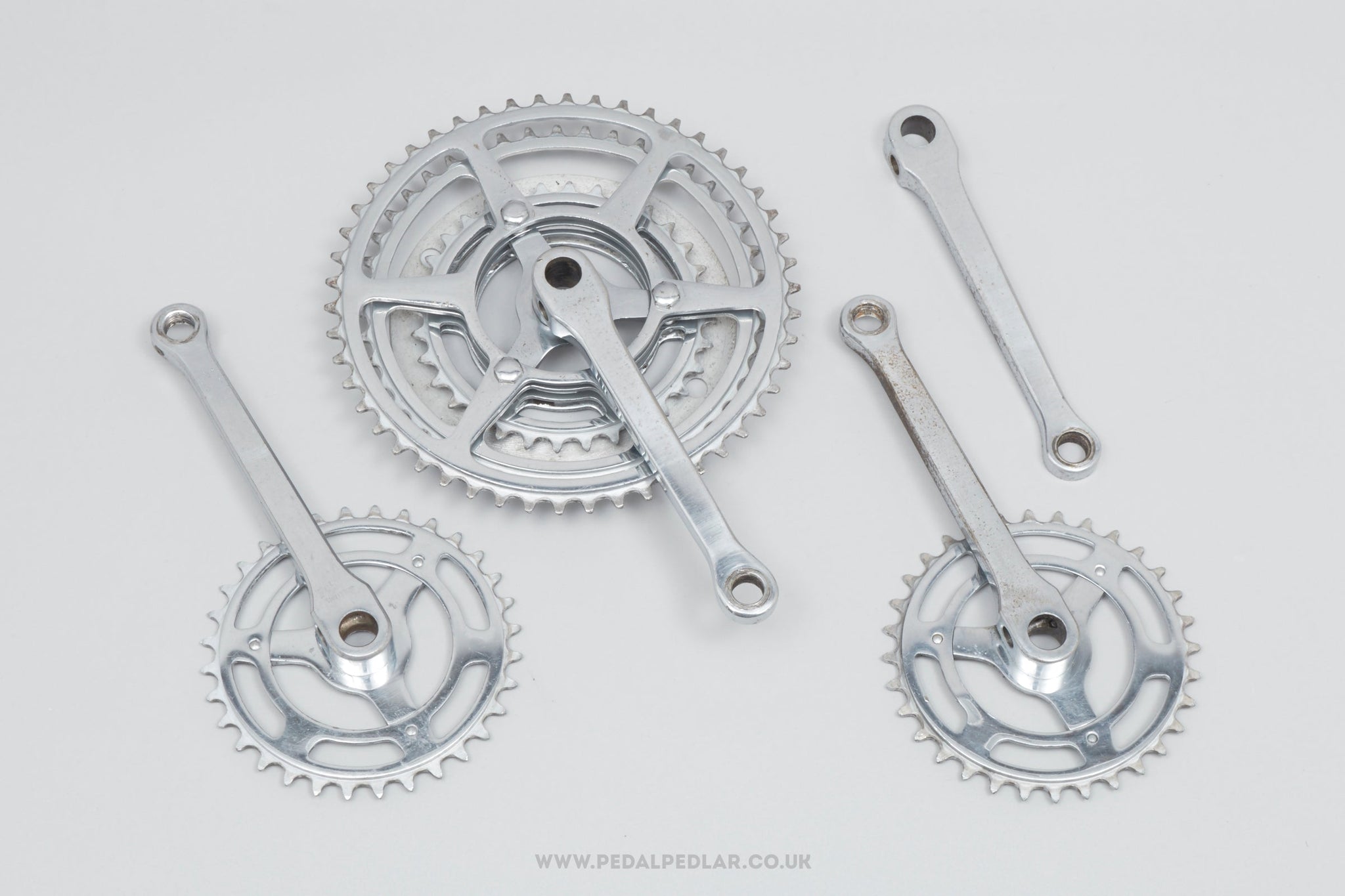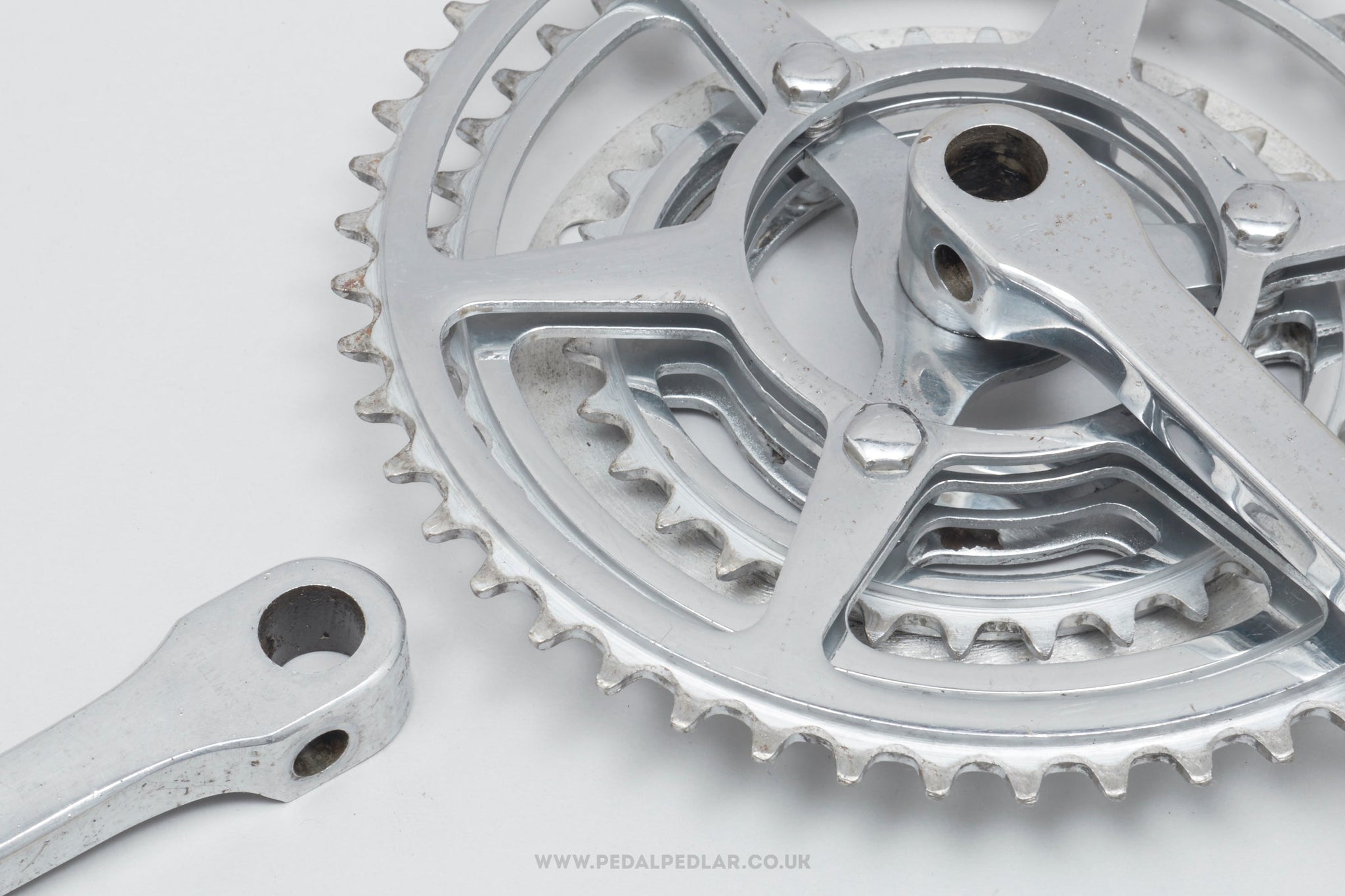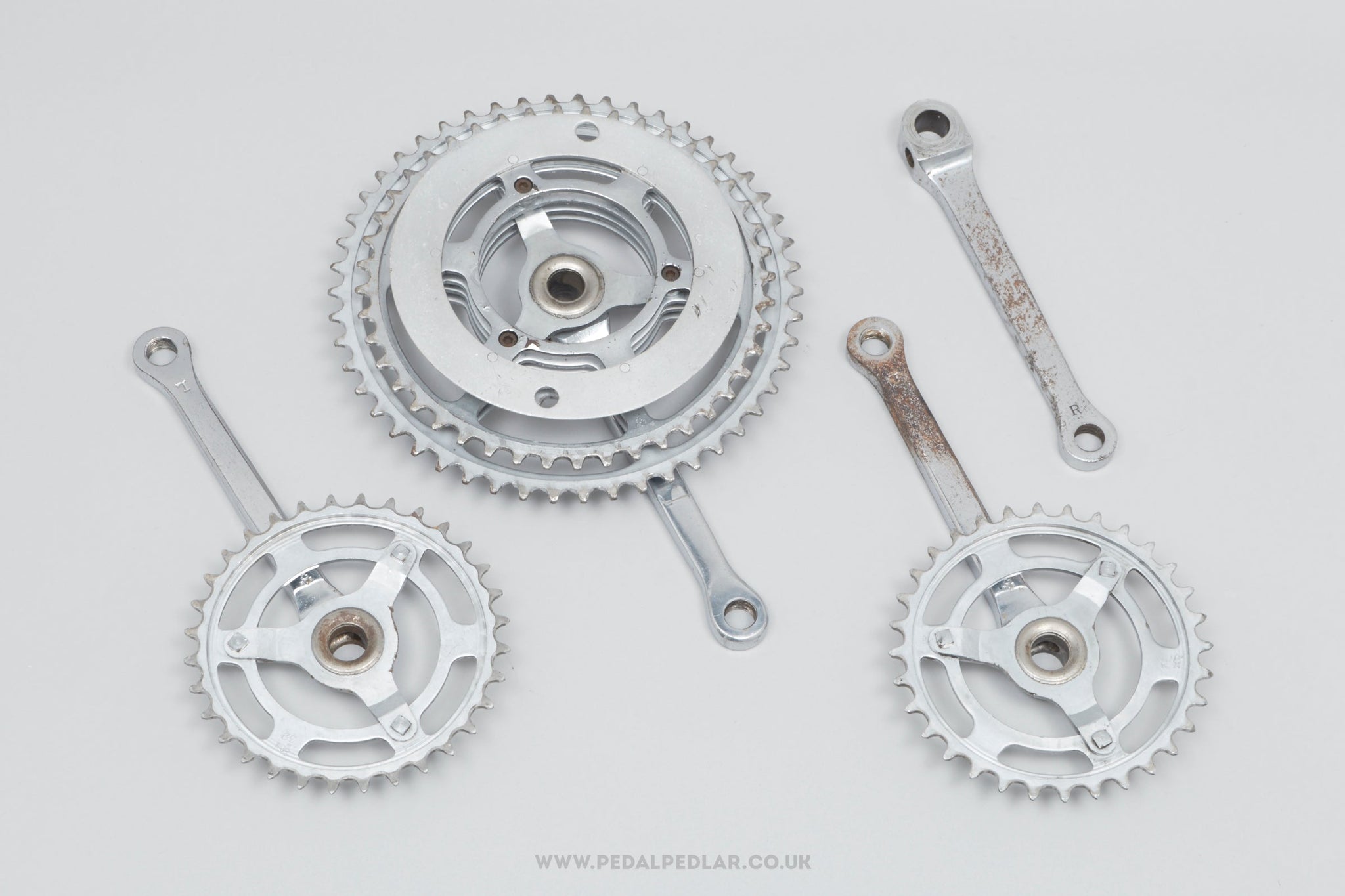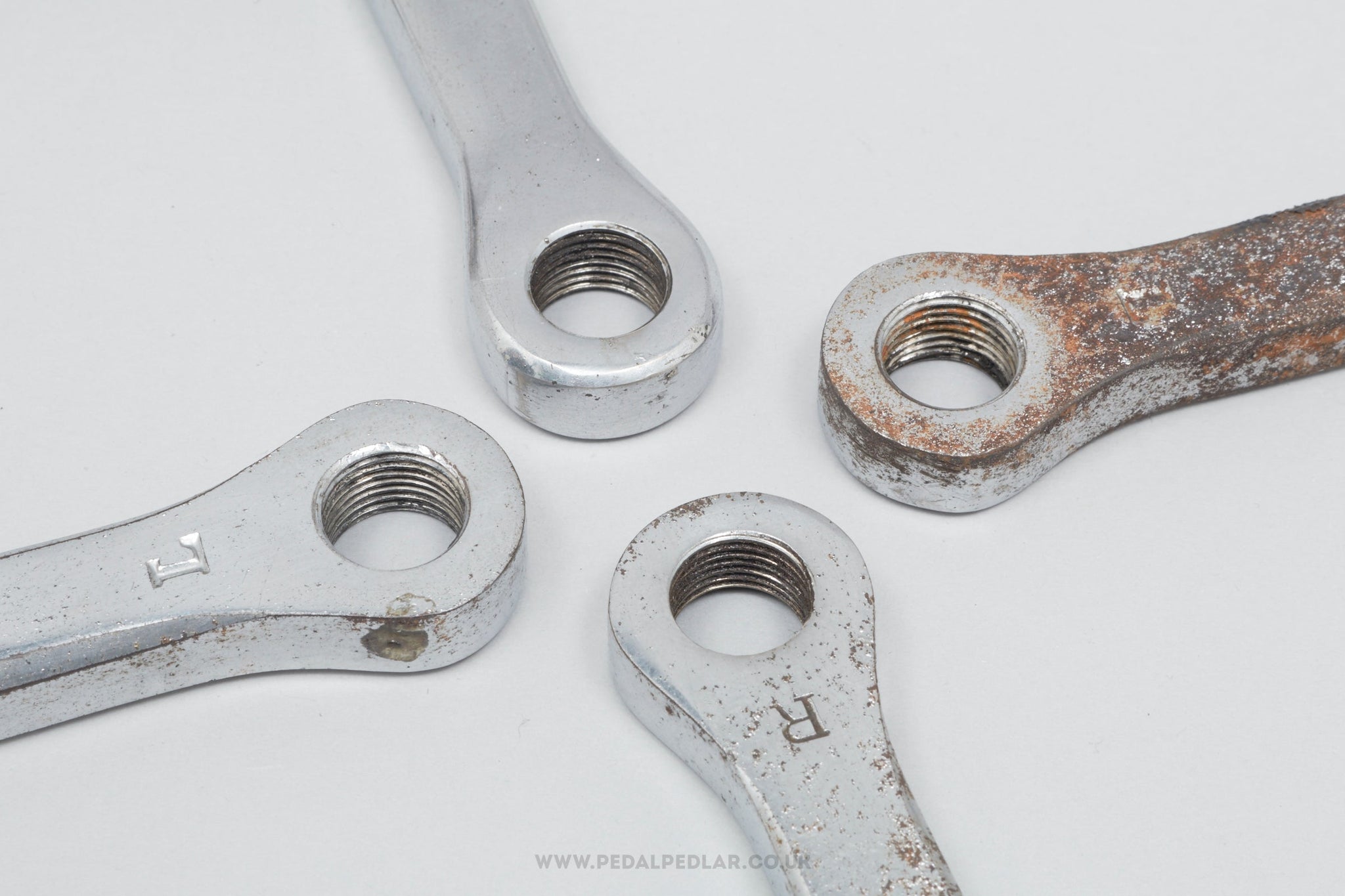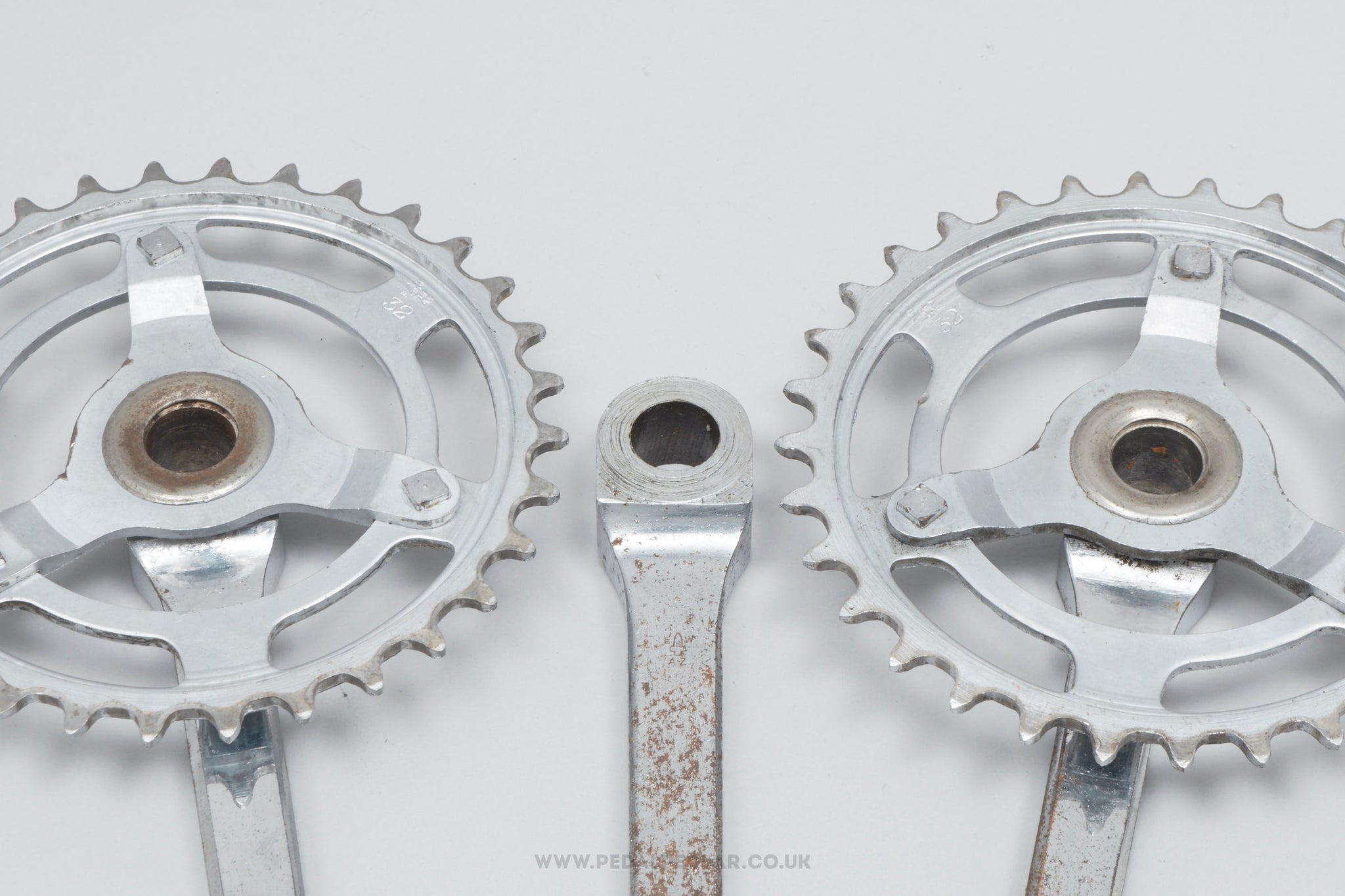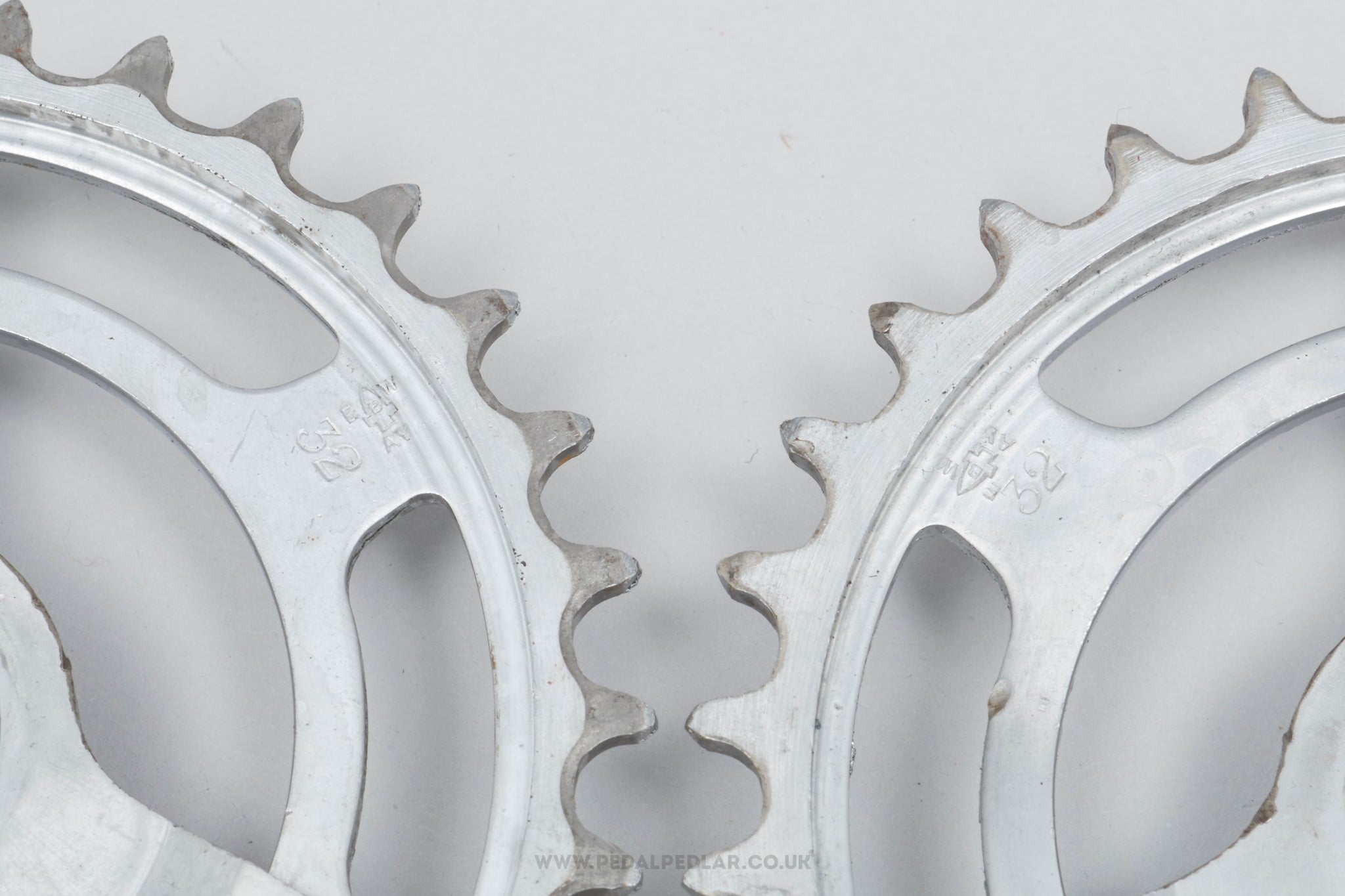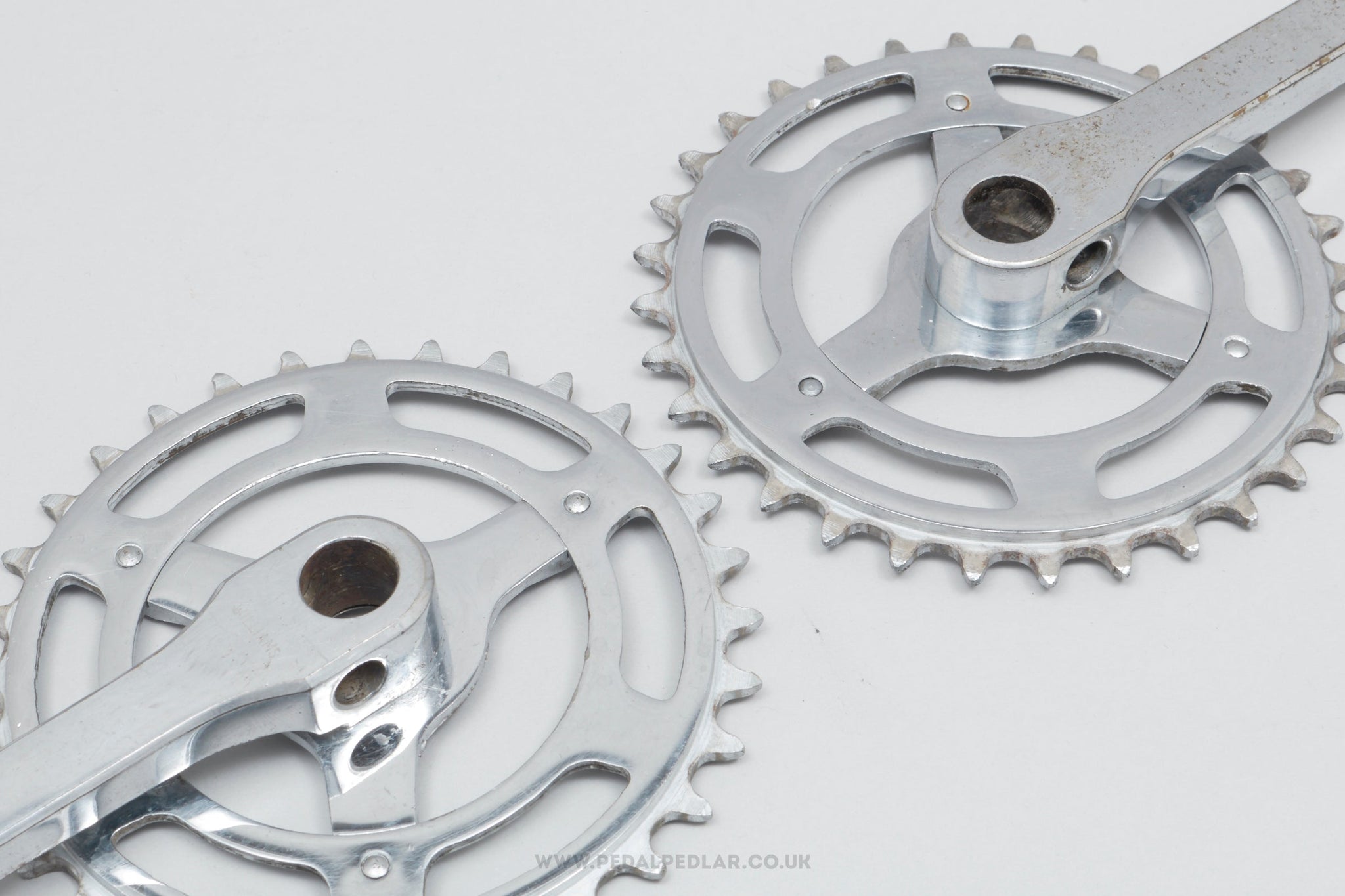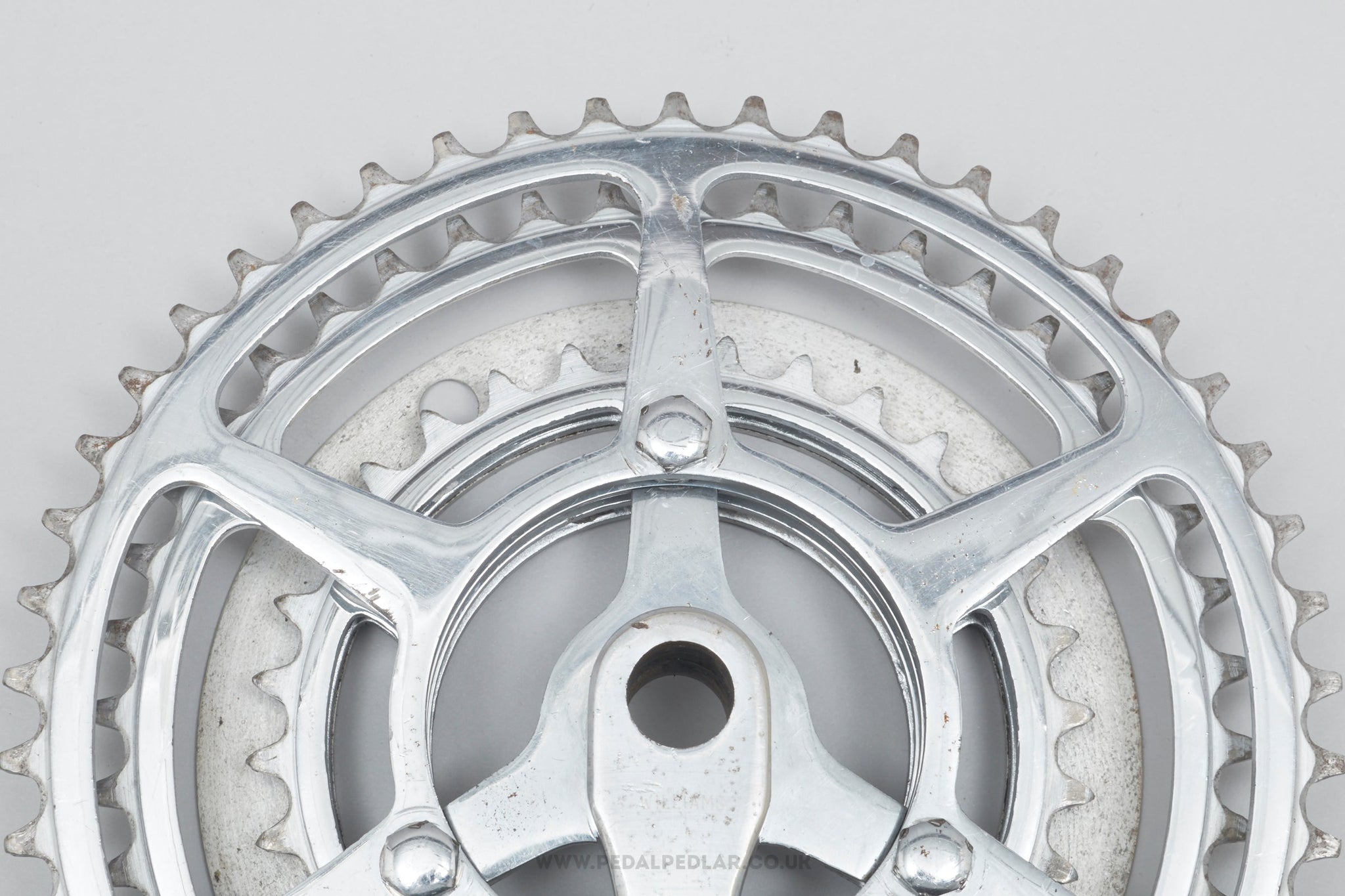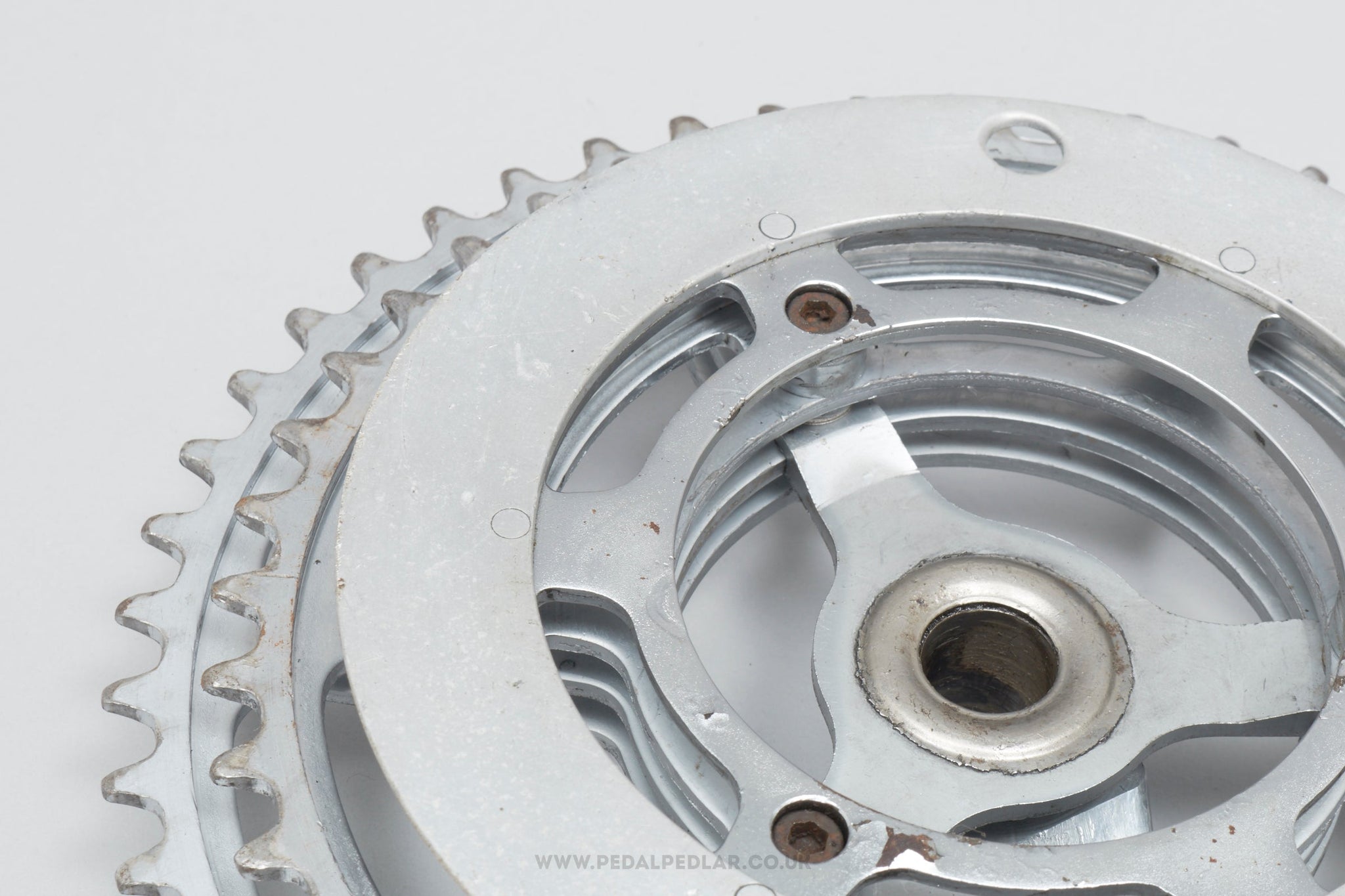- Sale
- Frames
- Wheels
-
Parts
- Drivetrain & Gearing
- Downtube Shifters
- Bar Shifters
- Shift/Brake Levers
- Front Derailleurs
- Rear Derailleurs
- Chainsets
- Crank Arms
- Crank Parts
- Bottom Brackets
- Bottom Bracket Parts
- Chainrings
- Freewheels
- Cassettes
- Chains
- Gear Parts
- Braking
- Brake Sets
- Brake Calipers
- Brake Cantilevers
- Brake Levers
- Brake Parts
- Clothing
- Accessories
- Journal
Chainsets
Campagnolo 50th Anniversary (0590) c.1983 Vintage Road Crank/Chainset
£355.50 £395.00
✓ Original part - produced in the 1980s
✓ Lightweight for the era - just 630 grams
✓ Suitable for historic cycling events such as L'Eroica
✓ Professionally checked & cleaned
✓ Worldwide shipping
Campagnolo 50th Anniversary crank/chainset, hailing from Italy and dating back to 1983. Made from aluminium and weighing in at 630 grams - pretty lightweight for a chainset at that time. A fine choice for keeping your vintage bike authentic, but also great for any other compatible bike too.
If you're taking part in L'Eroica or a similar vintage event, this is fully compliant - so rest assured, the pre-1987 police won't lock you up for having the wrong chainset!
The chainset's been carefully cleaned, thoroughly checked by one of our mechanics and graded as very good condition, but do take a good look at the detailed photos so you can see the cosmetic condition before you buy.OVERVIEW
Chainring Condition - Good
Model ID - 0590
Production Era - 1980s
Country - Italian
Material - Aluminium
Weight - 630 g
Stock Code - U-CS84V
NB - Inner chainring replaced with SR Royal drilled one
TECHNICAL INFO
Chainring Count - Double
Tooth Count - 53 / 46
Bottom Bracket Type - Square Taper
BCD - 144 BCD
Chain Width - 3/32" (Standard)
Crank Arm Length - 170 mm
Pedal Threads - Standard (9/16" x 20 TPI)
Intended Speed* - 6 Speed, 7 Speed
Bike Type* - Road
*See help section.
-
▼SHIPPING, TAXES & RETURNS
-
We've been safely sending orders around the world since 2010. There's a handy shipping calculator on the shopping cart page so you can see the cost of postage as soon as you've added it to your basket. Your order will be carefully packed and sent with tracking & insurance, we despatch most orders within 2-3 days but larger items and orders placed before the weekend can take an extra day or two to process.
We accept returns, please notify us within 14 days and ensure the item arrives back with us no later than 30 days after the order was received.
EU Customers – for orders under €150 (excluding shipping), VAT will be collected at checkout – no extra import fees to pay on delivery! For orders over €150 any import fees will be payable to the carrier before delivery.
USA Customers – import fees are now collected at checkout for all orders to the US, so there won’t be any surprise charges when your order arrives.
Other International Customers – local import fees may still apply, charged by your customs office or courier before delivery. These are not collected by us, so please check your local rates before purchasing.
Any applicable fees will appear at checkout. -
▼HELP SECTION
-
Chainring Count - the number of chainrings on the chainset. Fixed gear track bikes, single-speeds and some geared bikes use a single chainring, road bikes commonly use a double (two rings) and most touring bikes and mountain bikes will use a triple chainset (three rings).
Tooth count - the number of teeth on the chainring(s), the higher the number the harder the gear.
Chain width - this is only relevant for chainsets with a single chainring - if this is ⅛” then you must use a ⅛” chain. All double and triple (and some single) ring chainsets will use a standard 3/32” chain.
BCD - stands for Bolt Circle Diameter (sometimes referred to as PCD - Pitch Circle Diameter) and is only really needed when changing chainrings. To calculate the BCD, measure the distance in millimeters from the centre of any chainring bolt to the centre of an adjacent one and multiply it by 1.709 (you’ll likely need to round the resulting number up or down a little to get your BCD measurement).
*Intended speed - the number of cogs at the back the chainset was designed to be used with. We refer to it as ‘intended’ speed as most double and triple chainsets will actually work with different speeds than originally intended, but the further away you get from the intended speed the more likely you are to experience minor setup issues. The exception being some chainsets intended for 10 speed use or higher, with these it’s better to stick to the intended speed.
Crank arm length - this is measured from the absolute centre of the bottom bracket hole to the centre of the hole for the pedal.
Pedal threads - the thread type to match that of the chainset, this must match and is usually stamped on the pedals themselves and most bikes use a standard thread of 9/16” x 20 tpi. The exceptions being older French bikes, bikes with cheaper one-piece type chainsets and Shimano’s Dyna Drive system (easily identifiable as the pedal holes are about an inch wide!).
Bottom bracket type - ‘square taper’, as the name suggests have a square shaped axle that slots into the chainset and ‘cottered’ axles are round and secured by pins - pretty much every bike up until the 1990s would use one of these, cottered being the much earlier system. Since then, different manufacturers have introduced their own systems that are not interchangeable so you must use a chainset that matches.
Campagnolo C-Record (A040) 2nd Type c.1990/91 Classic 172.5 mm Road Chainset
£265.00
✓ Original part - produced in the 1990s
✓ Professionally checked & cleaned
✓ Worldwide shipping
Campagnolo C-Record chainset (or crankset, if you prefer), hailing from Italy and dating back to 1990/91. Made from aluminium and weighing in at 711 grams - pretty lightweight for a chainset at that time. A fine choice for keeping your classic bike authentic, but also great for any other compatible bike.
The chainset's been carefully cleaned, thoroughly checked by one of our mechanics and graded as very good condition, but do take a good look at the detailed photos so you can see the cosmetic condition before you buy.OVERVIEW
Chainring Condition - OK
Model ID - A040
Production Era - 1990s
Country - Italian
Material - Aluminium
Weight - 711 g
Stock Code - U-G3-CS142C
TECHNICAL INFO
Chainring Count - Double
Tooth Count - 50 / 42
Bottom Bracket Type - Square Taper
BCD - 135 BCD
Crank Arm Length - 172.5 mm
Chain Width - 3/32" (Standard)
Pedal Threads - Standard (9/16" x 20 TPI)
Intended Speed* - 7 Speed, 8 Speed
Bike Type* - Road
Matching Bottom Bracket(s)* - Campagnolo - C-Record (A0H0) - 111 mm
*See help section.
-
▼SHIPPING, TAXES & RETURNS
-
We've been safely sending orders around the world since 2010. There's a handy shipping calculator on the shopping cart page so you can see the cost of postage as soon as you've added it to your basket. Your order will be carefully packed and sent with tracking & insurance, we despatch most orders within 2-3 days but larger items and orders placed before the weekend can take an extra day or two to process.
We accept returns, please notify us within 14 days and ensure the item arrives back with us no later than 30 days after the order was received.
EU Customers – for orders under €150 (excluding shipping), VAT will be collected at checkout – no extra import fees to pay on delivery! For orders over €150 any import fees will be payable to the carrier before delivery.
USA Customers – import fees are now collected at checkout for all orders to the US, so there won’t be any surprise charges when your order arrives.
Other International Customers – local import fees may still apply, charged by your customs office or courier before delivery. These are not collected by us, so please check your local rates before purchasing.
Any applicable fees will appear at checkout. -
▼SAFETY & COMPLIANCE
- This product complies with the EU General Product Safety Regulation (GPSR). Professional installation and regular inspections are recommended. Due to the product's age, extra care should be taken during use.
Product Manufacturer - CAMPAGNOLO Srl, Via della Chimica 4, 36100, Vicenza, Italy
EU Authorised Representative - Global Trade Department NI Ltd, Office 834, Unit 6, 100 Lisburn Road, Belfast BT9 6AG, Northern Ireland
-
▼HELP SECTION
-
Chainring Count - the number of chainrings on the chainset. Fixed gear track bikes, single-speeds and some geared bikes use a single chainring, road bikes commonly use a double (two rings) and most touring bikes and mountain bikes will use a triple chainset (three rings).
Tooth Count - the number of teeth on the chainring(s), the higher the number the harder the gear.
Bottom Bracket Type - ‘square taper’, as the name suggests have a square shaped axle that slots into the chainset and ‘cottered’ axles are round and secured by pins - pretty much every bike up until the 1990s would use one of these, cottered being the much earlier system. Since then, different manufacturers have introduced their own systems that are not interchangeable so you must use a chainset that matches.
BCD - stands for Bolt Circle Diameter (sometimes referred to as PCD - Pitch Circle Diameter) and is only really needed when changing chainrings. To calculate the BCD, measure the distance in millimeters from the centre of any chainring bolt to the centre of an adjacent one and multiply it by 1.709 (you’ll likely need to round the resulting number up or down a little to get your BCD measurement).
Crank Arm Length - this is measured from the absolute centre of the bottom bracket hole to the centre of the hole for the pedal.
Chain Width - this is mostly only relevant for chainsets with a single chainring - if this is ⅛” then you must use a ⅛” chain. Almost all double and triple (and some single) ring chainsets will use a standard 3/32” chain, the only exception being old chainsets designed for 3 or 4 speed freewheels.
Pedal Threads - this must match the thread of your pedals and is usually stamped on the pedals themselves, most bikes use a standard thread of 9/16” x 20 tpi. The exceptions being older French bikes, bikes with cheaper one-piece type chainsets and Shimano’s Dyna Drive system (easily identifiable as the pedal holes are about an inch wide!).
*Intended Speed - the number of cogs at the back the chainset was designed to be used with. We refer to it as ‘intended’ speed as most double and triple chainsets will actually work with different speeds than originally intended, but the further away you get from the intended speed the more likely you are to experience minor setup issues. The exception being some chainsets intended for 10 speed use or higher, with these it’s better to stick to the intended speed.
*Bike Type - this is just a guide, any chainset can technically be used on any bike as long as everything's compatible.
*Matching Bottom Bracket(s) - if known, based on standard rear spacing of the period. For square tapers, ISO and JIS standards were introduced in the early 1990s; earlier cranks were designed to fit the proprietary taper. Alternatives can achieve the same chainline and clearance if the axle has the same taper and dimensions, and sticking to the same manufacturer and era will help. Mixing tapers is not recommended, as it can damage the cranks.
NB: “ITA” refers to Italian-threaded frames (70 mm BB shell).
Campagnolo C-Record (A040) 2nd Type c.1994 Classic Chainset
£233.75 £275.00
✓ Original part - produced in the 1990s
✓ Lightweight for the era - just 710 grams
✓ Professionally checked & cleaned
✓ Worldwide shipping
Campagnolo C-Record chainset, hailing from Italy and dating back to 1994. Made from aluminium and weighing in at 710 grams - pretty lightweight for a chainset at that time. A fine choice for keeping your classic bike authentic, but also great for any other compatible bike too.
The chainset's been carefully cleaned, thoroughly checked by one of our mechanics and graded as good condition, but do take a good look at the detailed photos so you can see the cosmetic condition before you buy.OVERVIEW
Chainring Condition - Good
Model ID - A040
Production Era - 1990s
Country - Italian
Material - Aluminium
Weight - 710 g
Stock Code - U-CS73C
TECHNICAL INFO
Chainring Count - Double
Tooth Count - 53 / 39
Chain Width - 3/32" (Standard)
BCD - 135 BCD
Intended Speed* - 8 Speed
Crank Arm Length - 175 mm
Pedal Threads - Standard (9/16" x 20 TPI)
Bottom Bracket Type - Square Taper
*See help section.
-
▼SHIPPING, TAXES & RETURNS
-
We've been safely sending orders around the world since 2010. There's a handy shipping calculator on the shopping cart page so you can see the cost of postage as soon as you've added it to your basket. Your order will be carefully packed and sent with tracking & insurance, we despatch most orders within 2-3 days but larger items and orders placed before the weekend can take an extra day or two to process.
We accept returns, please notify us within 14 days and ensure the item arrives back with us no later than 30 days after the order was received.
EU Customers – for orders under €150 (excluding shipping), VAT will be collected at checkout – no extra import fees to pay on delivery! For orders over €150 any import fees will be payable to the carrier before delivery.
USA Customers – import fees are now collected at checkout for all orders to the US, so there won’t be any surprise charges when your order arrives.
Other International Customers – local import fees may still apply, charged by your customs office or courier before delivery. These are not collected by us, so please check your local rates before purchasing.
Any applicable fees will appear at checkout. -
▼HELP SECTION
-
Chainring count - the number of chainrings on the chainset. Fixed gear track bikes, single-speeds and some geared bikes use a single chainring, road bikes commonly use a double (two rings) and most touring bikes and mountain bikes will use a triple chainset (three rings).
Tooth count - the number of teeth on the chainring(s), the higher the number the harder the gear.
Chain width - this is only relevant for chainsets with a single chainring - if this is ⅛” then you must use a ⅛” chain. All double and triple (and some single) ring chainsets will use a standard 3/32” chain.
BCD - stands for Bolt Circle Diameter (sometimes referred to as PCD - Pitch Circle Diameter) and is only really needed when changing chainrings. To calculate the BCD, measure the distance in millimeters from the centre of any chainring bolt to the centre of an adjacent one and multiply it by 1.709 (you’ll likely need to round the resulting number up or down a little to get your BCD measurement).
*Intended speed - the number of cogs at the back the chainset was designed to be used with. We refer to it as ‘intended’ speed as most double and triple chainsets will actually work with different speeds than originally intended, but the further away you get from the intended speed the more likely you are to experience minor setup issues. The exception being some chainsets intended for 10 speed use or higher, with these it’s better to stick to the intended speed.
Crank arm length - this is measured from the absolute centre of the bottom bracket hole to the centre of the hole for the pedal.
Pedal threads - the thread type to match that of the chainset, this must match and is usually stamped on the pedals themselves and most bikes use a standard thread of 9/16” x 20 tpi. The exceptions being older French bikes, bikes with cheaper one-piece type chainsets and Shimano’s Dyna Drive system (easily identifiable as the pedal holes are about an inch wide!).
Bottom bracket type - ‘square taper’, as the name suggests have a square shaped axle that slots into the chainset and ‘cottered’ axles are round and secured by pins - pretty much every bike up until the 1990s would use one of these, cottered being the much earlier system. Since then, different manufacturers have introduced their own systems that are not interchangeable so you must use a chainset that matches.
Campagnolo C-Record (A040) 2nd Type Vintage 170 mm Road Chainset
£175.00
✓ Original part - in production from the 1980s to the 1990s
✓ Suitable for historic cycling events such as L'Eroica
✓ Professionally checked & cleaned
✓ Worldwide shipping
Campagnolo C-Record chainset (or crankset, if you prefer), hailing from Italy and in production from the 1980s to the 1990s. Made from aluminium and weighing in at 675 grams - pretty lightweight for a chainset at that time. A fine choice for keeping your vintage bike authentic, but also great for any other compatible bike.
If you're taking part in L'Eroica or a similar vintage event, this is fully compliant - so rest assured, the pre-1987 police won't lock you up for having the wrong chainset!
The chainset's been carefully cleaned, thoroughly checked by one of our mechanics and graded as OK condition, but do take a good look at the detailed photos so you can see the cosmetic condition before you buy.OVERVIEW
Chainring Condition - Good
Model ID - A040
Production Era - 1980s & 1990s
Country - Italian
Material - Aluminium
Weight - 675 g
Stock Code - U-G3-CS136V
TECHNICAL INFO
Chainring Count - Double
Tooth Count - 53 / 39
Bottom Bracket Type - Square Taper
BCD - 135 BCD
Crank Arm Length - 170 mm
Chain Width - 3/32" (Standard)
Pedal Threads - Standard (9/16" x 20 TPI)
Intended Speed* - 8 Speed
Bike Type* - Road
*See help section.
-
▼SHIPPING, TAXES & RETURNS
-
We've been safely sending orders around the world since 2010. There's a handy shipping calculator on the shopping cart page so you can see the cost of postage as soon as you've added it to your basket. Your order will be carefully packed and sent with tracking & insurance, we despatch most orders within 2-3 days but larger items and orders placed before the weekend can take an extra day or two to process.
We accept returns, please notify us within 14 days and ensure the item arrives back with us no later than 30 days after the order was received.
EU Customers – for orders under €150 (excluding shipping), VAT will be collected at checkout – no extra import fees to pay on delivery! For orders over €150 any import fees will be payable to the carrier before delivery.
USA Customers – import fees are now collected at checkout for all orders to the US, so there won’t be any surprise charges when your order arrives.
Other International Customers – local import fees may still apply, charged by your customs office or courier before delivery. These are not collected by us, so please check your local rates before purchasing.
Any applicable fees will appear at checkout. -
▼SAFETY & COMPLIANCE
- This product complies with the EU General Product Safety Regulation (GPSR). Professional installation and regular inspections are recommended. Due to the product's age, extra care should be taken during use.
Product Manufacturer - CAMPAGNOLO Srl, Via della Chimica 4, 36100, Vicenza, Italy
EU Authorised Representative - Global Trade Department NI Ltd, Office 834, Unit 6, 100 Lisburn Road, Belfast BT9 6AG, Northern Ireland
-
▼HELP SECTION
-
Chainring Count - the number of chainrings on the chainset. Fixed gear track bikes, single-speeds and some geared bikes use a single chainring, road bikes commonly use a double (two rings) and most touring bikes and mountain bikes will use a triple chainset (three rings).
Tooth Count - the number of teeth on the chainring(s), the higher the number the harder the gear.
Bottom Bracket Type - ‘square taper’, as the name suggests have a square shaped axle that slots into the chainset and ‘cottered’ axles are round and secured by pins - pretty much every bike up until the 1990s would use one of these, cottered being the much earlier system. Since then, different manufacturers have introduced their own systems that are not interchangeable so you must use a chainset that matches.
BCD - stands for Bolt Circle Diameter (sometimes referred to as PCD - Pitch Circle Diameter) and is only really needed when changing chainrings. To calculate the BCD, measure the distance in millimeters from the centre of any chainring bolt to the centre of an adjacent one and multiply it by 1.709 (you’ll likely need to round the resulting number up or down a little to get your BCD measurement).
Crank Arm Length - this is measured from the absolute centre of the bottom bracket hole to the centre of the hole for the pedal.
Chain Width - this is mostly only relevant for chainsets with a single chainring - if this is ⅛” then you must use a ⅛” chain. Almost all double and triple (and some single) ring chainsets will use a standard 3/32” chain, the only exception being old chainsets designed for 3 or 4 speed freewheels.
Pedal Threads - this must match the thread of your pedals and is usually stamped on the pedals themselves, most bikes use a standard thread of 9/16” x 20 tpi. The exceptions being older French bikes, bikes with cheaper one-piece type chainsets and Shimano’s Dyna Drive system (easily identifiable as the pedal holes are about an inch wide!).
*Intended Speed - the number of cogs at the back the chainset was designed to be used with. We refer to it as ‘intended’ speed as most double and triple chainsets will actually work with different speeds than originally intended, but the further away you get from the intended speed the more likely you are to experience minor setup issues. The exception being some chainsets intended for 10 speed use or higher, with these it’s better to stick to the intended speed.
*Bike Type - this is just a guide, any chainset can technically be used on any bike as long as everything's compatible.
Campagnolo Centaur Ultra Drive Century Grey 10 Speed NOS Classic 170 mm Road Chainset
£166.25 £175.00
✓ Original part - produced in the 2000s
✓ New old stock! Still unused after all these years
✓ Lightweight for the era - just 659 grams
✓ Worldwide shipping
Campagnolo Centaur chainset (or crankset, if you prefer), hailing from Italy and in production during the 2000s. Made from aluminium and weighing in at 659 grams - pretty lightweight for a chainset at that time. A fine choice for keeping your classic bike authentic, but also great for any other compatible bike.
OVERVIEW
Chainring Condition - New Old Stock*
Production Era - 2000s
Country - Italian
Material - Aluminium
Weight - 659 g
Stock Code - D-CS114C
*New old stock items may have marks from storage over the years, and as we often have multiples they can vary from piece to piece, but they are always genuine new & unused items.
TECHNICAL INFO
Chainring Count - Double
Tooth Count - 52 / 39
Bottom Bracket Type - Square Taper
BCD - 135 BCD
Crank Arm Length - 170 mm
Chain Width - 3/32" (Standard)
Pedal Threads - Standard (9/16" x 20 TPI)
Intended Speed* - 10 Speed
Bike Type* - Road
*See help section.
-
▼SHIPPING, TAXES & RETURNS
-
We've been safely sending orders around the world since 2010. There's a handy shipping calculator on the shopping cart page so you can see the cost of postage as soon as you've added it to your basket. Your order will be carefully packed and sent with tracking & insurance, we despatch most orders within 2-3 days but larger items and orders placed before the weekend can take an extra day or two to process.
We accept returns, please notify us within 14 days and ensure the item arrives back with us no later than 30 days after the order was received.
EU Customers – for orders under €150 (excluding shipping), VAT will be collected at checkout – no extra import fees to pay on delivery! For orders over €150 any import fees will be payable to the carrier before delivery.
USA Customers – import fees are now collected at checkout for all orders to the US, so there won’t be any surprise charges when your order arrives.
Other International Customers – local import fees may still apply, charged by your customs office or courier before delivery. These are not collected by us, so please check your local rates before purchasing.
Any applicable fees will appear at checkout. -
▼HELP SECTION
-
Chainring Count - the number of chainrings on the chainset. Fixed gear track bikes, single-speeds and some geared bikes use a single chainring, road bikes commonly use a double (two rings) and most touring bikes and mountain bikes will use a triple chainset (three rings).
Tooth Count - the number of teeth on the chainring(s), the higher the number the harder the gear.
Bottom Bracket Type - ‘square taper’, as the name suggests have a square shaped axle that slots into the chainset and ‘cottered’ axles are round and secured by pins - pretty much every bike up until the 1990s would use one of these, cottered being the much earlier system. Since then, different manufacturers have introduced their own systems that are not interchangeable so you must use a chainset that matches.
BCD - stands for Bolt Circle Diameter (sometimes referred to as PCD - Pitch Circle Diameter) and is only really needed when changing chainrings. To calculate the BCD, measure the distance in millimeters from the centre of any chainring bolt to the centre of an adjacent one and multiply it by 1.709 (you’ll likely need to round the resulting number up or down a little to get your BCD measurement).
Crank Arm Length - this is measured from the absolute centre of the bottom bracket hole to the centre of the hole for the pedal.
Chain Width - this is mostly only relevant for chainsets with a single chainring - if this is ⅛” then you must use a ⅛” chain. Almost all double and triple (and some single) ring chainsets will use a standard 3/32” chain, the only exception being old chainsets designed for 3 or 4 speed freewheels.
Pedal Threads - this must match the thread of your pedals and is usually stamped on the pedals themselves, most bikes use a standard thread of 9/16” x 20 tpi. The exceptions being older French bikes, bikes with cheaper one-piece type chainsets and Shimano’s Dyna Drive system (easily identifiable as the pedal holes are about an inch wide!).
*Intended Speed - the number of cogs at the back the chainset was designed to be used with. We refer to it as ‘intended’ speed as most double and triple chainsets will actually work with different speeds than originally intended, but the further away you get from the intended speed the more likely you are to experience minor setup issues. The exception being some chainsets intended for 10 speed use or higher, with these it’s better to stick to the intended speed.
*Bike Type - this is just a guide, any chainset can technically be used on any bike as long as everything's compatible.
Campagnolo Centaur Ultra Drive Silver NOS Classic 172.5 mm Road Chainset
£165.00
✓ Original part - produced in the 2000s
✓ New old stock! Still unused after all these years
✓ Lightweight for the era - just 653 grams
✓ Worldwide shipping
Campagnolo Centaur chainset (or crankset, if you prefer), hailing from Italy and in production during the 2000s. Made from aluminium and weighing in at 653 grams - pretty lightweight for a chainset at that time. A fine choice for keeping your classic bike authentic, but also great for any other compatible bike.
OVERVIEW
Chainring Condition - New Old Stock*
Production Era - 2000s
Country - Italian
Material - Aluminium
Weight - 653 g
Stock Code - D-CS111C
*New old stock items may have marks from storage over the years, and as we often have multiples they can vary from piece to piece, but they are always genuine new & unused items.
TECHNICAL INFO
Chainring Count - Double
Tooth Count - 53 / 39
Bottom Bracket Type - Square Taper
BCD - 135 BCD
Crank Arm Length - 172.5 mm
Chain Width - 11/28"
Pedal Threads - Standard (9/16" x 20 TPI)
Intended Speed* - 10 Speed
Bike Type* - Road
*See help section.
-
▼SHIPPING, TAXES & RETURNS
-
We've been safely sending orders around the world since 2010. There's a handy shipping calculator on the shopping cart page so you can see the cost of postage as soon as you've added it to your basket. Your order will be carefully packed and sent with tracking & insurance, we despatch most orders within 2-3 days but larger items and orders placed before the weekend can take an extra day or two to process.
We accept returns, please notify us within 14 days and ensure the item arrives back with us no later than 30 days after the order was received.
EU Customers – for orders under €150 (excluding shipping), VAT will be collected at checkout – no extra import fees to pay on delivery! For orders over €150 any import fees will be payable to the carrier before delivery.
USA Customers – import fees are now collected at checkout for all orders to the US, so there won’t be any surprise charges when your order arrives.
Other International Customers – local import fees may still apply, charged by your customs office or courier before delivery. These are not collected by us, so please check your local rates before purchasing.
Any applicable fees will appear at checkout. -
▼HELP SECTION
-
Chainring Count - the number of chainrings on the chainset. Fixed gear track bikes, single-speeds and some geared bikes use a single chainring, road bikes commonly use a double (two rings) and most touring bikes and mountain bikes will use a triple chainset (three rings).
Tooth Count - the number of teeth on the chainring(s), the higher the number the harder the gear.
Bottom Bracket Type - ‘square taper’, as the name suggests have a square shaped axle that slots into the chainset and ‘cottered’ axles are round and secured by pins - pretty much every bike up until the 1990s would use one of these, cottered being the much earlier system. Since then, different manufacturers have introduced their own systems that are not interchangeable so you must use a chainset that matches.
BCD - stands for Bolt Circle Diameter (sometimes referred to as PCD - Pitch Circle Diameter) and is only really needed when changing chainrings. To calculate the BCD, measure the distance in millimeters from the centre of any chainring bolt to the centre of an adjacent one and multiply it by 1.709 (you’ll likely need to round the resulting number up or down a little to get your BCD measurement).
Crank Arm Length - this is measured from the absolute centre of the bottom bracket hole to the centre of the hole for the pedal.
Chain Width - this is mostly only relevant for chainsets with a single chainring - if this is ⅛” then you must use a ⅛” chain. Almost all double and triple (and some single) ring chainsets will use a standard 3/32” chain, the only exception being old chainsets designed for 3 or 4 speed freewheels.
Pedal Threads - this must match the thread of your pedals and is usually stamped on the pedals themselves, most bikes use a standard thread of 9/16” x 20 tpi. The exceptions being older French bikes, bikes with cheaper one-piece type chainsets and Shimano’s Dyna Drive system (easily identifiable as the pedal holes are about an inch wide!).
*Intended Speed - the number of cogs at the back the chainset was designed to be used with. We refer to it as ‘intended’ speed as most double and triple chainsets will actually work with different speeds than originally intended, but the further away you get from the intended speed the more likely you are to experience minor setup issues. The exception being some chainsets intended for 10 speed use or higher, with these it’s better to stick to the intended speed.
*Bike Type - this is just a guide, any chainset can technically be used on any bike as long as everything's compatible.
Campagnolo Chorus (706/101) c.1988 Vintage Chainset
£72.25 £85.00
✓ Original part - in production from the 1980s to the 1990s
✓ Lightweight for the era - just 674 grams
✓ Professionally checked & cleaned
✓ Worldwide shipping
Campagnolo Chorus chainset, hailing from Italy and dating back to 1988. Made from aluminium and weighing in at 674 grams - pretty lightweight for a chainset at that time. A fine choice for keeping your vintage bike authentic, but also great for any other compatible bike too.
The chainset's been carefully cleaned, thoroughly checked by one of our mechanics and graded as very good condition, but do take a good look at the detailed photos so you can see the cosmetic condition before you buy.OVERVIEW
Chainring Condition - OK
Condition Notes - Inner ring is very worn
Model ID - 706/101
Production Era - 1980s & 1990s
Country - Italian
Material - Aluminium
Weight - 674 g
Stock Code - U-CS46V
TECHNICAL INFO
Chainring Count - Double
Tooth Count - 53 / 42
Chain Width - 3/32"
BCD - 135 BCD
Intended Speed* - 5 Speed, 6 Speed, 7 Speed
Crank Arm Length - 172.5 mm
Pedal Threads - Standard (9/16" x 20 TPI)
Bottom Bracket Type - Square Taper
*See help section.
-
▼SHIPPING, TAXES & RETURNS
-
We've been safely sending orders around the world since 2010. There's a handy shipping calculator on the shopping cart page so you can see the cost of postage as soon as you've added it to your basket. Your order will be carefully packed and sent with tracking & insurance, we despatch most orders within 2-3 days but larger items and orders placed before the weekend can take an extra day or two to process.
We accept returns, please notify us within 14 days and ensure the item arrives back with us no later than 30 days after the order was received.
EU Customers – for orders under €150 (excluding shipping), VAT will be collected at checkout – no extra import fees to pay on delivery! For orders over €150 any import fees will be payable to the carrier before delivery.
USA Customers – import fees are now collected at checkout for all orders to the US, so there won’t be any surprise charges when your order arrives.
Other International Customers – local import fees may still apply, charged by your customs office or courier before delivery. These are not collected by us, so please check your local rates before purchasing.
Any applicable fees will appear at checkout. -
▼HELP SECTION
-
Chainring count - the number of chainrings on the chainset. Fixed gear track bikes, single-speeds and some geared bikes use a single chainring, road bikes commonly use a double (two rings) and most touring bikes and mountain bikes will use a triple chainset (three rings).
Tooth count - the number of teeth on the chainring(s), the higher the number the harder the gear.
Chain width - this is only relevant for chainsets with a single chainring - if this is ⅛” then you must use a ⅛” chain. All double and triple (and some single) ring chainsets will use a standard 3/32” chain.
BCD - stands for Bolt Circle Diameter (sometimes referred to as PCD - Pitch Circle Diameter) and is only really needed when changing chainrings. To calculate the BCD, measure the distance in millimeters from the centre of any chainring bolt to the centre of an adjacent one and multiply it by 1.709 (you’ll likely need to round the resulting number up or down a little to get your BCD measurement).
*Intended speed - the number of cogs at the back the chainset was designed to be used with. We refer to it as ‘intended’ speed as most double and triple chainsets will actually work with different speeds than originally intended, but the further away you get from the intended speed the more likely you are to experience minor setup issues. The exception being some chainsets intended for 10 speed use or higher, with these it’s better to stick to the intended speed.
Crank arm length - this is measured from the absolute centre of the bottom bracket hole to the centre of the hole for the pedal.
Pedal threads - the pattern of the thread that your pedals screw into, this is usually stamped on the pedals themselves and most bikes use a standard thread of 9/16” x 20 tpi. The exceptions being older French bikes, bikes with cheaper one-piece type chainsets and Shimano’s Dyna Drive system (easily identifiable as the pedal holes are about an inch wide!).
Bottom bracket type - ‘square taper’, as the name suggests have a square shaped axle that slots into the chainset and ‘cottered’ axles are round and secured by pins - pretty much every bike up until the 1990s would use one of these, cottered being the much earlier system. Since then, different manufacturers have introduced their own systems that are not interchangeable so you must use a chainset that matches.
Campagnolo Chorus (706/101) c.1990 Vintage 170 mm Road Chainset
£110.00
✓ Original part - in production from the 1980s to the 1990s
✓ Professionally checked & cleaned
✓ Worldwide shipping
Campagnolo Chorus chainset (or crankset, if you prefer), hailing from Italy and dating back to 1990. Made from aluminium and weighing in at 637 grams - pretty lightweight for a chainset at that time. A fine choice for keeping your vintage bike authentic, but also great for any other compatible bike.
The chainset's been carefully cleaned, thoroughly checked by one of our mechanics and graded as very good condition, but do take a good look at the detailed photos so you can see the cosmetic condition before you buy.OVERVIEW
Chainring Condition - Good
Model ID - 706/101
Production Era - 1980s & 1990s
Country - Italian
Material - Aluminium
Weight - 637 g
Stock Code - U-CS115V
NB - Arms have aftermarket logo stickers on
TECHNICAL INFO
Chainring Count - Double
Tooth Count - 52 / 42
Bottom Bracket Type - Square Taper
BCD - 135 BCD
Crank Arm Length - 170 mm
Chain Width - 3/32" (Standard)
Pedal Threads - Standard (9/16" x 20 TPI)
Intended Speed* - 6 Speed, 7 Speed
Bike Type* - Road
*See help section.
-
▼SHIPPING, TAXES & RETURNS
-
We've been safely sending orders around the world since 2010. There's a handy shipping calculator on the shopping cart page so you can see the cost of postage as soon as you've added it to your basket. Your order will be carefully packed and sent with tracking & insurance, we despatch most orders within 2-3 days but larger items and orders placed before the weekend can take an extra day or two to process.
We accept returns, please notify us within 14 days and ensure the item arrives back with us no later than 30 days after the order was received.
EU Customers – for orders under €150 (excluding shipping), VAT will be collected at checkout – no extra import fees to pay on delivery! For orders over €150 any import fees will be payable to the carrier before delivery.
USA Customers – import fees are now collected at checkout for all orders to the US, so there won’t be any surprise charges when your order arrives.
Other International Customers – local import fees may still apply, charged by your customs office or courier before delivery. These are not collected by us, so please check your local rates before purchasing.
Any applicable fees will appear at checkout. -
▼HELP SECTION
-
Chainring Count - the number of chainrings on the chainset. Fixed gear track bikes, single-speeds and some geared bikes use a single chainring, road bikes commonly use a double (two rings) and most touring bikes and mountain bikes will use a triple chainset (three rings).
Tooth Count - the number of teeth on the chainring(s), the higher the number the harder the gear.
Bottom Bracket Type - ‘square taper’, as the name suggests have a square shaped axle that slots into the chainset and ‘cottered’ axles are round and secured by pins - pretty much every bike up until the 1990s would use one of these, cottered being the much earlier system. Since then, different manufacturers have introduced their own systems that are not interchangeable so you must use a chainset that matches.
BCD - stands for Bolt Circle Diameter (sometimes referred to as PCD - Pitch Circle Diameter) and is only really needed when changing chainrings. To calculate the BCD, measure the distance in millimeters from the centre of any chainring bolt to the centre of an adjacent one and multiply it by 1.709 (you’ll likely need to round the resulting number up or down a little to get your BCD measurement).
Crank Arm Length - this is measured from the absolute centre of the bottom bracket hole to the centre of the hole for the pedal.
Chain Width - this is mostly only relevant for chainsets with a single chainring - if this is ⅛” then you must use a ⅛” chain. Almost all double and triple (and some single) ring chainsets will use a standard 3/32” chain, the only exception being old chainsets designed for 3 or 4 speed freewheels.
Pedal Threads - this must match the thread of your pedals and is usually stamped on the pedals themselves, most bikes use a standard thread of 9/16” x 20 tpi. The exceptions being older French bikes, bikes with cheaper one-piece type chainsets and Shimano’s Dyna Drive system (easily identifiable as the pedal holes are about an inch wide!).
*Intended Speed - the number of cogs at the back the chainset was designed to be used with. We refer to it as ‘intended’ speed as most double and triple chainsets will actually work with different speeds than originally intended, but the further away you get from the intended speed the more likely you are to experience minor setup issues. The exception being some chainsets intended for 10 speed use or higher, with these it’s better to stick to the intended speed.
*Bike Type - this is just a guide, any chainset can technically be used on any bike as long as everything's compatible.
Campagnolo Chorus (C040) c.1988 Vintage 175 mm Road Chainset
£135.00
✓ Original part - in production from the 1980s to the 1990s
✓ Professionally checked & cleaned
✓ Worldwide shipping
Campagnolo Chorus chainset (or crankset, if you prefer), hailing from Italy and dating back to 1988. Made from aluminium and weighing in at 674 grams - pretty lightweight for a chainset at that time. A fine choice for keeping your vintage bike authentic, but also great for any other compatible bike.
The chainset's been carefully cleaned, thoroughly checked by one of our mechanics and graded as very good condition, but do take a good look at the detailed photos so you can see the cosmetic condition before you buy.OVERVIEW
Chainring Condition - Very Good
Model ID - C040
Production Era - 1980s & 1990s
Country - Italian
Material - Aluminium
Weight - 674 g
Stock Code - U-G3-CS145V
TECHNICAL INFO
Chainring Count - Double
Tooth Count - 42 / 42
Bottom Bracket Type - Square Taper
BCD - 135 BCD
Crank Arm Length - 175 mm
Chain Width - 3/32" (Standard)
Pedal Threads - Standard (9/16" x 20 TPI)
Intended Speed* - 6 Speed, 7 Speed
Bike Type* - Road
Matching Bottom Bracket(s)* - Campagnolo - Chorus (C0H0 / 703/101) - 111 mm
*See help section.
-
▼SHIPPING, TAXES & RETURNS
-
We've been safely sending orders around the world since 2010. There's a handy shipping calculator on the shopping cart page so you can see the cost of postage as soon as you've added it to your basket. Your order will be carefully packed and sent with tracking & insurance, we despatch most orders within 2-3 days but larger items and orders placed before the weekend can take an extra day or two to process.
We accept returns, please notify us within 14 days and ensure the item arrives back with us no later than 30 days after the order was received.
EU Customers – for orders under €150 (excluding shipping), VAT will be collected at checkout – no extra import fees to pay on delivery! For orders over €150 any import fees will be payable to the carrier before delivery.
USA Customers – import fees are now collected at checkout for all orders to the US, so there won’t be any surprise charges when your order arrives.
Other International Customers – local import fees may still apply, charged by your customs office or courier before delivery. These are not collected by us, so please check your local rates before purchasing.
Any applicable fees will appear at checkout. -
▼SAFETY & COMPLIANCE
- This product complies with the EU General Product Safety Regulation (GPSR). Professional installation and regular inspections are recommended. Due to the product's age, extra care should be taken during use.
Product Manufacturer - CAMPAGNOLO Srl, Via della Chimica 4, 36100, Vicenza, Italy
EU Authorised Representative - Global Trade Department NI Ltd, Office 834, Unit 6, 100 Lisburn Road, Belfast BT9 6AG, Northern Ireland
-
▼HELP SECTION
-
Chainring Count - the number of chainrings on the chainset. Fixed gear track bikes, single-speeds and some geared bikes use a single chainring, road bikes commonly use a double (two rings) and most touring bikes and mountain bikes will use a triple chainset (three rings).
Tooth Count - the number of teeth on the chainring(s), the higher the number the harder the gear.
Bottom Bracket Type - ‘square taper’, as the name suggests have a square shaped axle that slots into the chainset and ‘cottered’ axles are round and secured by pins - pretty much every bike up until the 1990s would use one of these, cottered being the much earlier system. Since then, different manufacturers have introduced their own systems that are not interchangeable so you must use a chainset that matches.
BCD - stands for Bolt Circle Diameter (sometimes referred to as PCD - Pitch Circle Diameter) and is only really needed when changing chainrings. To calculate the BCD, measure the distance in millimeters from the centre of any chainring bolt to the centre of an adjacent one and multiply it by 1.709 (you’ll likely need to round the resulting number up or down a little to get your BCD measurement).
Crank Arm Length - this is measured from the absolute centre of the bottom bracket hole to the centre of the hole for the pedal.
Chain Width - this is mostly only relevant for chainsets with a single chainring - if this is ⅛” then you must use a ⅛” chain. Almost all double and triple (and some single) ring chainsets will use a standard 3/32” chain, the only exception being old chainsets designed for 3 or 4 speed freewheels.
Pedal Threads - this must match the thread of your pedals and is usually stamped on the pedals themselves, most bikes use a standard thread of 9/16” x 20 tpi. The exceptions being older French bikes, bikes with cheaper one-piece type chainsets and Shimano’s Dyna Drive system (easily identifiable as the pedal holes are about an inch wide!).
*Intended Speed - the number of cogs at the back the chainset was designed to be used with. We refer to it as ‘intended’ speed as most double and triple chainsets will actually work with different speeds than originally intended, but the further away you get from the intended speed the more likely you are to experience minor setup issues. The exception being some chainsets intended for 10 speed use or higher, with these it’s better to stick to the intended speed.
*Bike Type - this is just a guide, any chainset can technically be used on any bike as long as everything's compatible.
*Matching Bottom Bracket(s) - if known, based on standard rear spacing of the period. For square tapers, ISO and JIS standards were introduced in the early 1990s; earlier cranks were designed to fit the proprietary taper. Alternatives can achieve the same chainline and clearance if the axle has the same taper and dimensions, and sticking to the same manufacturer and era will help. Mixing tapers is not recommended, as it can damage the cranks.
NB: “ITA” refers to Italian-threaded frames (70 mm BB shell).
Campagnolo Nuovo Record (1049) Strada c.1978 Vintage 170 mm Road Chainset
£145.00
✓ Original part - in production from the 1970s to the 1980s
✓ Suitable for historic cycling events such as L'Eroica
✓ Professionally checked & cleaned
✓ Worldwide shipping
Campagnolo Nuovo Record chainset (or crankset, if you prefer), hailing from Italy and dating back to 1978. Made from aluminium and weighing in at 642 grams - pretty lightweight for a chainset at that time. A fine choice for keeping your vintage bike authentic, but also great for any other compatible bike.
If you're taking part in L'Eroica or a similar vintage event, this is fully compliant - so rest assured, the pre-1987 police won't lock you up for having the wrong chainset!
The chainset's been carefully cleaned, thoroughly checked by one of our mechanics and graded as very good condition, but do take a good look at the detailed photos so you can see the cosmetic condition before you buy.OVERVIEW
Chainring Condition - Very Good
Model ID - 1049
Production Era - 1970s & 1980s
Country - Italian
Material - Aluminium
Weight - 642 g
Stock Code - U-G3-CS137V
NB - Inner chainring is Ofmega
TECHNICAL INFO
Chainring Count - Double
Tooth Count - 52 / 41
Bottom Bracket Type - Square Taper
BCD - 144 BCD
Crank Arm Length - 170 mm
Chain Width - 3/32" (Standard)
Pedal Threads - Standard (9/16" x 20 TPI)
Intended Speed* - 5 Speed, 6 Speed, 7 Speed
Bike Type* - Road
Matching Bottom Bracket(s)* - Campagnolo (Post-CPSC) - Nuovo Record (1046/A) / Super Record (4031) - 114.5 mm (115.5 mm ITA)
*See help section.
-
▼SHIPPING, TAXES & RETURNS
-
We've been safely sending orders around the world since 2010. There's a handy shipping calculator on the shopping cart page so you can see the cost of postage as soon as you've added it to your basket. Your order will be carefully packed and sent with tracking & insurance, we despatch most orders within 2-3 days but larger items and orders placed before the weekend can take an extra day or two to process.
We accept returns, please notify us within 14 days and ensure the item arrives back with us no later than 30 days after the order was received.
EU Customers – for orders under €150 (excluding shipping), VAT will be collected at checkout – no extra import fees to pay on delivery! For orders over €150 any import fees will be payable to the carrier before delivery.
USA Customers – import fees are now collected at checkout for all orders to the US, so there won’t be any surprise charges when your order arrives.
Other International Customers – local import fees may still apply, charged by your customs office or courier before delivery. These are not collected by us, so please check your local rates before purchasing.
Any applicable fees will appear at checkout. -
▼SAFETY & COMPLIANCE
- This product complies with the EU General Product Safety Regulation (GPSR). Professional installation and regular inspections are recommended. Due to the product's age, extra care should be taken during use.
Product Manufacturer - CAMPAGNOLO Srl, Via della Chimica 4, 36100, Vicenza, Italy
EU Authorised Representative - Global Trade Department NI Ltd, Office 834, Unit 6, 100 Lisburn Road, Belfast BT9 6AG, Northern Ireland
-
▼HELP SECTION
-
Chainring Count - the number of chainrings on the chainset. Fixed gear track bikes, single-speeds and some geared bikes use a single chainring, road bikes commonly use a double (two rings) and most touring bikes and mountain bikes will use a triple chainset (three rings).
Tooth Count - the number of teeth on the chainring(s), the higher the number the harder the gear.
Bottom Bracket Type - ‘square taper’, as the name suggests have a square shaped axle that slots into the chainset and ‘cottered’ axles are round and secured by pins - pretty much every bike up until the 1990s would use one of these, cottered being the much earlier system. Since then, different manufacturers have introduced their own systems that are not interchangeable so you must use a chainset that matches.
BCD - stands for Bolt Circle Diameter (sometimes referred to as PCD - Pitch Circle Diameter) and is only really needed when changing chainrings. To calculate the BCD, measure the distance in millimeters from the centre of any chainring bolt to the centre of an adjacent one and multiply it by 1.709 (you’ll likely need to round the resulting number up or down a little to get your BCD measurement).
Crank Arm Length - this is measured from the absolute centre of the bottom bracket hole to the centre of the hole for the pedal.
Chain Width - this is mostly only relevant for chainsets with a single chainring - if this is ⅛” then you must use a ⅛” chain. Almost all double and triple (and some single) ring chainsets will use a standard 3/32” chain, the only exception being old chainsets designed for 3 or 4 speed freewheels.
Pedal Threads - this must match the thread of your pedals and is usually stamped on the pedals themselves, most bikes use a standard thread of 9/16” x 20 tpi. The exceptions being older French bikes, bikes with cheaper one-piece type chainsets and Shimano’s Dyna Drive system (easily identifiable as the pedal holes are about an inch wide!).
*Intended Speed - the number of cogs at the back the chainset was designed to be used with. We refer to it as ‘intended’ speed as most double and triple chainsets will actually work with different speeds than originally intended, but the further away you get from the intended speed the more likely you are to experience minor setup issues. The exception being some chainsets intended for 10 speed use or higher, with these it’s better to stick to the intended speed.
*Bike Type - this is just a guide, any chainset can technically be used on any bike as long as everything's compatible.
*Matching Bottom Bracket(s) - if known, based on standard rear spacing of the period. For square tapers, ISO and JIS standards were introduced in the early 1990s; earlier cranks were designed to fit the proprietary taper. Alternatives can achieve the same chainline and clearance if the axle has the same taper and dimensions, and sticking to the same manufacturer and era will help. Mixing tapers is not recommended, as it can damage the cranks.
NB: “ITA” refers to Italian-threaded frames (70 mm BB shell).
Campagnolo Nuovo Record (1049) Strada Vintage 172.5 mm Road Chainset
£115.00
✓ Original part - in production from the 1960s to the 1970s
✓ Suitable for historic cycling events such as L'Eroica
✓ Professionally checked & cleaned
✓ Worldwide shipping
Campagnolo Nuovo Record chainset (or crankset, if you prefer), hailing from Italy and in production from the 1960s to the 1970s. Made from aluminium and weighing in at 630 grams - pretty lightweight for a chainset at that time. A fine choice for keeping your vintage bike authentic, but also great for any other compatible bike.
If you're taking part in L'Eroica or a similar vintage event, this is fully compliant - so rest assured, the pre-1987 police won't lock you up for having the wrong chainset!
The chainset's been carefully cleaned, thoroughly checked by one of our mechanics and graded as good condition, but do take a good look at the detailed photos so you can see the cosmetic condition before you buy.OVERVIEW
Chainring Condition - Good
Model ID - 1049
Production Era - 1960s & 1970s
Country - Italian
Material - Aluminium
Weight - 630 g
Stock Code - U-G3-CS150V
TECHNICAL INFO
Chainring Count - Double
Tooth Count - 52 / 42
Bottom Bracket Type - Square Taper
BCD - 144 BCD
Crank Arm Length - 172.5 mm
Chain Width - 3/32" (Standard)
Pedal Threads - Standard (9/16" x 20 TPI)
Intended Speed* - 5 Speed, 6 Speed, 7 Speed
Bike Type* - Road
Matching Bottom Bracket(s)* - Campagnolo (Pre-CPSC) - Nuovo Record (1046/A) / Super Record (4031) - 112 mm (113 mm ITA)
*See help section.
-
▼SHIPPING, TAXES & RETURNS
-
We've been safely sending orders around the world since 2010. There's a handy shipping calculator on the shopping cart page so you can see the cost of postage as soon as you've added it to your basket. Your order will be carefully packed and sent with tracking & insurance, we despatch most orders within 2-3 days but larger items and orders placed before the weekend can take an extra day or two to process.
We accept returns, please notify us within 14 days and ensure the item arrives back with us no later than 30 days after the order was received.
EU Customers – for orders under €150 (excluding shipping), VAT will be collected at checkout – no extra import fees to pay on delivery! For orders over €150 any import fees will be payable to the carrier before delivery.
USA Customers – import fees are now collected at checkout for all orders to the US, so there won’t be any surprise charges when your order arrives.
Other International Customers – local import fees may still apply, charged by your customs office or courier before delivery. These are not collected by us, so please check your local rates before purchasing.
Any applicable fees will appear at checkout. -
▼SAFETY & COMPLIANCE
- This product complies with the EU General Product Safety Regulation (GPSR). Professional installation and regular inspections are recommended. Due to the product's age, extra care should be taken during use.
Product Manufacturer - CAMPAGNOLO Srl, Via della Chimica 4, 36100, Vicenza, Italy
EU Authorised Representative - Global Trade Department NI Ltd, Office 834, Unit 6, 100 Lisburn Road, Belfast BT9 6AG, Northern Ireland
-
▼HELP SECTION
-
Chainring Count - the number of chainrings on the chainset. Fixed gear track bikes, single-speeds and some geared bikes use a single chainring, road bikes commonly use a double (two rings) and most touring bikes and mountain bikes will use a triple chainset (three rings).
Tooth Count - the number of teeth on the chainring(s), the higher the number the harder the gear.
Bottom Bracket Type - ‘square taper’, as the name suggests have a square shaped axle that slots into the chainset and ‘cottered’ axles are round and secured by pins - pretty much every bike up until the 1990s would use one of these, cottered being the much earlier system. Since then, different manufacturers have introduced their own systems that are not interchangeable so you must use a chainset that matches.
BCD - stands for Bolt Circle Diameter (sometimes referred to as PCD - Pitch Circle Diameter) and is only really needed when changing chainrings. To calculate the BCD, measure the distance in millimeters from the centre of any chainring bolt to the centre of an adjacent one and multiply it by 1.709 (you’ll likely need to round the resulting number up or down a little to get your BCD measurement).
Crank Arm Length - this is measured from the absolute centre of the bottom bracket hole to the centre of the hole for the pedal.
Chain Width - this is mostly only relevant for chainsets with a single chainring - if this is ⅛” then you must use a ⅛” chain. Almost all double and triple (and some single) ring chainsets will use a standard 3/32” chain, the only exception being old chainsets designed for 3 or 4 speed freewheels.
Pedal Threads - this must match the thread of your pedals and is usually stamped on the pedals themselves, most bikes use a standard thread of 9/16” x 20 tpi. The exceptions being older French bikes, bikes with cheaper one-piece type chainsets and Shimano’s Dyna Drive system (easily identifiable as the pedal holes are about an inch wide!).
*Intended Speed - the number of cogs at the back the chainset was designed to be used with. We refer to it as ‘intended’ speed as most double and triple chainsets will actually work with different speeds than originally intended, but the further away you get from the intended speed the more likely you are to experience minor setup issues. The exception being some chainsets intended for 10 speed use or higher, with these it’s better to stick to the intended speed.
*Bike Type - this is just a guide, any chainset can technically be used on any bike as long as everything's compatible.
*Matching Bottom Bracket(s) - if known, based on standard rear spacing of the period. For square tapers, ISO and JIS standards were introduced in the early 1990s; earlier cranks were designed to fit the proprietary taper. Alternatives can achieve the same chainline and clearance if the axle has the same taper and dimensions, and sticking to the same manufacturer and era will help. Mixing tapers is not recommended, as it can damage the cranks.
NB: “ITA” refers to Italian-threaded frames (70 mm BB shell).
Campagnolo Racing T (FC-01RA3) Classic Triple Road/Touring Crank/Chainset
£135.00 £150.00
✓ Original part - in production from the 1990s to the 2000s
✓ Lightweight for the era - just 745 grams
✓ Professionally checked & cleaned
✓ Worldwide shipping
Campagnolo Racing T crank/chainset, hailing from Italy and in production from the 1990s to the 2000s. Made from aluminium and weighing in at 745 grams - pretty lightweight for a chainset at that time. A fine choice for keeping your classic bike authentic, but also great for any other compatible bike too.
The chainset's been carefully cleaned, thoroughly checked by one of our mechanics and graded as very good condition, but do take a good look at the detailed photos so you can see the cosmetic condition before you buy.OVERVIEW
Chainring Condition - Very Good
Model ID - FC-01RA3
Production Era - 1990s & 2000s
Country - Italian
Material - Aluminium
Weight - 745 g
Stock Code - U-CS87C
TECHNICAL INFO
Chainring Count - Triple
Tooth Count - 52 / 42 / 30
Bottom Bracket Type - Square Taper
BCD - 135 / 74
Chain Width - 3/32" (Standard)
Crank Arm Length - 170 mm
Pedal Threads - Standard (9/16" x 20 TPI)
Intended Speed* - 9 Speed, 10 Speed
Bike Type* - Road/Touring
*See help section.
-
▼SHIPPING, TAXES & RETURNS
-
We've been safely sending orders around the world since 2010. There's a handy shipping calculator on the shopping cart page so you can see the cost of postage as soon as you've added it to your basket. Your order will be carefully packed and sent with tracking & insurance, we despatch most orders within 2-3 days but larger items and orders placed before the weekend can take an extra day or two to process.
We accept returns, please notify us within 14 days and ensure the item arrives back with us no later than 30 days after the order was received.
EU Customers – for orders under €150 (excluding shipping), VAT will be collected at checkout – no extra import fees to pay on delivery! For orders over €150 any import fees will be payable to the carrier before delivery.
USA Customers – import fees are now collected at checkout for all orders to the US, so there won’t be any surprise charges when your order arrives.
Other International Customers – local import fees may still apply, charged by your customs office or courier before delivery. These are not collected by us, so please check your local rates before purchasing.
Any applicable fees will appear at checkout. -
▼HELP SECTION
-
Chainring Count - the number of chainrings on the chainset. Fixed gear track bikes, single-speeds and some geared bikes use a single chainring, road bikes commonly use a double (two rings) and most touring bikes and mountain bikes will use a triple chainset (three rings).
Tooth count - the number of teeth on the chainring(s), the higher the number the harder the gear.
Chain width - this is only relevant for chainsets with a single chainring - if this is ⅛” then you must use a ⅛” chain. All double and triple (and some single) ring chainsets will use a standard 3/32” chain.
BCD - stands for Bolt Circle Diameter (sometimes referred to as PCD - Pitch Circle Diameter) and is only really needed when changing chainrings. To calculate the BCD, measure the distance in millimeters from the centre of any chainring bolt to the centre of an adjacent one and multiply it by 1.709 (you’ll likely need to round the resulting number up or down a little to get your BCD measurement).
*Intended speed - the number of cogs at the back the chainset was designed to be used with. We refer to it as ‘intended’ speed as most double and triple chainsets will actually work with different speeds than originally intended, but the further away you get from the intended speed the more likely you are to experience minor setup issues. The exception being some chainsets intended for 10 speed use or higher, with these it’s better to stick to the intended speed.
Crank arm length - this is measured from the absolute centre of the bottom bracket hole to the centre of the hole for the pedal.
Pedal threads - the thread type to match that of the chainset, this must match and is usually stamped on the pedals themselves and most bikes use a standard thread of 9/16” x 20 tpi. The exceptions being older French bikes, bikes with cheaper one-piece type chainsets and Shimano’s Dyna Drive system (easily identifiable as the pedal holes are about an inch wide!).
Bottom bracket type - ‘square taper’, as the name suggests have a square shaped axle that slots into the chainset and ‘cottered’ axles are round and secured by pins - pretty much every bike up until the 1990s would use one of these, cottered being the much earlier system. Since then, different manufacturers have introduced their own systems that are not interchangeable so you must use a chainset that matches.
Campagnolo Record (1051) Pista 151 BCD Later Type Vintage 165 mm Track Chainset
£295.00
✓ Original part - produced in the 1960s
✓ Suitable for historic cycling events such as L'Eroica
✓ Professionally checked & cleaned
✓ Worldwide shipping
Campagnolo Record chainset (or crankset, if you prefer), hailing from Italy and in production during the 1960s. Made from aluminium and weighing in at 577 grams - incredibly lightweight for a chainset at that time. A fine choice for keeping your vintage bike authentic, but also great for any other compatible bike.
If you're taking part in L'Eroica or a similar vintage event, this is fully compliant - so rest assured, the pre-1987 police won't lock you up for having the wrong chainset!
The chainset's been carefully cleaned, thoroughly checked by one of our mechanics and graded as good condition, but do take a good look at the detailed photos so you can see the cosmetic condition before you buy.OVERVIEW
Chainring Condition - Good
Model ID - 1051
Production Era - 1960s
Country - Italian
Material - Aluminium
Weight - 577 g
Stock Code - U-G3-CS151V
TECHNICAL INFO
Chainring Count - Single
Tooth Count - 52
Bottom Bracket Type - Square Taper
BCD - 151 BCD
Crank Arm Length - 165 mm
Chain Width - 1/8"
Pedal Threads - Standard (9/16" x 20 TPI)
Intended Speed* - Single Speed / Track
Bike Type* - Track
Matching Bottom Bracket(s)* - Campagnolo - Gran Sport/Record Pista (1046) - 104 mm (115 mm ITA) for 110 OLD / 109 mm for 120 OLD
*See help section.
-
▼SHIPPING, TAXES & RETURNS
-
We've been safely sending orders around the world since 2010. There's a handy shipping calculator on the shopping cart page so you can see the cost of postage as soon as you've added it to your basket. Your order will be carefully packed and sent with tracking & insurance, we despatch most orders within 2-3 days but larger items and orders placed before the weekend can take an extra day or two to process.
We accept returns, please notify us within 14 days and ensure the item arrives back with us no later than 30 days after the order was received.
EU Customers – for orders under €150 (excluding shipping), VAT will be collected at checkout – no extra import fees to pay on delivery! For orders over €150 any import fees will be payable to the carrier before delivery.
USA Customers – import fees are now collected at checkout for all orders to the US, so there won’t be any surprise charges when your order arrives.
Other International Customers – local import fees may still apply, charged by your customs office or courier before delivery. These are not collected by us, so please check your local rates before purchasing.
Any applicable fees will appear at checkout. -
▼SAFETY & COMPLIANCE
- This product complies with the EU General Product Safety Regulation (GPSR). Professional installation and regular inspections are recommended. Due to the product's age, extra care should be taken during use.
Product Manufacturer - CAMPAGNOLO Srl, Via della Chimica 4, 36100, Vicenza, Italy
EU Authorised Representative - Global Trade Department NI Ltd, Office 834, Unit 6, 100 Lisburn Road, Belfast BT9 6AG, Northern Ireland
-
▼HELP SECTION
-
Chainring Count - the number of chainrings on the chainset. Fixed gear track bikes, single-speeds and some geared bikes use a single chainring, road bikes commonly use a double (two rings) and most touring bikes and mountain bikes will use a triple chainset (three rings).
Tooth Count - the number of teeth on the chainring(s), the higher the number the harder the gear.
Bottom Bracket Type - ‘square taper’, as the name suggests have a square shaped axle that slots into the chainset and ‘cottered’ axles are round and secured by pins - pretty much every bike up until the 1990s would use one of these, cottered being the much earlier system. Since then, different manufacturers have introduced their own systems that are not interchangeable so you must use a chainset that matches.
BCD - stands for Bolt Circle Diameter (sometimes referred to as PCD - Pitch Circle Diameter) and is only really needed when changing chainrings. To calculate the BCD, measure the distance in millimeters from the centre of any chainring bolt to the centre of an adjacent one and multiply it by 1.709 (you’ll likely need to round the resulting number up or down a little to get your BCD measurement).
Crank Arm Length - this is measured from the absolute centre of the bottom bracket hole to the centre of the hole for the pedal.
Chain Width - this is mostly only relevant for chainsets with a single chainring - if this is ⅛” then you must use a ⅛” chain. Almost all double and triple (and some single) ring chainsets will use a standard 3/32” chain, the only exception being old chainsets designed for 3 or 4 speed freewheels.
Pedal Threads - this must match the thread of your pedals and is usually stamped on the pedals themselves, most bikes use a standard thread of 9/16” x 20 tpi. The exceptions being older French bikes, bikes with cheaper one-piece type chainsets and Shimano’s Dyna Drive system (easily identifiable as the pedal holes are about an inch wide!).
*Intended Speed - the number of cogs at the back the chainset was designed to be used with. We refer to it as ‘intended’ speed as most double and triple chainsets will actually work with different speeds than originally intended, but the further away you get from the intended speed the more likely you are to experience minor setup issues. The exception being some chainsets intended for 10 speed use or higher, with these it’s better to stick to the intended speed.
*Bike Type - this is just a guide, any chainset can technically be used on any bike as long as everything's compatible.
*Matching Bottom Bracket(s) - if known, based on standard rear spacing of the period. For square tapers, ISO and JIS standards were introduced in the early 1990s; earlier cranks were designed to fit the proprietary taper. Alternatives can achieve the same chainline and clearance if the axle has the same taper and dimensions, and sticking to the same manufacturer and era will help. Mixing tapers is not recommended, as it can damage the cranks.
NB: “ITA” refers to Italian-threaded frames (70 mm BB shell).
Campagnolo Super Record (1049/A) Strada c.1975 Vintage 170 mm Road Chainset
£155.00
✓ Original part - in production from the 1970s to the 1980s
✓ Suitable for historic cycling events such as L'Eroica
✓ Professionally checked & cleaned
✓ Worldwide shipping
Campagnolo Super Record chainset (or crankset, if you prefer), hailing from Italy and dating back to 1975. Made from aluminium and weighing in at 594 grams - incredibly lightweight for a chainset at that time. A fine choice for keeping your vintage bike authentic, but also great for any other compatible bike.
If you're taking part in L'Eroica or a similar vintage event, this is fully compliant - so rest assured, the pre-1987 police won't lock you up for having the wrong chainset!
The chainset's been carefully cleaned, thoroughly checked by one of our mechanics and graded as very good condition, but do take a good look at the detailed photos so you can see the cosmetic condition before you buy.OVERVIEW
Chainring Condition - Good
Model ID - 1049/A
Production Era - 1970s & 1980s
Country - Italian
Material - Aluminium
Weight - 594 g
Stock Code - U-G3-CS128V
TECHNICAL INFO
Chainring Count - Double
Tooth Count - 52 / 42
Bottom Bracket Type - Square Taper
BCD - 144 BCD
Crank Arm Length - 170 mm
Chain Width - 3/32" (Standard)
Pedal Threads - Standard (9/16" x 20 TPI)
Intended Speed* - 5 Speed, 6 Speed
Bike Type* - Road
Matching Bottom Bracket(s)* - Campagnolo (Pre-CPSC) - Nuovo Record (1046/A) / Super Record (4031) - 112 mm (113 mm ITA)
*See help section.
-
▼SHIPPING, TAXES & RETURNS
-
We've been safely sending orders around the world since 2010. There's a handy shipping calculator on the shopping cart page so you can see the cost of postage as soon as you've added it to your basket. Your order will be carefully packed and sent with tracking & insurance, we despatch most orders within 2-3 days but larger items and orders placed before the weekend can take an extra day or two to process.
We accept returns, please notify us within 14 days and ensure the item arrives back with us no later than 30 days after the order was received.
EU Customers – for orders under €150 (excluding shipping), VAT will be collected at checkout – no extra import fees to pay on delivery! For orders over €150 any import fees will be payable to the carrier before delivery.
USA Customers – import fees are now collected at checkout for all orders to the US, so there won’t be any surprise charges when your order arrives.
Other International Customers – local import fees may still apply, charged by your customs office or courier before delivery. These are not collected by us, so please check your local rates before purchasing.
Any applicable fees will appear at checkout. -
▼SAFETY & COMPLIANCE
- This product complies with the EU General Product Safety Regulation (GPSR). Professional installation and regular inspections are recommended. Due to the product's age, extra care should be taken during use.
Product Manufacturer - CAMPAGNOLO Srl, Via della Chimica 4, 36100, Vicenza, Italy
EU Authorised Representative - Global Trade Department NI Ltd, Office 834, Unit 6, 100 Lisburn Road, Belfast BT9 6AG, Northern Ireland
-
▼HELP SECTION
-
Chainring Count - the number of chainrings on the chainset. Fixed gear track bikes, single-speeds and some geared bikes use a single chainring, road bikes commonly use a double (two rings) and most touring bikes and mountain bikes will use a triple chainset (three rings).
Tooth Count - the number of teeth on the chainring(s), the higher the number the harder the gear.
Bottom Bracket Type - ‘square taper’, as the name suggests have a square shaped axle that slots into the chainset and ‘cottered’ axles are round and secured by pins - pretty much every bike up until the 1990s would use one of these, cottered being the much earlier system. Since then, different manufacturers have introduced their own systems that are not interchangeable so you must use a chainset that matches.
BCD - stands for Bolt Circle Diameter (sometimes referred to as PCD - Pitch Circle Diameter) and is only really needed when changing chainrings. To calculate the BCD, measure the distance in millimeters from the centre of any chainring bolt to the centre of an adjacent one and multiply it by 1.709 (you’ll likely need to round the resulting number up or down a little to get your BCD measurement).
Crank Arm Length - this is measured from the absolute centre of the bottom bracket hole to the centre of the hole for the pedal.
Chain Width - this is mostly only relevant for chainsets with a single chainring - if this is ⅛” then you must use a ⅛” chain. Almost all double and triple (and some single) ring chainsets will use a standard 3/32” chain, the only exception being old chainsets designed for 3 or 4 speed freewheels.
Pedal Threads - this must match the thread of your pedals and is usually stamped on the pedals themselves, most bikes use a standard thread of 9/16” x 20 tpi. The exceptions being older French bikes, bikes with cheaper one-piece type chainsets and Shimano’s Dyna Drive system (easily identifiable as the pedal holes are about an inch wide!).
*Intended Speed - the number of cogs at the back the chainset was designed to be used with. We refer to it as ‘intended’ speed as most double and triple chainsets will actually work with different speeds than originally intended, but the further away you get from the intended speed the more likely you are to experience minor setup issues. The exception being some chainsets intended for 10 speed use or higher, with these it’s better to stick to the intended speed.
*Bike Type - this is just a guide, any chainset can technically be used on any bike as long as everything's compatible.
*Matching Bottom Bracket(s) - if known, based on standard rear spacing of the period. For square tapers, ISO and JIS standards were introduced in the early 1990s; earlier cranks were designed to fit the proprietary taper. Alternatives can achieve the same chainline and clearance if the axle has the same taper and dimensions, and sticking to the same manufacturer and era will help. Mixing tapers is not recommended, as it can damage the cranks.
NB: “ITA” refers to Italian-threaded frames (70 mm BB shell).
Campagnolo Super Record (1049/A) Strada c.1977 Vintage 170 mm Road Chainset
£145.00
✓ Original part - in production from the 1970s to the 1980s
✓ Suitable for historic cycling events such as L'Eroica
✓ Professionally checked & cleaned
✓ Worldwide shipping
Campagnolo Super Record chainset (or crankset, if you prefer), hailing from Italy and dating back to 1977. Made from aluminium and weighing in at 587 grams - incredibly lightweight for a chainset at that time. A fine choice for keeping your vintage bike authentic, but also great for any other compatible bike.
If you're taking part in L'Eroica or a similar vintage event, this is fully compliant - so rest assured, the pre-1987 police won't lock you up for having the wrong chainset!
The chainset's been carefully cleaned, thoroughly checked by one of our mechanics and graded as good condition, but do take a good look at the detailed photos so you can see the cosmetic condition before you buy.OVERVIEW
Chainring Condition - Good
Model ID - 1049/A
Production Era - 1970s & 1980s
Country - Italian
Material - Aluminium
Weight - 587 g
Stock Code - U-G3-CS129V
TECHNICAL INFO
Chainring Count - Double
Tooth Count - 52 / 42
Bottom Bracket Type - Square Taper
BCD - 144 BCD
Crank Arm Length - 170 mm
Chain Width - 3/32" (Standard)
Pedal Threads - Standard (9/16" x 20 TPI)
Intended Speed* - 5 Speed, 6 Speed, 7 Speed
Bike Type* - Road
Matching Bottom Bracket(s)* - Campagnolo (Post-CPSC) - Nuovo Record (1046/A) / Super Record (4031) - 114.5 mm (115.5 mm ITA)
*See help section.
-
▼SHIPPING, TAXES & RETURNS
-
We've been safely sending orders around the world since 2010. There's a handy shipping calculator on the shopping cart page so you can see the cost of postage as soon as you've added it to your basket. Your order will be carefully packed and sent with tracking & insurance, we despatch most orders within 2-3 days but larger items and orders placed before the weekend can take an extra day or two to process.
We accept returns, please notify us within 14 days and ensure the item arrives back with us no later than 30 days after the order was received.
EU Customers – for orders under €150 (excluding shipping), VAT will be collected at checkout – no extra import fees to pay on delivery! For orders over €150 any import fees will be payable to the carrier before delivery.
USA Customers – import fees are now collected at checkout for all orders to the US, so there won’t be any surprise charges when your order arrives.
Other International Customers – local import fees may still apply, charged by your customs office or courier before delivery. These are not collected by us, so please check your local rates before purchasing.
Any applicable fees will appear at checkout. -
▼SAFETY & COMPLIANCE
- This product complies with the EU General Product Safety Regulation (GPSR). Professional installation and regular inspections are recommended. Due to the product's age, extra care should be taken during use.
Product Manufacturer - CAMPAGNOLO Srl, Via della Chimica 4, 36100, Vicenza, Italy
EU Authorised Representative - Global Trade Department NI Ltd, Office 834, Unit 6, 100 Lisburn Road, Belfast BT9 6AG, Northern Ireland
-
▼HELP SECTION
-
Chainring Count - the number of chainrings on the chainset. Fixed gear track bikes, single-speeds and some geared bikes use a single chainring, road bikes commonly use a double (two rings) and most touring bikes and mountain bikes will use a triple chainset (three rings).
Tooth Count - the number of teeth on the chainring(s), the higher the number the harder the gear.
Bottom Bracket Type - ‘square taper’, as the name suggests have a square shaped axle that slots into the chainset and ‘cottered’ axles are round and secured by pins - pretty much every bike up until the 1990s would use one of these, cottered being the much earlier system. Since then, different manufacturers have introduced their own systems that are not interchangeable so you must use a chainset that matches.
BCD - stands for Bolt Circle Diameter (sometimes referred to as PCD - Pitch Circle Diameter) and is only really needed when changing chainrings. To calculate the BCD, measure the distance in millimeters from the centre of any chainring bolt to the centre of an adjacent one and multiply it by 1.709 (you’ll likely need to round the resulting number up or down a little to get your BCD measurement).
Crank Arm Length - this is measured from the absolute centre of the bottom bracket hole to the centre of the hole for the pedal.
Chain Width - this is mostly only relevant for chainsets with a single chainring - if this is ⅛” then you must use a ⅛” chain. Almost all double and triple (and some single) ring chainsets will use a standard 3/32” chain, the only exception being old chainsets designed for 3 or 4 speed freewheels.
Pedal Threads - this must match the thread of your pedals and is usually stamped on the pedals themselves, most bikes use a standard thread of 9/16” x 20 tpi. The exceptions being older French bikes, bikes with cheaper one-piece type chainsets and Shimano’s Dyna Drive system (easily identifiable as the pedal holes are about an inch wide!).
*Intended Speed - the number of cogs at the back the chainset was designed to be used with. We refer to it as ‘intended’ speed as most double and triple chainsets will actually work with different speeds than originally intended, but the further away you get from the intended speed the more likely you are to experience minor setup issues. The exception being some chainsets intended for 10 speed use or higher, with these it’s better to stick to the intended speed.
*Bike Type - this is just a guide, any chainset can technically be used on any bike as long as everything's compatible.
*Matching Bottom Bracket(s) - if known, based on standard rear spacing of the period. For square tapers, ISO and JIS standards were introduced in the early 1990s; earlier cranks were designed to fit the proprietary taper. Alternatives can achieve the same chainline and clearance if the axle has the same taper and dimensions, and sticking to the same manufacturer and era will help. Mixing tapers is not recommended, as it can damage the cranks.
NB: “ITA” refers to Italian-threaded frames (70 mm BB shell).
Campagnolo Super Record (1049/A) Strada c.1981 Vintage 170 mm Road Chainset
£155.00
✓ Original part - in production from the 1970s to the 1980s
✓ Suitable for historic cycling events such as L'Eroica
✓ Professionally checked & cleaned
✓ Worldwide shipping
Campagnolo Super Record chainset (or crankset, if you prefer), hailing from Italy and dating back to 1981. Made from aluminium and weighing in at 594 grams - incredibly lightweight for a chainset at that time. A fine choice for keeping your vintage bike authentic, but also great for any other compatible bike.
If you're taking part in L'Eroica or a similar vintage event, this is fully compliant - so rest assured, the pre-1987 police won't lock you up for having the wrong chainset!
The chainset's been carefully cleaned, thoroughly checked by one of our mechanics and graded as very good condition, but do take a good look at the detailed photos so you can see the cosmetic condition before you buy.OVERVIEW
Chainring Condition - Good
Model ID - 1049/A
Production Era - 1970s & 1980s
Country - Italian
Material - Aluminium
Weight - 594 g
Stock Code - U-G3-CS131V
TECHNICAL INFO
Chainring Count - Double
Tooth Count - 53 / 42
Bottom Bracket Type - Square Taper
BCD - 144 BCD
Crank Arm Length - 170 mm
Chain Width - 3/32" (Standard)
Pedal Threads - Standard (9/16" x 20 TPI)
Intended Speed* - 5 Speed, 6 Speed, 7 Speed
Bike Type* - Road
Matching Bottom Bracket(s)* - Campagnolo (Post-CPSC) - Nuovo Record (1046/A) / Super Record (4031) - 114.5 mm (115.5 mm ITA)
*See help section.
-
▼SHIPPING, TAXES & RETURNS
-
We've been safely sending orders around the world since 2010. There's a handy shipping calculator on the shopping cart page so you can see the cost of postage as soon as you've added it to your basket. Your order will be carefully packed and sent with tracking & insurance, we despatch most orders within 2-3 days but larger items and orders placed before the weekend can take an extra day or two to process.
We accept returns, please notify us within 14 days and ensure the item arrives back with us no later than 30 days after the order was received.
EU Customers – for orders under €150 (excluding shipping), VAT will be collected at checkout – no extra import fees to pay on delivery! For orders over €150 any import fees will be payable to the carrier before delivery.
USA Customers – import fees are now collected at checkout for all orders to the US, so there won’t be any surprise charges when your order arrives.
Other International Customers – local import fees may still apply, charged by your customs office or courier before delivery. These are not collected by us, so please check your local rates before purchasing.
Any applicable fees will appear at checkout. -
▼SAFETY & COMPLIANCE
- This product complies with the EU General Product Safety Regulation (GPSR). Professional installation and regular inspections are recommended. Due to the product's age, extra care should be taken during use.
Product Manufacturer - CAMPAGNOLO Srl, Via della Chimica 4, 36100, Vicenza, Italy
EU Authorised Representative - Global Trade Department NI Ltd, Office 834, Unit 6, 100 Lisburn Road, Belfast BT9 6AG, Northern Ireland
-
▼HELP SECTION
-
Chainring Count - the number of chainrings on the chainset. Fixed gear track bikes, single-speeds and some geared bikes use a single chainring, road bikes commonly use a double (two rings) and most touring bikes and mountain bikes will use a triple chainset (three rings).
Tooth Count - the number of teeth on the chainring(s), the higher the number the harder the gear.
Bottom Bracket Type - ‘square taper’, as the name suggests have a square shaped axle that slots into the chainset and ‘cottered’ axles are round and secured by pins - pretty much every bike up until the 1990s would use one of these, cottered being the much earlier system. Since then, different manufacturers have introduced their own systems that are not interchangeable so you must use a chainset that matches.
BCD - stands for Bolt Circle Diameter (sometimes referred to as PCD - Pitch Circle Diameter) and is only really needed when changing chainrings. To calculate the BCD, measure the distance in millimeters from the centre of any chainring bolt to the centre of an adjacent one and multiply it by 1.709 (you’ll likely need to round the resulting number up or down a little to get your BCD measurement).
Crank Arm Length - this is measured from the absolute centre of the bottom bracket hole to the centre of the hole for the pedal.
Chain Width - this is mostly only relevant for chainsets with a single chainring - if this is ⅛” then you must use a ⅛” chain. Almost all double and triple (and some single) ring chainsets will use a standard 3/32” chain, the only exception being old chainsets designed for 3 or 4 speed freewheels.
Pedal Threads - this must match the thread of your pedals and is usually stamped on the pedals themselves, most bikes use a standard thread of 9/16” x 20 tpi. The exceptions being older French bikes, bikes with cheaper one-piece type chainsets and Shimano’s Dyna Drive system (easily identifiable as the pedal holes are about an inch wide!).
*Intended Speed - the number of cogs at the back the chainset was designed to be used with. We refer to it as ‘intended’ speed as most double and triple chainsets will actually work with different speeds than originally intended, but the further away you get from the intended speed the more likely you are to experience minor setup issues. The exception being some chainsets intended for 10 speed use or higher, with these it’s better to stick to the intended speed.
*Bike Type - this is just a guide, any chainset can technically be used on any bike as long as everything's compatible.
*Matching Bottom Bracket(s) - if known, based on standard rear spacing of the period. For square tapers, ISO and JIS standards were introduced in the early 1990s; earlier cranks were designed to fit the proprietary taper. Alternatives can achieve the same chainline and clearance if the axle has the same taper and dimensions, and sticking to the same manufacturer and era will help. Mixing tapers is not recommended, as it can damage the cranks.
NB: “ITA” refers to Italian-threaded frames (70 mm BB shell).
Campagnolo Super Record (1049/A) Strada c.1981 Vintage 172.5 mm Road Chainset
£145.00
✓ Original part - in production from the 1970s to the 1980s
✓ Suitable for historic cycling events such as L'Eroica
✓ Professionally checked & cleaned
✓ Worldwide shipping
Campagnolo Super Record chainset (or crankset, if you prefer), hailing from Italy and dating back to 1981. Made from aluminium and weighing in at 607 grams - pretty lightweight for a chainset at that time. A fine choice for keeping your vintage bike authentic, but also great for any other compatible bike.
If you're taking part in L'Eroica or a similar vintage event, this is fully compliant - so rest assured, the pre-1987 police won't lock you up for having the wrong chainset!
The chainset's been carefully cleaned, thoroughly checked by one of our mechanics and graded as good condition, but do take a good look at the detailed photos so you can see the cosmetic condition before you buy.OVERVIEW
Chainring Condition - Good
Model ID - 1049/A
Production Era - 1970s & 1980s
Country - Italian
Material - Aluminium
Weight - 607 g
Stock Code - U-G3-CS149V
TECHNICAL INFO
Chainring Count - Double
Tooth Count - 53 / 42
Bottom Bracket Type - Square Taper
BCD - 144 BCD
Crank Arm Length - 172.5 mm
Chain Width - 3/32" (Standard)
Pedal Threads - Standard (9/16" x 20 TPI)
Intended Speed* - 5 Speed, 6 Speed, 7 Speed
Bike Type* - Road
Matching Bottom Bracket(s)* - Campagnolo (Post-CPSC) - Nuovo Record (1046/A) / Super Record (4031) - 114.5 mm (115.5 mm ITA)
*See help section.
-
▼SHIPPING, TAXES & RETURNS
-
We've been safely sending orders around the world since 2010. There's a handy shipping calculator on the shopping cart page so you can see the cost of postage as soon as you've added it to your basket. Your order will be carefully packed and sent with tracking & insurance, we despatch most orders within 2-3 days but larger items and orders placed before the weekend can take an extra day or two to process.
We accept returns, please notify us within 14 days and ensure the item arrives back with us no later than 30 days after the order was received.
EU Customers – for orders under €150 (excluding shipping), VAT will be collected at checkout – no extra import fees to pay on delivery! For orders over €150 any import fees will be payable to the carrier before delivery.
USA Customers – import fees are now collected at checkout for all orders to the US, so there won’t be any surprise charges when your order arrives.
Other International Customers – local import fees may still apply, charged by your customs office or courier before delivery. These are not collected by us, so please check your local rates before purchasing.
Any applicable fees will appear at checkout. -
▼SAFETY & COMPLIANCE
- This product complies with the EU General Product Safety Regulation (GPSR). Professional installation and regular inspections are recommended. Due to the product's age, extra care should be taken during use.
Product Manufacturer - CAMPAGNOLO Srl, Via della Chimica 4, 36100, Vicenza, Italy
EU Authorised Representative - Global Trade Department NI Ltd, Office 834, Unit 6, 100 Lisburn Road, Belfast BT9 6AG, Northern Ireland
-
▼HELP SECTION
-
Chainring Count - the number of chainrings on the chainset. Fixed gear track bikes, single-speeds and some geared bikes use a single chainring, road bikes commonly use a double (two rings) and most touring bikes and mountain bikes will use a triple chainset (three rings).
Tooth Count - the number of teeth on the chainring(s), the higher the number the harder the gear.
Bottom Bracket Type - ‘square taper’, as the name suggests have a square shaped axle that slots into the chainset and ‘cottered’ axles are round and secured by pins - pretty much every bike up until the 1990s would use one of these, cottered being the much earlier system. Since then, different manufacturers have introduced their own systems that are not interchangeable so you must use a chainset that matches.
BCD - stands for Bolt Circle Diameter (sometimes referred to as PCD - Pitch Circle Diameter) and is only really needed when changing chainrings. To calculate the BCD, measure the distance in millimeters from the centre of any chainring bolt to the centre of an adjacent one and multiply it by 1.709 (you’ll likely need to round the resulting number up or down a little to get your BCD measurement).
Crank Arm Length - this is measured from the absolute centre of the bottom bracket hole to the centre of the hole for the pedal.
Chain Width - this is mostly only relevant for chainsets with a single chainring - if this is ⅛” then you must use a ⅛” chain. Almost all double and triple (and some single) ring chainsets will use a standard 3/32” chain, the only exception being old chainsets designed for 3 or 4 speed freewheels.
Pedal Threads - this must match the thread of your pedals and is usually stamped on the pedals themselves, most bikes use a standard thread of 9/16” x 20 tpi. The exceptions being older French bikes, bikes with cheaper one-piece type chainsets and Shimano’s Dyna Drive system (easily identifiable as the pedal holes are about an inch wide!).
*Intended Speed - the number of cogs at the back the chainset was designed to be used with. We refer to it as ‘intended’ speed as most double and triple chainsets will actually work with different speeds than originally intended, but the further away you get from the intended speed the more likely you are to experience minor setup issues. The exception being some chainsets intended for 10 speed use or higher, with these it’s better to stick to the intended speed.
*Bike Type - this is just a guide, any chainset can technically be used on any bike as long as everything's compatible.
*Matching Bottom Bracket(s) - if known, based on standard rear spacing of the period. For square tapers, ISO and JIS standards were introduced in the early 1990s; earlier cranks were designed to fit the proprietary taper. Alternatives can achieve the same chainline and clearance if the axle has the same taper and dimensions, and sticking to the same manufacturer and era will help. Mixing tapers is not recommended, as it can damage the cranks.
NB: “ITA” refers to Italian-threaded frames (70 mm BB shell).
Campagnolo Super Record (1049/A) Strada Vintage 170 mm Road Chainset
£145.00
✓ Original part - in production from the 1970s to the 1980s
✓ Suitable for historic cycling events such as L'Eroica
✓ Professionally checked & cleaned
✓ Worldwide shipping
Campagnolo Super Record chainset (or crankset, if you prefer), hailing from Italy and in production from the 1970s to the 1980s. Made from aluminium and weighing in at 615 grams - pretty lightweight for a chainset at that time. A fine choice for keeping your vintage bike authentic, but also great for any other compatible bike.
If you're taking part in L'Eroica or a similar vintage event, this is fully compliant - so rest assured, the pre-1987 police won't lock you up for having the wrong chainset!
The chainset's been carefully cleaned, thoroughly checked by one of our mechanics and graded as good condition, but do take a good look at the detailed photos so you can see the cosmetic condition before you buy.OVERVIEW
Chainring Condition - Good
Model ID - 1049/A
Production Era - 1970s & 1980s
Country - Italian
Material - Aluminium
Weight - 615 g
Stock Code - U-G3-CS143V
TECHNICAL INFO
Chainring Count - Double
Tooth Count - 52 / 44
Bottom Bracket Type - Square Taper
BCD - 144 BCD
Crank Arm Length - 170 mm
Chain Width - 3/32" (Standard)
Pedal Threads - Standard (9/16" x 20 TPI)
Intended Speed* - 5 Speed, 6 Speed, 7 Speed
Bike Type* - Road
Matching Bottom Bracket(s)* - Campagnolo (Pre-CPSC) - Nuovo Record (1046/A) / Super Record (4031) - 112 mm (113 mm ITA)
*See help section.
-
▼SHIPPING, TAXES & RETURNS
-
We've been safely sending orders around the world since 2010. There's a handy shipping calculator on the shopping cart page so you can see the cost of postage as soon as you've added it to your basket. Your order will be carefully packed and sent with tracking & insurance, we despatch most orders within 2-3 days but larger items and orders placed before the weekend can take an extra day or two to process.
We accept returns, please notify us within 14 days and ensure the item arrives back with us no later than 30 days after the order was received.
EU Customers – for orders under €150 (excluding shipping), VAT will be collected at checkout – no extra import fees to pay on delivery! For orders over €150 any import fees will be payable to the carrier before delivery.
USA Customers – import fees are now collected at checkout for all orders to the US, so there won’t be any surprise charges when your order arrives.
Other International Customers – local import fees may still apply, charged by your customs office or courier before delivery. These are not collected by us, so please check your local rates before purchasing.
Any applicable fees will appear at checkout. -
▼SAFETY & COMPLIANCE
- This product complies with the EU General Product Safety Regulation (GPSR). Professional installation and regular inspections are recommended. Due to the product's age, extra care should be taken during use.
Product Manufacturer - CAMPAGNOLO Srl, Via della Chimica 4, 36100, Vicenza, Italy
EU Authorised Representative - Global Trade Department NI Ltd, Office 834, Unit 6, 100 Lisburn Road, Belfast BT9 6AG, Northern Ireland
-
▼HELP SECTION
-
Chainring Count - the number of chainrings on the chainset. Fixed gear track bikes, single-speeds and some geared bikes use a single chainring, road bikes commonly use a double (two rings) and most touring bikes and mountain bikes will use a triple chainset (three rings).
Tooth Count - the number of teeth on the chainring(s), the higher the number the harder the gear.
Bottom Bracket Type - ‘square taper’, as the name suggests have a square shaped axle that slots into the chainset and ‘cottered’ axles are round and secured by pins - pretty much every bike up until the 1990s would use one of these, cottered being the much earlier system. Since then, different manufacturers have introduced their own systems that are not interchangeable so you must use a chainset that matches.
BCD - stands for Bolt Circle Diameter (sometimes referred to as PCD - Pitch Circle Diameter) and is only really needed when changing chainrings. To calculate the BCD, measure the distance in millimeters from the centre of any chainring bolt to the centre of an adjacent one and multiply it by 1.709 (you’ll likely need to round the resulting number up or down a little to get your BCD measurement).
Crank Arm Length - this is measured from the absolute centre of the bottom bracket hole to the centre of the hole for the pedal.
Chain Width - this is mostly only relevant for chainsets with a single chainring - if this is ⅛” then you must use a ⅛” chain. Almost all double and triple (and some single) ring chainsets will use a standard 3/32” chain, the only exception being old chainsets designed for 3 or 4 speed freewheels.
Pedal Threads - this must match the thread of your pedals and is usually stamped on the pedals themselves, most bikes use a standard thread of 9/16” x 20 tpi. The exceptions being older French bikes, bikes with cheaper one-piece type chainsets and Shimano’s Dyna Drive system (easily identifiable as the pedal holes are about an inch wide!).
*Intended Speed - the number of cogs at the back the chainset was designed to be used with. We refer to it as ‘intended’ speed as most double and triple chainsets will actually work with different speeds than originally intended, but the further away you get from the intended speed the more likely you are to experience minor setup issues. The exception being some chainsets intended for 10 speed use or higher, with these it’s better to stick to the intended speed.
*Bike Type - this is just a guide, any chainset can technically be used on any bike as long as everything's compatible.
*Matching Bottom Bracket(s) - if known, based on standard rear spacing of the period. For square tapers, ISO and JIS standards were introduced in the early 1990s; earlier cranks were designed to fit the proprietary taper. Alternatives can achieve the same chainline and clearance if the axle has the same taper and dimensions, and sticking to the same manufacturer and era will help. Mixing tapers is not recommended, as it can damage the cranks.
NB: “ITA” refers to Italian-threaded frames (70 mm BB shell).
Campagnolo Super Record (1049/A) Strada Vintage 170 mm Road Chainset
£145.00
✓ Original part - in production from the 1970s to the 1980s
✓ Suitable for historic cycling events such as L'Eroica
✓ Professionally checked & cleaned
✓ Worldwide shipping
Campagnolo Super Record chainset (or crankset, if you prefer), hailing from Italy and in production from the 1970s to the 1980s. Made from aluminium and weighing in at 588 grams - incredibly lightweight for a chainset at that time. A fine choice for keeping your vintage bike authentic, but also great for any other compatible bike.
If you're taking part in L'Eroica or a similar vintage event, this is fully compliant - so rest assured, the pre-1987 police won't lock you up for having the wrong chainset!
The chainset's been carefully cleaned, thoroughly checked by one of our mechanics and graded as very good condition, but do take a good look at the detailed photos so you can see the cosmetic condition before you buy.OVERVIEW
Chainring Condition - Very Good
Model ID - 1049/A
Production Era - 1970s & 1980s
Country - Italian
Material - Aluminium
Weight - 588 g
Stock Code - U-G3-CS144V
TECHNICAL INFO
Chainring Count - Double
Tooth Count - 52 / 42
Bottom Bracket Type - Square Taper
BCD - 144 BCD
Crank Arm Length - 170 mm
Chain Width - 3/32" (Standard)
Pedal Threads - Standard (9/16" x 20 TPI)
Intended Speed* - 5 Speed, 6 Speed, 7 Speed
Bike Type* - Road
Matching Bottom Bracket(s)* - Campagnolo (Post-CPSC) - Nuovo Record (1046/A) / Super Record (4031) - 114.5 mm (115.5 mm ITA)
*See help section.
-
▼SHIPPING, TAXES & RETURNS
-
We've been safely sending orders around the world since 2010. There's a handy shipping calculator on the shopping cart page so you can see the cost of postage as soon as you've added it to your basket. Your order will be carefully packed and sent with tracking & insurance, we despatch most orders within 2-3 days but larger items and orders placed before the weekend can take an extra day or two to process.
We accept returns, please notify us within 14 days and ensure the item arrives back with us no later than 30 days after the order was received.
EU Customers – for orders under €150 (excluding shipping), VAT will be collected at checkout – no extra import fees to pay on delivery! For orders over €150 any import fees will be payable to the carrier before delivery.
USA Customers – import fees are now collected at checkout for all orders to the US, so there won’t be any surprise charges when your order arrives.
Other International Customers – local import fees may still apply, charged by your customs office or courier before delivery. These are not collected by us, so please check your local rates before purchasing.
Any applicable fees will appear at checkout. -
▼SAFETY & COMPLIANCE
- This product complies with the EU General Product Safety Regulation (GPSR). Professional installation and regular inspections are recommended. Due to the product's age, extra care should be taken during use.
Product Manufacturer - CAMPAGNOLO Srl, Via della Chimica 4, 36100, Vicenza, Italy
EU Authorised Representative - Global Trade Department NI Ltd, Office 834, Unit 6, 100 Lisburn Road, Belfast BT9 6AG, Northern Ireland
-
▼HELP SECTION
-
Chainring Count - the number of chainrings on the chainset. Fixed gear track bikes, single-speeds and some geared bikes use a single chainring, road bikes commonly use a double (two rings) and most touring bikes and mountain bikes will use a triple chainset (three rings).
Tooth Count - the number of teeth on the chainring(s), the higher the number the harder the gear.
Bottom Bracket Type - ‘square taper’, as the name suggests have a square shaped axle that slots into the chainset and ‘cottered’ axles are round and secured by pins - pretty much every bike up until the 1990s would use one of these, cottered being the much earlier system. Since then, different manufacturers have introduced their own systems that are not interchangeable so you must use a chainset that matches.
BCD - stands for Bolt Circle Diameter (sometimes referred to as PCD - Pitch Circle Diameter) and is only really needed when changing chainrings. To calculate the BCD, measure the distance in millimeters from the centre of any chainring bolt to the centre of an adjacent one and multiply it by 1.709 (you’ll likely need to round the resulting number up or down a little to get your BCD measurement).
Crank Arm Length - this is measured from the absolute centre of the bottom bracket hole to the centre of the hole for the pedal.
Chain Width - this is mostly only relevant for chainsets with a single chainring - if this is ⅛” then you must use a ⅛” chain. Almost all double and triple (and some single) ring chainsets will use a standard 3/32” chain, the only exception being old chainsets designed for 3 or 4 speed freewheels.
Pedal Threads - this must match the thread of your pedals and is usually stamped on the pedals themselves, most bikes use a standard thread of 9/16” x 20 tpi. The exceptions being older French bikes, bikes with cheaper one-piece type chainsets and Shimano’s Dyna Drive system (easily identifiable as the pedal holes are about an inch wide!).
*Intended Speed - the number of cogs at the back the chainset was designed to be used with. We refer to it as ‘intended’ speed as most double and triple chainsets will actually work with different speeds than originally intended, but the further away you get from the intended speed the more likely you are to experience minor setup issues. The exception being some chainsets intended for 10 speed use or higher, with these it’s better to stick to the intended speed.
*Bike Type - this is just a guide, any chainset can technically be used on any bike as long as everything's compatible.
*Matching Bottom Bracket(s) - if known, based on standard rear spacing of the period. For square tapers, ISO and JIS standards were introduced in the early 1990s; earlier cranks were designed to fit the proprietary taper. Alternatives can achieve the same chainline and clearance if the axle has the same taper and dimensions, and sticking to the same manufacturer and era will help. Mixing tapers is not recommended, as it can damage the cranks.
NB: “ITA” refers to Italian-threaded frames (70 mm BB shell).
Campagnolo Triomphe (0365) c.1985 Vintage 170 mm Road Chainset
£95.00
✓ Original part - produced in the 1980s
✓ Suitable for historic cycling events such as L'Eroica
✓ Professionally checked & cleaned
✓ Worldwide shipping
Campagnolo Triomphe chainset (or crankset, if you prefer), hailing from Italy and dating back to 1985. Made from aluminium and weighing in at 608 grams - pretty lightweight for a chainset at that time. A fine choice for keeping your vintage bike authentic, but also great for any other compatible bike.
If you're taking part in L'Eroica or a similar vintage event, this is fully compliant - so rest assured, the pre-1987 police won't lock you up for having the wrong chainset!
The chainset's been carefully cleaned, thoroughly checked by one of our mechanics and graded as very good condition, but do take a good look at the detailed photos so you can see the cosmetic condition before you buy.OVERVIEW
Chainring Condition - Good
Model ID - 0365
Production Era - 1980s
Country - Italian
Material - Aluminium
Weight - 608 g
Stock Code - U-G3-CS140V
TECHNICAL INFO
Chainring Count - Double
Tooth Count - 52 / 42
Bottom Bracket Type - Square Taper
BCD - 116 BCD
Crank Arm Length - 170 mm
Chain Width - 3/32" (Standard)
Pedal Threads - Standard (9/16" x 20 TPI)
Intended Speed* - 6 Speed, 7 Speed
Bike Type* - Road
Matching Bottom Bracket(s)* - Campagnolo - Triomphe (903/100) - 109 mm
*See help section.
-
▼SHIPPING, TAXES & RETURNS
-
We've been safely sending orders around the world since 2010. There's a handy shipping calculator on the shopping cart page so you can see the cost of postage as soon as you've added it to your basket. Your order will be carefully packed and sent with tracking & insurance, we despatch most orders within 2-3 days but larger items and orders placed before the weekend can take an extra day or two to process.
We accept returns, please notify us within 14 days and ensure the item arrives back with us no later than 30 days after the order was received.
EU Customers – for orders under €150 (excluding shipping), VAT will be collected at checkout – no extra import fees to pay on delivery! For orders over €150 any import fees will be payable to the carrier before delivery.
USA Customers – import fees are now collected at checkout for all orders to the US, so there won’t be any surprise charges when your order arrives.
Other International Customers – local import fees may still apply, charged by your customs office or courier before delivery. These are not collected by us, so please check your local rates before purchasing.
Any applicable fees will appear at checkout. -
▼SAFETY & COMPLIANCE
- This product complies with the EU General Product Safety Regulation (GPSR). Professional installation and regular inspections are recommended. Due to the product's age, extra care should be taken during use.
Product Manufacturer - CAMPAGNOLO Srl, Via della Chimica 4, 36100, Vicenza, Italy
EU Authorised Representative - Global Trade Department NI Ltd, Office 834, Unit 6, 100 Lisburn Road, Belfast BT9 6AG, Northern Ireland
-
▼HELP SECTION
-
Chainring Count - the number of chainrings on the chainset. Fixed gear track bikes, single-speeds and some geared bikes use a single chainring, road bikes commonly use a double (two rings) and most touring bikes and mountain bikes will use a triple chainset (three rings).
Tooth Count - the number of teeth on the chainring(s), the higher the number the harder the gear.
Bottom Bracket Type - ‘square taper’, as the name suggests have a square shaped axle that slots into the chainset and ‘cottered’ axles are round and secured by pins - pretty much every bike up until the 1990s would use one of these, cottered being the much earlier system. Since then, different manufacturers have introduced their own systems that are not interchangeable so you must use a chainset that matches.
BCD - stands for Bolt Circle Diameter (sometimes referred to as PCD - Pitch Circle Diameter) and is only really needed when changing chainrings. To calculate the BCD, measure the distance in millimeters from the centre of any chainring bolt to the centre of an adjacent one and multiply it by 1.709 (you’ll likely need to round the resulting number up or down a little to get your BCD measurement).
Crank Arm Length - this is measured from the absolute centre of the bottom bracket hole to the centre of the hole for the pedal.
Chain Width - this is mostly only relevant for chainsets with a single chainring - if this is ⅛” then you must use a ⅛” chain. Almost all double and triple (and some single) ring chainsets will use a standard 3/32” chain, the only exception being old chainsets designed for 3 or 4 speed freewheels.
Pedal Threads - this must match the thread of your pedals and is usually stamped on the pedals themselves, most bikes use a standard thread of 9/16” x 20 tpi. The exceptions being older French bikes, bikes with cheaper one-piece type chainsets and Shimano’s Dyna Drive system (easily identifiable as the pedal holes are about an inch wide!).
*Intended Speed - the number of cogs at the back the chainset was designed to be used with. We refer to it as ‘intended’ speed as most double and triple chainsets will actually work with different speeds than originally intended, but the further away you get from the intended speed the more likely you are to experience minor setup issues. The exception being some chainsets intended for 10 speed use or higher, with these it’s better to stick to the intended speed.
*Bike Type - this is just a guide, any chainset can technically be used on any bike as long as everything's compatible.
*Matching Bottom Bracket(s) - if known, based on standard rear spacing of the period. For square tapers, ISO and JIS standards were introduced in the early 1990s; earlier cranks were designed to fit the proprietary taper. Alternatives can achieve the same chainline and clearance if the axle has the same taper and dimensions, and sticking to the same manufacturer and era will help. Mixing tapers is not recommended, as it can damage the cranks.
NB: “ITA” refers to Italian-threaded frames (70 mm BB shell).
Campagnolo Victory (0355) c.1985 Vintage 170 mm Road Chainset
£70.00
✓ Original part - produced in the 1980s
✓ Suitable for historic cycling events such as L'Eroica
✓ Professionally checked & cleaned
✓ Worldwide shipping
Campagnolo Victory chainset (or crankset, if you prefer), hailing from Italy and dating back to 1985. Made from aluminium and weighing in at 661 grams - pretty lightweight for a chainset at that time. A fine choice for keeping your vintage bike authentic, but also great for any other compatible bike.
If you're taking part in L'Eroica or a similar vintage event, this is fully compliant - so rest assured, the pre-1987 police won't lock you up for having the wrong chainset!
The chainset's been carefully cleaned, thoroughly checked by one of our mechanics and graded as good condition, but do take a good look at the detailed photos so you can see the cosmetic condition before you buy.OVERVIEW
Chainring Condition - Good
Condition Notes - The drive side extractor dust cap is seized - the crank can still be installed and removed as required with this in situ though.
Model ID - 0355
Production Era - 1980s
Country - Italian
Material - Aluminium
Weight - 661 g
Stock Code - U-CS124V
TECHNICAL INFO
Chainring Count - Double
Tooth Count - 52 / 42
Bottom Bracket Type - Square Taper
BCD - 116 BCD
Crank Arm Length - 170 mm
Chain Width - 3/32" (Standard)
Pedal Threads - Standard (9/16" x 20 TPI)
Intended Speed* - 6 Speed, 7 Speed
Bike Type* - Road
*See help section.
-
▼SHIPPING, TAXES & RETURNS
-
We've been safely sending orders around the world since 2010. There's a handy shipping calculator on the shopping cart page so you can see the cost of postage as soon as you've added it to your basket. Your order will be carefully packed and sent with tracking & insurance, we despatch most orders within 2-3 days but larger items and orders placed before the weekend can take an extra day or two to process.
We accept returns, please notify us within 14 days and ensure the item arrives back with us no later than 30 days after the order was received.
EU Customers – for orders under €150 (excluding shipping), VAT will be collected at checkout – no extra import fees to pay on delivery! For orders over €150 any import fees will be payable to the carrier before delivery.
USA Customers – import fees are now collected at checkout for all orders to the US, so there won’t be any surprise charges when your order arrives.
Other International Customers – local import fees may still apply, charged by your customs office or courier before delivery. These are not collected by us, so please check your local rates before purchasing.
Any applicable fees will appear at checkout. -
▼HELP SECTION
-
Chainring Count - the number of chainrings on the chainset. Fixed gear track bikes, single-speeds and some geared bikes use a single chainring, road bikes commonly use a double (two rings) and most touring bikes and mountain bikes will use a triple chainset (three rings).
Tooth Count - the number of teeth on the chainring(s), the higher the number the harder the gear.
Bottom Bracket Type - ‘square taper’, as the name suggests have a square shaped axle that slots into the chainset and ‘cottered’ axles are round and secured by pins - pretty much every bike up until the 1990s would use one of these, cottered being the much earlier system. Since then, different manufacturers have introduced their own systems that are not interchangeable so you must use a chainset that matches.
BCD - stands for Bolt Circle Diameter (sometimes referred to as PCD - Pitch Circle Diameter) and is only really needed when changing chainrings. To calculate the BCD, measure the distance in millimeters from the centre of any chainring bolt to the centre of an adjacent one and multiply it by 1.709 (you’ll likely need to round the resulting number up or down a little to get your BCD measurement).
Crank Arm Length - this is measured from the absolute centre of the bottom bracket hole to the centre of the hole for the pedal.
Chain Width - this is mostly only relevant for chainsets with a single chainring - if this is ⅛” then you must use a ⅛” chain. Almost all double and triple (and some single) ring chainsets will use a standard 3/32” chain, the only exception being old chainsets designed for 3 or 4 speed freewheels.
Pedal Threads - this must match the thread of your pedals and is usually stamped on the pedals themselves, most bikes use a standard thread of 9/16” x 20 tpi. The exceptions being older French bikes, bikes with cheaper one-piece type chainsets and Shimano’s Dyna Drive system (easily identifiable as the pedal holes are about an inch wide!).
*Intended Speed - the number of cogs at the back the chainset was designed to be used with. We refer to it as ‘intended’ speed as most double and triple chainsets will actually work with different speeds than originally intended, but the further away you get from the intended speed the more likely you are to experience minor setup issues. The exception being some chainsets intended for 10 speed use or higher, with these it’s better to stick to the intended speed.
*Bike Type - this is just a guide, any chainset can technically be used on any bike as long as everything's compatible.
CODA Classic Triple Chainset
£93.50 £110.00
✓ Original part - produced in the 1990s
✓ Lightweight for the era - just 740 grams
✓ Professionally checked & cleaned
✓ Worldwide shipping
CODA chainset, hailing from the United States and in production during the 1990s. Made from aluminium/steel and weighing in at 740 grams - pretty lightweight for a chainset at that time. A fine choice for keeping your classic bike authentic, but also great for any other compatible bike too.
The chainset's been carefully cleaned, thoroughly checked by one of our mechanics and graded as good condition, but do take a good look at the detailed photos so you can see the cosmetic condition before you buy.OVERVIEW
Chainring Condition - Good
Production Era - 1990s
Country - American
Material - Aluminium/Steel
Weight - 740 g
Stock Code - U-CS59C
TECHNICAL INFO
Chainring Count - Triple
Tooth Count - 42 / 32 / 22
Chain Width - 3/32" (Standard)
BCD - 94 / 58 BCD
Intended Speed* - 7 Speed, 8 Speed
Crank Arm Length - 175 mm
Pedal Threads - Standard (9/16" x 20 TPI)
Bottom Bracket Type - Square Taper
*See help section.
-
▼SHIPPING, TAXES & RETURNS
-
We've been safely sending orders around the world since 2010. There's a handy shipping calculator on the shopping cart page so you can see the cost of postage as soon as you've added it to your basket. Your order will be carefully packed and sent with tracking & insurance, we despatch most orders within 2-3 days but larger items and orders placed before the weekend can take an extra day or two to process.
We accept returns, please notify us within 14 days and ensure the item arrives back with us no later than 30 days after the order was received.
EU Customers – for orders under €150 (excluding shipping), VAT will be collected at checkout – no extra import fees to pay on delivery! For orders over €150 any import fees will be payable to the carrier before delivery.
USA Customers – import fees are now collected at checkout for all orders to the US, so there won’t be any surprise charges when your order arrives.
Other International Customers – local import fees may still apply, charged by your customs office or courier before delivery. These are not collected by us, so please check your local rates before purchasing.
Any applicable fees will appear at checkout. -
▼HELP SECTION
-
Chainring count - the number of chainrings on the chainset. Fixed gear track bikes, single-speeds and some geared bikes use a single chainring, road bikes commonly use a double (two rings) and most touring bikes and mountain bikes will use a triple chainset (three rings).
Tooth count - the number of teeth on the chainring(s), the higher the number the harder the gear.
Chain width - this is only relevant for chainsets with a single chainring - if this is ⅛” then you must use a ⅛” chain. All double and triple (and some single) ring chainsets will use a standard 3/32” chain.
BCD - stands for Bolt Circle Diameter (sometimes referred to as PCD - Pitch Circle Diameter) and is only really needed when changing chainrings. To calculate the BCD, measure the distance in millimeters from the centre of any chainring bolt to the centre of an adjacent one and multiply it by 1.709 (you’ll likely need to round the resulting number up or down a little to get your BCD measurement).
*Intended speed - the number of cogs at the back the chainset was designed to be used with. We refer to it as ‘intended’ speed as most double and triple chainsets will actually work with different speeds than originally intended, but the further away you get from the intended speed the more likely you are to experience minor setup issues. The exception being some chainsets intended for 10 speed use or higher, with these it’s better to stick to the intended speed.
Crank arm length - this is measured from the absolute centre of the bottom bracket hole to the centre of the hole for the pedal.
Pedal threads - the thread type to match that of the chainset, this must match and is usually stamped on the pedals themselves and most bikes use a standard thread of 9/16” x 20 tpi. The exceptions being older French bikes, bikes with cheaper one-piece type chainsets and Shimano’s Dyna Drive system (easily identifiable as the pedal holes are about an inch wide!).
Bottom bracket type - ‘square taper’, as the name suggests have a square shaped axle that slots into the chainset and ‘cottered’ axles are round and secured by pins - pretty much every bike up until the 1990s would use one of these, cottered being the much earlier system. Since then, different manufacturers have introduced their own systems that are not interchangeable so you must use a chainset that matches.
Fapi-Course Vintage Chainset
£38.25 £45.00
✓ Original part - in production from the 1960s to the 1970s
✓ Professionally checked & cleaned
✓ Worldwide shipping
Fapi-Course chainset, in production from the 1960s to the 1970s. Made from steel and weighing in at 1041 grams. A fine choice for keeping your vintage bike authentic, but also great for any other compatible bike too.
The chainset's been carefully cleaned, thoroughly checked by one of our mechanics and graded as very good condition, but do take a good look at the detailed photos so you can see the cosmetic condition before you buy.OVERVIEW
Chainring Condition - Good
Production Era - 1960s & 1970s
Country -
Material - Steel
Weight - 1041 g
Stock Code - U-CS52V
TECHNICAL INFO
Chainring Count - Double
Tooth Count - 52/45
Chain Width - 3/32" (Standard)
BCD - 116 BCD
Intended Speed* - 5 Speed, 6 Speed
Crank Arm Length - 170 mm
Pedal Threads - Standard (9/16" x 20 TPI)
Bottom Bracket Type - Cottered
*See help section.
-
▼SHIPPING, TAXES & RETURNS
-
We've been safely sending orders around the world since 2010. There's a handy shipping calculator on the shopping cart page so you can see the cost of postage as soon as you've added it to your basket. Your order will be carefully packed and sent with tracking & insurance, we despatch most orders within 2-3 days but larger items and orders placed before the weekend can take an extra day or two to process.
We accept returns, please notify us within 14 days and ensure the item arrives back with us no later than 30 days after the order was received.
EU Customers – for orders under €150 (excluding shipping), VAT will be collected at checkout – no extra import fees to pay on delivery! For orders over €150 any import fees will be payable to the carrier before delivery.
USA Customers – import fees are now collected at checkout for all orders to the US, so there won’t be any surprise charges when your order arrives.
Other International Customers – local import fees may still apply, charged by your customs office or courier before delivery. These are not collected by us, so please check your local rates before purchasing.
Any applicable fees will appear at checkout. -
▼HELP SECTION
-
Chainring count - the number of chainrings on the chainset. Fixed gear track bikes, single-speeds and some geared bikes use a single chainring, road bikes commonly use a double (two rings) and most touring bikes and mountain bikes will use a triple chainset (three rings).
Tooth count - the number of teeth on the chainring(s), the higher the number the harder the gear.
Chain width - this is only relevant for chainsets with a single chainring - if this is ⅛” then you must use a ⅛” chain. All double and triple (and some single) ring chainsets will use a standard 3/32” chain.
BCD - stands for Bolt Circle Diameter (sometimes referred to as PCD - Pitch Circle Diameter) and is only really needed when changing chainrings. To calculate the BCD, measure the distance in millimeters from the centre of any chainring bolt to the centre of an adjacent one and multiply it by 1.709 (you’ll likely need to round the resulting number up or down a little to get your BCD measurement).
*Intended speed - the number of cogs at the back the chainset was designed to be used with. We refer to it as ‘intended’ speed as most double and triple chainsets will actually work with different speeds than originally intended, but the further away you get from the intended speed the more likely you are to experience minor setup issues. The exception being some chainsets intended for 10 speed use or higher, with these it’s better to stick to the intended speed.
Crank arm length - this is measured from the absolute centre of the bottom bracket hole to the centre of the hole for the pedal.
Pedal threads - the pattern of the thread that your pedals screw into, this is usually stamped on the pedals themselves and most bikes use a standard thread of 9/16” x 20 tpi. The exceptions being older French bikes, bikes with cheaper one-piece type chainsets and Shimano’s Dyna Drive system (easily identifiable as the pedal holes are about an inch wide!).
Bottom bracket type - ‘square taper’, as the name suggests have a square shaped axle that slots into the chainset and ‘cottered’ axles are round and secured by pins - pretty much every bike up until the 1990s would use one of these, cottered being the much earlier system. Since then, different manufacturers have introduced their own systems that are not interchangeable so you must use a chainset that matches.
Miche Leader NOS/NIB Vintage Chainset
£100.00 £125.00
✓ Original part - produced in the 1980s
✓ New old stock & still in the original packaging!
✓ Lightweight for the era - just 631 grams
✓ Suitable for historic cycling events such as L'Eroica
✓ Worldwide shipping
Miche Leader chainset, hailing from Italy and in production during the 1980s (yet still new & unused after all this time!). Made from aluminium/steel and weighing in at 631 grams - pretty lightweight for a chainset at that time. A fine choice for keeping your vintage bike authentic, but also great for any other compatible bike too.
If you're taking part in L'Eroica or a similar vintage event, this is fully compliant - so rest assured, the pre-1987 police won't lock you up for having the wrong chainset!
OVERVIEW
Chainring Condition - New Old Stock - In Original Packaging*
Production Era - 1980s
Country - Italian
Material - Aluminium/Steel
Weight - 631 g
Stock Code- D-CS21V
NB - Miche Competition box
*New old stock items may have marks from storage over the years, and as we often have multiples they can vary from piece to piece, but they are always genuine new & unused items.
TECHNICAL INFO
Chainring Count - Double
Tooth Count - 52 / 42
Chain Width - 3/32"
BCD - 144 BCD
Intended Speed* - 5 Speed, 6 Speed, 7 Speed
Crank Length - 170 mm
Pedal Threads - French (14 x 1.25mm)
Bottom Bracket Type - Square Taper
*See help section.
-
▼SHIPPING, TAXES & RETURNS
-
We've been safely sending orders around the world since 2010. There's a handy shipping calculator on the shopping cart page so you can see the cost of postage as soon as you've added it to your basket. Your order will be carefully packed and sent with tracking & insurance, we despatch most orders within 2-3 working days but larger items can often take a little longer to process.
We accept returns, please notify us within 14 days and ensure the item arrives back with us no later than 30 days after the order was received.
EU Customers – for orders under €150 (excluding shipping), VAT will be collected at checkout – no extra import fees to pay on delivery! For orders over €150 any import fees will be payable to the carrier before delivery.
USA Customers – import fees are now collected at checkout for all orders to the US, so there won’t be any surprise charges when your order arrives.
Other International Customers – local import fees may still apply, charged by your customs office or courier before delivery. These are not collected by us, so please check your local rates before purchasing.
Any applicable fees will appear at checkout. -
▼HELP SECTION
-
Chainring count - the number of chainrings on the chainset. Fixed gear track bikes, single-speeds and some geared bikes use a single chainring, road bikes commonly use a double (two rings) and most touring bikes and mountain bikes will use a triple chainset (three rings).
Tooth count - the number of teeth on the chainring(s), the higher the number the harder the gear.
Chain width - this is only relevant for chainsets with a single chainring - if this is ⅛” then you must use a ⅛” chain. All double and triple (and some single) ring chainsets will use a standard 3/32” chain.
BCD - stands for Bolt Circle Diameter (sometimes referred to as PCD - Pitch Circle Diameter) and is only really needed when changing chainrings. To calculate the BCD, measure the distance in millimeters from the centre of any chainring bolt to the centre of an adjacent one and multiply it by 1.709 (you’ll likely need to round the resulting number up or down a little to get your BCD measurement).
*Intended speed - the number of cogs at the back the chainset was designed to be used with. We refer to it as ‘intended’ speed as most double and triple chainsets will actually work with different speeds than originally intended, but the further away you get from the intended speed the more likely you are to experience minor setup issues. The exception being some chainsets intended for 10 speed use or higher, with these it’s better to stick to the intended speed.
Crank length - this is measured from the absolute centre of the bottom bracket hole to the centre of the hole for the pedal.
Pedal threads - the pattern of the thread that your pedals screw into, this is usually stamped on the pedals themselves and most bikes use a standard thread of 9/16” x 20 tpi. The exceptions being older French bikes, bikes with cheaper one-piece type chainsets and Shimano’s Dyna Drive system (easily identifiable as the pedal holes are about an inch wide!).
Bottom bracket type - ‘square taper’, as the name suggests have a square shaped axle that slots into the chainset and ‘cottered’ axles are round and secured by pins - pretty much every bike up until the 1990s would use one of these, cottered being the much earlier system. Since then, different manufacturers have introduced their own systems that are not interchangeable so you must use a chainset that matches.
Ofmega City Vintage Double Chainset
£44.00 £55.00
✓ Original part - produced in the 1980s
✓ Made in Italy
✓ Professionally Checked & Cleaned
✓ Worldwide shipping
Ofmega City chainset, in production during the 1980s. Made from aluminium/steel/plastic and weighing in at 983 grams. A fine choice for keeping your vintage bike authentic, but also great for any other compatible bike too.
The chainset's been carefully cleaned, thoroughly checked by one of our mechanics and graded as ok condition, but do take a good look at the detailed photos so you can see the cosmetic condition before you buy.
OVERVIEW
Chainring Condition - Good
Condition Notes - Crack in plastic on non-drive side - not structural as this is just an outer casing.
Production Era - 1980s
Country - Italian
Material - Aluminium/Steel/Plastic
Weight - 983 grams
Stock Code- U-CS6V
TECHNICAL INFO
Chainring Count - Double
Tooth Count - 52/42
Chain Width - 3/32"
BCD - 144 BCD
Speed* - 5 Speed, 6 Speed, 7 Speed
Crank Length - 170 mm
Pedal Threads - Standard (9/16" x 20 TPI)
Bottom Bracket Type - Square Taper
*See help section.
-
▼SHIPPING, TAXES & RETURNS
-
We've been safely sending orders around the world since 2010. There's a handy shipping calculator on the shopping cart page so you can see the cost of postage as soon as you've added it to your basket. Your order will be carefully packed and sent with tracking & insurance, we despatch most orders within 2-3 working days but larger items can often take a little longer to process.
We accept returns, please notify us within 14 days and ensure the item arrives back with us no later than 30 days after the order was received.
EU Customers – for orders under €150 (excluding shipping), VAT will be collected at checkout – no extra import fees to pay on delivery! For orders over €150 any import fees will be payable to the carrier before delivery.
USA Customers – import fees are now collected at checkout for all orders to the US, so there won’t be any surprise charges when your order arrives.
Other International Customers – local import fees may still apply, charged by your customs office or courier before delivery. These are not collected by us, so please check your local rates before purchasing.
Any applicable fees will appear at checkout. -
▼HELP SECTION
-
Tooth count - the number of teeth on the chainring(s), the higher the number the harder the gear.
Chain width - some single chainsets will only work with a thicker 1/8” chain, all other chainsets take a standard 3/32” chain.
BCD - the distance between the chainring bolts, you’ll need this if you want to change rings.
Speed* - the number of cogs at the back the chainset was originally designed to be used with. You can happily mix different speeds, it’s just worth noting that the bigger the difference the more likely you are to experience shifting issues. As a rule of thumb, one or two speed difference shouldn’t be a problem, unless the chainset is for 10 speed or higher - these usually need the correct speed chain to avoid problems.
Pedal threads - this is usually stamped on the pedals. The standard thread is 9/16” x 20 tpi which almost all bikes use, the exception being older French bikes, bikes with one-piece cranks and Shimano’s Dyna Drive system - these are not interchangeable.
Bottom bracket type - ‘square taper’ bottom brackets, as the name suggests, have a square shaped axle that slots into the chainset. These are interchangeable between brands as long as you stick to the same axle length & profile. With all the other brand specific systems such as Shimano’s Octalink you must stick to the matching bottom bracket type.
Shimano Alivio (FC-M4000) NOS Classic Triple Octalink 170 mm MTB Chainset
£65.00
✓ Original part - produced in the 2000s
✓ New old stock! Still unused after all these years
✓ Worldwide shipping
Shimano Alivio chainset (or crankset, if you prefer), hailing from Japan and in production during the 2000s. Made from aluminium/steel and weighing in at 908 grams. A fine choice for keeping your classic bike authentic, but also great for any other compatible bike.
OVERVIEW
Body Condition - New Old Stock*
Chainring Condition - New Old Stock*
Model ID - FC-M4000
Production Era - 2000s
Country - Japanese
Material - Aluminium / Steel
Weight - 908 g
Stock Code - D-CS113C
*New old stock items may have marks from storage over the years, and as we often have multiples they can vary from piece to piece, but they are always genuine new & unused items.
TECHNICAL INFO
Chainring Count - Triple
Tooth Count - 40 / 30 / 22
Bottom Bracket Type - Octalink (V2)
BCD - 96 / 64 BCD
Crank Arm Length - 170 mm
Chain Width - 11/28"
Pedal Threads - Standard (9/16" x 20 TPI)
Intended Speed* - 9 Speed
Bike Type* - MTB
*See help section.
-
▼SHIPPING, TAXES & RETURNS
-
We've been safely sending orders around the world since 2010. There's a handy shipping calculator on the shopping cart page so you can see the cost of postage as soon as you've added it to your basket. Your order will be carefully packed and sent with tracking & insurance, we despatch most orders within 2-3 days but larger items and orders placed before the weekend can take an extra day or two to process.
We accept returns, please notify us within 14 days and ensure the item arrives back with us no later than 30 days after the order was received.
EU Customers – for orders under €150 (excluding shipping), VAT will be collected at checkout – no extra import fees to pay on delivery! For orders over €150 any import fees will be payable to the carrier before delivery.
USA Customers – import fees are now collected at checkout for all orders to the US, so there won’t be any surprise charges when your order arrives.
Other International Customers – local import fees may still apply, charged by your customs office or courier before delivery. These are not collected by us, so please check your local rates before purchasing.
Any applicable fees will appear at checkout. -
▼HELP SECTION
-
Chainring Count - the number of chainrings on the chainset. Fixed gear track bikes, single-speeds and some geared bikes use a single chainring, road bikes commonly use a double (two rings) and most touring bikes and mountain bikes will use a triple chainset (three rings).
Tooth Count - the number of teeth on the chainring(s), the higher the number the harder the gear.
Bottom Bracket Type - ‘square taper’, as the name suggests have a square shaped axle that slots into the chainset and ‘cottered’ axles are round and secured by pins - pretty much every bike up until the 1990s would use one of these, cottered being the much earlier system. Since then, different manufacturers have introduced their own systems that are not interchangeable so you must use a chainset that matches.
BCD - stands for Bolt Circle Diameter (sometimes referred to as PCD - Pitch Circle Diameter) and is only really needed when changing chainrings. To calculate the BCD, measure the distance in millimeters from the centre of any chainring bolt to the centre of an adjacent one and multiply it by 1.709 (you’ll likely need to round the resulting number up or down a little to get your BCD measurement).
Crank Arm Length - this is measured from the absolute centre of the bottom bracket hole to the centre of the hole for the pedal.
Chain Width - this is mostly only relevant for chainsets with a single chainring - if this is ⅛” then you must use a ⅛” chain. Almost all double and triple (and some single) ring chainsets will use a standard 3/32” chain, the only exception being old chainsets designed for 3 or 4 speed freewheels.
Pedal Threads - this must match the thread of your pedals and is usually stamped on the pedals themselves, most bikes use a standard thread of 9/16” x 20 tpi. The exceptions being older French bikes, bikes with cheaper one-piece type chainsets and Shimano’s Dyna Drive system (easily identifiable as the pedal holes are about an inch wide!).
*Intended Speed - the number of cogs at the back the chainset was designed to be used with. We refer to it as ‘intended’ speed as most double and triple chainsets will actually work with different speeds than originally intended, but the further away you get from the intended speed the more likely you are to experience minor setup issues. The exception being some chainsets intended for 10 speed use or higher, with these it’s better to stick to the intended speed.
*Bike Type - this is just a guide, any chainset can technically be used on any bike as long as everything's compatible.
Shimano Dura-Ace (FC-7400) c.1986 Vintage 170 mm Road Chainset
£165.00
✓ Original part - produced in the 1980s
✓ Suitable for historic cycling events such as L'Eroica
✓ Professionally checked & cleaned
✓ Worldwide shipping
Shimano Dura-Ace chainset (or crankset, if you prefer), hailing from Japan and dating back to 1986. Made from aluminium and weighing in at 646 grams - pretty lightweight for a chainset at that time. A fine choice for keeping your vintage bike authentic, but also great for any other compatible bike.
If you're taking part in L'Eroica or a similar vintage event, this is fully compliant - so rest assured, the pre-1987 police won't lock you up for having the wrong chainset!
The chainset's been carefully cleaned, thoroughly checked by one of our mechanics and graded as good condition, but do take a good look at the detailed photos so you can see the cosmetic condition before you buy.OVERVIEW
Chainring Condition - Good
Model ID - FC-7400
Production Era - 1980s
Country - Japanese
Material - Aluminium
Weight - 646 g
Stock Code - U-G3-CS126V
NB - Includes original Dura-Ace box but the chainset has been used
TECHNICAL INFO
Chainring Count - Double
Tooth Count - 53 / 42
Bottom Bracket Type - Square Taper
BCD - 130 BCD
Crank Arm Length - 170 mm
Chain Width - 3/32" (Standard)
Pedal Threads - Standard (9/16" x 20 TPI)
Intended Speed* - 6 Speed, 7 Speed
Bike Type* - Road
Matching Bottom Bracket(s)* - Shimano - Dura-Ace (BB-7400) - 112 mm (113 mm ITA)
*See help section.
-
▼SHIPPING, TAXES & RETURNS
-
We've been safely sending orders around the world since 2010. There's a handy shipping calculator on the shopping cart page so you can see the cost of postage as soon as you've added it to your basket. Your order will be carefully packed and sent with tracking & insurance, we despatch most orders within 2-3 days but larger items and orders placed before the weekend can take an extra day or two to process.
We accept returns, please notify us within 14 days and ensure the item arrives back with us no later than 30 days after the order was received.
EU Customers – for orders under €150 (excluding shipping), VAT will be collected at checkout – no extra import fees to pay on delivery! For orders over €150 any import fees will be payable to the carrier before delivery.
USA Customers – import fees are now collected at checkout for all orders to the US, so there won’t be any surprise charges when your order arrives.
Other International Customers – local import fees may still apply, charged by your customs office or courier before delivery. These are not collected by us, so please check your local rates before purchasing.
Any applicable fees will appear at checkout. -
▼SAFETY & COMPLIANCE
- This product complies with the EU General Product Safety Regulation (GPSR). Professional installation and regular inspections are recommended. Due to the product's age, extra care should be taken during use.
Product Manufacturer - Shimano Inc. 3-77 Oimatsu-cho, Sakai-ku, Sakai-shi, Osaka 590-8577, Japan
EU Authorised Representative - Global Trade Department NI Ltd, Office 834, Unit 6, 100 Lisburn Road, Belfast BT9 6AG, Northern Ireland
-
▼HELP SECTION
-
Chainring Count - the number of chainrings on the chainset. Fixed gear track bikes, single-speeds and some geared bikes use a single chainring, road bikes commonly use a double (two rings) and most touring bikes and mountain bikes will use a triple chainset (three rings).
Tooth Count - the number of teeth on the chainring(s), the higher the number the harder the gear.
Bottom Bracket Type - ‘square taper’, as the name suggests have a square shaped axle that slots into the chainset and ‘cottered’ axles are round and secured by pins - pretty much every bike up until the 1990s would use one of these, cottered being the much earlier system. Since then, different manufacturers have introduced their own systems that are not interchangeable so you must use a chainset that matches.
BCD - stands for Bolt Circle Diameter (sometimes referred to as PCD - Pitch Circle Diameter) and is only really needed when changing chainrings. To calculate the BCD, measure the distance in millimeters from the centre of any chainring bolt to the centre of an adjacent one and multiply it by 1.709 (you’ll likely need to round the resulting number up or down a little to get your BCD measurement).
Crank Arm Length - this is measured from the absolute centre of the bottom bracket hole to the centre of the hole for the pedal.
Chain Width - this is mostly only relevant for chainsets with a single chainring - if this is ⅛” then you must use a ⅛” chain. Almost all double and triple (and some single) ring chainsets will use a standard 3/32” chain, the only exception being old chainsets designed for 3 or 4 speed freewheels.
Pedal Threads - this must match the thread of your pedals and is usually stamped on the pedals themselves, most bikes use a standard thread of 9/16” x 20 tpi. The exceptions being older French bikes, bikes with cheaper one-piece type chainsets and Shimano’s Dyna Drive system (easily identifiable as the pedal holes are about an inch wide!).
*Intended Speed - the number of cogs at the back the chainset was designed to be used with. We refer to it as ‘intended’ speed as most double and triple chainsets will actually work with different speeds than originally intended, but the further away you get from the intended speed the more likely you are to experience minor setup issues. The exception being some chainsets intended for 10 speed use or higher, with these it’s better to stick to the intended speed.
*Bike Type - this is just a guide, any chainset can technically be used on any bike as long as everything's compatible.
*Matching Bottom Bracket(s) - if known, based on standard rear spacing of the period. For square tapers, ISO and JIS standards were introduced in the early 1990s; earlier cranks were designed to fit the proprietary taper. Alternatives can achieve the same chainline and clearance if the axle has the same taper and dimensions, and sticking to the same manufacturer and era will help. Mixing tapers is not recommended, as it can damage the cranks.
NB: “ITA” refers to Italian-threaded frames (70 mm BB shell).
Shimano Dura-Ace (GA-200) 1st Gen w) Chain Guard Vintage 170 mm Road Chainset
£175.00
✓ Original part - produced in the 1970s
✓ Suitable for historic cycling events such as L'Eroica
✓ Professionally checked & cleaned
✓ Worldwide shipping
Shimano Dura-Ace chainset (or crankset, if you prefer), hailing from Japan and in production during the 1970s. Made from aluminium and weighing in at 657 grams - pretty lightweight for a chainset at that time. A fine choice for keeping your vintage bike authentic, but also great for any other compatible bike.
If you're taking part in L'Eroica or a similar vintage event, this is fully compliant - so rest assured, the pre-1987 police won't lock you up for having the wrong chainset!
The chainset's been carefully cleaned, thoroughly checked by one of our mechanics and graded as very good condition, but do take a good look at the detailed photos so you can see the cosmetic condition before you buy.OVERVIEW
Chainring Condition - Very Good
Model ID - GA-200
Production Era - 1970s
Country - Japanese
Material - Aluminium
Weight - 657 g
Stock Code - U-G3-CS146V
TECHNICAL INFO
Chainring Count - Double
Tooth Count - 52 / 39
Bottom Bracket Type - Square Taper
BCD - 130 BCD
Crank Arm Length - 170 mm
Chain Width - 3/32" (Standard)
Pedal Threads - Standard (9/16" x 20 TPI)
Intended Speed* - 5 Speed, 6 Speed
Bike Type* - Road
Matching Bottom Bracket(s)* - Shimano - Dura-Ace (GB-100 / GB-110 / BB-7200) - 112 mm (113 mm ITA)
*See help section.
-
▼SHIPPING, TAXES & RETURNS
-
We've been safely sending orders around the world since 2010. There's a handy shipping calculator on the shopping cart page so you can see the cost of postage as soon as you've added it to your basket. Your order will be carefully packed and sent with tracking & insurance, we despatch most orders within 2-3 days but larger items and orders placed before the weekend can take an extra day or two to process.
We accept returns, please notify us within 14 days and ensure the item arrives back with us no later than 30 days after the order was received.
EU Customers – for orders under €150 (excluding shipping), VAT will be collected at checkout – no extra import fees to pay on delivery! For orders over €150 any import fees will be payable to the carrier before delivery.
USA Customers – import fees are now collected at checkout for all orders to the US, so there won’t be any surprise charges when your order arrives.
Other International Customers – local import fees may still apply, charged by your customs office or courier before delivery. These are not collected by us, so please check your local rates before purchasing.
Any applicable fees will appear at checkout. -
▼SAFETY & COMPLIANCE
- This product complies with the EU General Product Safety Regulation (GPSR). Professional installation and regular inspections are recommended. Due to the product's age, extra care should be taken during use.
Product Manufacturer - Shimano Inc. 3-77 Oimatsu-cho, Sakai-ku, Sakai-shi, Osaka 590-8577, Japan
EU Authorised Representative - Global Trade Department NI Ltd, Office 834, Unit 6, 100 Lisburn Road, Belfast BT9 6AG, Northern Ireland
-
▼HELP SECTION
-
Chainring Count - the number of chainrings on the chainset. Fixed gear track bikes, single-speeds and some geared bikes use a single chainring, road bikes commonly use a double (two rings) and most touring bikes and mountain bikes will use a triple chainset (three rings).
Tooth Count - the number of teeth on the chainring(s), the higher the number the harder the gear.
Bottom Bracket Type - ‘square taper’, as the name suggests have a square shaped axle that slots into the chainset and ‘cottered’ axles are round and secured by pins - pretty much every bike up until the 1990s would use one of these, cottered being the much earlier system. Since then, different manufacturers have introduced their own systems that are not interchangeable so you must use a chainset that matches.
BCD - stands for Bolt Circle Diameter (sometimes referred to as PCD - Pitch Circle Diameter) and is only really needed when changing chainrings. To calculate the BCD, measure the distance in millimeters from the centre of any chainring bolt to the centre of an adjacent one and multiply it by 1.709 (you’ll likely need to round the resulting number up or down a little to get your BCD measurement).
Crank Arm Length - this is measured from the absolute centre of the bottom bracket hole to the centre of the hole for the pedal.
Chain Width - this is mostly only relevant for chainsets with a single chainring - if this is ⅛” then you must use a ⅛” chain. Almost all double and triple (and some single) ring chainsets will use a standard 3/32” chain, the only exception being old chainsets designed for 3 or 4 speed freewheels.
Pedal Threads - this must match the thread of your pedals and is usually stamped on the pedals themselves, most bikes use a standard thread of 9/16” x 20 tpi. The exceptions being older French bikes, bikes with cheaper one-piece type chainsets and Shimano’s Dyna Drive system (easily identifiable as the pedal holes are about an inch wide!).
*Intended Speed - the number of cogs at the back the chainset was designed to be used with. We refer to it as ‘intended’ speed as most double and triple chainsets will actually work with different speeds than originally intended, but the further away you get from the intended speed the more likely you are to experience minor setup issues. The exception being some chainsets intended for 10 speed use or higher, with these it’s better to stick to the intended speed.
*Bike Type - this is just a guide, any chainset can technically be used on any bike as long as everything's compatible.
*Matching Bottom Bracket(s) - if known, based on standard rear spacing of the period. For square tapers, ISO and JIS standards were introduced in the early 1990s; earlier cranks were designed to fit the proprietary taper. Alternatives can achieve the same chainline and clearance if the axle has the same taper and dimensions, and sticking to the same manufacturer and era will help. Mixing tapers is not recommended, as it can damage the cranks.
NB: “ITA” refers to Italian-threaded frames (70 mm BB shell).
Shimano Dura-Ace (GA-200) c.1978 Vintage Road Crank/Chainset
£121.50 £135.00
✓ Original part - produced in the 1970s
✓ Lightweight for the era - just 608 grams
✓ Suitable for historic cycling events such as L'Eroica
✓ Professionally checked & cleaned
✓ Worldwide shipping
Shimano Dura-Ace crank/chainset, hailing from Japan and dating back to 1978. Made from aluminium and weighing in at 608 grams - pretty lightweight for a chainset at that time. A fine choice for keeping your vintage bike authentic, but also great for any other compatible bike too.
If you're taking part in L'Eroica or a similar vintage event, this is fully compliant - so rest assured, the pre-1987 police won't lock you up for having the wrong chainset!
The chainset's been carefully cleaned, thoroughly checked by one of our mechanics and graded as very good condition, but do take a good look at the detailed photos so you can see the cosmetic condition before you buy.OVERVIEW
Chainring Condition - Good
Model ID - GA-200
Production Era - 1970s
Country - Japanese
Material - Aluminium
Weight - 608 g
Stock Code - U-CS88V
TECHNICAL INFO
Chainring Count - Double
Tooth Count - 52 / 42
Bottom Bracket Type - Square Taper
BCD - 130 BCD
Chain Width - 3/32" (Standard)
Crank Arm Length - 170 mm
Pedal Threads - Standard (9/16" x 20 TPI)
Intended Speed* - 5 Speed, 6 Speed, 7 Speed
Bike Type* - Road
*See help section.
-
▼SHIPPING, TAXES & RETURNS
-
We've been safely sending orders around the world since 2010. There's a handy shipping calculator on the shopping cart page so you can see the cost of postage as soon as you've added it to your basket. Your order will be carefully packed and sent with tracking & insurance, we despatch most orders within 2-3 days but larger items and orders placed before the weekend can take an extra day or two to process.
We accept returns, please notify us within 14 days and ensure the item arrives back with us no later than 30 days after the order was received.
EU Customers – for orders under €150 (excluding shipping), VAT will be collected at checkout – no extra import fees to pay on delivery! For orders over €150 any import fees will be payable to the carrier before delivery.
USA Customers – import fees are now collected at checkout for all orders to the US, so there won’t be any surprise charges when your order arrives.
Other International Customers – local import fees may still apply, charged by your customs office or courier before delivery. These are not collected by us, so please check your local rates before purchasing.
Any applicable fees will appear at checkout. -
▼HELP SECTION
-
Chainring Count - the number of chainrings on the chainset. Fixed gear track bikes, single-speeds and some geared bikes use a single chainring, road bikes commonly use a double (two rings) and most touring bikes and mountain bikes will use a triple chainset (three rings).
Tooth count - the number of teeth on the chainring(s), the higher the number the harder the gear.
Chain width - this is only relevant for chainsets with a single chainring - if this is ⅛” then you must use a ⅛” chain. All double and triple (and some single) ring chainsets will use a standard 3/32” chain.
BCD - stands for Bolt Circle Diameter (sometimes referred to as PCD - Pitch Circle Diameter) and is only really needed when changing chainrings. To calculate the BCD, measure the distance in millimeters from the centre of any chainring bolt to the centre of an adjacent one and multiply it by 1.709 (you’ll likely need to round the resulting number up or down a little to get your BCD measurement).
*Intended speed - the number of cogs at the back the chainset was designed to be used with. We refer to it as ‘intended’ speed as most double and triple chainsets will actually work with different speeds than originally intended, but the further away you get from the intended speed the more likely you are to experience minor setup issues. The exception being some chainsets intended for 10 speed use or higher, with these it’s better to stick to the intended speed.
Crank arm length - this is measured from the absolute centre of the bottom bracket hole to the centre of the hole for the pedal.
Pedal threads - the thread type to match that of the chainset, this must match and is usually stamped on the pedals themselves and most bikes use a standard thread of 9/16” x 20 tpi. The exceptions being older French bikes, bikes with cheaper one-piece type chainsets and Shimano’s Dyna Drive system (easily identifiable as the pedal holes are about an inch wide!).
Bottom bracket type - ‘square taper’, as the name suggests have a square shaped axle that slots into the chainset and ‘cottered’ axles are round and secured by pins - pretty much every bike up until the 1990s would use one of these, cottered being the much earlier system. Since then, different manufacturers have introduced their own systems that are not interchangeable so you must use a chainset that matches.
Shimano Dura-Ace EX (FC-7200) Dyna-Drive c.1980 Vintage 170 mm Road Chainset
£95.00
✓ Original part - produced in the 1980s
✓ Suitable for historic cycling events such as L'Eroica
✓ Professionally checked & cleaned
✓ Worldwide shipping
Shimano Dura-Ace EX chainset (or crankset, if you prefer), hailing from Japan and dating back to 1980. Made from aluminium and weighing in at 550 grams - incredibly lightweight for a chainset at that time. A fine choice for keeping your vintage bike authentic, but also great for any other compatible bike.
If you're taking part in L'Eroica or a similar vintage event, this is fully compliant - so rest assured, the pre-1987 police won't lock you up for having the wrong chainset!
The chainset's been carefully cleaned, thoroughly checked by one of our mechanics and graded as good condition, but do take a good look at the detailed photos so you can see the cosmetic condition before you buy.OVERVIEW
Chainring Condition - Good
Model ID - FC-7200
Production Era - 1980s
Country - Japanese
Material - Aluminium
Weight - 550 g
Stock Code - U-G3-CS139V
TECHNICAL INFO
Chainring Count - Double
Tooth Count - 52 / 42
Bottom Bracket Type - Square Taper
BCD - 130 BCD
Crank Arm Length - 170 mm
Chain Width - 3/32" (Standard)
Pedal Threads - Dyna Drive (1" x 24 TPI)
Intended Speed* - 6 Speed, 7 Speed
Bike Type* - Road
Matching Bottom Bracket(s)* - Shimano - Dura-Ace (GB-100 / BB-7500) - 107 mm (109 mm ITA)
*See help section.
-
▼SHIPPING, TAXES & RETURNS
-
We've been safely sending orders around the world since 2010. There's a handy shipping calculator on the shopping cart page so you can see the cost of postage as soon as you've added it to your basket. Your order will be carefully packed and sent with tracking & insurance, we despatch most orders within 2-3 days but larger items and orders placed before the weekend can take an extra day or two to process.
We accept returns, please notify us within 14 days and ensure the item arrives back with us no later than 30 days after the order was received.
EU Customers – for orders under €150 (excluding shipping), VAT will be collected at checkout – no extra import fees to pay on delivery! For orders over €150 any import fees will be payable to the carrier before delivery.
USA Customers – import fees are now collected at checkout for all orders to the US, so there won’t be any surprise charges when your order arrives.
Other International Customers – local import fees may still apply, charged by your customs office or courier before delivery. These are not collected by us, so please check your local rates before purchasing.
Any applicable fees will appear at checkout. -
▼SAFETY & COMPLIANCE
- This product complies with the EU General Product Safety Regulation (GPSR). Professional installation and regular inspections are recommended. Due to the product's age, extra care should be taken during use.
Product Manufacturer - Shimano Inc. 3-77 Oimatsu-cho, Sakai-ku, Sakai-shi, Osaka 590-8577, Japan
EU Authorised Representative - Global Trade Department NI Ltd, Office 834, Unit 6, 100 Lisburn Road, Belfast BT9 6AG, Northern Ireland
-
▼HELP SECTION
-
Chainring Count - the number of chainrings on the chainset. Fixed gear track bikes, single-speeds and some geared bikes use a single chainring, road bikes commonly use a double (two rings) and most touring bikes and mountain bikes will use a triple chainset (three rings).
Tooth Count - the number of teeth on the chainring(s), the higher the number the harder the gear.
Bottom Bracket Type - ‘square taper’, as the name suggests have a square shaped axle that slots into the chainset and ‘cottered’ axles are round and secured by pins - pretty much every bike up until the 1990s would use one of these, cottered being the much earlier system. Since then, different manufacturers have introduced their own systems that are not interchangeable so you must use a chainset that matches.
BCD - stands for Bolt Circle Diameter (sometimes referred to as PCD - Pitch Circle Diameter) and is only really needed when changing chainrings. To calculate the BCD, measure the distance in millimeters from the centre of any chainring bolt to the centre of an adjacent one and multiply it by 1.709 (you’ll likely need to round the resulting number up or down a little to get your BCD measurement).
Crank Arm Length - this is measured from the absolute centre of the bottom bracket hole to the centre of the hole for the pedal.
Chain Width - this is mostly only relevant for chainsets with a single chainring - if this is ⅛” then you must use a ⅛” chain. Almost all double and triple (and some single) ring chainsets will use a standard 3/32” chain, the only exception being old chainsets designed for 3 or 4 speed freewheels.
Pedal Threads - this must match the thread of your pedals and is usually stamped on the pedals themselves, most bikes use a standard thread of 9/16” x 20 tpi. The exceptions being older French bikes, bikes with cheaper one-piece type chainsets and Shimano’s Dyna Drive system (easily identifiable as the pedal holes are about an inch wide!).
*Intended Speed - the number of cogs at the back the chainset was designed to be used with. We refer to it as ‘intended’ speed as most double and triple chainsets will actually work with different speeds than originally intended, but the further away you get from the intended speed the more likely you are to experience minor setup issues. The exception being some chainsets intended for 10 speed use or higher, with these it’s better to stick to the intended speed.
*Bike Type - this is just a guide, any chainset can technically be used on any bike as long as everything's compatible.
*Matching Bottom Bracket(s) - if known, based on standard rear spacing of the period. For square tapers, ISO and JIS standards were introduced in the early 1990s; earlier cranks were designed to fit the proprietary taper. Alternatives can achieve the same chainline and clearance if the axle has the same taper and dimensions, and sticking to the same manufacturer and era will help. Mixing tapers is not recommended, as it can damage the cranks.
NB: “ITA” refers to Italian-threaded frames (70 mm BB shell).
Shimano Dura-Ace EX (FC-7200) Dyna-Drive c.1980 Vintage 170 mm Road Chainset
£110.00
✓ Original part - produced in the 1980s
✓ Suitable for historic cycling events such as L'Eroica
✓ Professionally checked & cleaned
✓ Worldwide shipping
Shimano Dura-Ace EX chainset (or crankset, if you prefer), hailing from Japan and dating back to 1980. Made from aluminium and weighing in at 668 grams - pretty lightweight for a chainset at that time. A fine choice for keeping your vintage bike authentic, but also great for any other compatible bike.
If you're taking part in L'Eroica or a similar vintage event, this is fully compliant - so rest assured, the pre-1987 police won't lock you up for having the wrong chainset!
The chainset's been carefully cleaned, thoroughly checked by one of our mechanics and graded as very good condition, but do take a good look at the detailed photos so you can see the cosmetic condition before you buy.OVERVIEW
Chainring Condition - Good
Model ID - FC-7200
Production Era - 1980s
Country - Japanese
Material - Aluminium
Weight - 668 g
Stock Code - U-G3-CS141V
NB - Inner chainring is a Specialites T.A. replacement
TECHNICAL INFO
Chainring Count - Double
Tooth Count - 52 / 38
Bottom Bracket Type - Square Taper
BCD - 130 BCD
Crank Arm Length - 170 mm
Chain Width - 3/32" (Standard)
Pedal Threads - Dyna Drive (1" x 24 TPI)
Intended Speed* - 6 Speed, 7 Speed
Bike Type* - Road
Matching Bottom Bracket(s)* - Shimano - Dura-Ace (GB-100 / BB-7500) - 107 mm (109 mm ITA)
*See help section.
-
▼SHIPPING, TAXES & RETURNS
-
We've been safely sending orders around the world since 2010. There's a handy shipping calculator on the shopping cart page so you can see the cost of postage as soon as you've added it to your basket. Your order will be carefully packed and sent with tracking & insurance, we despatch most orders within 2-3 days but larger items and orders placed before the weekend can take an extra day or two to process.
We accept returns, please notify us within 14 days and ensure the item arrives back with us no later than 30 days after the order was received.
EU Customers – for orders under €150 (excluding shipping), VAT will be collected at checkout – no extra import fees to pay on delivery! For orders over €150 any import fees will be payable to the carrier before delivery.
USA Customers – import fees are now collected at checkout for all orders to the US, so there won’t be any surprise charges when your order arrives.
Other International Customers – local import fees may still apply, charged by your customs office or courier before delivery. These are not collected by us, so please check your local rates before purchasing.
Any applicable fees will appear at checkout. -
▼SAFETY & COMPLIANCE
- This product complies with the EU General Product Safety Regulation (GPSR). Professional installation and regular inspections are recommended. Due to the product's age, extra care should be taken during use.
Product Manufacturer - Shimano Inc. 3-77 Oimatsu-cho, Sakai-ku, Sakai-shi, Osaka 590-8577, Japan
EU Authorised Representative - Global Trade Department NI Ltd, Office 834, Unit 6, 100 Lisburn Road, Belfast BT9 6AG, Northern Ireland
-
▼HELP SECTION
-
Chainring Count - the number of chainrings on the chainset. Fixed gear track bikes, single-speeds and some geared bikes use a single chainring, road bikes commonly use a double (two rings) and most touring bikes and mountain bikes will use a triple chainset (three rings).
Tooth Count - the number of teeth on the chainring(s), the higher the number the harder the gear.
Bottom Bracket Type - ‘square taper’, as the name suggests have a square shaped axle that slots into the chainset and ‘cottered’ axles are round and secured by pins - pretty much every bike up until the 1990s would use one of these, cottered being the much earlier system. Since then, different manufacturers have introduced their own systems that are not interchangeable so you must use a chainset that matches.
BCD - stands for Bolt Circle Diameter (sometimes referred to as PCD - Pitch Circle Diameter) and is only really needed when changing chainrings. To calculate the BCD, measure the distance in millimeters from the centre of any chainring bolt to the centre of an adjacent one and multiply it by 1.709 (you’ll likely need to round the resulting number up or down a little to get your BCD measurement).
Crank Arm Length - this is measured from the absolute centre of the bottom bracket hole to the centre of the hole for the pedal.
Chain Width - this is mostly only relevant for chainsets with a single chainring - if this is ⅛” then you must use a ⅛” chain. Almost all double and triple (and some single) ring chainsets will use a standard 3/32” chain, the only exception being old chainsets designed for 3 or 4 speed freewheels.
Pedal Threads - this must match the thread of your pedals and is usually stamped on the pedals themselves, most bikes use a standard thread of 9/16” x 20 tpi. The exceptions being older French bikes, bikes with cheaper one-piece type chainsets and Shimano’s Dyna Drive system (easily identifiable as the pedal holes are about an inch wide!).
*Intended Speed - the number of cogs at the back the chainset was designed to be used with. We refer to it as ‘intended’ speed as most double and triple chainsets will actually work with different speeds than originally intended, but the further away you get from the intended speed the more likely you are to experience minor setup issues. The exception being some chainsets intended for 10 speed use or higher, with these it’s better to stick to the intended speed.
*Bike Type - this is just a guide, any chainset can technically be used on any bike as long as everything's compatible.
*Matching Bottom Bracket(s) - if known, based on standard rear spacing of the period. For square tapers, ISO and JIS standards were introduced in the early 1990s; earlier cranks were designed to fit the proprietary taper. Alternatives can achieve the same chainline and clearance if the axle has the same taper and dimensions, and sticking to the same manufacturer and era will help. Mixing tapers is not recommended, as it can damage the cranks.
NB: “ITA” refers to Italian-threaded frames (70 mm BB shell).
Shimano Sora (FC-3301) NOS Classic Octalink 170 mm Road Chainset
£65.00
✓ Original part - produced in the 2000s
✓ New old stock! Still unused after all these years
✓ Worldwide shipping
Shimano Sora chainset (or crankset, if you prefer), hailing from Japan and in production during the 2000s. Made from aluminium/steel and weighing in at 861 grams. A fine choice for keeping your classic bike authentic, but also great for any other compatible bike.
OVERVIEW
Chainring Condition - New Old Stock*
Model ID - FC-3301
Production Era - 2000s
Country - Japanese
Material - Aluminium / Steel
Weight - 861 g
Stock Code - D-CS112C
*New old stock items may have marks from storage over the years, and as we often have multiples they can vary from piece to piece, but they are always genuine new & unused items.
TECHNICAL INFO
Chainring Count - Double
Tooth Count - 52 / 39
Bottom Bracket Type - Octalink (V2)
BCD - 130 BCD
Crank Arm Length - 170 mm
Chain Width - 3/32" (Standard)
Pedal Threads - Standard (9/16" x 20 TPI)
Intended Speed* - 8 Speed
Bike Type* - Road
*See help section.
-
▼SHIPPING, TAXES & RETURNS
-
We've been safely sending orders around the world since 2010. There's a handy shipping calculator on the shopping cart page so you can see the cost of postage as soon as you've added it to your basket. Your order will be carefully packed and sent with tracking & insurance, we despatch most orders within 2-3 days but larger items and orders placed before the weekend can take an extra day or two to process.
We accept returns, please notify us within 14 days and ensure the item arrives back with us no later than 30 days after the order was received.
EU Customers – for orders under €150 (excluding shipping), VAT will be collected at checkout – no extra import fees to pay on delivery! For orders over €150 any import fees will be payable to the carrier before delivery.
USA Customers – import fees are now collected at checkout for all orders to the US, so there won’t be any surprise charges when your order arrives.
Other International Customers – local import fees may still apply, charged by your customs office or courier before delivery. These are not collected by us, so please check your local rates before purchasing.
Any applicable fees will appear at checkout. -
▼HELP SECTION
-
Chainring Count - the number of chainrings on the chainset. Fixed gear track bikes, single-speeds and some geared bikes use a single chainring, road bikes commonly use a double (two rings) and most touring bikes and mountain bikes will use a triple chainset (three rings).
Tooth Count - the number of teeth on the chainring(s), the higher the number the harder the gear.
Bottom Bracket Type - ‘square taper’, as the name suggests have a square shaped axle that slots into the chainset and ‘cottered’ axles are round and secured by pins - pretty much every bike up until the 1990s would use one of these, cottered being the much earlier system. Since then, different manufacturers have introduced their own systems that are not interchangeable so you must use a chainset that matches.
BCD - stands for Bolt Circle Diameter (sometimes referred to as PCD - Pitch Circle Diameter) and is only really needed when changing chainrings. To calculate the BCD, measure the distance in millimeters from the centre of any chainring bolt to the centre of an adjacent one and multiply it by 1.709 (you’ll likely need to round the resulting number up or down a little to get your BCD measurement).
Crank Arm Length - this is measured from the absolute centre of the bottom bracket hole to the centre of the hole for the pedal.
Chain Width - this is mostly only relevant for chainsets with a single chainring - if this is ⅛” then you must use a ⅛” chain. Almost all double and triple (and some single) ring chainsets will use a standard 3/32” chain, the only exception being old chainsets designed for 3 or 4 speed freewheels.
Pedal Threads - this must match the thread of your pedals and is usually stamped on the pedals themselves, most bikes use a standard thread of 9/16” x 20 tpi. The exceptions being older French bikes, bikes with cheaper one-piece type chainsets and Shimano’s Dyna Drive system (easily identifiable as the pedal holes are about an inch wide!).
*Intended Speed - the number of cogs at the back the chainset was designed to be used with. We refer to it as ‘intended’ speed as most double and triple chainsets will actually work with different speeds than originally intended, but the further away you get from the intended speed the more likely you are to experience minor setup issues. The exception being some chainsets intended for 10 speed use or higher, with these it’s better to stick to the intended speed.
*Bike Type - this is just a guide, any chainset can technically be used on any bike as long as everything's compatible.
Sonico NOS/NIB Vintage Single Chainset
£36.00 £45.00
✓ Original part - produced in the 1970s
✓ New old stock & still in the original packaging!
✓ Suitable for historic cycling events such as L'Eroica
✓ Worldwide shipping
Sonico chainset, hailing from India and in production during the 1970s (yet still new & unused after all this time!). Made from steel and weighing in at 1111 grams. A fine choice for keeping your vintage bike authentic, but also great for any other compatible bike too.
If you're taking part in L'Eroica or a similar vintage event, this is fully compliant - so rest assured, the pre-1987 police won't lock you up for having the wrong chainset!
OVERVIEW
Chainring Condition - New Old Stock - In Original Packaging*
Production Era - 1970s
Country - India
Material - Steel
Weight - 1111 g
Stock Code- D-CS22V
*New old stock items may have marks from storage over the years, and as we often have multiples they can vary from piece to piece, but they are always genuine new & unused items.
TECHNICAL INFO
Chainring Count - Single
Tooth Count - 48
Chain Width - 1/8"
BCD - 118 BCD
Intended Speed* - Single Speed / Track
Crank Length - 167.5 mm
Pedal Threads - Standard (9/16" x 20 TPI)
Bottom Bracket Type - Cottered
*See help section.
-
▼SHIPPING, TAXES & RETURNS
-
We've been safely sending orders around the world since 2010. There's a handy shipping calculator on the shopping cart page so you can see the cost of postage as soon as you've added it to your basket. Your order will be carefully packed and sent with tracking & insurance, we despatch most orders within 2-3 working days but larger items can often take a little longer to process.
We accept returns, please notify us within 14 days and ensure the item arrives back with us no later than 30 days after the order was received.
EU Customers – for orders under €150 (excluding shipping), VAT will be collected at checkout – no extra import fees to pay on delivery! For orders over €150 any import fees will be payable to the carrier before delivery.
USA Customers – import fees are now collected at checkout for all orders to the US, so there won’t be any surprise charges when your order arrives.
Other International Customers – local import fees may still apply, charged by your customs office or courier before delivery. These are not collected by us, so please check your local rates before purchasing.
Any applicable fees will appear at checkout. -
▼HELP SECTION
-
Chainring count - the number of chainrings on the chainset. Fixed gear track bikes, single-speeds and some geared bikes use a single chainring, road bikes commonly use a double (two rings) and most touring bikes and mountain bikes will use a triple chainset (three rings).
Tooth count - the number of teeth on the chainring(s), the higher the number the harder the gear.
Chain width - this is only relevant for chainsets with a single chainring - if this is ⅛” then you must use a ⅛” chain. All double and triple (and some single) ring chainsets will use a standard 3/32” chain.
BCD - stands for Bolt Circle Diameter (sometimes referred to as PCD - Pitch Circle Diameter) and is only really needed when changing chainrings. To calculate the BCD, measure the distance in millimeters from the centre of any chainring bolt to the centre of an adjacent one and multiply it by 1.709 (you’ll likely need to round the resulting number up or down a little to get your BCD measurement).
*Intended speed - the number of cogs at the back the chainset was designed to be used with. We refer to it as ‘intended’ speed as most double and triple chainsets will actually work with different speeds than originally intended, but the further away you get from the intended speed the more likely you are to experience minor setup issues. The exception being some chainsets intended for 10 speed use or higher, with these it’s better to stick to the intended speed.
Crank length - this is measured from the absolute centre of the bottom bracket hole to the centre of the hole for the pedal.
Pedal threads - the pattern of the thread that your pedals screw into, this is usually stamped on the pedals themselves and most bikes use a standard thread of 9/16” x 20 tpi. The exceptions being older French bikes, bikes with cheaper one-piece type chainsets and Shimano’s Dyna Drive system (easily identifiable as the pedal holes are about an inch wide!).
Bottom bracket type - ‘square taper’, as the name suggests have a square shaped axle that slots into the chainset and ‘cottered’ axles are round and secured by pins - pretty much every bike up until the 1990s would use one of these, cottered being the much earlier system. Since then, different manufacturers have introduced their own systems that are not interchangeable so you must use a chainset that matches.
Specialites T.A. Piste (1690 / P205) 2nd Type Vintage 170 mm Track Chainset
£95.00
✓ Original part - in production from the 1950s to the 1980s
✓ Suitable for historic cycling events such as L'Eroica
✓ Professionally checked & cleaned
✓ Worldwide shipping
Specialites T.A. Piste chainset (or crankset, if you prefer), hailing from France and in production from the 1950s to the 1980s. Made from aluminium and weighing in at 497 grams - incredibly lightweight for a chainset at that time. A fine choice for keeping your vintage bike authentic, but also great for any other compatible bike.
If you're taking part in L'Eroica or a similar vintage event, this is fully compliant - so rest assured, the pre-1987 police won't lock you up for having the wrong chainset!
The chainset's been carefully cleaned, thoroughly checked by one of our mechanics and graded as good condition, but do take a good look at the detailed photos so you can see the cosmetic condition before you buy.OVERVIEW
Chainring Condition - OK
Model ID - 1690 / P205
Production Era - 1950s - 1980s
Country - French
Material - Aluminium
Weight - 497 g
Stock Code - U-G3-CS148V
TECHNICAL INFO
Chainring Count - Single
Tooth Count - 52
Bottom Bracket Type - Square Taper
BCD - 50.4 BCD
Crank Arm Length - 170 mm
Chain Width - 3/32" (Standard)
Pedal Threads - Standard (9/16" x 20 TPI)
Intended Speed* - Single Speed / Track
Bike Type* - Track
*See help section.
-
▼SHIPPING, TAXES & RETURNS
-
We've been safely sending orders around the world since 2010. There's a handy shipping calculator on the shopping cart page so you can see the cost of postage as soon as you've added it to your basket. Your order will be carefully packed and sent with tracking & insurance, we despatch most orders within 2-3 days but larger items and orders placed before the weekend can take an extra day or two to process.
We accept returns, please notify us within 14 days and ensure the item arrives back with us no later than 30 days after the order was received.
EU Customers – for orders under €150 (excluding shipping), VAT will be collected at checkout – no extra import fees to pay on delivery! For orders over €150 any import fees will be payable to the carrier before delivery.
USA Customers – import fees are now collected at checkout for all orders to the US, so there won’t be any surprise charges when your order arrives.
Other International Customers – local import fees may still apply, charged by your customs office or courier before delivery. These are not collected by us, so please check your local rates before purchasing.
Any applicable fees will appear at checkout. -
▼SAFETY & COMPLIANCE
- This product complies with the EU General Product Safety Regulation (GPSR). Professional installation and regular inspections are recommended. Due to the product's age, extra care should be taken during use.
Product Manufacturer - Specialites T.A. 41 Bis Rue de Laon, 02150 Sissonne, France
EU Authorised Representative - Global Trade Department NI Ltd, Office 834, Unit 6, 100 Lisburn Road, Belfast BT9 6AG, Northern Ireland
-
▼HELP SECTION
-
Chainring Count - the number of chainrings on the chainset. Fixed gear track bikes, single-speeds and some geared bikes use a single chainring, road bikes commonly use a double (two rings) and most touring bikes and mountain bikes will use a triple chainset (three rings).
Tooth Count - the number of teeth on the chainring(s), the higher the number the harder the gear.
Bottom Bracket Type - ‘square taper’, as the name suggests have a square shaped axle that slots into the chainset and ‘cottered’ axles are round and secured by pins - pretty much every bike up until the 1990s would use one of these, cottered being the much earlier system. Since then, different manufacturers have introduced their own systems that are not interchangeable so you must use a chainset that matches.
BCD - stands for Bolt Circle Diameter (sometimes referred to as PCD - Pitch Circle Diameter) and is only really needed when changing chainrings. To calculate the BCD, measure the distance in millimeters from the centre of any chainring bolt to the centre of an adjacent one and multiply it by 1.709 (you’ll likely need to round the resulting number up or down a little to get your BCD measurement).
Crank Arm Length - this is measured from the absolute centre of the bottom bracket hole to the centre of the hole for the pedal.
Chain Width - this is mostly only relevant for chainsets with a single chainring - if this is ⅛” then you must use a ⅛” chain. Almost all double and triple (and some single) ring chainsets will use a standard 3/32” chain, the only exception being old chainsets designed for 3 or 4 speed freewheels.
Pedal Threads - this must match the thread of your pedals and is usually stamped on the pedals themselves, most bikes use a standard thread of 9/16” x 20 tpi. The exceptions being older French bikes, bikes with cheaper one-piece type chainsets and Shimano’s Dyna Drive system (easily identifiable as the pedal holes are about an inch wide!).
*Intended Speed - the number of cogs at the back the chainset was designed to be used with. We refer to it as ‘intended’ speed as most double and triple chainsets will actually work with different speeds than originally intended, but the further away you get from the intended speed the more likely you are to experience minor setup issues. The exception being some chainsets intended for 10 speed use or higher, with these it’s better to stick to the intended speed.
*Bike Type - this is just a guide, any chainset can technically be used on any bike as long as everything's compatible.
*Matching Bottom Bracket(s) - if known, based on standard rear spacing of the period. For square tapers, ISO and JIS standards were introduced in the early 1990s; earlier cranks were designed to fit the proprietary taper. Alternatives can achieve the same chainline and clearance if the axle has the same taper and dimensions, and sticking to the same manufacturer and era will help. Mixing tapers is not recommended, as it can damage the cranks.
NB: “ITA” refers to Italian-threaded frames (70 mm BB shell).
Stronglight 107 Vintage 170 mm Road Chainset
£95.00
✓ Original part - produced in the 1980s
✓ Professionally checked & cleaned
✓ Worldwide shipping
Stronglight 107 chainset (or crankset, if you prefer), hailing from France and in production during the 1980s. Made from aluminium and weighing in at 615 grams - pretty lightweight for a chainset at that time. A fine choice for keeping your vintage bike authentic, but also great for any other compatible bike.
The chainset's been carefully cleaned, thoroughly checked by one of our mechanics and graded as very good condition, but do take a good look at the detailed photos so you can see the cosmetic condition before you buy.OVERVIEW
Chainring Condition - Very Good
Production Era - 1980s
Country - French
Material - Aluminium
Weight - 615 g
Stock Code - U-G3-CS138V
TECHNICAL INFO
Chainring Count - Double
Tooth Count - 52 / 42
Bottom Bracket Type - Square Taper
BCD - 144 BCD
Crank Arm Length - 170 mm
Chain Width - 3/32" (Standard)
Pedal Threads - Standard (9/16" x 20 TPI)
Intended Speed* - 6 Speed, 7 Speed
Bike Type* - Road
*See help section.
-
▼SHIPPING, TAXES & RETURNS
-
We've been safely sending orders around the world since 2010. There's a handy shipping calculator on the shopping cart page so you can see the cost of postage as soon as you've added it to your basket. Your order will be carefully packed and sent with tracking & insurance, we despatch most orders within 2-3 days but larger items and orders placed before the weekend can take an extra day or two to process.
We accept returns, please notify us within 14 days and ensure the item arrives back with us no later than 30 days after the order was received.
EU Customers – for orders under €150 (excluding shipping), VAT will be collected at checkout – no extra import fees to pay on delivery! For orders over €150 any import fees will be payable to the carrier before delivery.
USA Customers – import fees are now collected at checkout for all orders to the US, so there won’t be any surprise charges when your order arrives.
Other International Customers – local import fees may still apply, charged by your customs office or courier before delivery. These are not collected by us, so please check your local rates before purchasing.
Any applicable fees will appear at checkout. -
▼SAFETY & COMPLIANCE
- This product complies with the EU General Product Safety Regulation (GPSR). Professional installation and regular inspections are recommended. Due to the product's age, extra care should be taken during use.
Product Manufacturer - Stronglight SA, 11 Rue De Meons, CS 10537, 42007 Saint-Etienne, France
EU Authorised Representative - Global Trade Department NI Ltd, Office 834, Unit 6, 100 Lisburn Road, Belfast BT9 6AG, Northern Ireland
-
▼HELP SECTION
-
Chainring Count - the number of chainrings on the chainset. Fixed gear track bikes, single-speeds and some geared bikes use a single chainring, road bikes commonly use a double (two rings) and most touring bikes and mountain bikes will use a triple chainset (three rings).
Tooth Count - the number of teeth on the chainring(s), the higher the number the harder the gear.
Bottom Bracket Type - ‘square taper’, as the name suggests have a square shaped axle that slots into the chainset and ‘cottered’ axles are round and secured by pins - pretty much every bike up until the 1990s would use one of these, cottered being the much earlier system. Since then, different manufacturers have introduced their own systems that are not interchangeable so you must use a chainset that matches.
BCD - stands for Bolt Circle Diameter (sometimes referred to as PCD - Pitch Circle Diameter) and is only really needed when changing chainrings. To calculate the BCD, measure the distance in millimeters from the centre of any chainring bolt to the centre of an adjacent one and multiply it by 1.709 (you’ll likely need to round the resulting number up or down a little to get your BCD measurement).
Crank Arm Length - this is measured from the absolute centre of the bottom bracket hole to the centre of the hole for the pedal.
Chain Width - this is mostly only relevant for chainsets with a single chainring - if this is ⅛” then you must use a ⅛” chain. Almost all double and triple (and some single) ring chainsets will use a standard 3/32” chain, the only exception being old chainsets designed for 3 or 4 speed freewheels.
Pedal Threads - this must match the thread of your pedals and is usually stamped on the pedals themselves, most bikes use a standard thread of 9/16” x 20 tpi. The exceptions being older French bikes, bikes with cheaper one-piece type chainsets and Shimano’s Dyna Drive system (easily identifiable as the pedal holes are about an inch wide!).
*Intended Speed - the number of cogs at the back the chainset was designed to be used with. We refer to it as ‘intended’ speed as most double and triple chainsets will actually work with different speeds than originally intended, but the further away you get from the intended speed the more likely you are to experience minor setup issues. The exception being some chainsets intended for 10 speed use or higher, with these it’s better to stick to the intended speed.
*Bike Type - this is just a guide, any chainset can technically be used on any bike as long as everything's compatible.
*Matching Bottom Bracket(s) - if known, based on standard rear spacing of the period. For square tapers, ISO and JIS standards were introduced in the early 1990s; earlier cranks were designed to fit the proprietary taper. Alternatives can achieve the same chainline and clearance if the axle has the same taper and dimensions, and sticking to the same manufacturer and era will help. Mixing tapers is not recommended, as it can damage the cranks.
NB: “ITA” refers to Italian-threaded frames (70 mm BB shell).
Sugino MP Vintage Triple 175 mm MTB/Touring Chainset
£70.00
✓ Original part - produced in the 1980s
✓ Professionally checked & cleaned
✓ Worldwide shipping
Sugino MP chainset (or crankset, if you prefer), hailing from Japan and in production during the 1980s. Made from aluminium and weighing in at 729 grams - pretty lightweight for a chainset at that time. A fine choice for keeping your vintage bike authentic, but also great for any other compatible bike.
The chainset's been carefully cleaned, thoroughly checked by one of our mechanics and graded as good condition, but do take a good look at the detailed photos so you can see the cosmetic condition before you buy.OVERVIEW
Chainring Condition - Good
Production Era - 1980s
Country - Japanese
Material - Aluminium
Weight - 729 g
Stock Code - U-CS121V
TECHNICAL INFO
Chainring Count - Triple
Tooth Count - 48 / 38 / 28
Bottom Bracket Type - Square Taper
BCD - 110 / 74 BCD
Crank Arm Length - 175 mm
Chain Width - 3/32" (Standard)
Pedal Threads - Standard (9/16" x 20 TPI)
Intended Speed* - 7 Speed
Bike Type* - MTB/Touring
*See help section.
-
▼SHIPPING, TAXES & RETURNS
-
We've been safely sending orders around the world since 2010. There's a handy shipping calculator on the shopping cart page so you can see the cost of postage as soon as you've added it to your basket. Your order will be carefully packed and sent with tracking & insurance, we despatch most orders within 2-3 days but larger items and orders placed before the weekend can take an extra day or two to process.
We accept returns, please notify us within 14 days and ensure the item arrives back with us no later than 30 days after the order was received.
EU Customers – for orders under €150 (excluding shipping), VAT will be collected at checkout – no extra import fees to pay on delivery! For orders over €150 any import fees will be payable to the carrier before delivery.
USA Customers – import fees are now collected at checkout for all orders to the US, so there won’t be any surprise charges when your order arrives.
Other International Customers – local import fees may still apply, charged by your customs office or courier before delivery. These are not collected by us, so please check your local rates before purchasing.
Any applicable fees will appear at checkout. -
▼HELP SECTION
-
Chainring Count - the number of chainrings on the chainset. Fixed gear track bikes, single-speeds and some geared bikes use a single chainring, road bikes commonly use a double (two rings) and most touring bikes and mountain bikes will use a triple chainset (three rings).
Tooth Count - the number of teeth on the chainring(s), the higher the number the harder the gear.
Bottom Bracket Type - ‘square taper’, as the name suggests have a square shaped axle that slots into the chainset and ‘cottered’ axles are round and secured by pins - pretty much every bike up until the 1990s would use one of these, cottered being the much earlier system. Since then, different manufacturers have introduced their own systems that are not interchangeable so you must use a chainset that matches.
BCD - stands for Bolt Circle Diameter (sometimes referred to as PCD - Pitch Circle Diameter) and is only really needed when changing chainrings. To calculate the BCD, measure the distance in millimeters from the centre of any chainring bolt to the centre of an adjacent one and multiply it by 1.709 (you’ll likely need to round the resulting number up or down a little to get your BCD measurement).
Crank Arm Length - this is measured from the absolute centre of the bottom bracket hole to the centre of the hole for the pedal.
Chain Width - this is mostly only relevant for chainsets with a single chainring - if this is ⅛” then you must use a ⅛” chain. Almost all double and triple (and some single) ring chainsets will use a standard 3/32” chain, the only exception being old chainsets designed for 3 or 4 speed freewheels.
Pedal Threads - this must match the thread of your pedals and is usually stamped on the pedals themselves, most bikes use a standard thread of 9/16” x 20 tpi. The exceptions being older French bikes, bikes with cheaper one-piece type chainsets and Shimano’s Dyna Drive system (easily identifiable as the pedal holes are about an inch wide!).
*Intended Speed - the number of cogs at the back the chainset was designed to be used with. We refer to it as ‘intended’ speed as most double and triple chainsets will actually work with different speeds than originally intended, but the further away you get from the intended speed the more likely you are to experience minor setup issues. The exception being some chainsets intended for 10 speed use or higher, with these it’s better to stick to the intended speed.
*Bike Type - this is just a guide, any chainset can technically be used on any bike as long as everything's compatible.
Sugino Pista (RD2) Silver NOS Classic 170 mm Track Chainset
£125.00
✓ Original part - produced in the 2000s
✓ New old stock! Still unused after all these years
✓ Worldwide shipping
Sugino Pista chainset (or crankset, if you prefer), hailing from Japan and in production during the 2000s. Made from aluminium and weighing in at 678 grams - pretty lightweight for a chainset at that time. A fine choice for keeping your classic bike authentic, but also great for any other compatible bike.
OVERVIEW
Chainring Condition - New Old Stock*
Model ID - RD2
Production Era - 2000s
Country - Japanese
Material - Aluminium
Weight - 678 g
Stock Code - D-G3-CS152C
NB - Includes crank bolts as pictured
*New old stock items may have marks from storage over the years, and as we often have multiples they can vary from piece to piece, but they are always genuine new & unused items.
TECHNICAL INFO
Chainring Count - Single
Tooth Count - 44
Bottom Bracket Type - Square Taper
BCD - 130 BCD
Crank Arm Length - 170 mm
Chain Width - 1/8"
Pedal Threads - Standard (9/16" x 20 TPI)
Intended Speed* - Single Speed / Track
Bike Type* - Track
Matching Bottom Bracket(s)* - JIS Taper - 103 mm
*See help section.
-
▼SHIPPING, TAXES & RETURNS
-
We've been safely sending orders around the world since 2010. There's a handy shipping calculator on the shopping cart page so you can see the cost of postage as soon as you've added it to your basket. Your order will be carefully packed and sent with tracking & insurance, we despatch most orders within 2-3 days but larger items and orders placed before the weekend can take an extra day or two to process.
We accept returns, please notify us within 14 days and ensure the item arrives back with us no later than 30 days after the order was received.
EU Customers – for orders under €150 (excluding shipping), VAT will be collected at checkout – no extra import fees to pay on delivery! For orders over €150 any import fees will be payable to the carrier before delivery.
USA Customers – import fees are now collected at checkout for all orders to the US, so there won’t be any surprise charges when your order arrives.
Other International Customers – local import fees may still apply, charged by your customs office or courier before delivery. These are not collected by us, so please check your local rates before purchasing.
Any applicable fees will appear at checkout. -
▼SAFETY & COMPLIANCE
- This product complies with the EU General Product Safety Regulation (GPSR). Professional installation and regular inspections are recommended. Due to the product's age, extra care should be taken during use.
Product Manufacturer - 2880 Kuriyama, Namerikawa City, Toyama Prefecture, 936-8577, Japan
EU Authorised Representative - Global Trade Department NI Ltd, Office 834, Unit 6, 100 Lisburn Road, Belfast BT9 6AG, Northern Ireland
-
▼HELP SECTION
-
Chainring Count - the number of chainrings on the chainset. Fixed gear track bikes, single-speeds and some geared bikes use a single chainring, road bikes commonly use a double (two rings) and most touring bikes and mountain bikes will use a triple chainset (three rings).
Tooth Count - the number of teeth on the chainring(s), the higher the number the harder the gear.
Bottom Bracket Type - ‘square taper’, as the name suggests have a square shaped axle that slots into the chainset and ‘cottered’ axles are round and secured by pins - pretty much every bike up until the 1990s would use one of these, cottered being the much earlier system. Since then, different manufacturers have introduced their own systems that are not interchangeable so you must use a chainset that matches.
BCD - stands for Bolt Circle Diameter (sometimes referred to as PCD - Pitch Circle Diameter) and is only really needed when changing chainrings. To calculate the BCD, measure the distance in millimeters from the centre of any chainring bolt to the centre of an adjacent one and multiply it by 1.709 (you’ll likely need to round the resulting number up or down a little to get your BCD measurement).
Crank Arm Length - this is measured from the absolute centre of the bottom bracket hole to the centre of the hole for the pedal.
Chain Width - this is mostly only relevant for chainsets with a single chainring - if this is ⅛” then you must use a ⅛” chain. Almost all double and triple (and some single) ring chainsets will use a standard 3/32” chain, the only exception being old chainsets designed for 3 or 4 speed freewheels.
Pedal Threads - this must match the thread of your pedals and is usually stamped on the pedals themselves, most bikes use a standard thread of 9/16” x 20 tpi. The exceptions being older French bikes, bikes with cheaper one-piece type chainsets and Shimano’s Dyna Drive system (easily identifiable as the pedal holes are about an inch wide!).
*Intended Speed - the number of cogs at the back the chainset was designed to be used with. We refer to it as ‘intended’ speed as most double and triple chainsets will actually work with different speeds than originally intended, but the further away you get from the intended speed the more likely you are to experience minor setup issues. The exception being some chainsets intended for 10 speed use or higher, with these it’s better to stick to the intended speed.
*Bike Type - this is just a guide, any chainset can technically be used on any bike as long as everything's compatible.
*Matching Bottom Bracket(s) - if known, based on standard rear spacing of the period. For square tapers, ISO and JIS standards were introduced in the early 1990s; earlier cranks were designed to fit the proprietary taper. Alternatives can achieve the same chainline and clearance if the axle has the same taper and dimensions, and sticking to the same manufacturer and era will help. Mixing tapers is not recommended, as it can damage the cranks.
NB: “ITA” refers to Italian-threaded frames (70 mm BB shell).
Sugino XD2 (XD 600T) NOS/NIB Classic Triple 170 mm Touring Chainset
£195.00
✓ Original part - in production from the 1990s to the 2000s
✓ New old stock & still in the original packaging!
✓ Worldwide shipping
Sugino XD2 crank/chainset, hailing from Japan and in production from the 1990s to the 2000s (yet still new & unused after all this time!). Made from aluminium and weighing in at 755 grams. A fine choice for keeping your classic bike authentic, but also great for any other compatible bike too.
OVERVIEW
Chainring Condition - New Old Stock*
Model ID - XD 600T
Production Era - 1990s & 2000s
Country - Japanese
Material - Aluminium
Weight - 755 g
Stock Code - D-CS104C
*New old stock items may have marks from storage over the years, and as we often have multiples they can vary from piece to piece, but they are always genuine new & unused items.
TECHNICAL INFO
Chainring Count - Triple
Tooth Count - 48 / 36 / 26
Bottom Bracket Type - Square Taper
BCD - 110 / 74 BCD
Chain Width - 3/32" (Standard)
Crank Arm Length - 170 mm
Pedal Threads - Standard (9/16" x 20 TPI)
Intended Speed* - 8 Speed, 9 Speed
Bike Type* - Touring
*See help section.
-
▼SHIPPING, TAXES & RETURNS
-
We've been safely sending orders around the world since 2010. There's a handy shipping calculator on the shopping cart page so you can see the cost of postage as soon as you've added it to your basket. Your order will be carefully packed and sent with tracking & insurance, we despatch most orders within 2-3 days but larger items and orders placed before the weekend can take an extra day or two to process.
We accept returns, please notify us within 14 days and ensure the item arrives back with us no later than 30 days after the order was received.
EU Customers – for orders under €150 (excluding shipping), VAT will be collected at checkout – no extra import fees to pay on delivery! For orders over €150 any import fees will be payable to the carrier before delivery.
USA Customers – import fees are now collected at checkout for all orders to the US, so there won’t be any surprise charges when your order arrives.
Other International Customers – local import fees may still apply, charged by your customs office or courier before delivery. These are not collected by us, so please check your local rates before purchasing.
Any applicable fees will appear at checkout. -
▼HELP SECTION
-
Chainring Count - the number of chainrings on the chainset. Fixed gear track bikes, single-speeds and some geared bikes use a single chainring, road bikes commonly use a double (two rings) and most touring bikes and mountain bikes will use a triple chainset (three rings).
Tooth count - the number of teeth on the chainring(s), the higher the number the harder the gear.
Chain width - this is only relevant for chainsets with a single chainring - if this is ⅛” then you must use a ⅛” chain. All double and triple (and some single) ring chainsets will use a standard 3/32” chain.
BCD - stands for Bolt Circle Diameter (sometimes referred to as PCD - Pitch Circle Diameter) and is only really needed when changing chainrings. To calculate the BCD, measure the distance in millimeters from the centre of any chainring bolt to the centre of an adjacent one and multiply it by 1.709 (you’ll likely need to round the resulting number up or down a little to get your BCD measurement).
*Intended speed - the number of cogs at the back the chainset was designed to be used with. We refer to it as ‘intended’ speed as most double and triple chainsets will actually work with different speeds than originally intended, but the further away you get from the intended speed the more likely you are to experience minor setup issues. The exception being some chainsets intended for 10 speed use or higher, with these it’s better to stick to the intended speed.
Crank arm length - this is measured from the absolute centre of the bottom bracket hole to the centre of the hole for the pedal.
Pedal threads - the thread type to match that of the chainset, this must match and is usually stamped on the pedals themselves and most bikes use a standard thread of 9/16” x 20 tpi. The exceptions being older French bikes, bikes with cheaper one-piece type chainsets and Shimano’s Dyna Drive system (easily identifiable as the pedal holes are about an inch wide!).
Bottom bracket type - ‘square taper’, as the name suggests have a square shaped axle that slots into the chainset and ‘cottered’ axles are round and secured by pins - pretty much every bike up until the 1990s would use one of these, cottered being the much earlier system. Since then, different manufacturers have introduced their own systems that are not interchangeable so you must use a chainset that matches.
Thun NOS Vintage Single 48T Cottered Town/City Crank/Chainset
£40.50 £45.00
✓ Original part - in production from the 1970s to the 1980s
✓ New old stock! Still unused after all these years
✓ Suitable for historic cycling events such as L'Eroica
✓ Worldwide shipping
Thun crank/chainset, hailing from Germany and in production from the 1970s to the 1980s (yet still new & unused after all this time!). Made from steel and weighing in at 946 grams. A fine choice for keeping your vintage bike authentic, but also great for any other compatible bike too.
If you're taking part in L'Eroica or a similar vintage event, this is fully compliant - so rest assured, the pre-1987 police won't lock you up for having the wrong chainset!
0OVERVIEW
Chainring Condition - New Old Stock*
Production Era - 1970s & 1980s
Country - German
Material - Steel
Weight - 946 g
Stock Code - D-CS92V
*New old stock items may have marks from storage over the years, and as we often have multiples they can vary from piece to piece, but they are always genuine new & unused items.
TECHNICAL INFO
Chainring Count - Single
Tooth Count - 48
Bottom Bracket Type - Cottered (15.8 mm Axle Diameter)
Chain Width - 1/8"
Crank Arm Length - 170 mm
Pedal Threads - Standard (9/16" x 20 TPI)
Intended Speed* - Single Speed
Bike Type* - Town/City
*See help section.
-
▼SHIPPING, TAXES & RETURNS
-
We've been safely sending orders around the world since 2010. There's a handy shipping calculator on the shopping cart page so you can see the cost of postage as soon as you've added it to your basket. Your order will be carefully packed and sent with tracking & insurance, we despatch most orders within 2-3 days but larger items and orders placed before the weekend can take an extra day or two to process.
We accept returns, please notify us within 14 days and ensure the item arrives back with us no later than 30 days after the order was received.
EU Customers – for orders under €150 (excluding shipping), VAT will be collected at checkout – no extra import fees to pay on delivery! For orders over €150 any import fees will be payable to the carrier before delivery.
USA Customers – import fees are now collected at checkout for all orders to the US, so there won’t be any surprise charges when your order arrives.
Other International Customers – local import fees may still apply, charged by your customs office or courier before delivery. These are not collected by us, so please check your local rates before purchasing.
Any applicable fees will appear at checkout. -
▼HELP SECTION
-
Chainring Count - the number of chainrings on the chainset. Fixed gear track bikes, single-speeds and some geared bikes use a single chainring, road bikes commonly use a double (two rings) and most touring bikes and mountain bikes will use a triple chainset (three rings).
Tooth count - the number of teeth on the chainring(s), the higher the number the harder the gear.
Chain width - this is only relevant for chainsets with a single chainring - if this is ⅛” then you must use a ⅛” chain. All double and triple (and some single) ring chainsets will use a standard 3/32” chain.
BCD - stands for Bolt Circle Diameter (sometimes referred to as PCD - Pitch Circle Diameter) and is only really needed when changing chainrings. To calculate the BCD, measure the distance in millimeters from the centre of any chainring bolt to the centre of an adjacent one and multiply it by 1.709 (you’ll likely need to round the resulting number up or down a little to get your BCD measurement).
*Intended speed - the number of cogs at the back the chainset was designed to be used with. We refer to it as ‘intended’ speed as most double and triple chainsets will actually work with different speeds than originally intended, but the further away you get from the intended speed the more likely you are to experience minor setup issues. The exception being some chainsets intended for 10 speed use or higher, with these it’s better to stick to the intended speed.
Crank arm length - this is measured from the absolute centre of the bottom bracket hole to the centre of the hole for the pedal.
Pedal threads - the thread type to match that of the chainset, this must match and is usually stamped on the pedals themselves and most bikes use a standard thread of 9/16” x 20 tpi. The exceptions being older French bikes, bikes with cheaper one-piece type chainsets and Shimano’s Dyna Drive system (easily identifiable as the pedal holes are about an inch wide!).
Bottom bracket type - ‘square taper’, as the name suggests have a square shaped axle that slots into the chainset and ‘cottered’ axles are round and secured by pins - pretty much every bike up until the 1990s would use one of these, cottered being the much earlier system. Since then, different manufacturers have introduced their own systems that are not interchangeable so you must use a chainset that matches.
Unbranded NOS Vintage Single 48T Cottered Town/City Crank/Chainset
£40.50 £45.00
✓ Original part - in production from the 1970s to the 1980s
✓ New old stock! Still unused after all these years
✓ Suitable for historic cycling events such as L'Eroica
✓ Worldwide shipping
Unbranded vintage crank/chainset, most likely in production from the 1970s to the 1980s (yet still new & unused after all this time!). Made from steel and weighing in at 876 grams. A fine choice for keeping your vintage bike authentic, but also great for any other compatible bike too.
If you're taking part in L'Eroica or a similar vintage event, this is fully compliant - so rest assured, the pre-1987 police won't lock you up for having the wrong chainset!
0OVERVIEW
Chainring Condition - New Old Stock*
Production Era - 1970s & 1980s
Material - Steel
Weight - 876 g
Stock Code - D-CS94V
*New old stock items may have marks from storage over the years, and as we often have multiples they can vary from piece to piece, but they are always genuine new & unused items.
TECHNICAL INFO
Chainring Count - Single
Tooth Count - 48
Bottom Bracket Type - Cottered (16 mm Axle Diameter)
Chain Width - 1/8"
Crank Arm Length - 170 mm
Pedal Threads - Standard (9/16" x 20 TPI)
Intended Speed* - Single Speed
Bike Type* - Town/City
*See help section.
-
▼SHIPPING, TAXES & RETURNS
-
We've been safely sending orders around the world since 2010. There's a handy shipping calculator on the shopping cart page so you can see the cost of postage as soon as you've added it to your basket. Your order will be carefully packed and sent with tracking & insurance, we despatch most orders within 2-3 days but larger items and orders placed before the weekend can take an extra day or two to process.
We accept returns, please notify us within 14 days and ensure the item arrives back with us no later than 30 days after the order was received.
EU Customers – for orders under €150 (excluding shipping), VAT will be collected at checkout – no extra import fees to pay on delivery! For orders over €150 any import fees will be payable to the carrier before delivery.
USA Customers – import fees are now collected at checkout for all orders to the US, so there won’t be any surprise charges when your order arrives.
Other International Customers – local import fees may still apply, charged by your customs office or courier before delivery. These are not collected by us, so please check your local rates before purchasing.
Any applicable fees will appear at checkout. -
▼HELP SECTION
-
Chainring Count - the number of chainrings on the chainset. Fixed gear track bikes, single-speeds and some geared bikes use a single chainring, road bikes commonly use a double (two rings) and most touring bikes and mountain bikes will use a triple chainset (three rings).
Tooth count - the number of teeth on the chainring(s), the higher the number the harder the gear.
Chain width - this is only relevant for chainsets with a single chainring - if this is ⅛” then you must use a ⅛” chain. All double and triple (and some single) ring chainsets will use a standard 3/32” chain.
BCD - stands for Bolt Circle Diameter (sometimes referred to as PCD - Pitch Circle Diameter) and is only really needed when changing chainrings. To calculate the BCD, measure the distance in millimeters from the centre of any chainring bolt to the centre of an adjacent one and multiply it by 1.709 (you’ll likely need to round the resulting number up or down a little to get your BCD measurement).
*Intended speed - the number of cogs at the back the chainset was designed to be used with. We refer to it as ‘intended’ speed as most double and triple chainsets will actually work with different speeds than originally intended, but the further away you get from the intended speed the more likely you are to experience minor setup issues. The exception being some chainsets intended for 10 speed use or higher, with these it’s better to stick to the intended speed.
Crank arm length - this is measured from the absolute centre of the bottom bracket hole to the centre of the hole for the pedal.
Pedal threads - the thread type to match that of the chainset, this must match and is usually stamped on the pedals themselves and most bikes use a standard thread of 9/16” x 20 tpi. The exceptions being older French bikes, bikes with cheaper one-piece type chainsets and Shimano’s Dyna Drive system (easily identifiable as the pedal holes are about an inch wide!).
Bottom bracket type - ‘square taper’, as the name suggests have a square shaped axle that slots into the chainset and ‘cottered’ axles are round and secured by pins - pretty much every bike up until the 1990s would use one of these, cottered being the much earlier system. Since then, different manufacturers have introduced their own systems that are not interchangeable so you must use a chainset that matches.
Unbranded Vintage Single 48T Cottered Town/City Crank/Chainset
£36.00 £40.00
✓ Original part - in production from the 1970s to the 1980s
✓ Suitable for historic cycling events such as L'Eroica
✓ Professionally checked & cleaned
✓ Worldwide shipping
Unbranded vintage crank/chainset, most likely in production from the 1970s to the 1980s. Made from steel and weighing in at 979 grams. A fine choice for keeping your vintage bike authentic, but also great for any other compatible bike too.
If you're taking part in L'Eroica or a similar vintage event, this is fully compliant - so rest assured, the pre-1987 police won't lock you up for having the wrong chainset!
The chainset's been carefully cleaned, thoroughly checked by one of our mechanics and graded as very good condition, but do take a good look at the detailed photos so you can see the cosmetic condition before you buy.OVERVIEW
Chainring Condition - Excellent
Production Era - 1970s & 1980s
Material - Steel
Weight - 979 g
Stock Code - U-CS97V
TECHNICAL INFO
Chainring Count - Single
Tooth Count - 48
Bottom Bracket Type - Cottered (15.8 mm Axle Diameter)
Chain Width - 3/32" (Standard)
Crank Arm Length - 170 mm
Pedal Threads - Standard (9/16" x 20 TPI)
Intended Speed* - 6 Speed, 7 Speed
Bike Type* - Town/City
*See help section.
-
▼SHIPPING, TAXES & RETURNS
-
We've been safely sending orders around the world since 2010. There's a handy shipping calculator on the shopping cart page so you can see the cost of postage as soon as you've added it to your basket. Your order will be carefully packed and sent with tracking & insurance, we despatch most orders within 2-3 days but larger items and orders placed before the weekend can take an extra day or two to process.
We accept returns, please notify us within 14 days and ensure the item arrives back with us no later than 30 days after the order was received.
EU Customers – for orders under €150 (excluding shipping), VAT will be collected at checkout – no extra import fees to pay on delivery! For orders over €150 any import fees will be payable to the carrier before delivery.
USA Customers – import fees are now collected at checkout for all orders to the US, so there won’t be any surprise charges when your order arrives.
Other International Customers – local import fees may still apply, charged by your customs office or courier before delivery. These are not collected by us, so please check your local rates before purchasing.
Any applicable fees will appear at checkout. -
▼HELP SECTION
-
Chainring Count - the number of chainrings on the chainset. Fixed gear track bikes, single-speeds and some geared bikes use a single chainring, road bikes commonly use a double (two rings) and most touring bikes and mountain bikes will use a triple chainset (three rings).
Tooth count - the number of teeth on the chainring(s), the higher the number the harder the gear.
Chain width - this is only relevant for chainsets with a single chainring - if this is ⅛” then you must use a ⅛” chain. All double and triple (and some single) ring chainsets will use a standard 3/32” chain.
BCD - stands for Bolt Circle Diameter (sometimes referred to as PCD - Pitch Circle Diameter) and is only really needed when changing chainrings. To calculate the BCD, measure the distance in millimeters from the centre of any chainring bolt to the centre of an adjacent one and multiply it by 1.709 (you’ll likely need to round the resulting number up or down a little to get your BCD measurement).
*Intended speed - the number of cogs at the back the chainset was designed to be used with. We refer to it as ‘intended’ speed as most double and triple chainsets will actually work with different speeds than originally intended, but the further away you get from the intended speed the more likely you are to experience minor setup issues. The exception being some chainsets intended for 10 speed use or higher, with these it’s better to stick to the intended speed.
Crank arm length - this is measured from the absolute centre of the bottom bracket hole to the centre of the hole for the pedal.
Pedal threads - the thread type to match that of the chainset, this must match and is usually stamped on the pedals themselves and most bikes use a standard thread of 9/16” x 20 tpi. The exceptions being older French bikes, bikes with cheaper one-piece type chainsets and Shimano’s Dyna Drive system (easily identifiable as the pedal holes are about an inch wide!).
Bottom bracket type - ‘square taper’, as the name suggests have a square shaped axle that slots into the chainset and ‘cottered’ axles are round and secured by pins - pretty much every bike up until the 1990s would use one of these, cottered being the much earlier system. Since then, different manufacturers have introduced their own systems that are not interchangeable so you must use a chainset that matches.
Williams C34 Inch Pitch c.1958 Vintage Single 23T Cottered Track Crank/Chainset
£103.50 £115.00
✓ Original part - in production from the 1920s to the 1960s
✓ Suitable for historic cycling events such as L'Eroica
✓ Professionally checked & cleaned
✓ Worldwide shipping
Williams C34 crank/chainset, hailing from Great Britain and dating back to 1958. Made from steel and weighing in at 939 grams. A fine choice for keeping your vintage bike authentic, but also great for any other compatible bike too.
If you're taking part in L'Eroica or a similar vintage event, this is fully compliant - so rest assured, the pre-1987 police won't lock you up for having the wrong chainset!
The chainset's been carefully cleaned, thoroughly checked by one of our mechanics and graded as OK condition, but do take a good look at the detailed photos so you can see the cosmetic condition before you buy.OVERVIEW
Chainring Condition - Good
Production Era - 1920s - 1960s
Country - British
Material - Steel
Weight - 939 g
Stock Code - U-CS103V
NB - Chainring is dated 1951
TECHNICAL INFO
Chainring Count - Single
Tooth Count - 23
Bottom Bracket Type - Cottered
BCD - 88.9 BCD
Chain Width - 3/16"
Crank Arm Length - 165 mm
Pedal Threads - Standard (9/16" x 20 TPI)
Intended Speed* - Single Speed
Bike Type* - Track
*See help section.
-
▼SHIPPING, TAXES & RETURNS
-
We've been safely sending orders around the world since 2010. There's a handy shipping calculator on the shopping cart page so you can see the cost of postage as soon as you've added it to your basket. Your order will be carefully packed and sent with tracking & insurance, we despatch most orders within 2-3 days but larger items and orders placed before the weekend can take an extra day or two to process.
We accept returns, please notify us within 14 days and ensure the item arrives back with us no later than 30 days after the order was received.
EU Customers – for orders under €150 (excluding shipping), VAT will be collected at checkout – no extra import fees to pay on delivery! For orders over €150 any import fees will be payable to the carrier before delivery.
USA Customers – import fees are now collected at checkout for all orders to the US, so there won’t be any surprise charges when your order arrives.
Other International Customers – local import fees may still apply, charged by your customs office or courier before delivery. These are not collected by us, so please check your local rates before purchasing.
Any applicable fees will appear at checkout. -
▼HELP SECTION
-
Chainring Count - the number of chainrings on the chainset. Fixed gear track bikes, single-speeds and some geared bikes use a single chainring, road bikes commonly use a double (two rings) and most touring bikes and mountain bikes will use a triple chainset (three rings).
Tooth count - the number of teeth on the chainring(s), the higher the number the harder the gear.
Chain width - this is only relevant for chainsets with a single chainring - if this is ⅛” then you must use a ⅛” chain. All double and triple (and some single) ring chainsets will use a standard 3/32” chain.
BCD - stands for Bolt Circle Diameter (sometimes referred to as PCD - Pitch Circle Diameter) and is only really needed when changing chainrings. To calculate the BCD, measure the distance in millimeters from the centre of any chainring bolt to the centre of an adjacent one and multiply it by 1.709 (you’ll likely need to round the resulting number up or down a little to get your BCD measurement).
*Intended speed - the number of cogs at the back the chainset was designed to be used with. We refer to it as ‘intended’ speed as most double and triple chainsets will actually work with different speeds than originally intended, but the further away you get from the intended speed the more likely you are to experience minor setup issues. The exception being some chainsets intended for 10 speed use or higher, with these it’s better to stick to the intended speed.
Crank arm length - this is measured from the absolute centre of the bottom bracket hole to the centre of the hole for the pedal.
Pedal threads - the thread type to match that of the chainset, this must match and is usually stamped on the pedals themselves and most bikes use a standard thread of 9/16” x 20 tpi. The exceptions being older French bikes, bikes with cheaper one-piece type chainsets and Shimano’s Dyna Drive system (easily identifiable as the pedal holes are about an inch wide!).
Bottom bracket type - ‘square taper’, as the name suggests have a square shaped axle that slots into the chainset and ‘cottered’ axles are round and secured by pins - pretty much every bike up until the 1990s would use one of these, cottered being the much earlier system. Since then, different manufacturers have introduced their own systems that are not interchangeable so you must use a chainset that matches.
Williams D34 c.1958/59 Vintage Triple Cottered 165 mm Tandem Chainset
£202.50 £225.00
✓ Original part - in production from the 1930s to the 1960s
✓ Suitable for historic cycling events such as L'Eroica
✓ Professionally checked & cleaned
✓ Worldwide shipping
Williams D34 chainset (or crankset, if you prefer), hailing from Great Britain and dating back to 1958/59. Made from steel and weighing in at 2505 grams. A fine choice for keeping your vintage bike authentic, but also great for any other compatible bike too.
If you're taking part in L'Eroica or a similar vintage event, this is fully compliant - so rest assured, the pre-1987 police won't lock you up for having the wrong chainset!
The chainset's been carefully cleaned, thoroughly checked by one of our mechanics and graded as good condition, but do take a good look at the detailed photos so you can see the cosmetic condition before you buy.OVERVIEW
Chainring Condition - Good
Condition Notes - One of the left chainrings is quite worn, and there's chrome loss and rust present, mostly on the rear of some arms but the full set is in good condition. Please check the photos for clarity.
Production Era - 1930s - 1960s
Country - British
Material - Steel
Weight - 2505 g
Stock Code - U-CS76V
NB - Left hand tooth count is 32
TECHNICAL INFO
Chainring Count - Triple
Tooth Count - 32 / 44 / 50
Bottom Bracket Type - Cottered
BCD - 88.9 BCD
Crank Arm Length - 165 mm
Chain Width - 1/8"
Pedal Threads - Standard (9/16" x 20 TPI)
Intended Speed* - 3 Speed, 4 Speed
Bike Type* - Tandem
*See help section.
-
▼SHIPPING, TAXES & RETURNS
-
We've been safely sending orders around the world since 2010. There's a handy shipping calculator on the shopping cart page so you can see the cost of postage as soon as you've added it to your basket. Your order will be carefully packed and sent with tracking & insurance, we despatch most orders within 2-3 days but larger items and orders placed before the weekend can take an extra day or two to process.
We accept returns, please notify us within 14 days and ensure the item arrives back with us no later than 30 days after the order was received.
EU Customers – for orders under €150 (excluding shipping), VAT will be collected at checkout – no extra import fees to pay on delivery! For orders over €150 any import fees will be payable to the carrier before delivery.
USA Customers – import fees are now collected at checkout for all orders to the US, so there won’t be any surprise charges when your order arrives.
Other International Customers – local import fees may still apply, charged by your customs office or courier before delivery. These are not collected by us, so please check your local rates before purchasing.
Any applicable fees will appear at checkout. -
▼HELP SECTION
-
Chainring Count - the number of chainrings on the chainset. Fixed gear track bikes, single-speeds and some geared bikes use a single chainring, road bikes commonly use a double (two rings) and most touring bikes and mountain bikes will use a triple chainset (three rings).
Tooth Count - the number of teeth on the chainring(s), the higher the number the harder the gear.
Bottom Bracket Type - ‘square taper’, as the name suggests have a square shaped axle that slots into the chainset and ‘cottered’ axles are round and secured by pins - pretty much every bike up until the 1990s would use one of these, cottered being the much earlier system. Since then, different manufacturers have introduced their own systems that are not interchangeable so you must use a chainset that matches.
BCD - stands for Bolt Circle Diameter (sometimes referred to as PCD - Pitch Circle Diameter) and is only really needed when changing chainrings. To calculate the BCD, measure the distance in millimeters from the centre of any chainring bolt to the centre of an adjacent one and multiply it by 1.709 (you’ll likely need to round the resulting number up or down a little to get your BCD measurement).
Crank Arm Length - this is measured from the absolute centre of the bottom bracket hole to the centre of the hole for the pedal.
Chain Width - this is mostly only relevant for chainsets with a single chainring - if this is ⅛” then you must use a ⅛” chain. Almost all double and triple (and some single) ring chainsets will use a standard 3/32” chain, the only exception being old chainsets designed for 3 or 4 speed freewheels.
Pedal Threads - this must match the thread of your pedals and is usually stamped on the pedals themselves, most bikes use a standard thread of 9/16” x 20 tpi. The exceptions being older French bikes, bikes with cheaper one-piece type chainsets and Shimano’s Dyna Drive system (easily identifiable as the pedal holes are about an inch wide!).
*Intended Speed - the number of cogs at the back the chainset was designed to be used with. We refer to it as ‘intended’ speed as most double and triple chainsets will actually work with different speeds than originally intended, but the further away you get from the intended speed the more likely you are to experience minor setup issues. The exception being some chainsets intended for 10 speed use or higher, with these it’s better to stick to the intended speed.
*Bike Type - this is just a guide, any chainset can technically be used on any bike as long as everything's compatible.
Zeus Gran Sport (13100.00) Vintage 170 mm Road Chainset
£75.00
✓ Original part - produced in the 1970s
✓ Suitable for historic cycling events such as L'Eroica
✓ Professionally checked & cleaned
✓ Worldwide shipping
Zeus Gran Sport chainset (or crankset, if you prefer), hailing from Spain and in production during the 1970s. Made from aluminium and weighing in at 613 grams - pretty lightweight for a chainset at that time. A fine choice for keeping your vintage bike authentic, but also great for any other compatible bike.
If you're taking part in L'Eroica or a similar vintage event, this is fully compliant - so rest assured, the pre-1987 police won't lock you up for having the wrong chainset!
The chainset's been carefully cleaned, thoroughly checked by one of our mechanics and graded as good condition, but do take a good look at the detailed photos so you can see the cosmetic condition before you buy.OVERVIEW
Chainring Condition - Good
Model ID - 13100.00
Production Era - 1970s
Country - Spanish
Material - Aluminium
Weight - 613 g
Stock Code - U-G3-CS147V
TECHNICAL INFO
Chainring Count - Double
Tooth Count - 53 / 42
Bottom Bracket Type - Square Taper
BCD - 118 BCD
Crank Arm Length - 170 mm
Chain Width - 3/32" (Standard)
Pedal Threads - Standard (9/16" x 20 TPI)
Intended Speed* - 5 Speed, 6 Speed, 7 Speed
Bike Type* - Road
*See help section.
-
▼SHIPPING, TAXES & RETURNS
-
We've been safely sending orders around the world since 2010. There's a handy shipping calculator on the shopping cart page so you can see the cost of postage as soon as you've added it to your basket. Your order will be carefully packed and sent with tracking & insurance, we despatch most orders within 2-3 days but larger items and orders placed before the weekend can take an extra day or two to process.
We accept returns, please notify us within 14 days and ensure the item arrives back with us no later than 30 days after the order was received.
EU Customers – for orders under €150 (excluding shipping), VAT will be collected at checkout – no extra import fees to pay on delivery! For orders over €150 any import fees will be payable to the carrier before delivery.
USA Customers – import fees are now collected at checkout for all orders to the US, so there won’t be any surprise charges when your order arrives.
Other International Customers – local import fees may still apply, charged by your customs office or courier before delivery. These are not collected by us, so please check your local rates before purchasing.
Any applicable fees will appear at checkout. -
▼SAFETY & COMPLIANCE
- This product complies with the EU General Product Safety Regulation (GPSR). Professional installation and regular inspections are recommended. Due to the product's age, extra care should be taken during use.
EU Authorised Representative - Global Trade Department NI Ltd, Office 834, Unit 6, 100 Lisburn Road, Belfast BT9 6AG, Northern Ireland
-
▼HELP SECTION
-
Chainring Count - the number of chainrings on the chainset. Fixed gear track bikes, single-speeds and some geared bikes use a single chainring, road bikes commonly use a double (two rings) and most touring bikes and mountain bikes will use a triple chainset (three rings).
Tooth Count - the number of teeth on the chainring(s), the higher the number the harder the gear.
Bottom Bracket Type - ‘square taper’, as the name suggests have a square shaped axle that slots into the chainset and ‘cottered’ axles are round and secured by pins - pretty much every bike up until the 1990s would use one of these, cottered being the much earlier system. Since then, different manufacturers have introduced their own systems that are not interchangeable so you must use a chainset that matches.
BCD - stands for Bolt Circle Diameter (sometimes referred to as PCD - Pitch Circle Diameter) and is only really needed when changing chainrings. To calculate the BCD, measure the distance in millimeters from the centre of any chainring bolt to the centre of an adjacent one and multiply it by 1.709 (you’ll likely need to round the resulting number up or down a little to get your BCD measurement).
Crank Arm Length - this is measured from the absolute centre of the bottom bracket hole to the centre of the hole for the pedal.
Chain Width - this is mostly only relevant for chainsets with a single chainring - if this is ⅛” then you must use a ⅛” chain. Almost all double and triple (and some single) ring chainsets will use a standard 3/32” chain, the only exception being old chainsets designed for 3 or 4 speed freewheels.
Pedal Threads - this must match the thread of your pedals and is usually stamped on the pedals themselves, most bikes use a standard thread of 9/16” x 20 tpi. The exceptions being older French bikes, bikes with cheaper one-piece type chainsets and Shimano’s Dyna Drive system (easily identifiable as the pedal holes are about an inch wide!).
*Intended Speed - the number of cogs at the back the chainset was designed to be used with. We refer to it as ‘intended’ speed as most double and triple chainsets will actually work with different speeds than originally intended, but the further away you get from the intended speed the more likely you are to experience minor setup issues. The exception being some chainsets intended for 10 speed use or higher, with these it’s better to stick to the intended speed.
*Bike Type - this is just a guide, any chainset can technically be used on any bike as long as everything's compatible.
*Matching Bottom Bracket(s) - if known, based on standard rear spacing of the period. For square tapers, ISO and JIS standards were introduced in the early 1990s; earlier cranks were designed to fit the proprietary taper. Alternatives can achieve the same chainline and clearance if the axle has the same taper and dimensions, and sticking to the same manufacturer and era will help. Mixing tapers is not recommended, as it can damage the cranks.
NB: “ITA” refers to Italian-threaded frames (70 mm BB shell).
SUBSCRIBE TO GET THE FIRST SCOOP
Exclusive content, new products, subscriber only promotions. Delivered to your inbox by tiny cyclists, every few weeks.
Don't worry, you can unsubscribe at any time.
PEDAL PEDLAR
T: 02036758003 // E: info@pedalpedlar.co.uk
© 2025 Pedal Pedlar.
Ecommerce Software by Shopify


